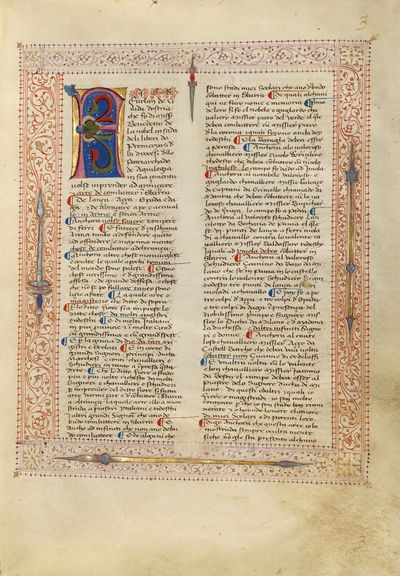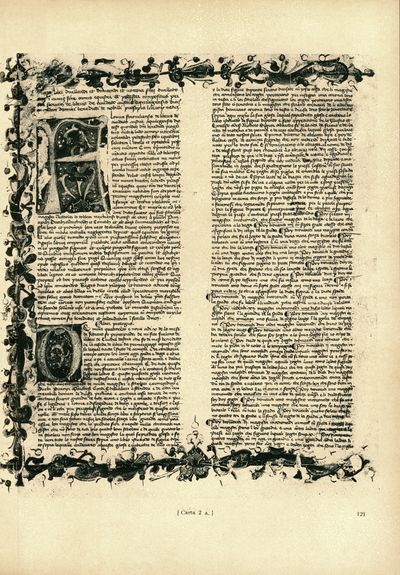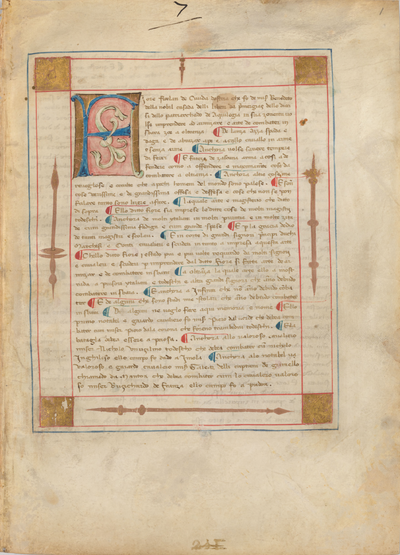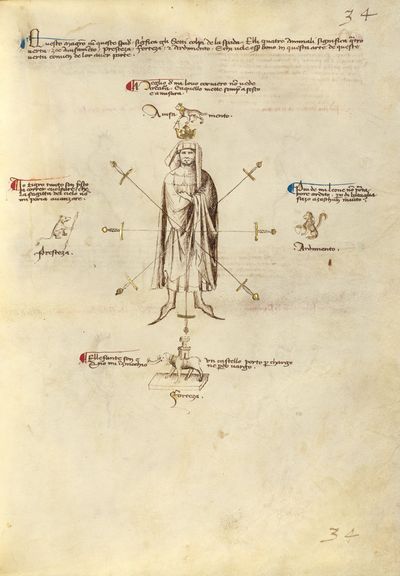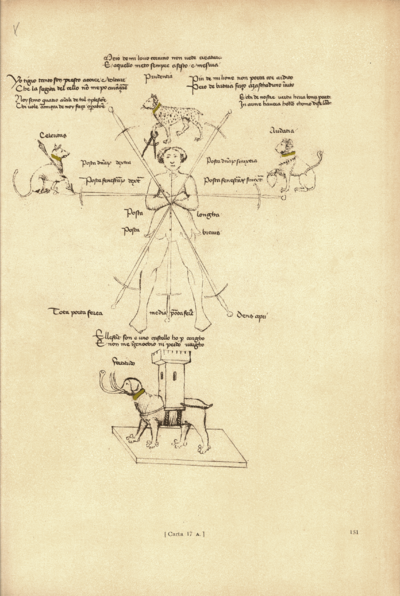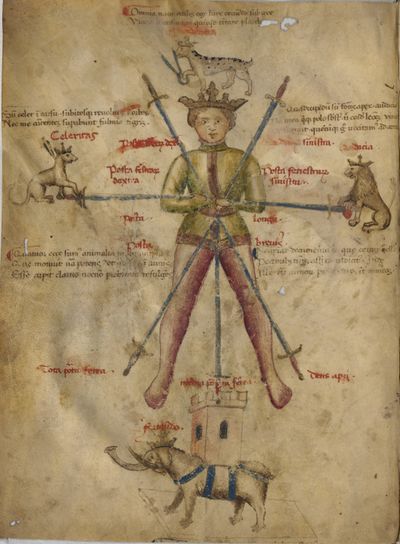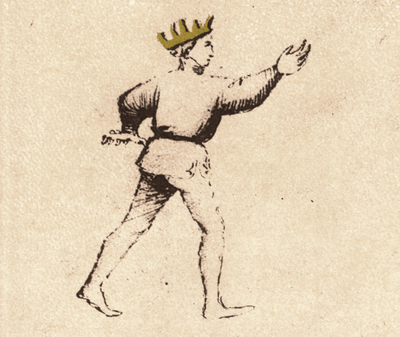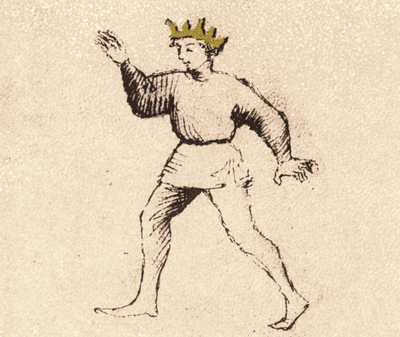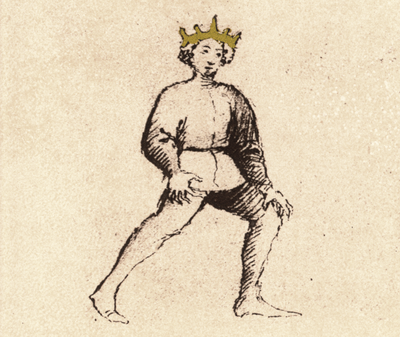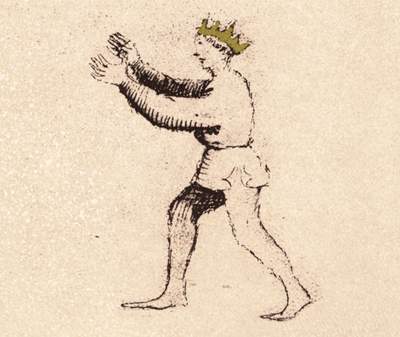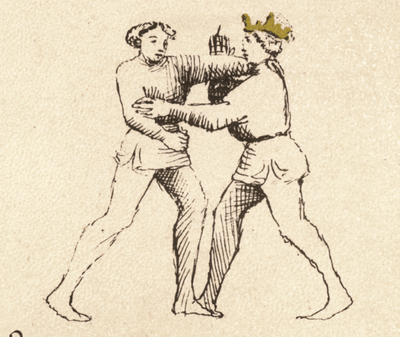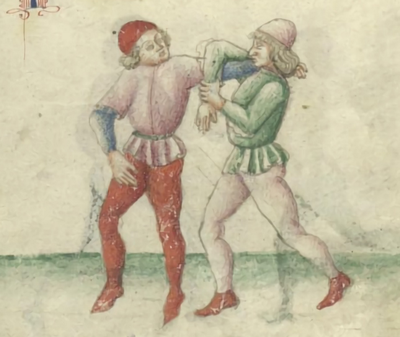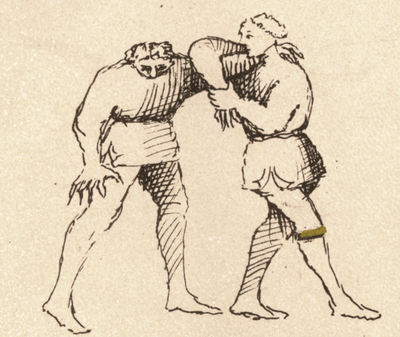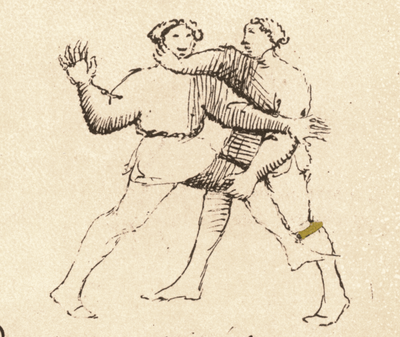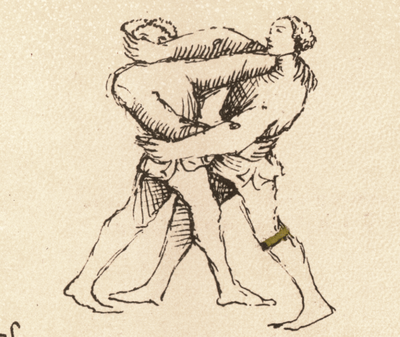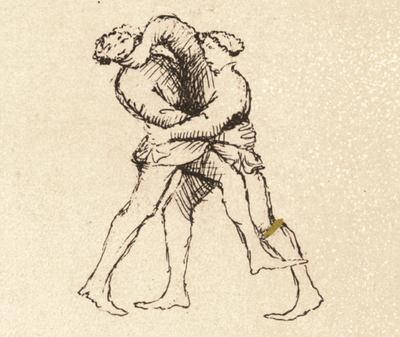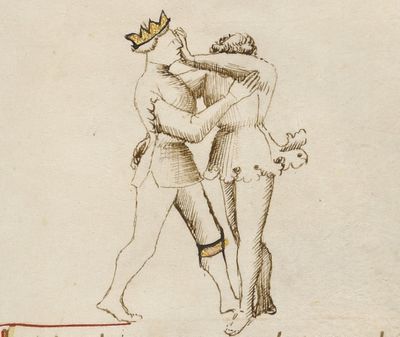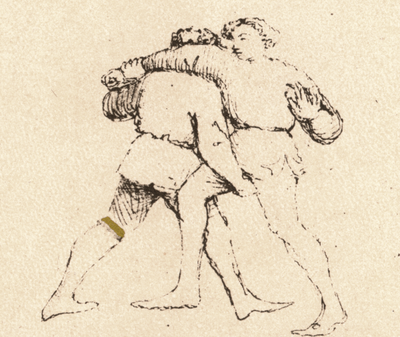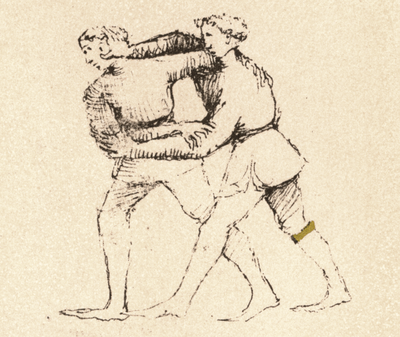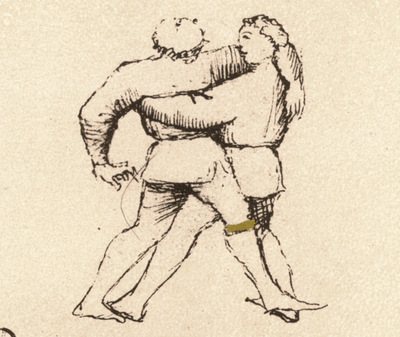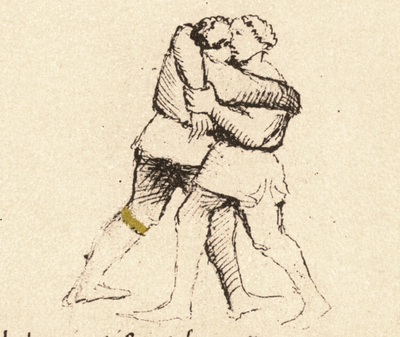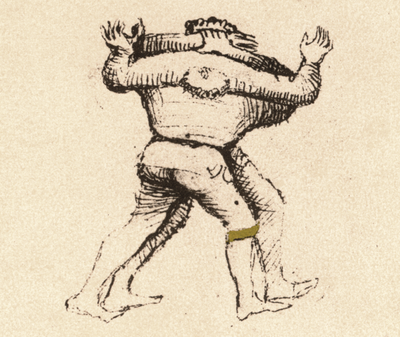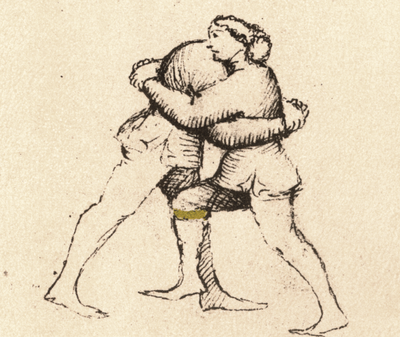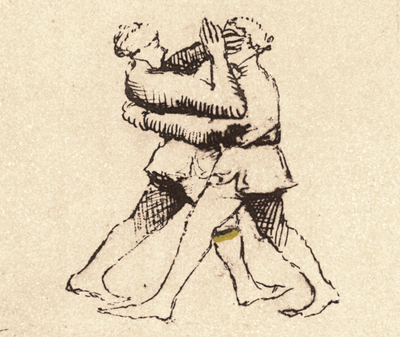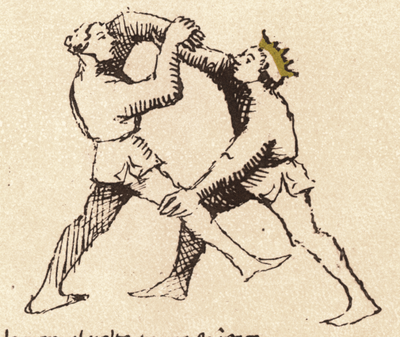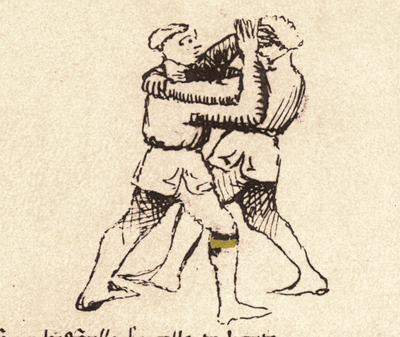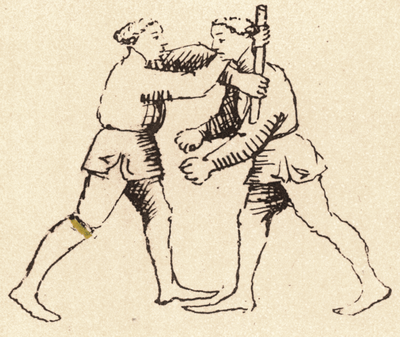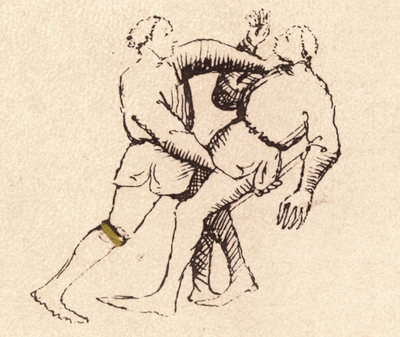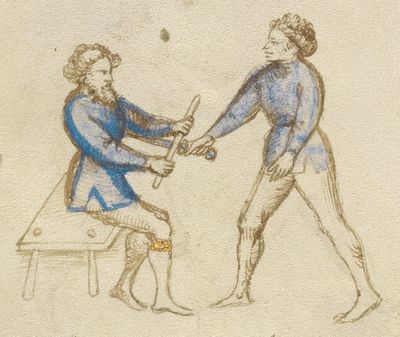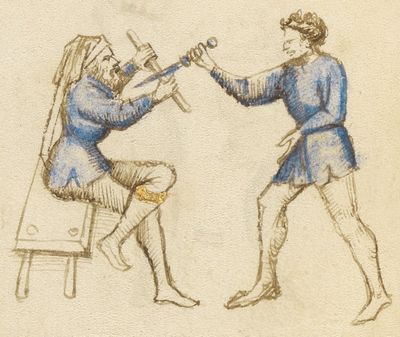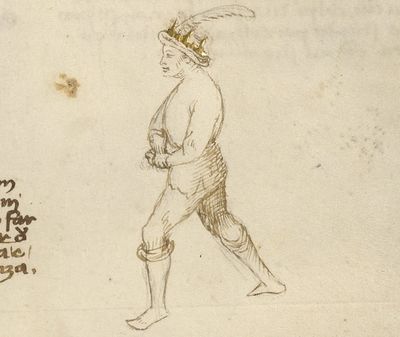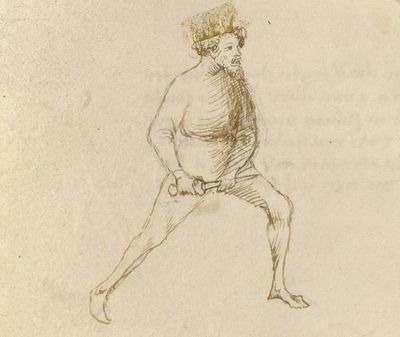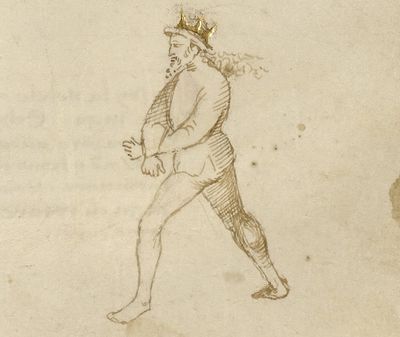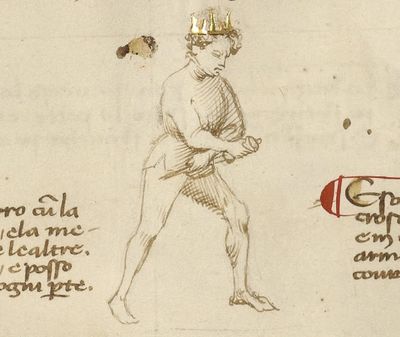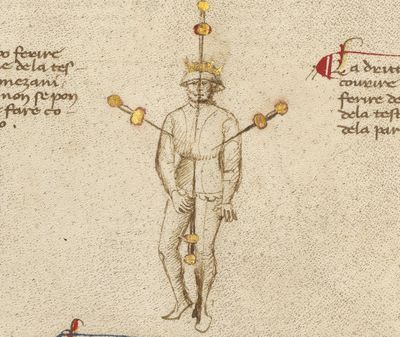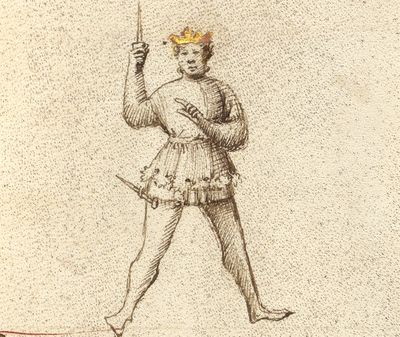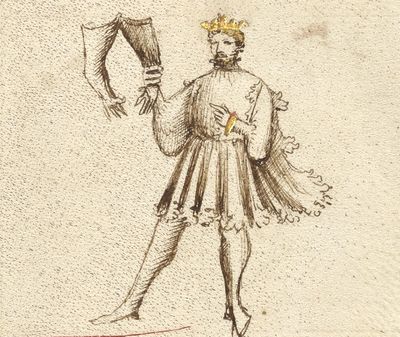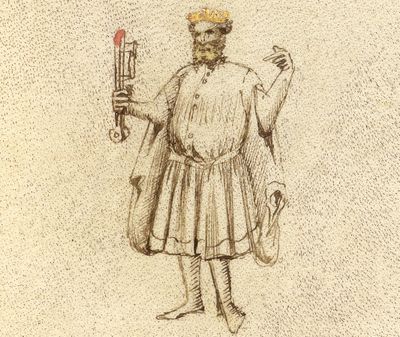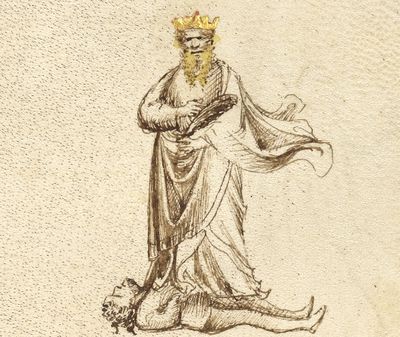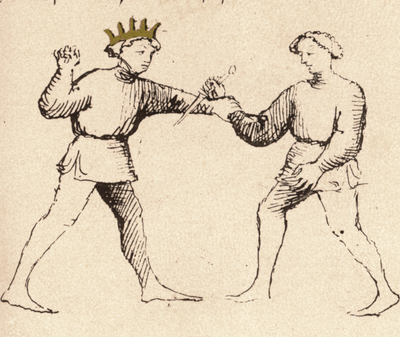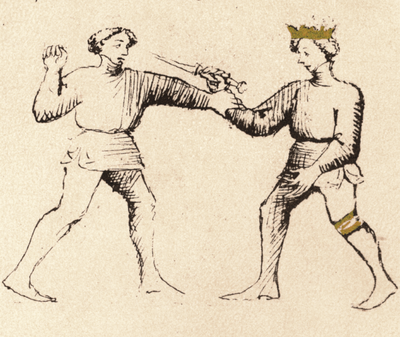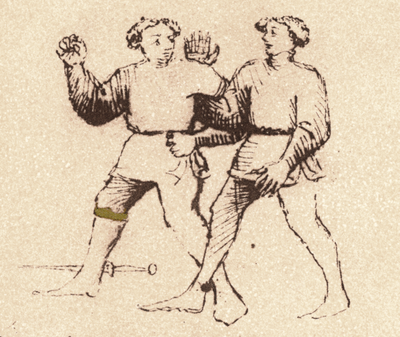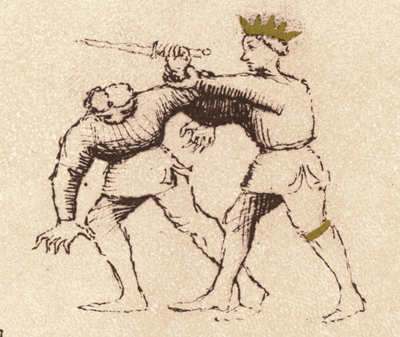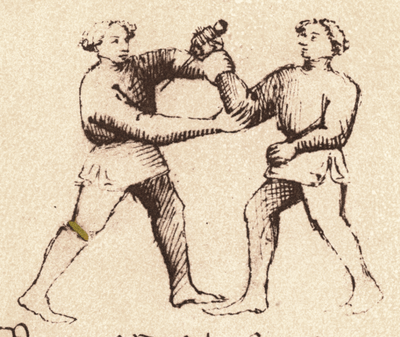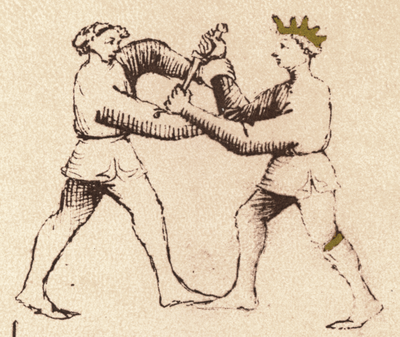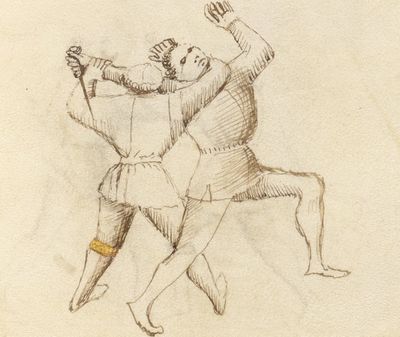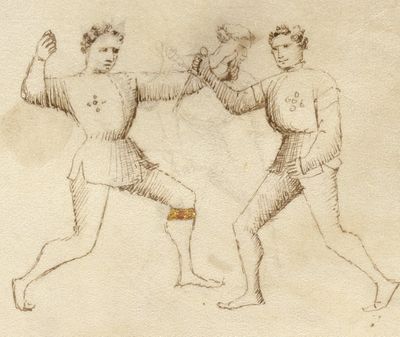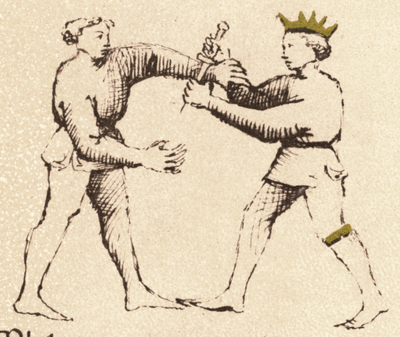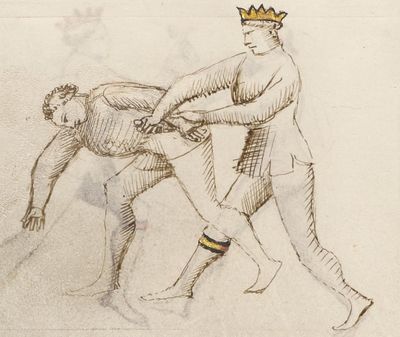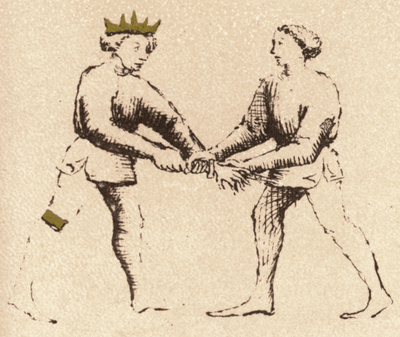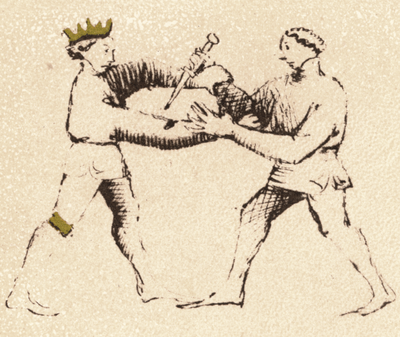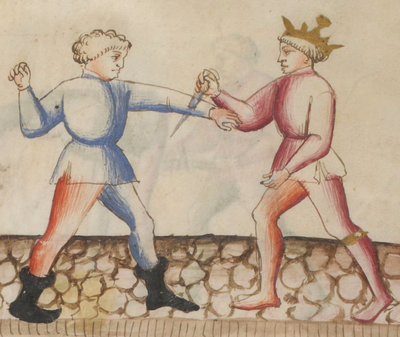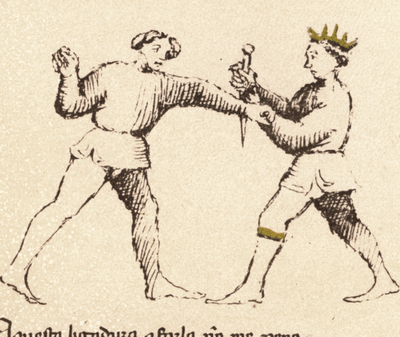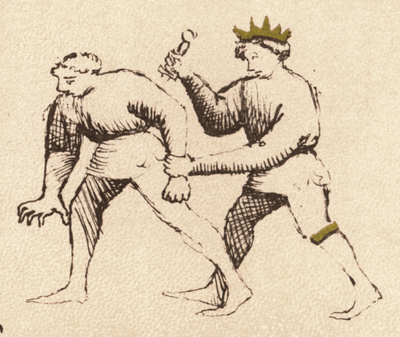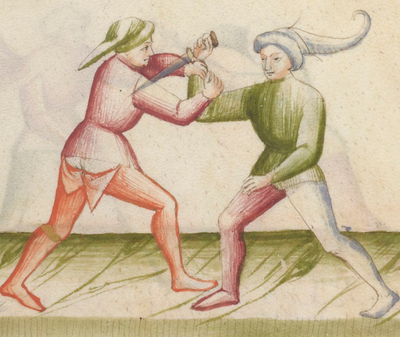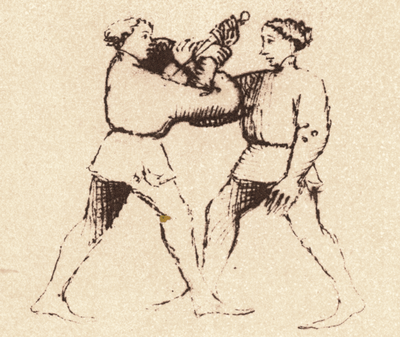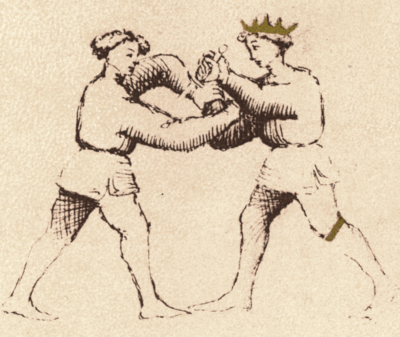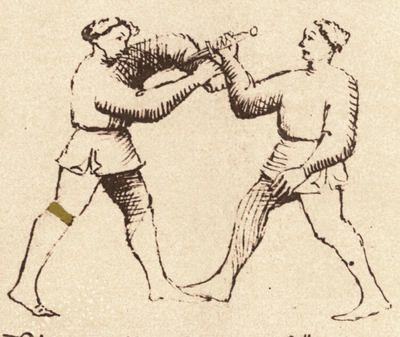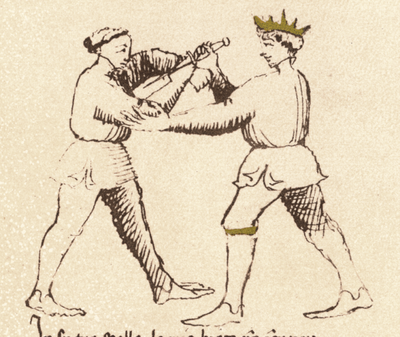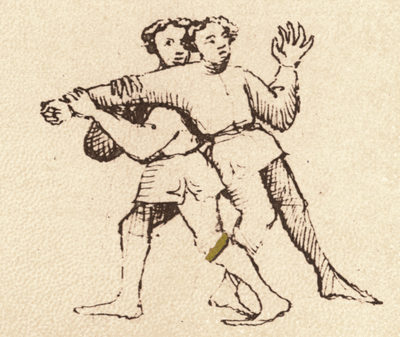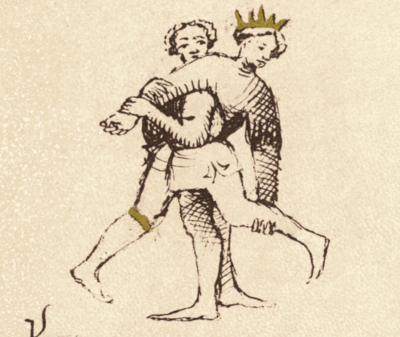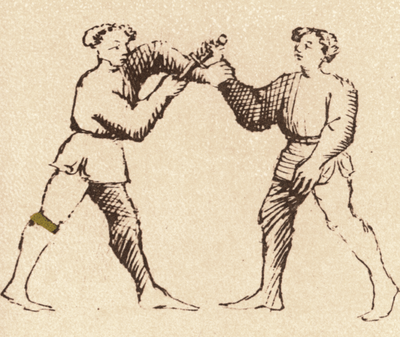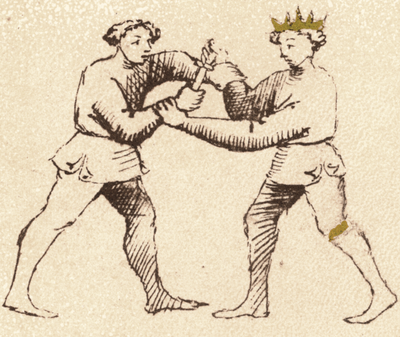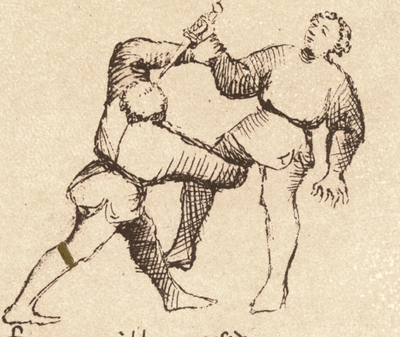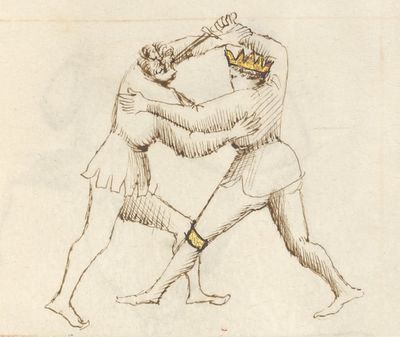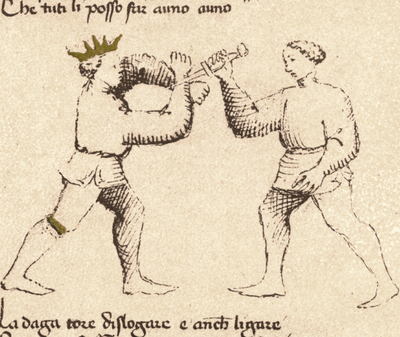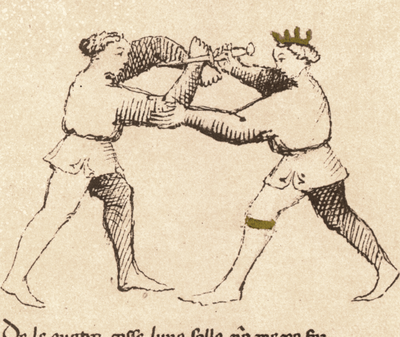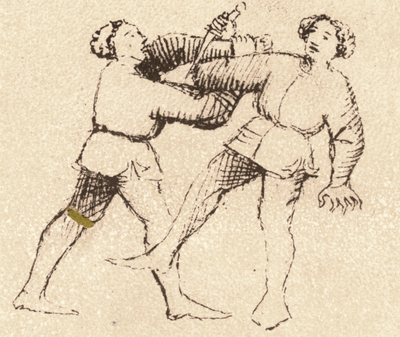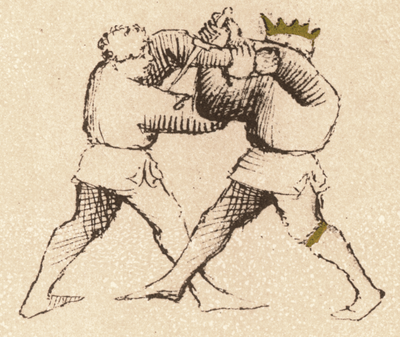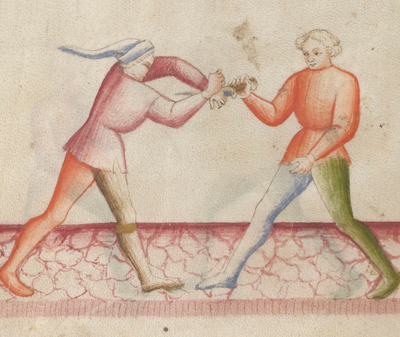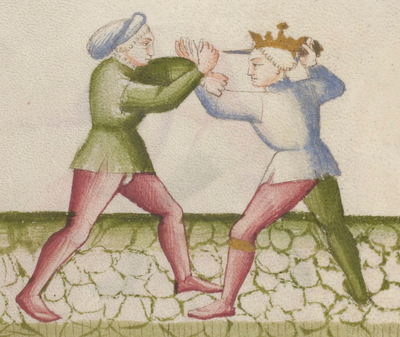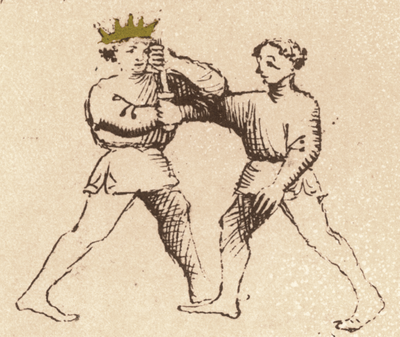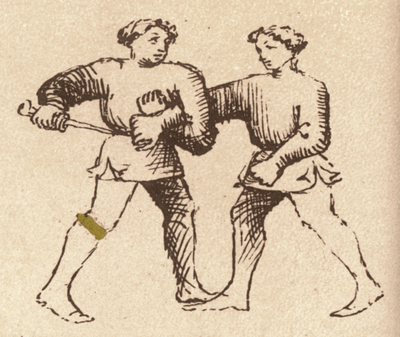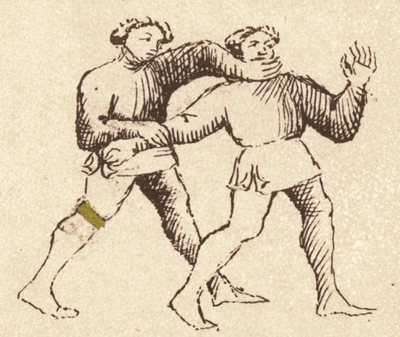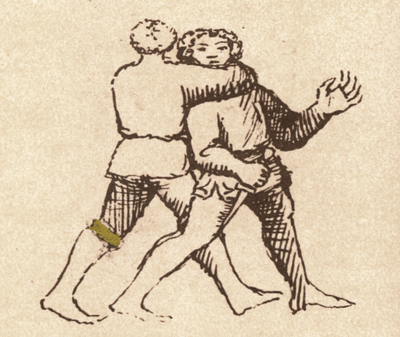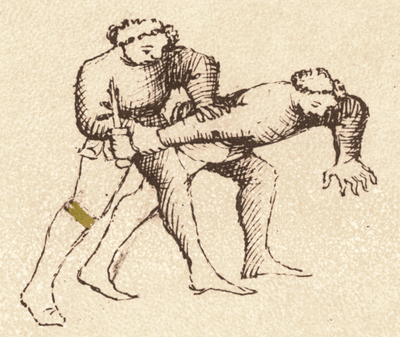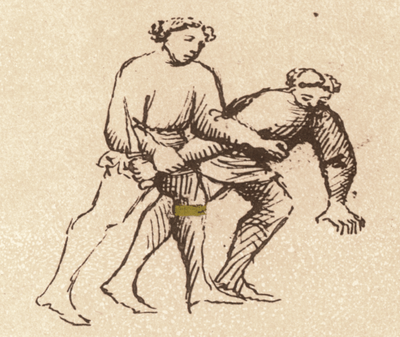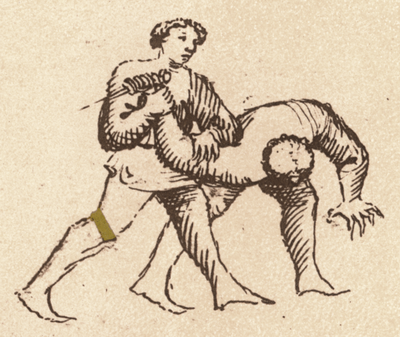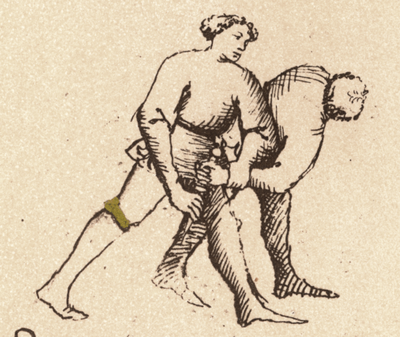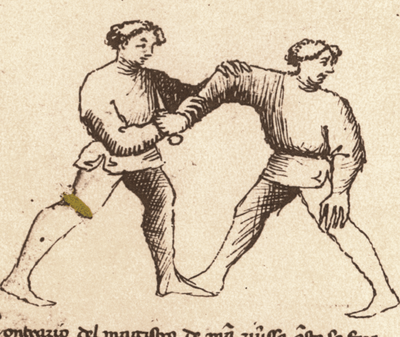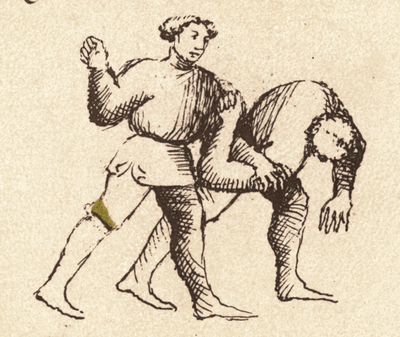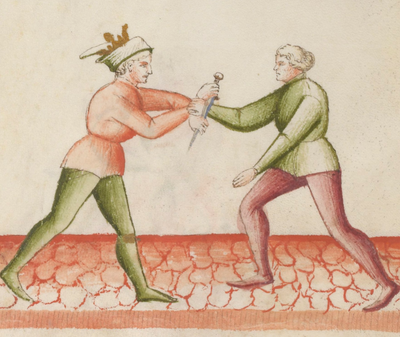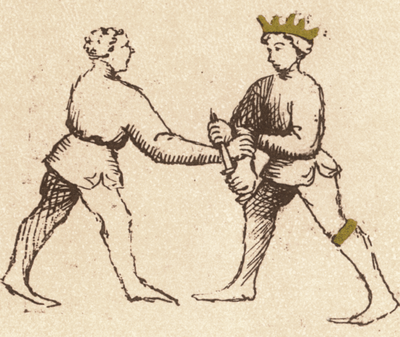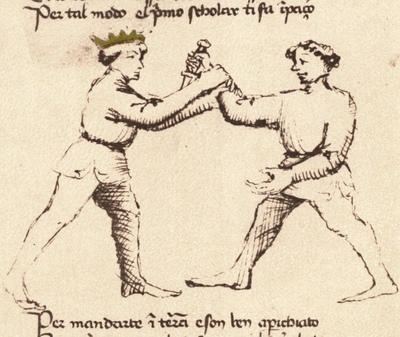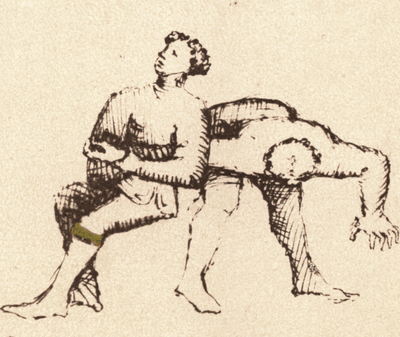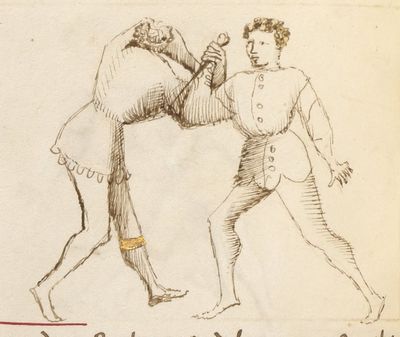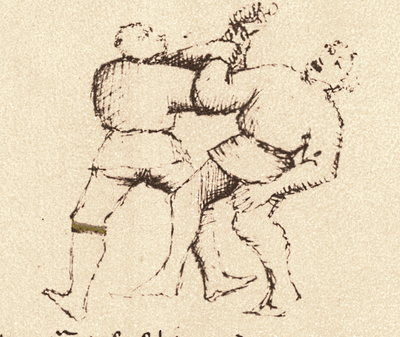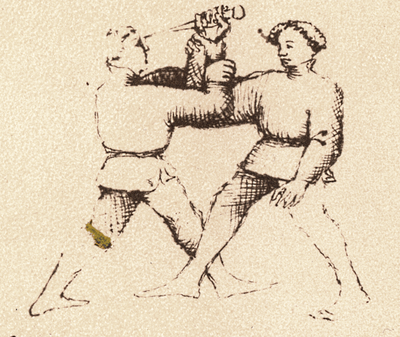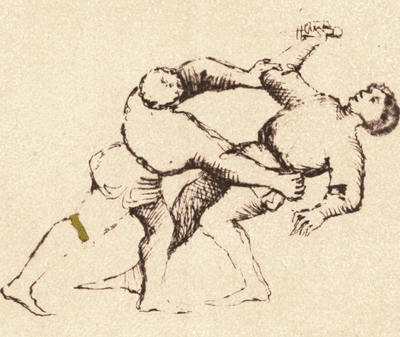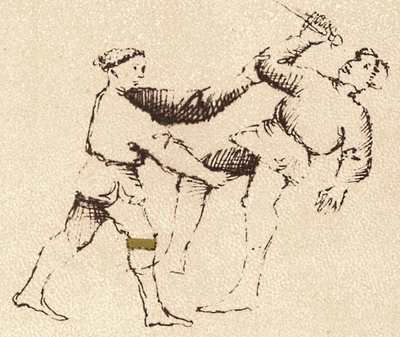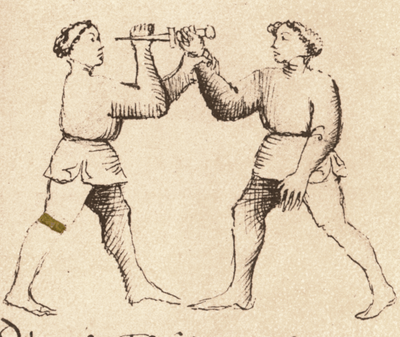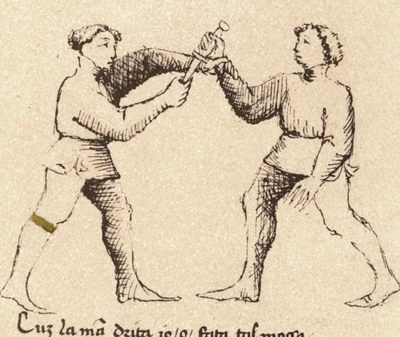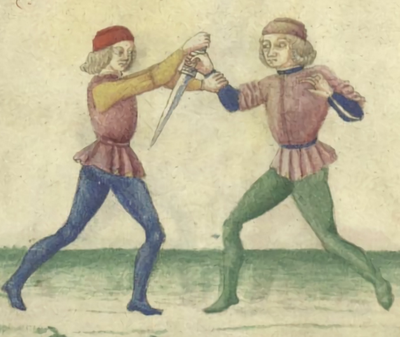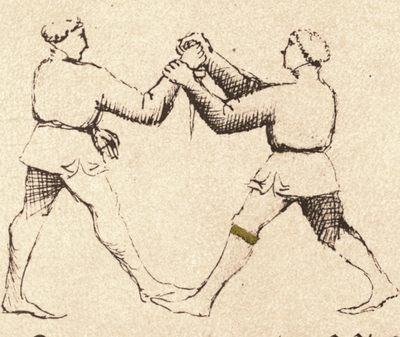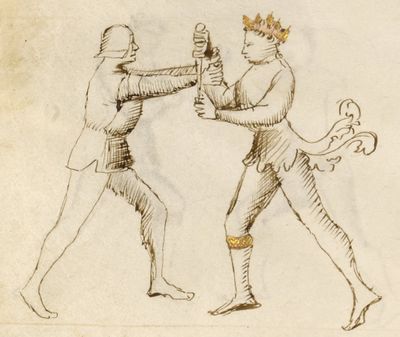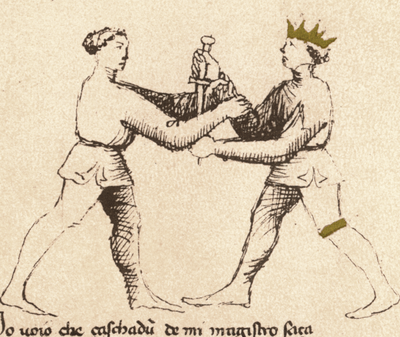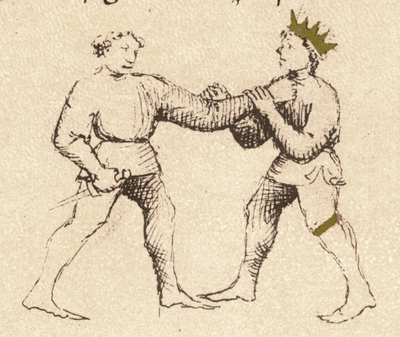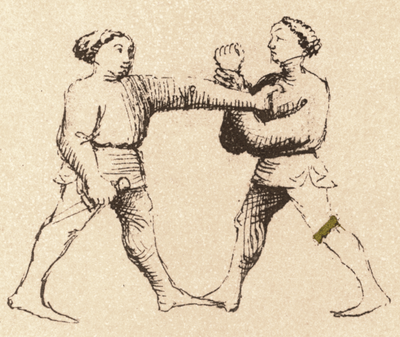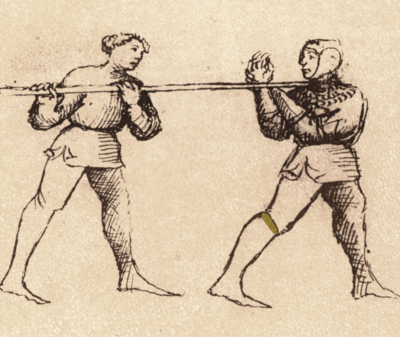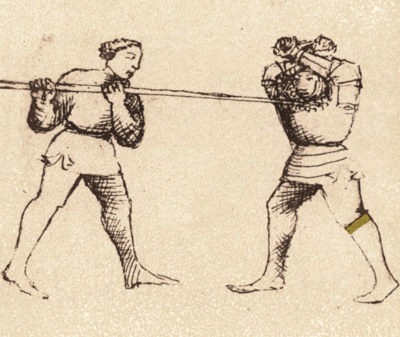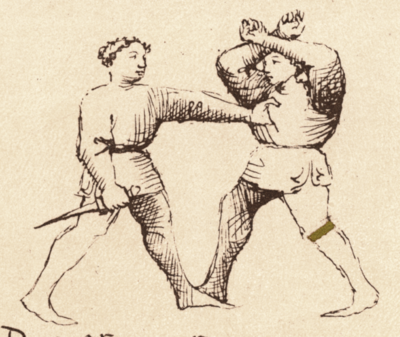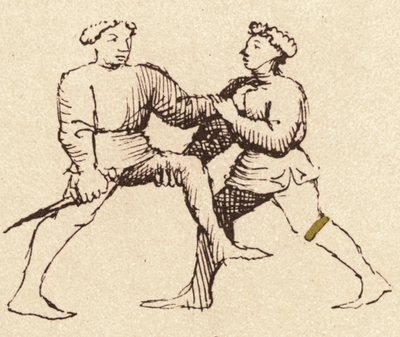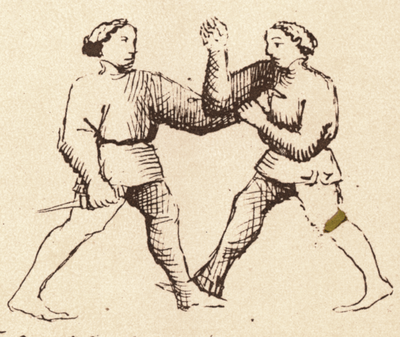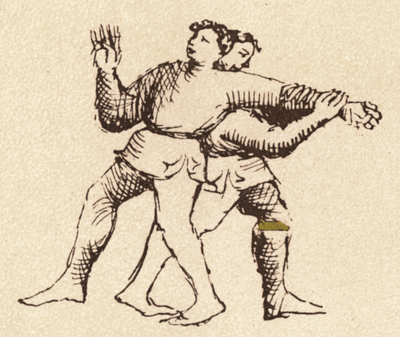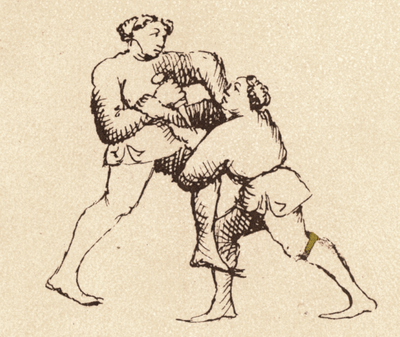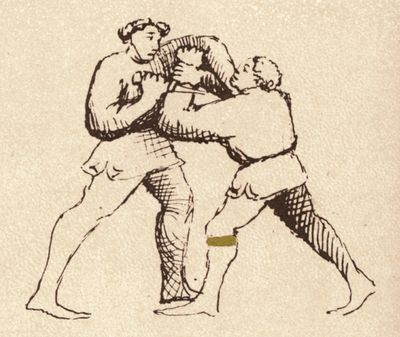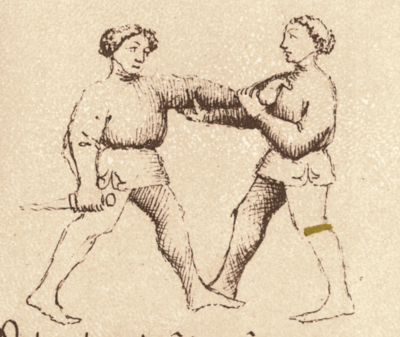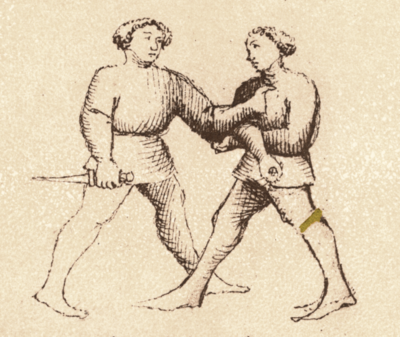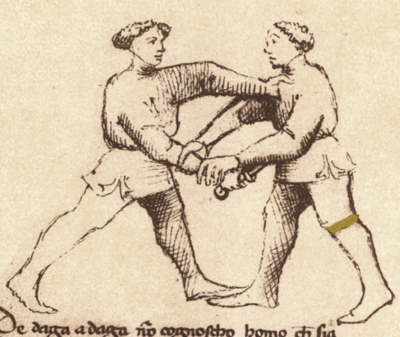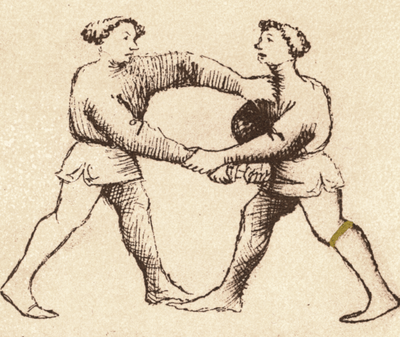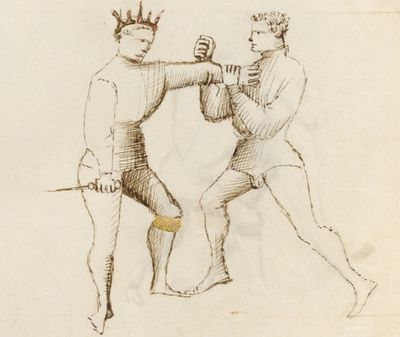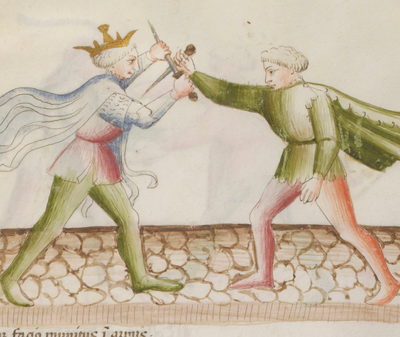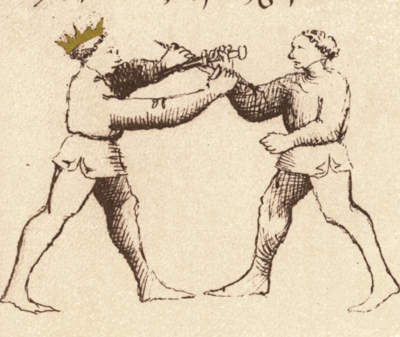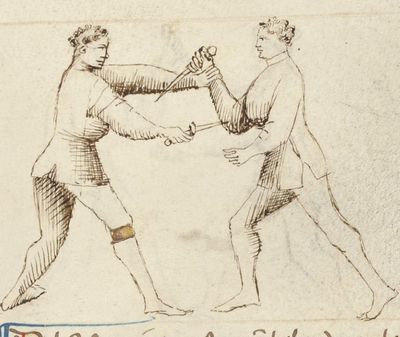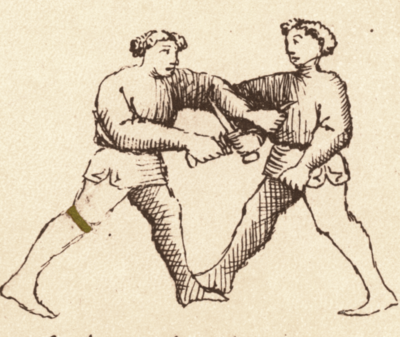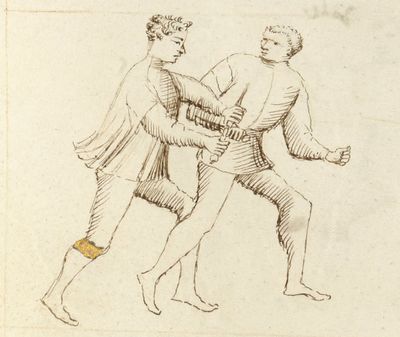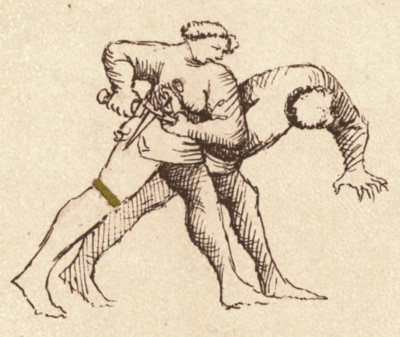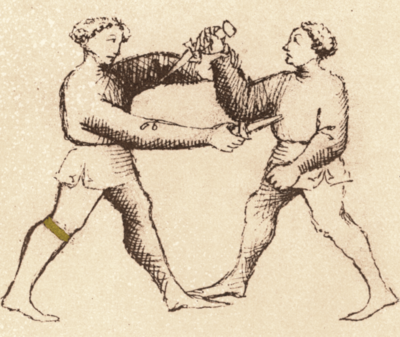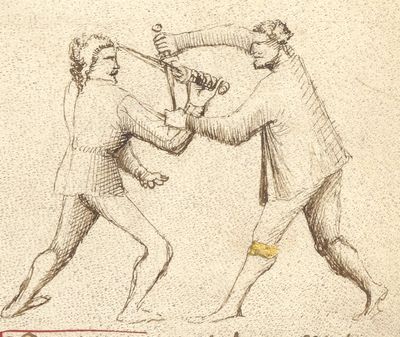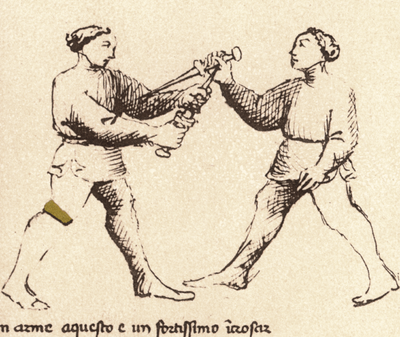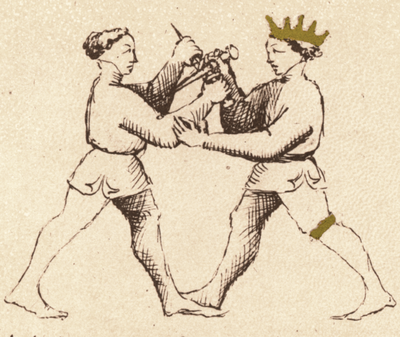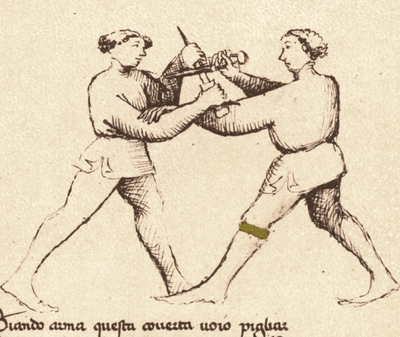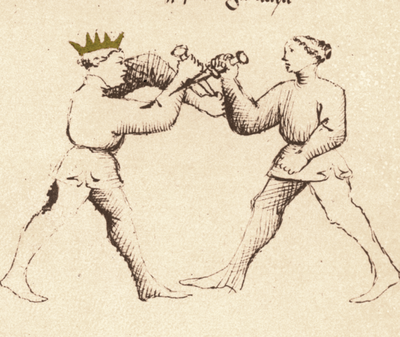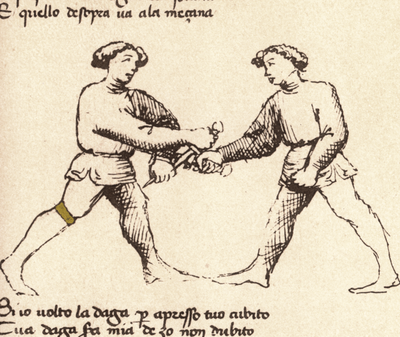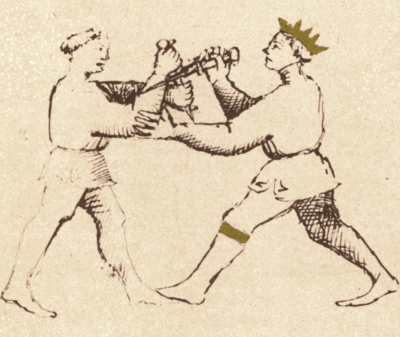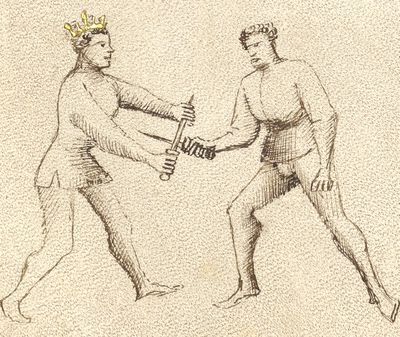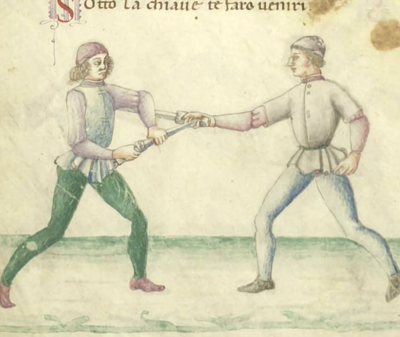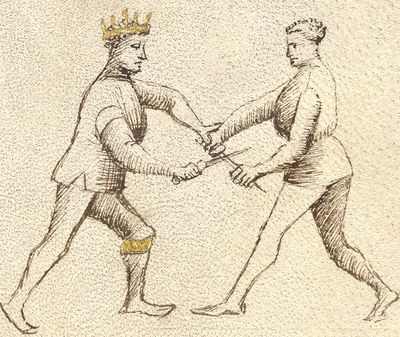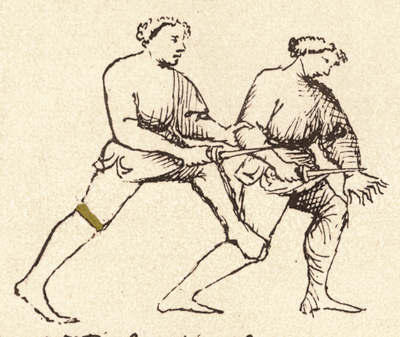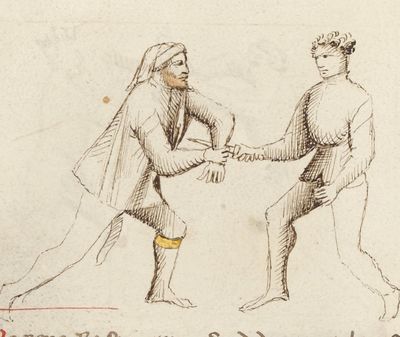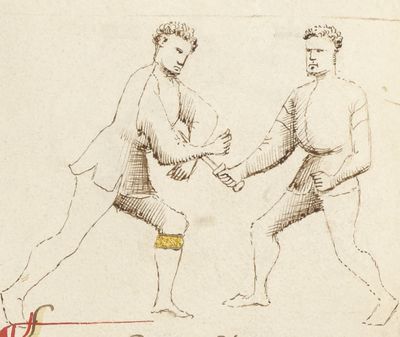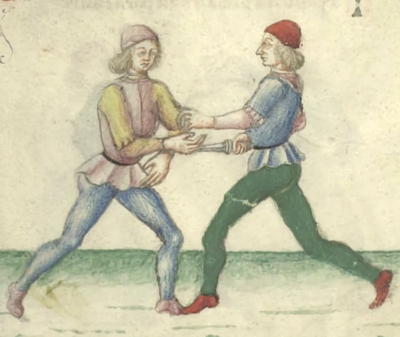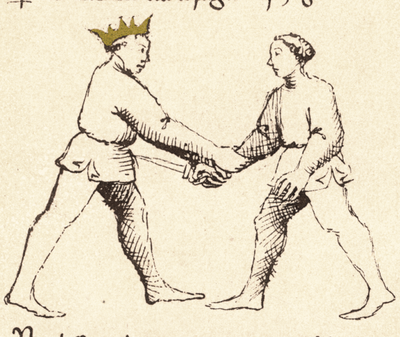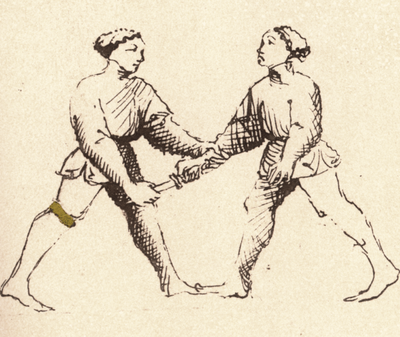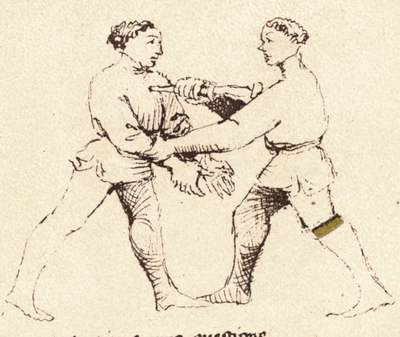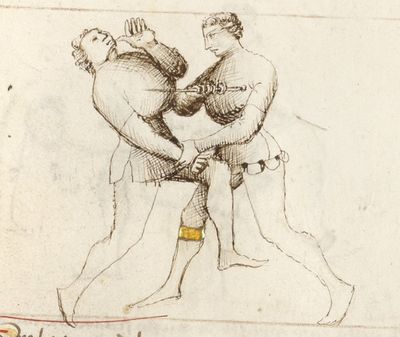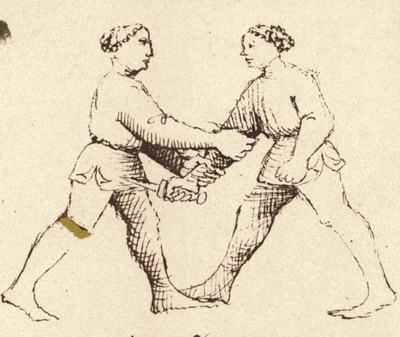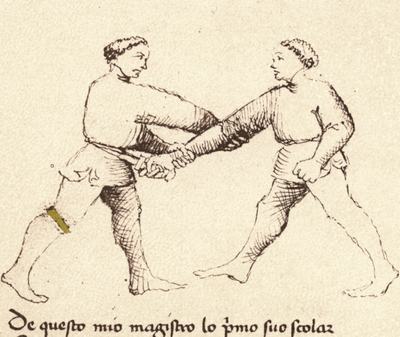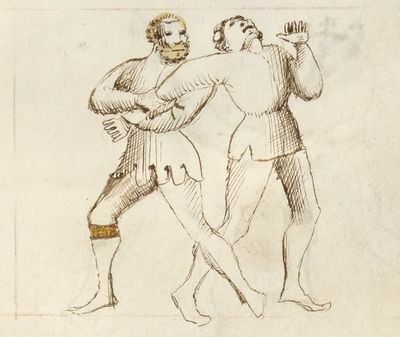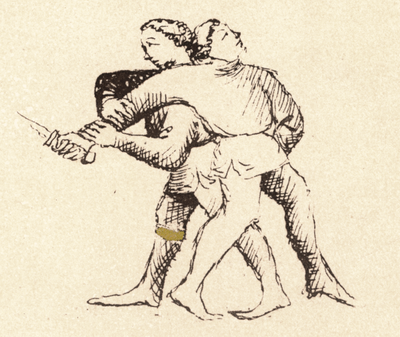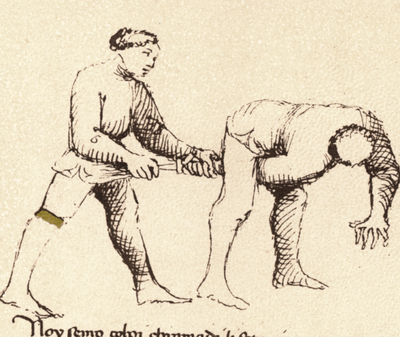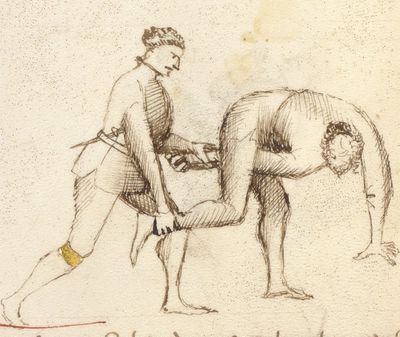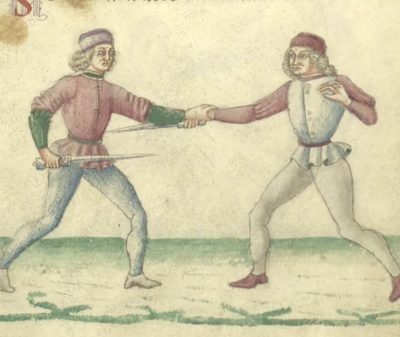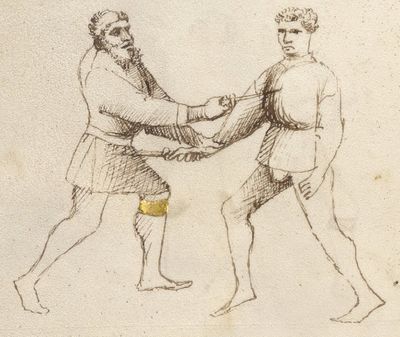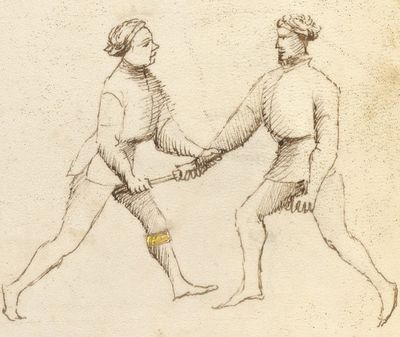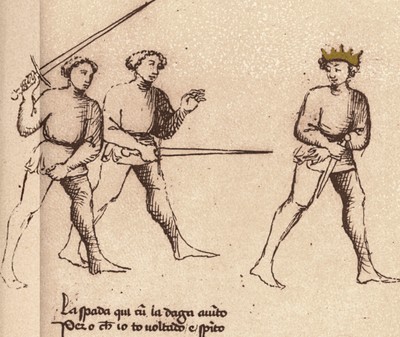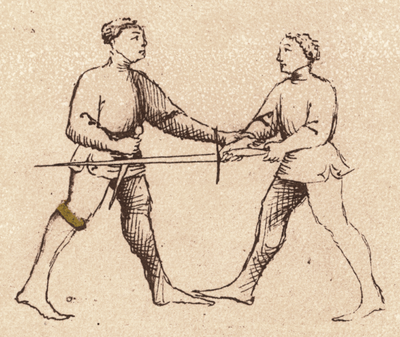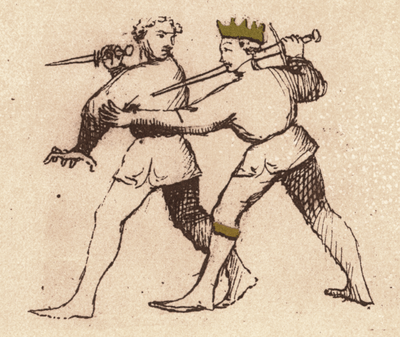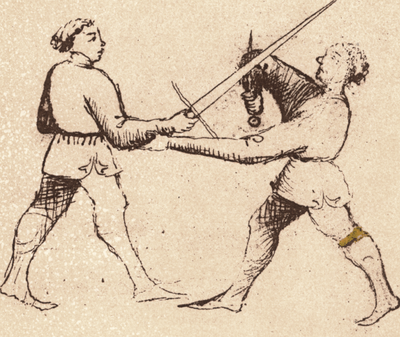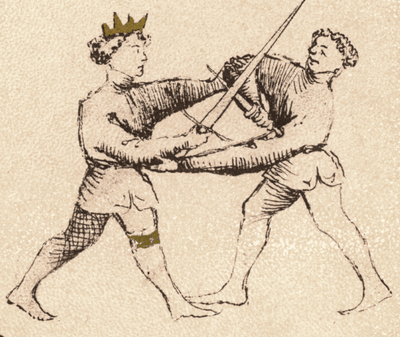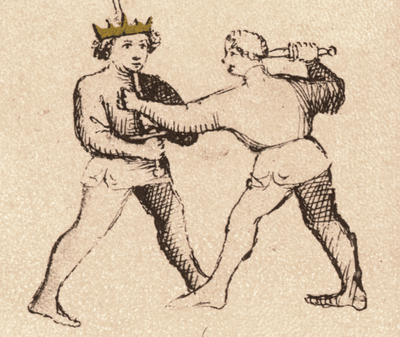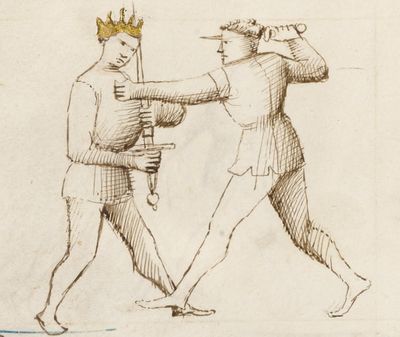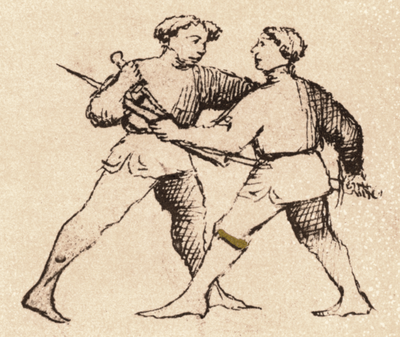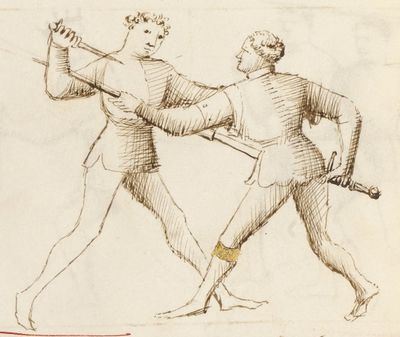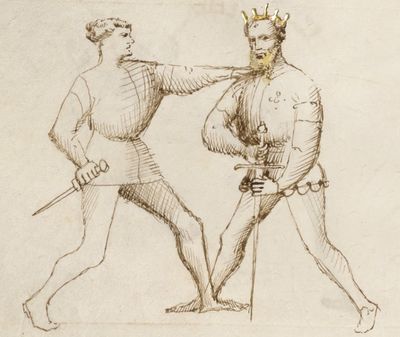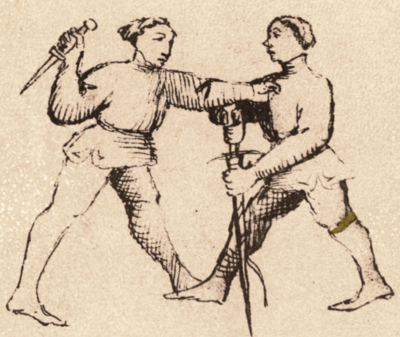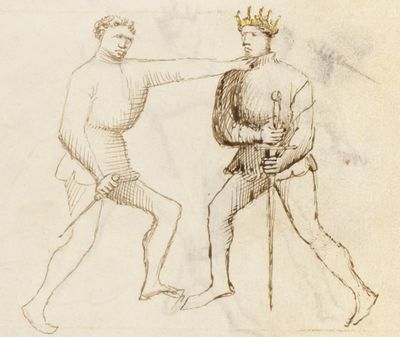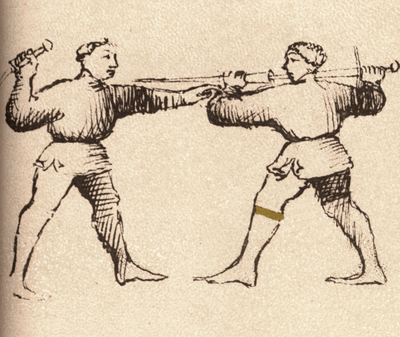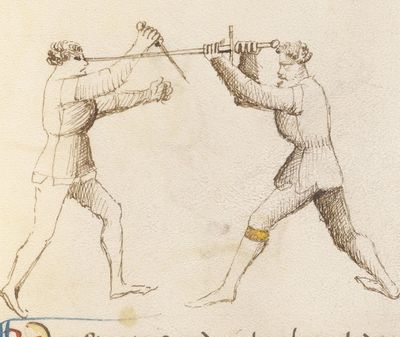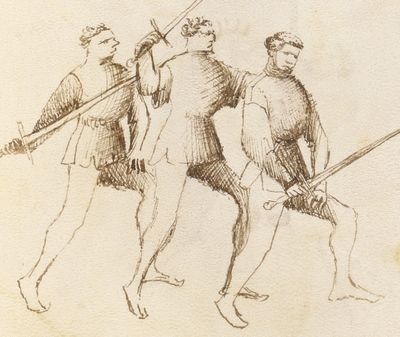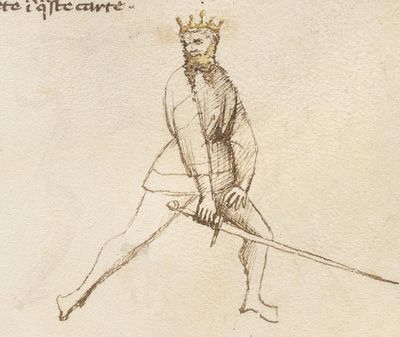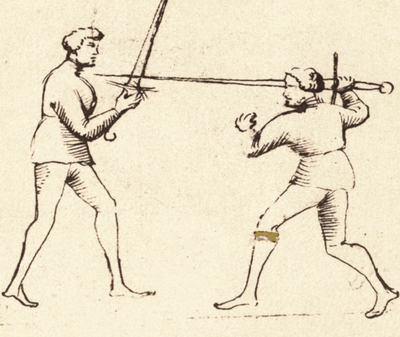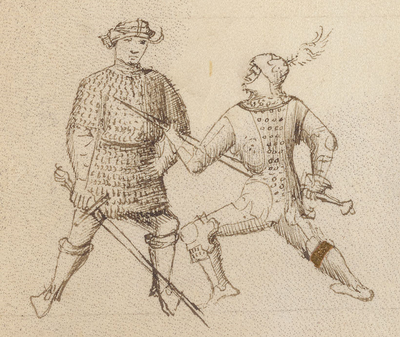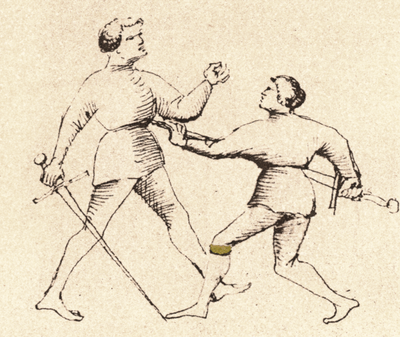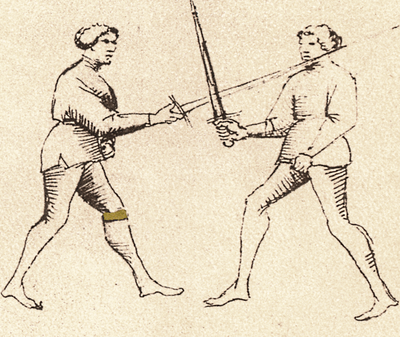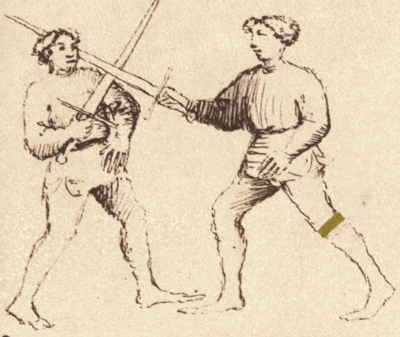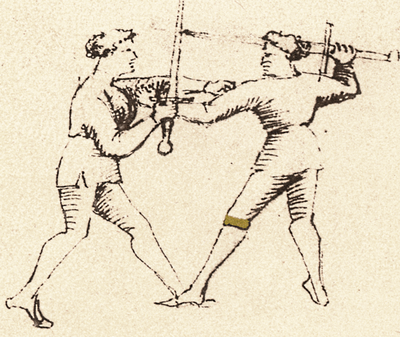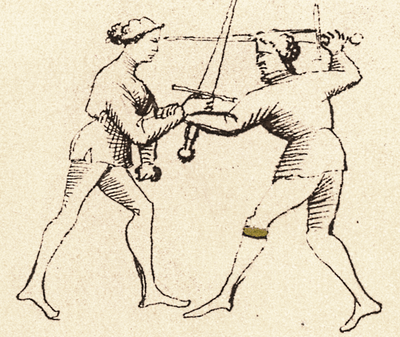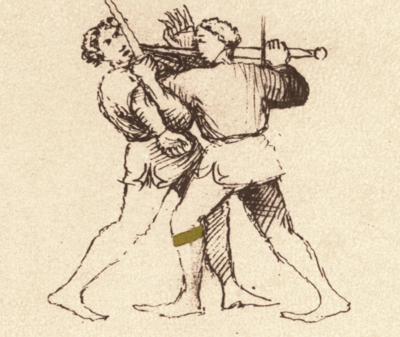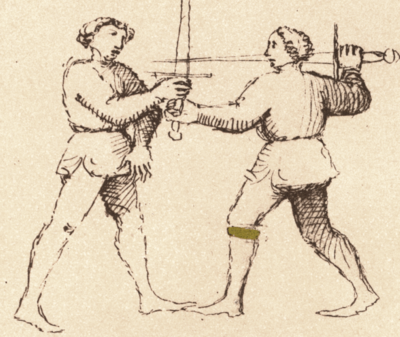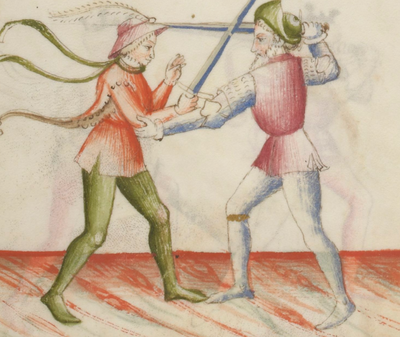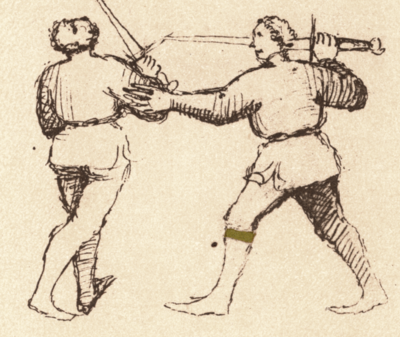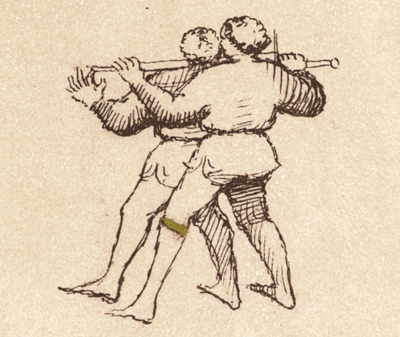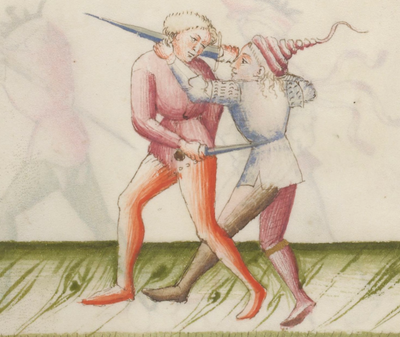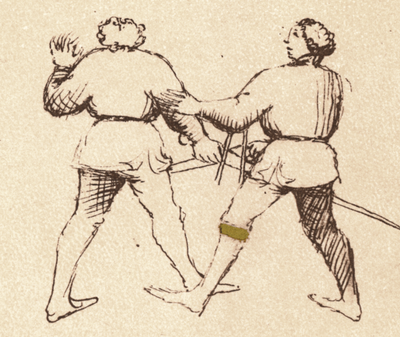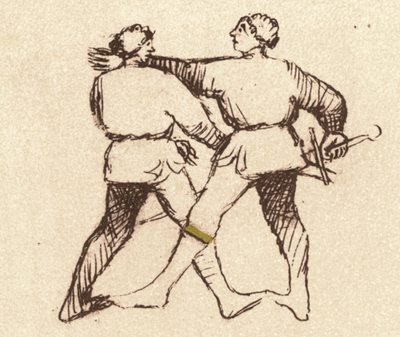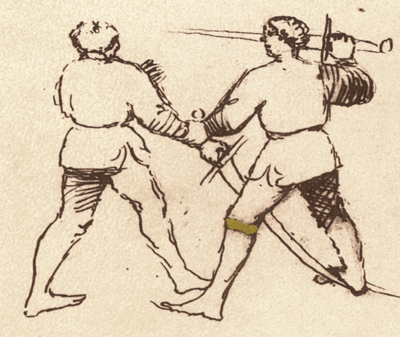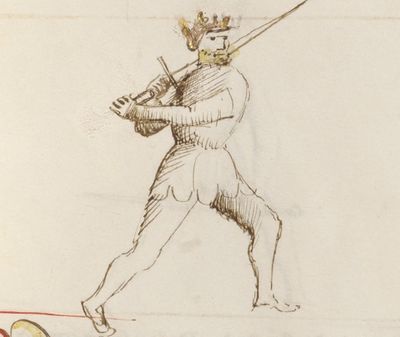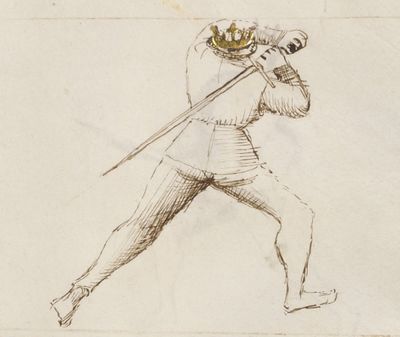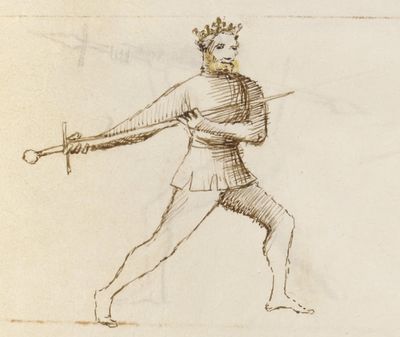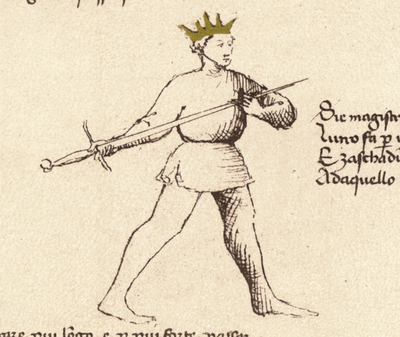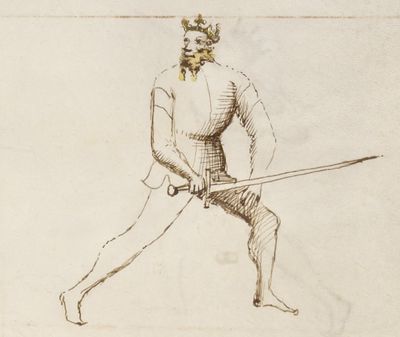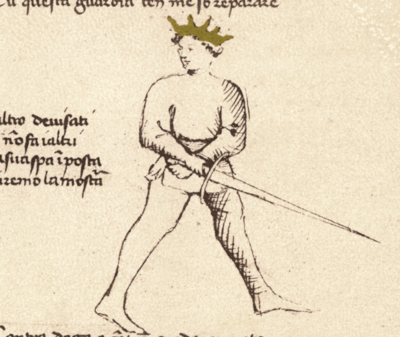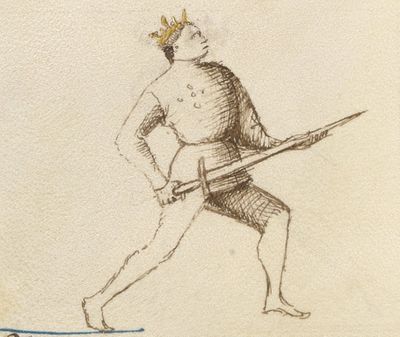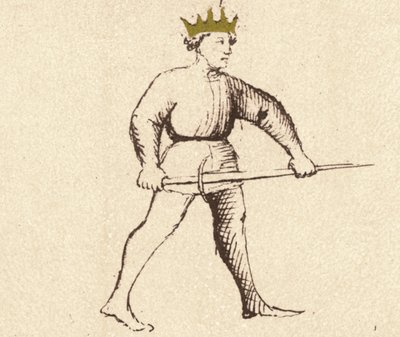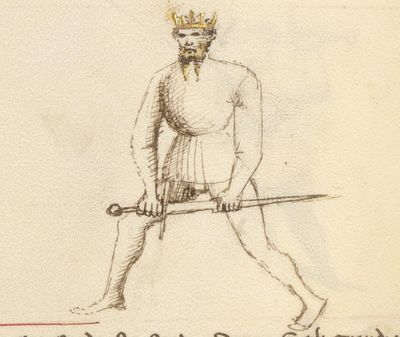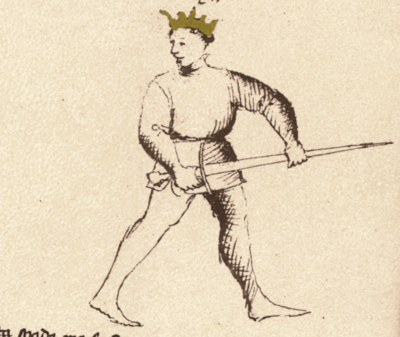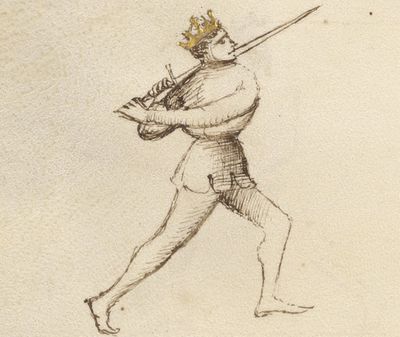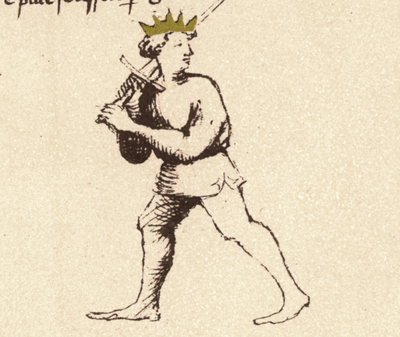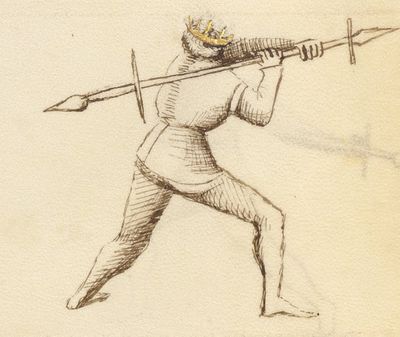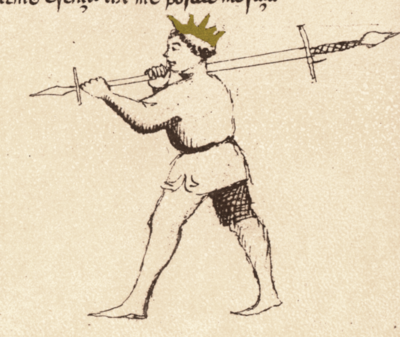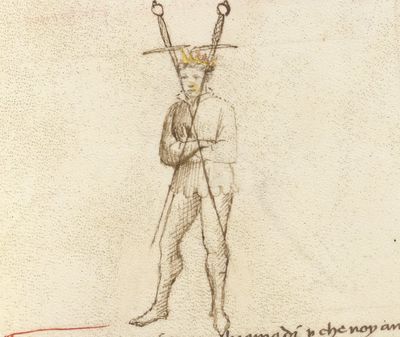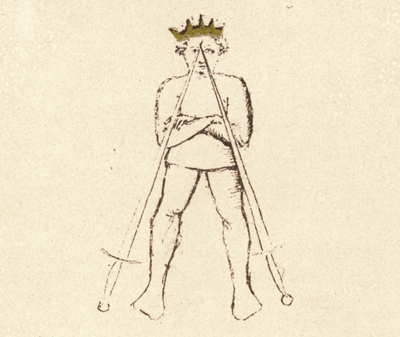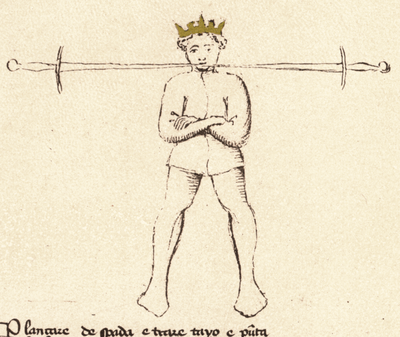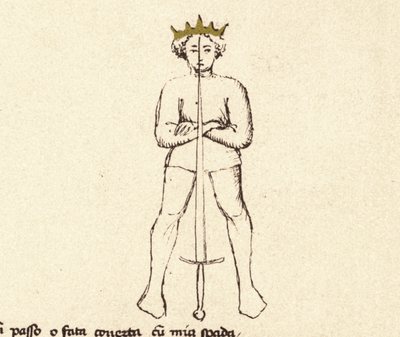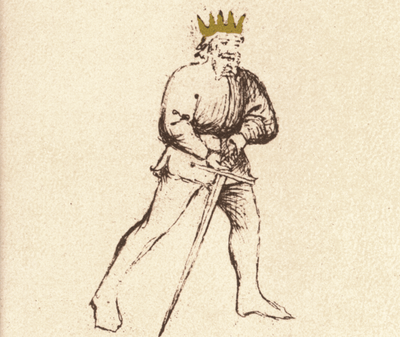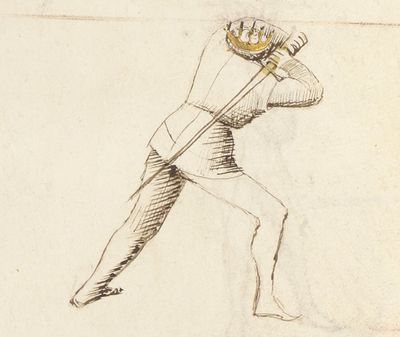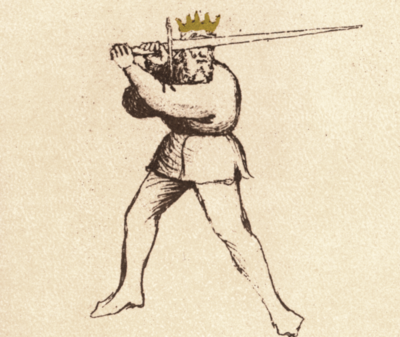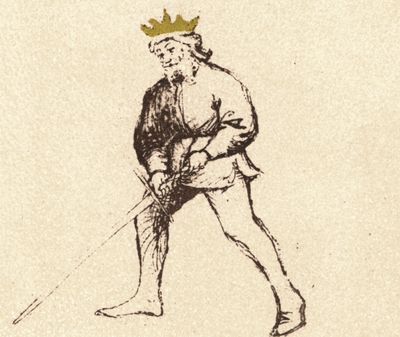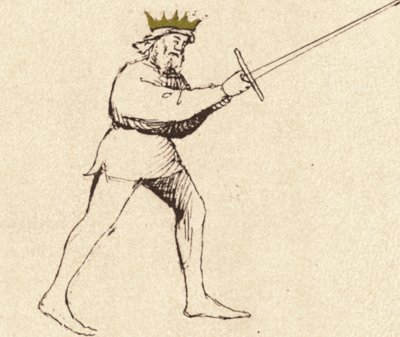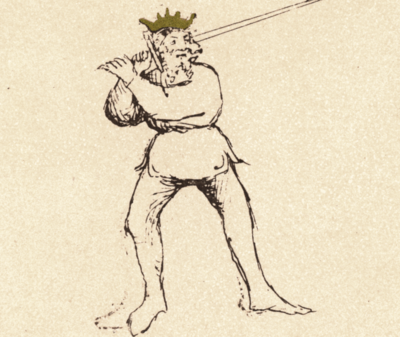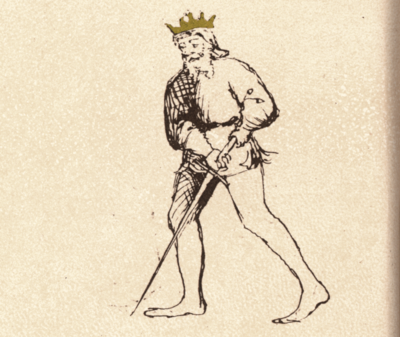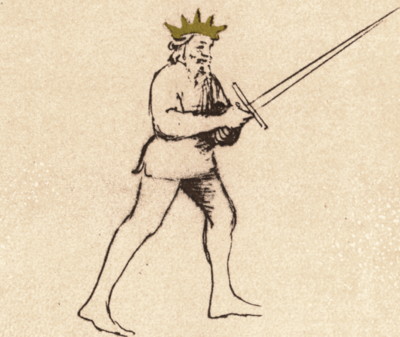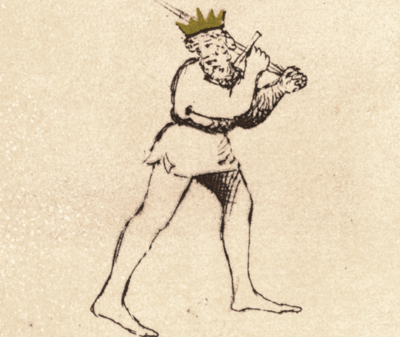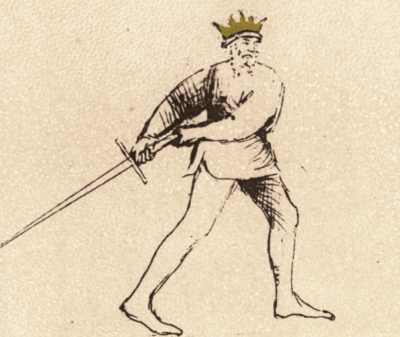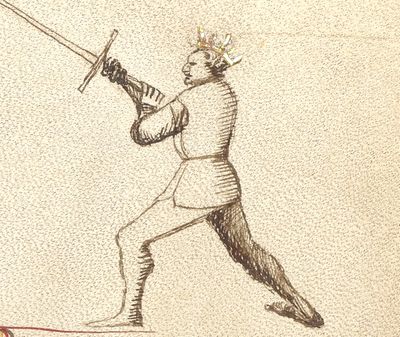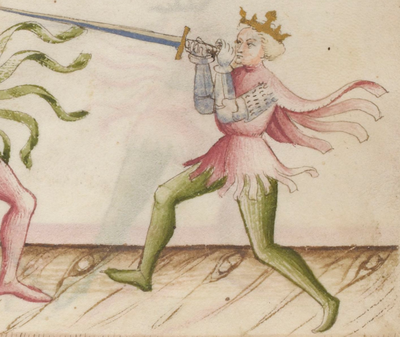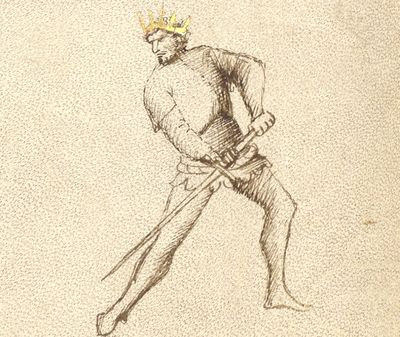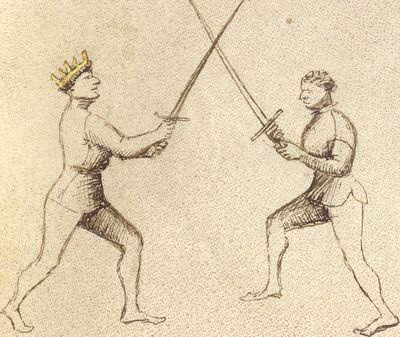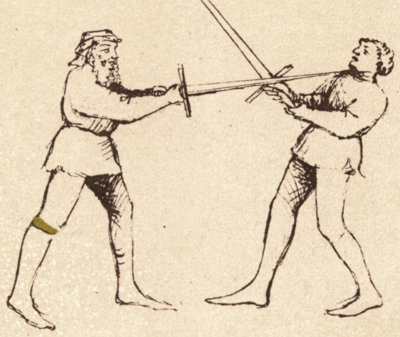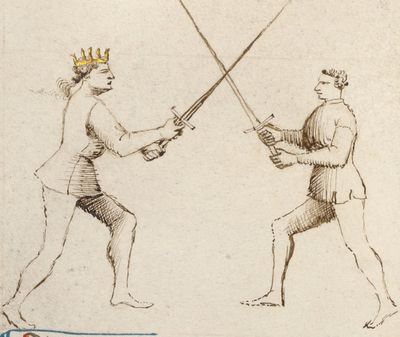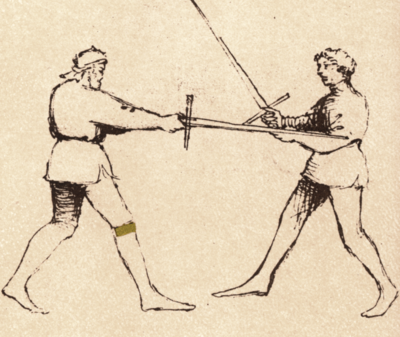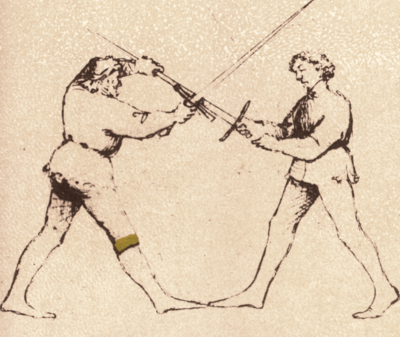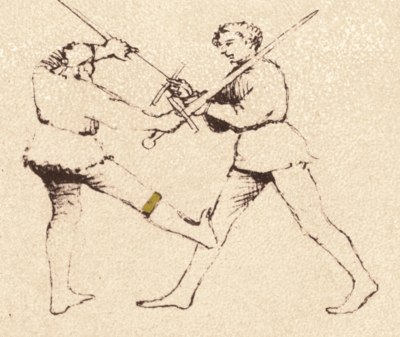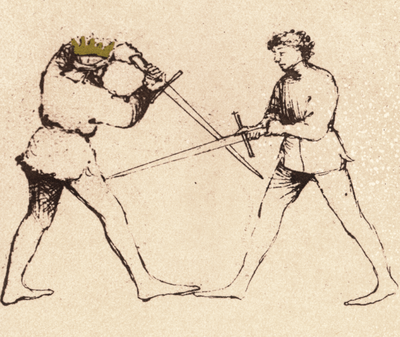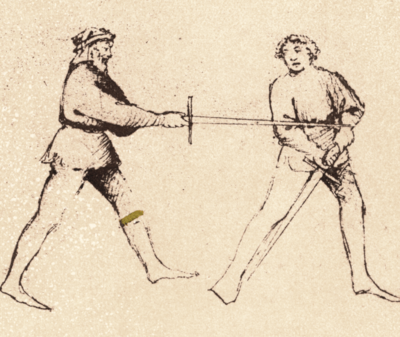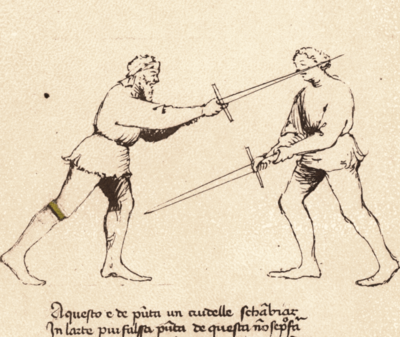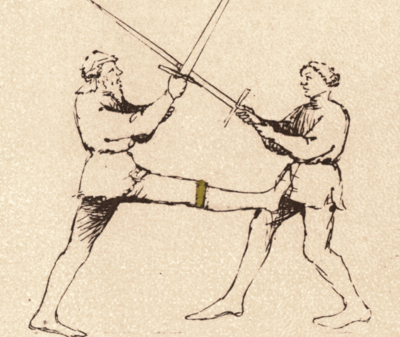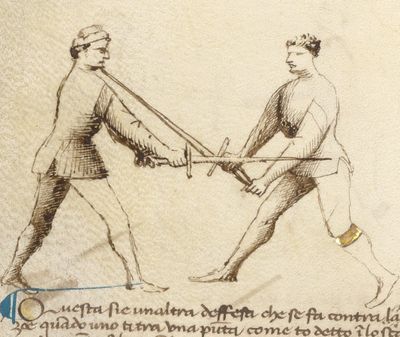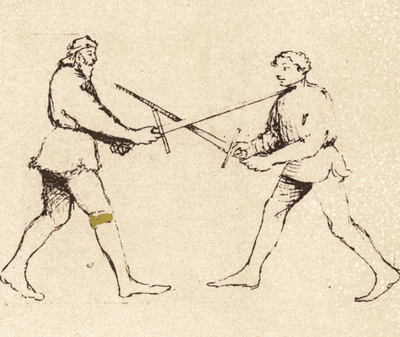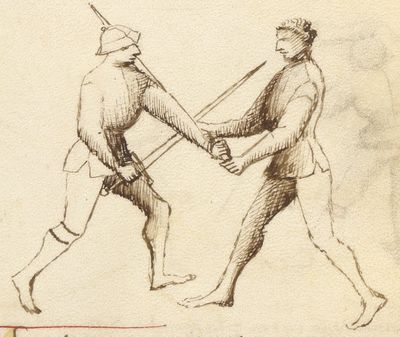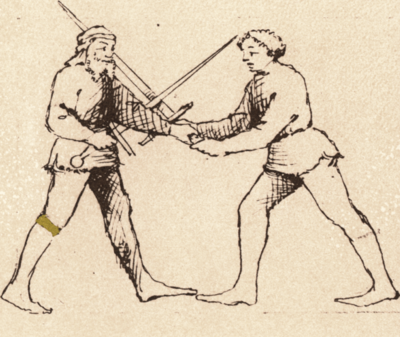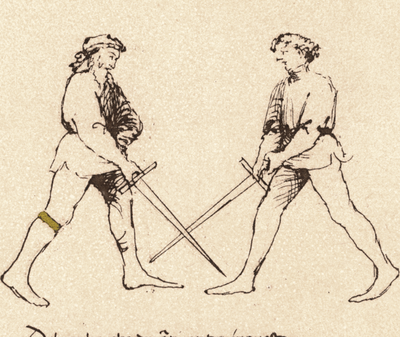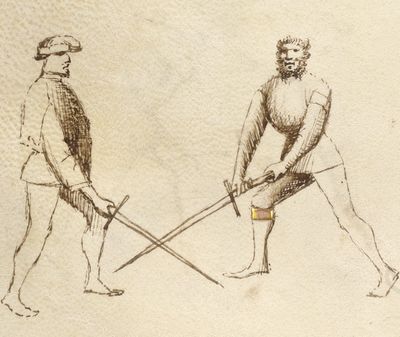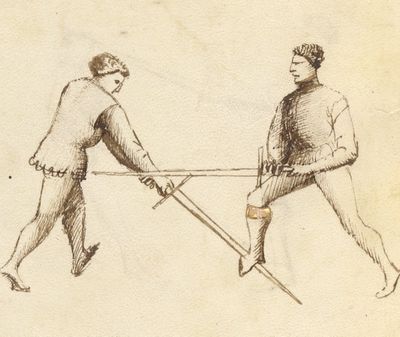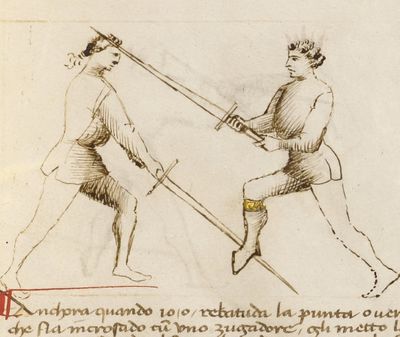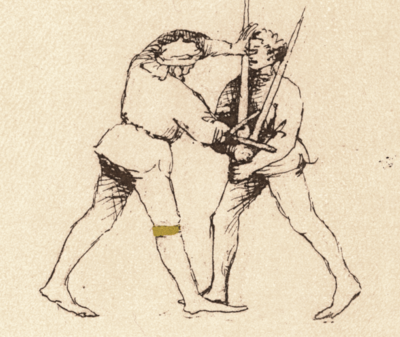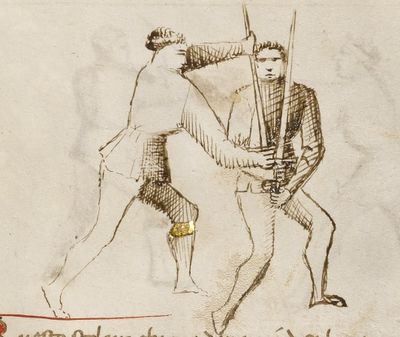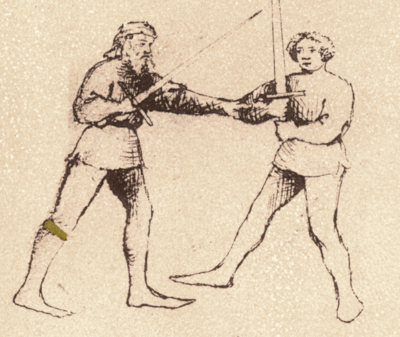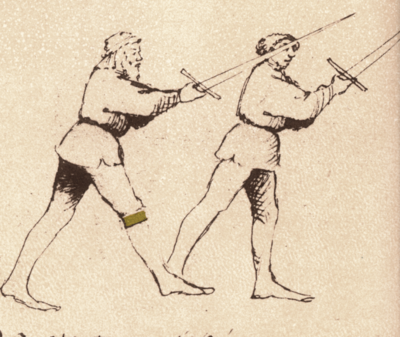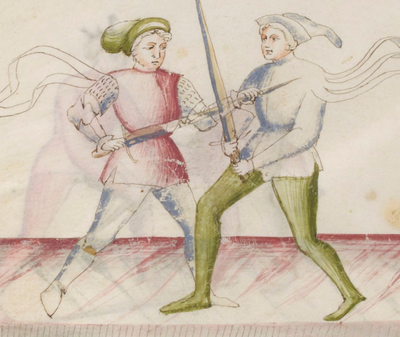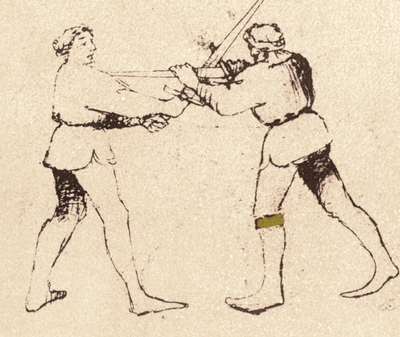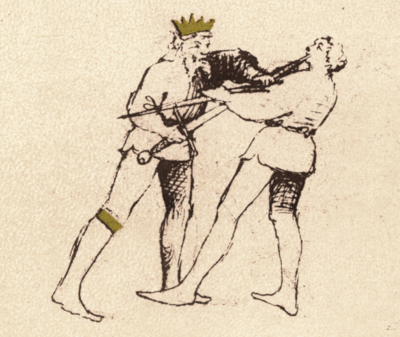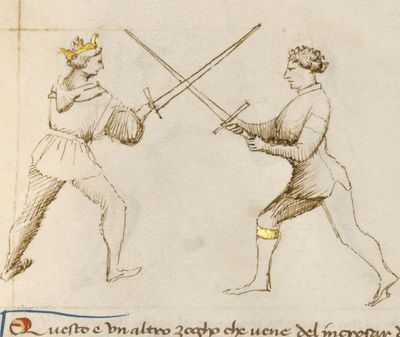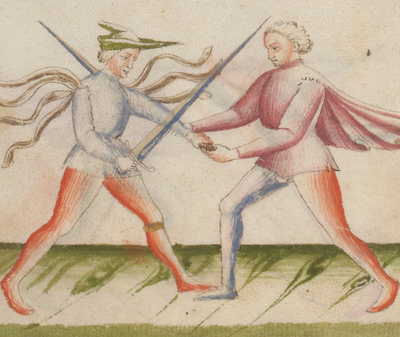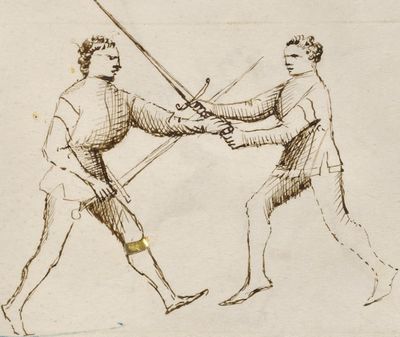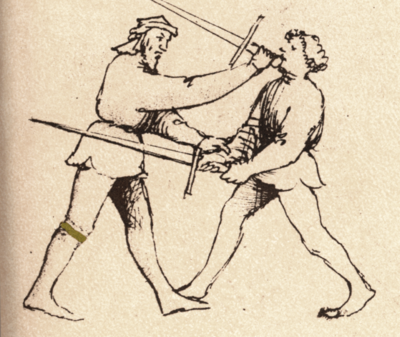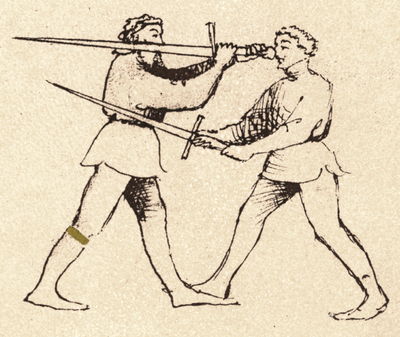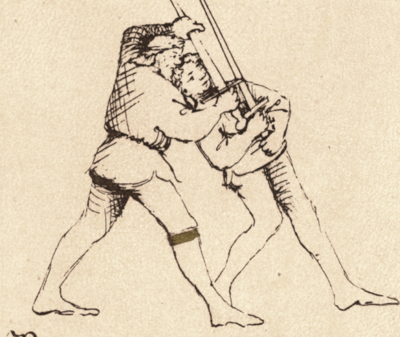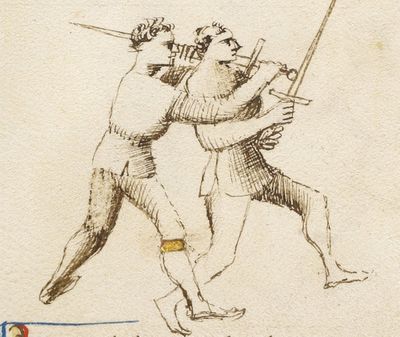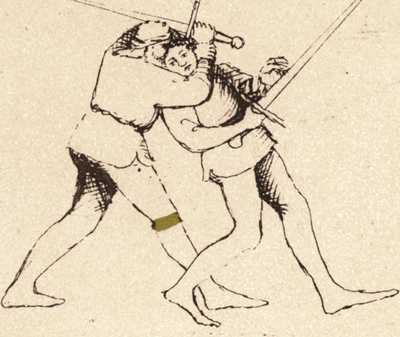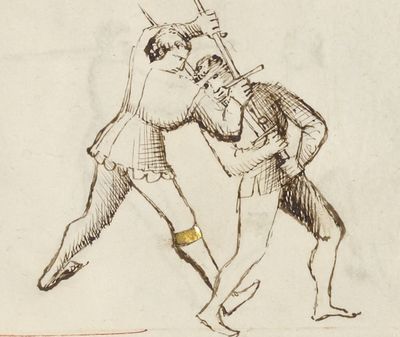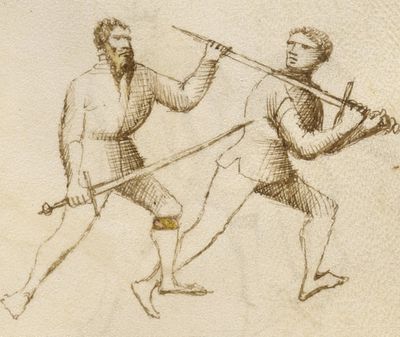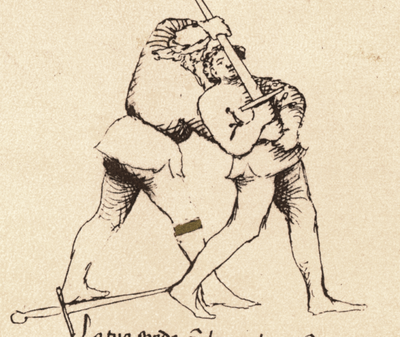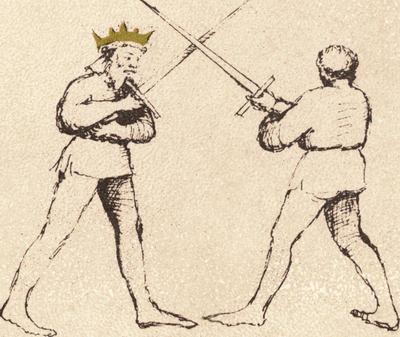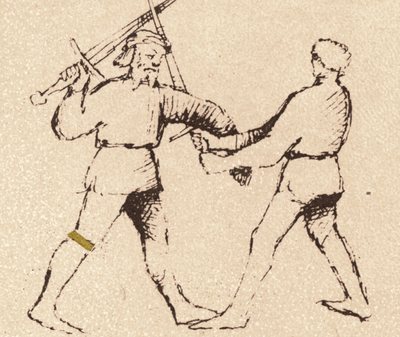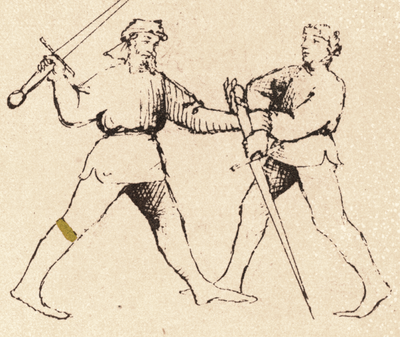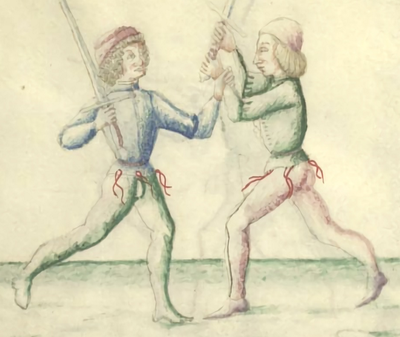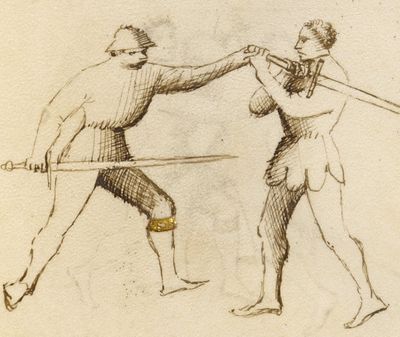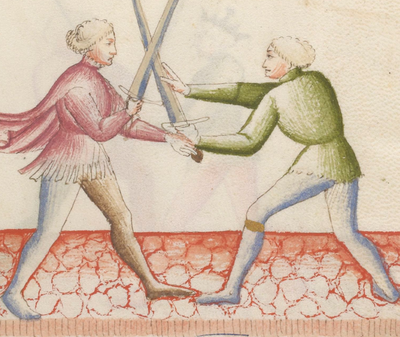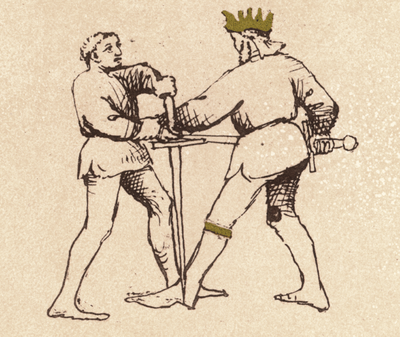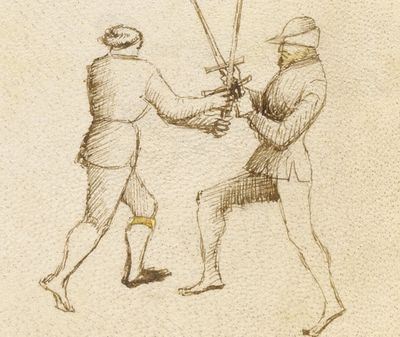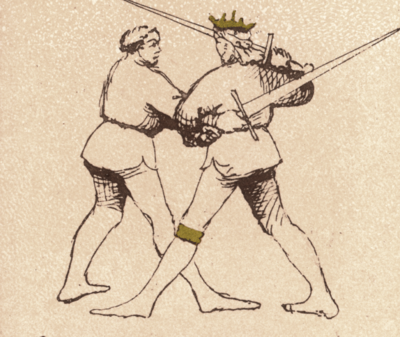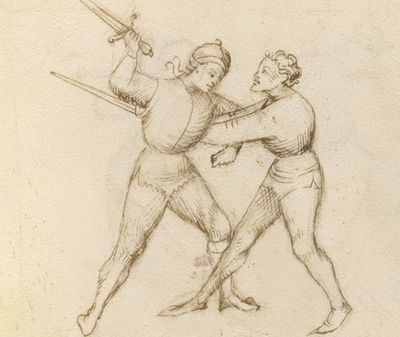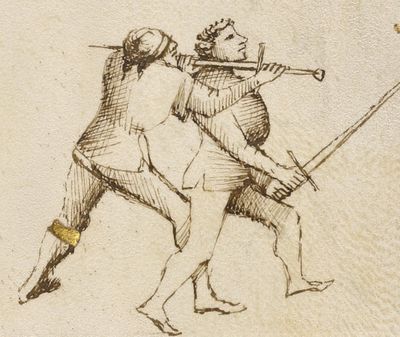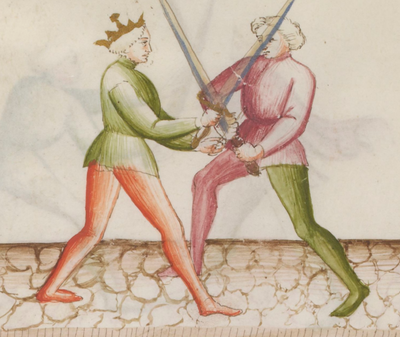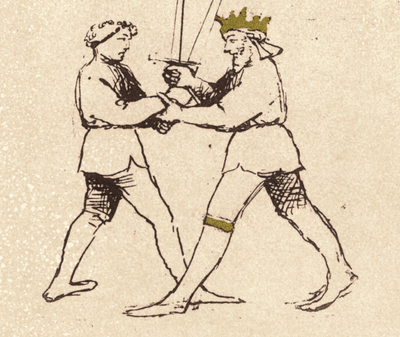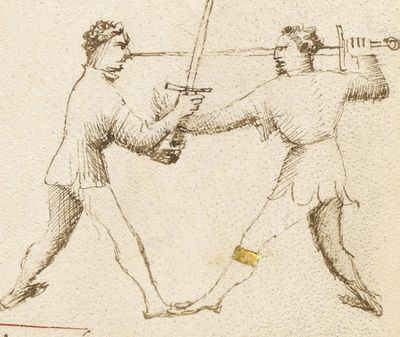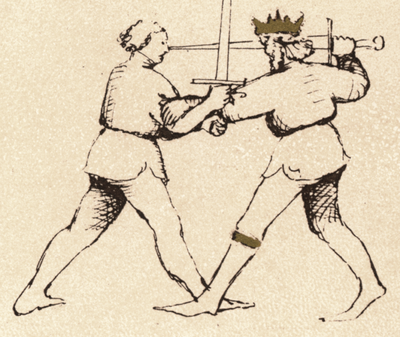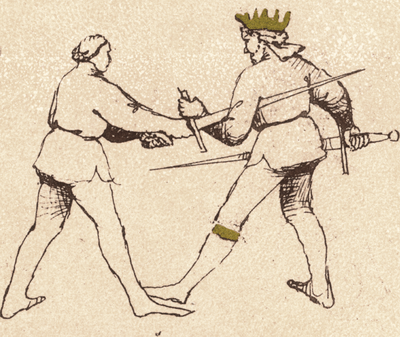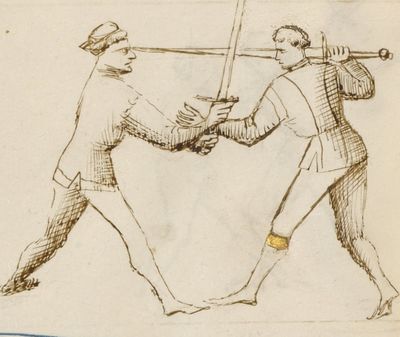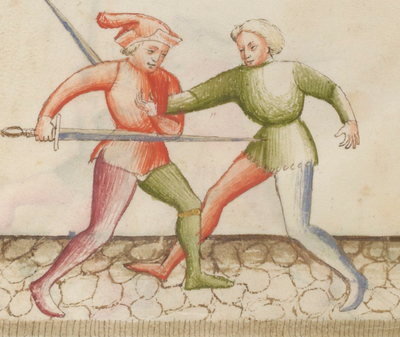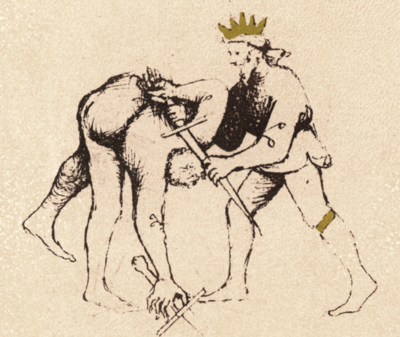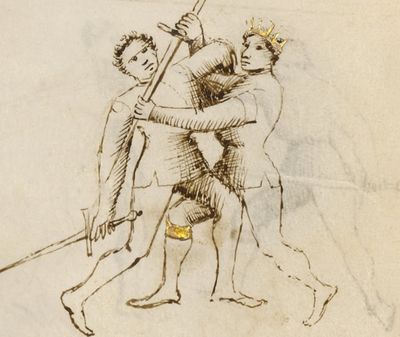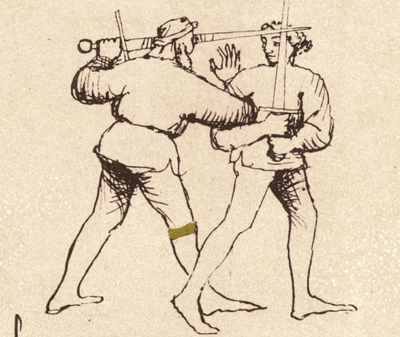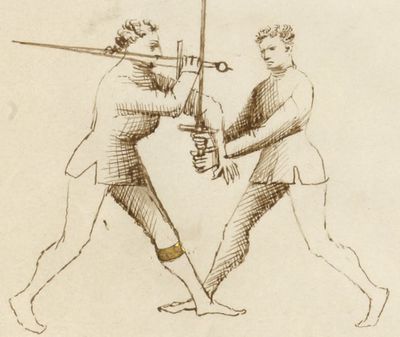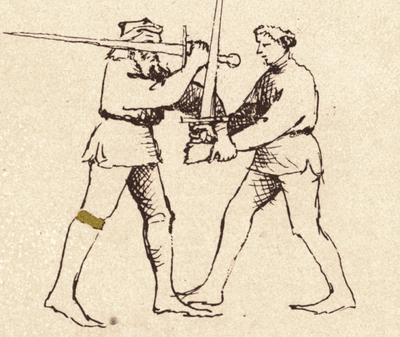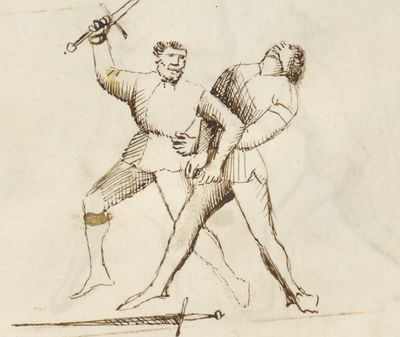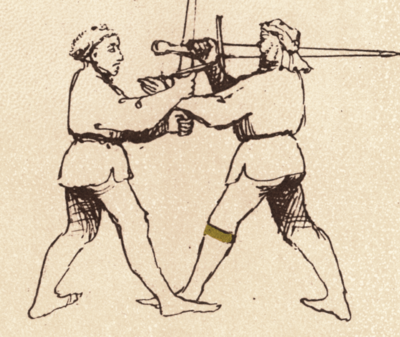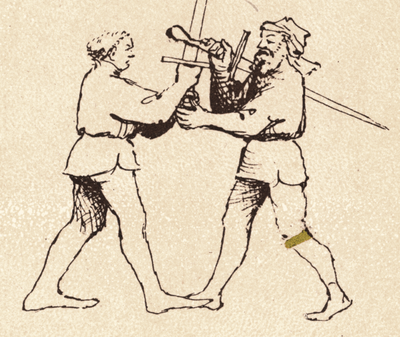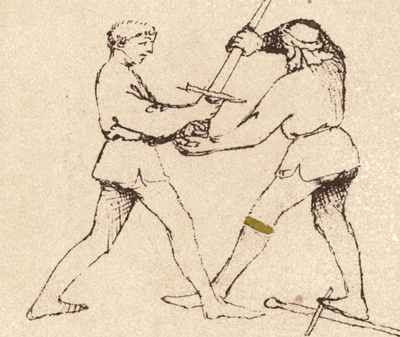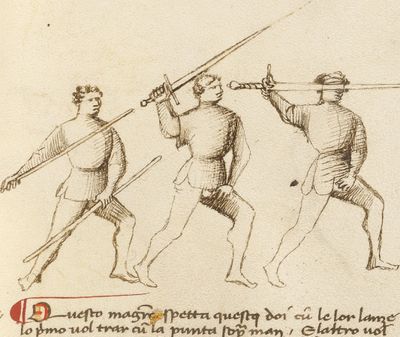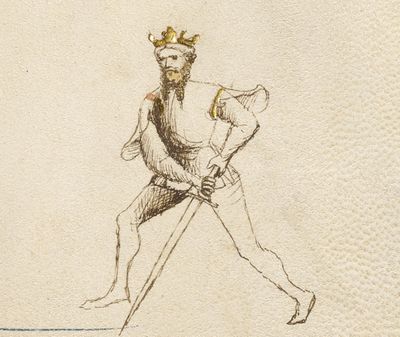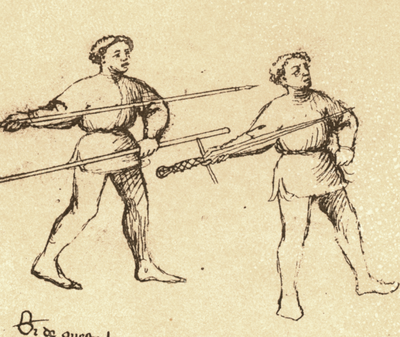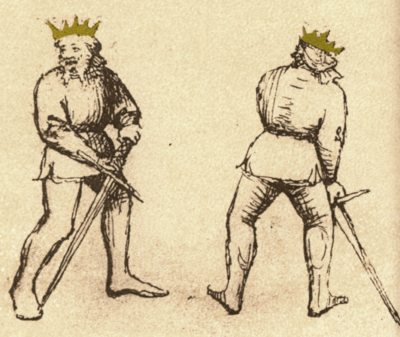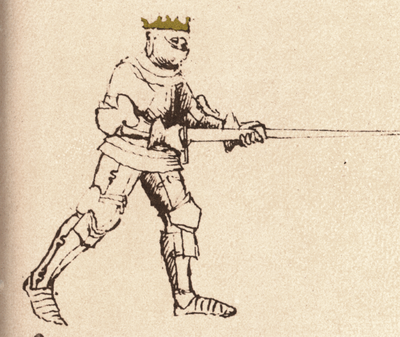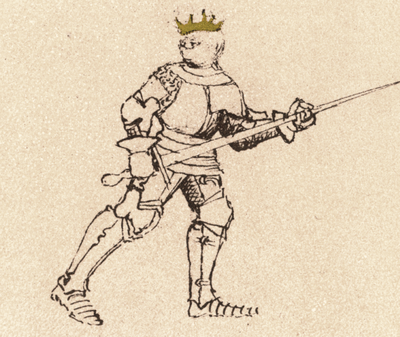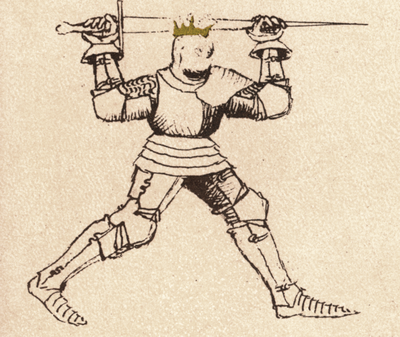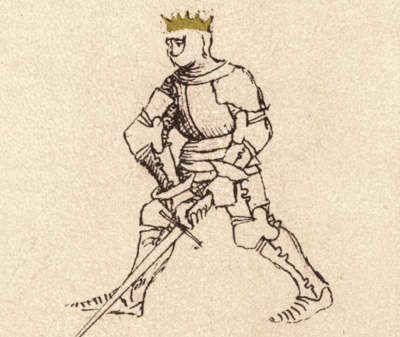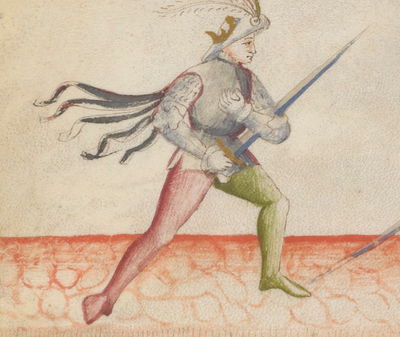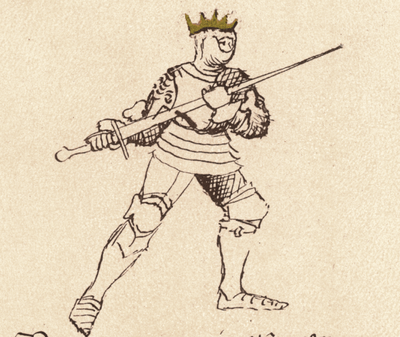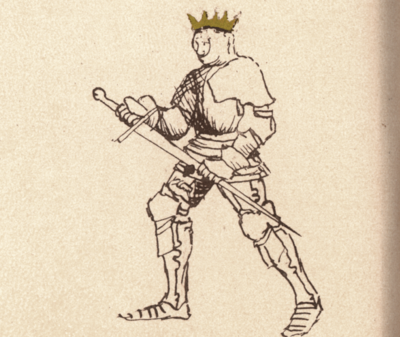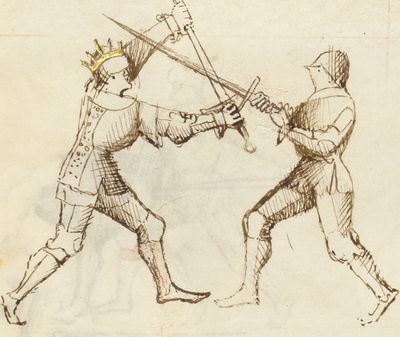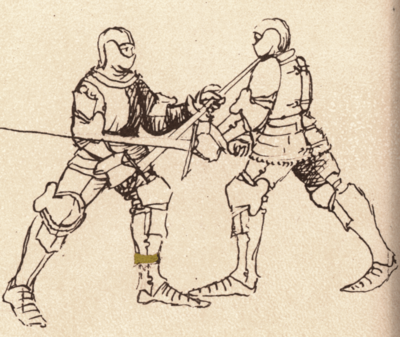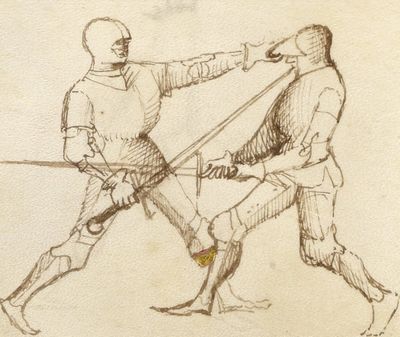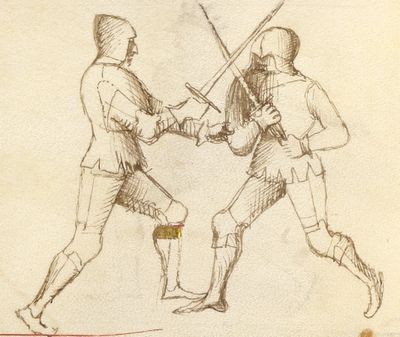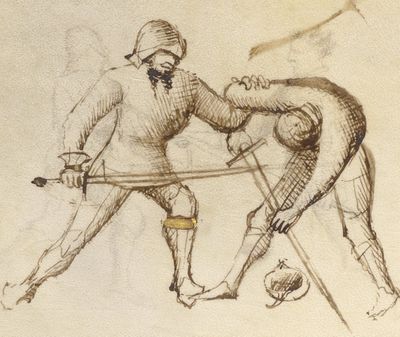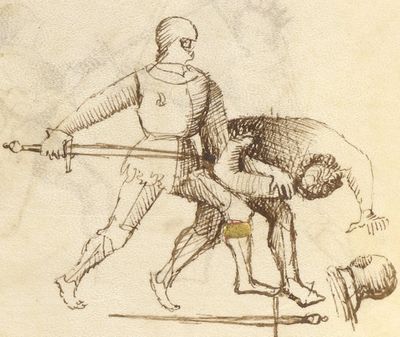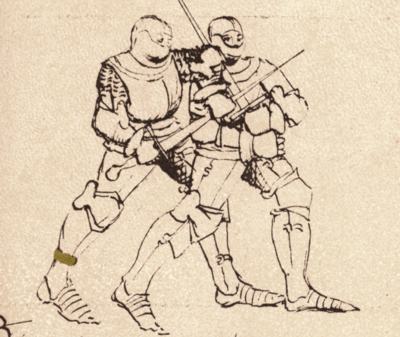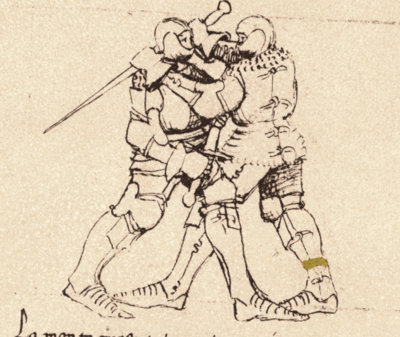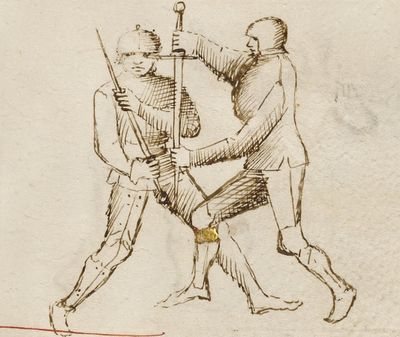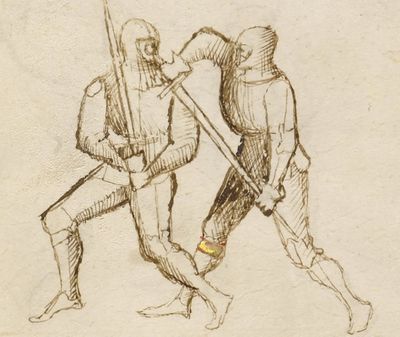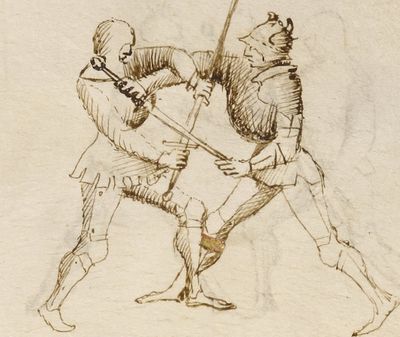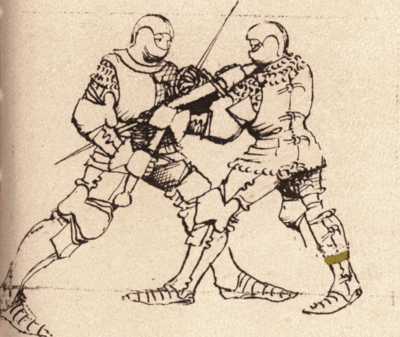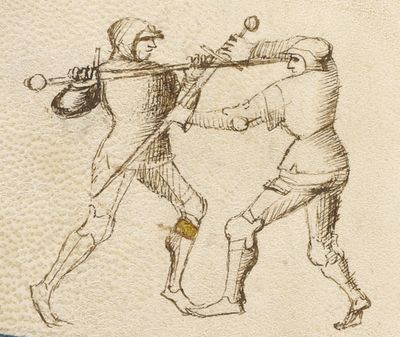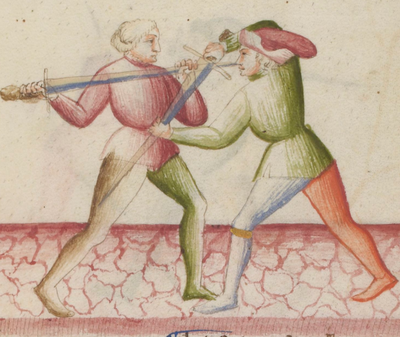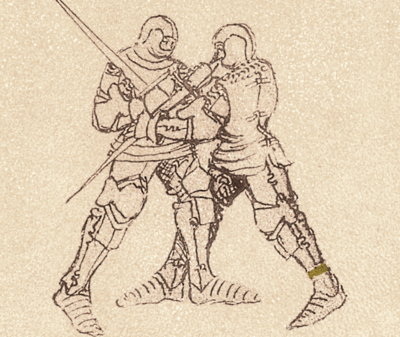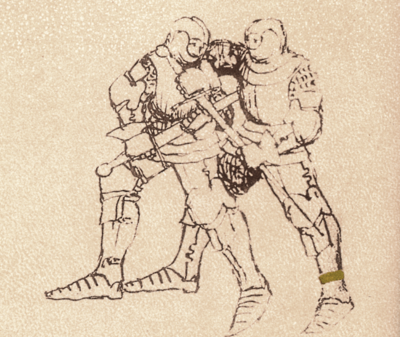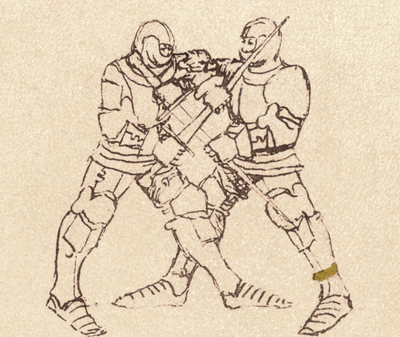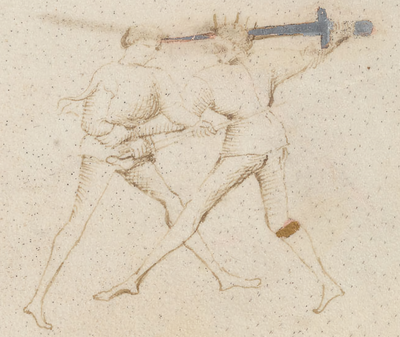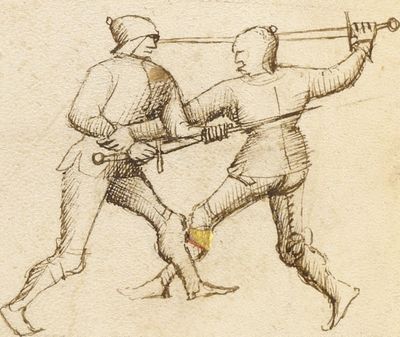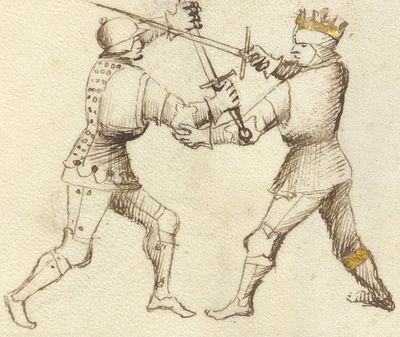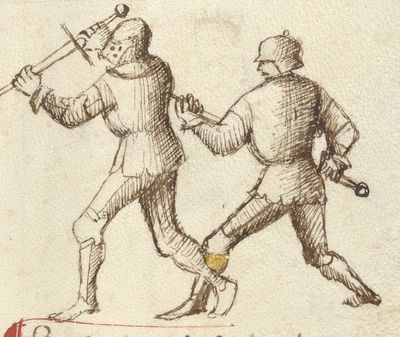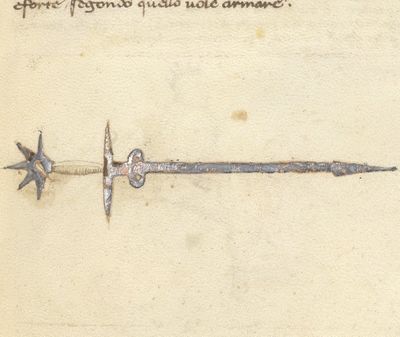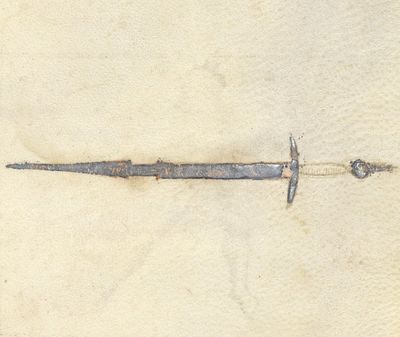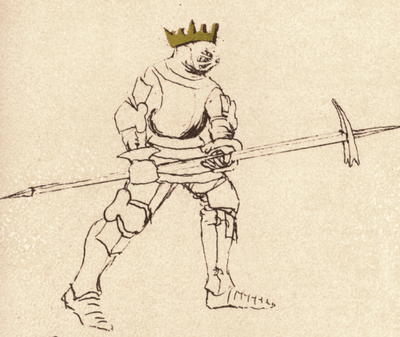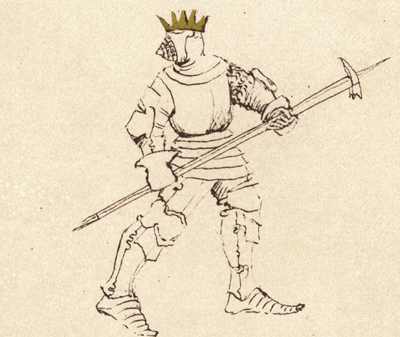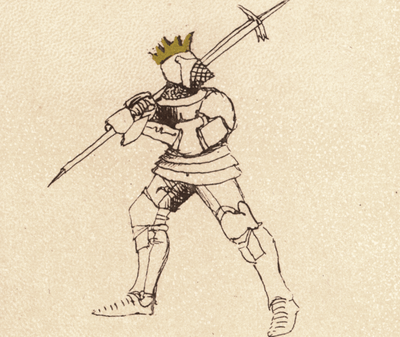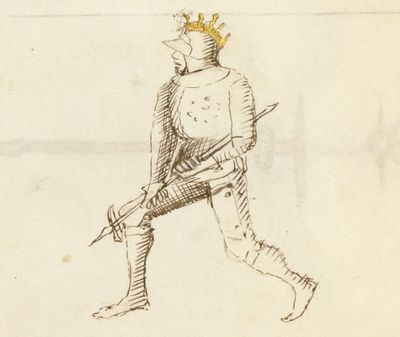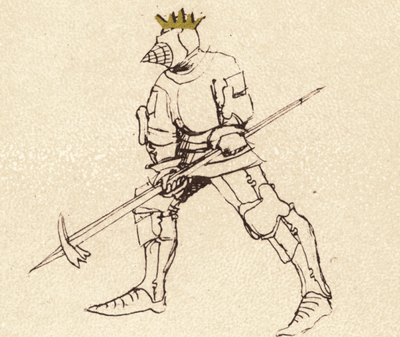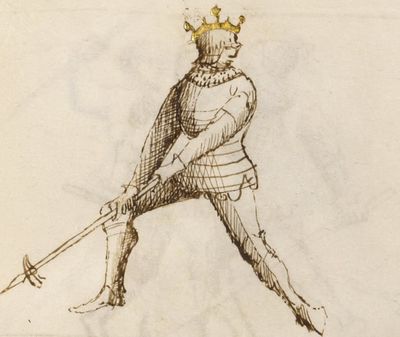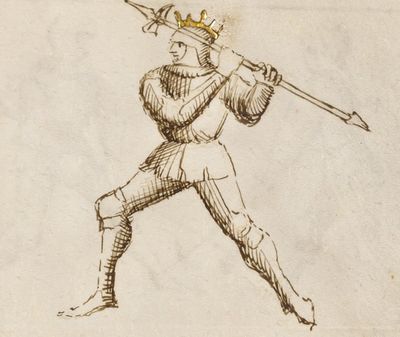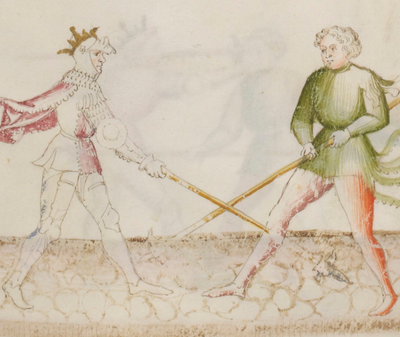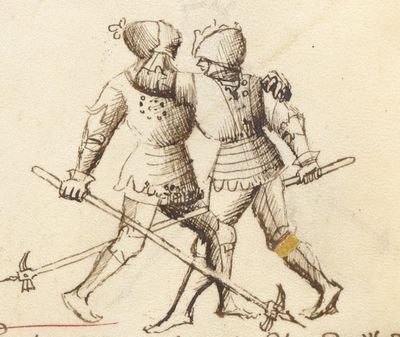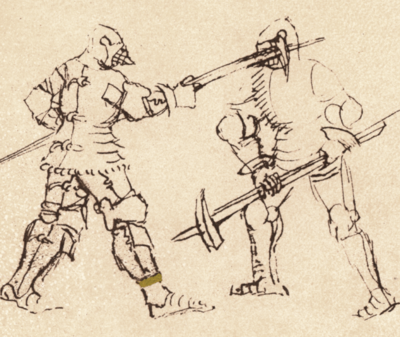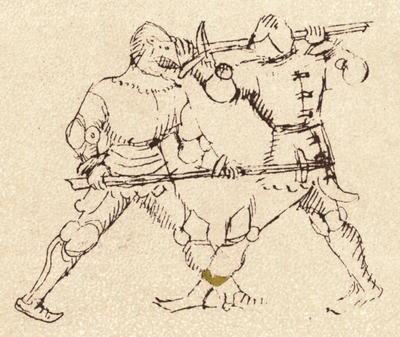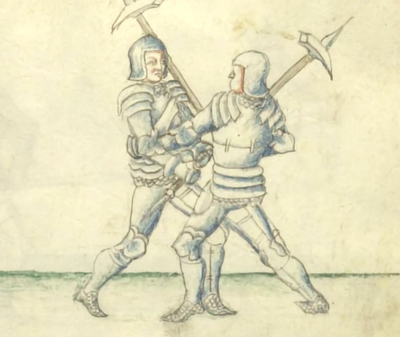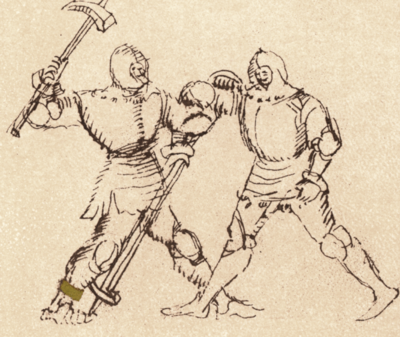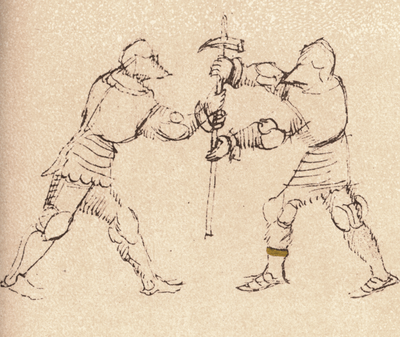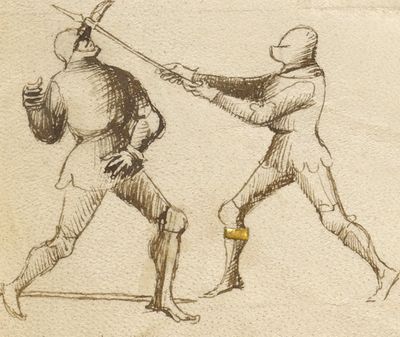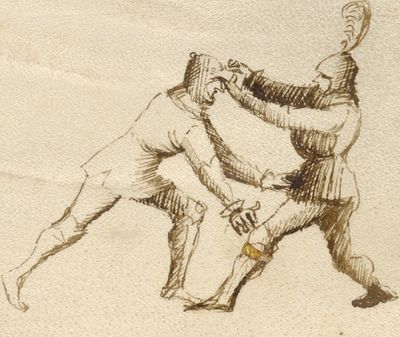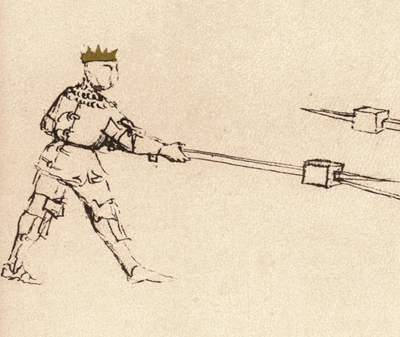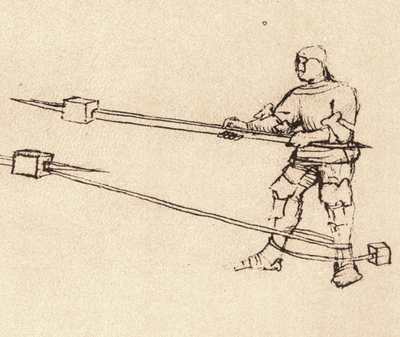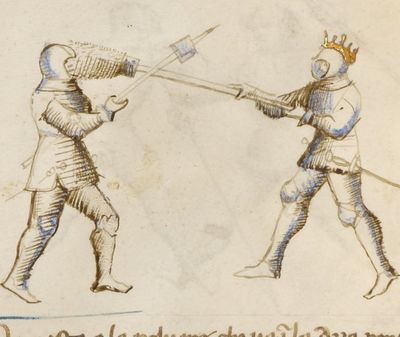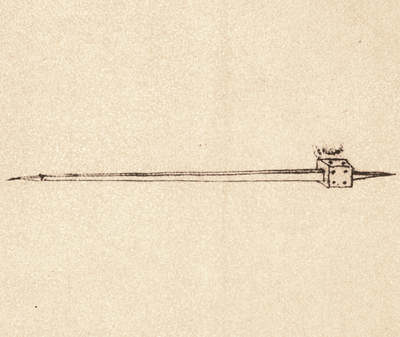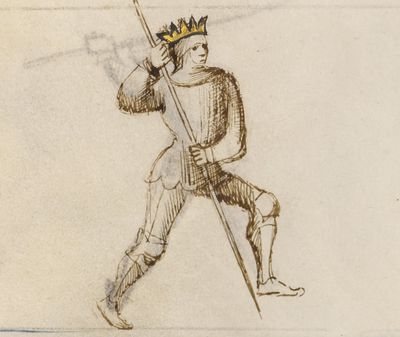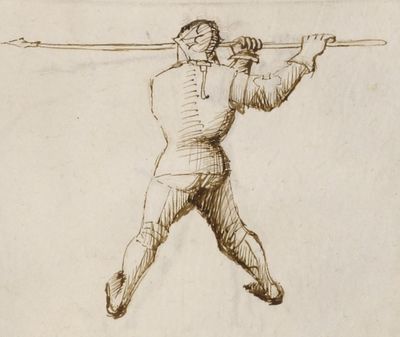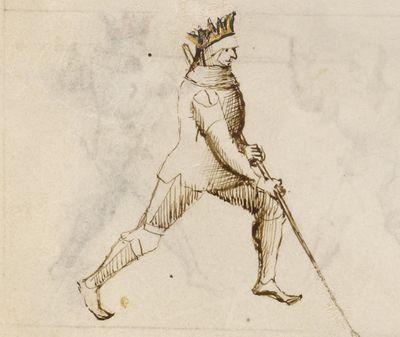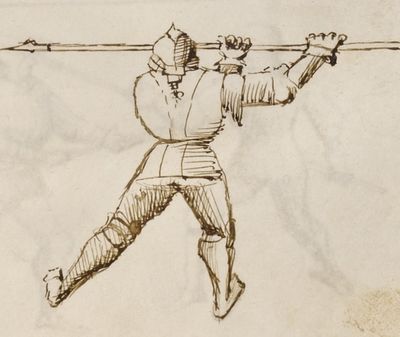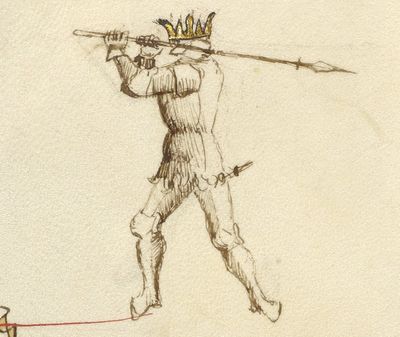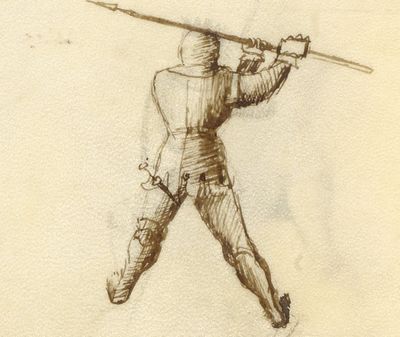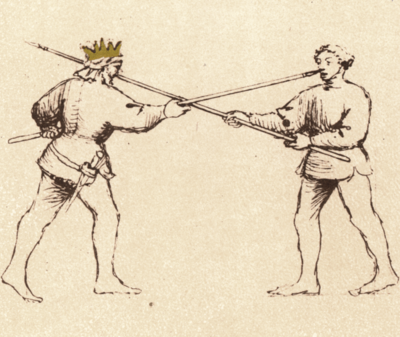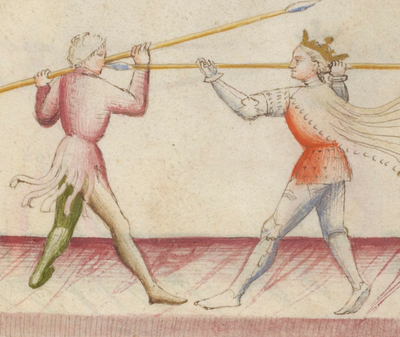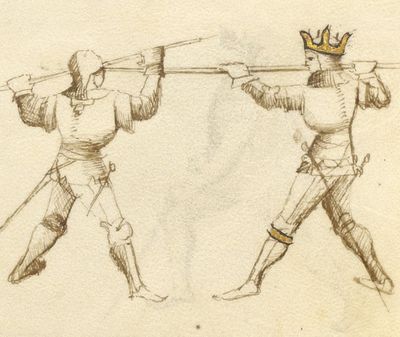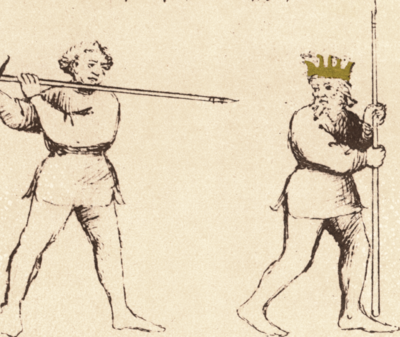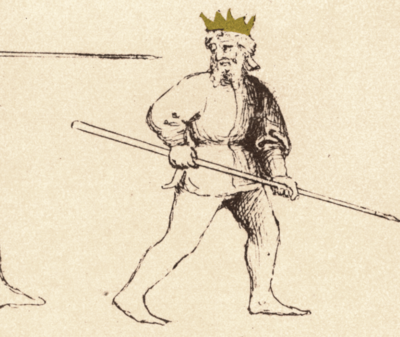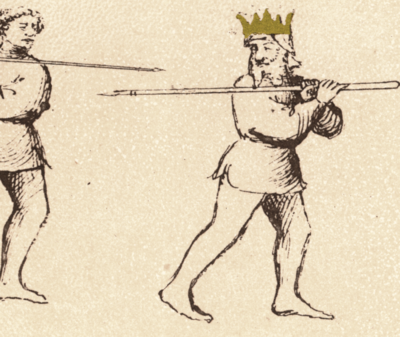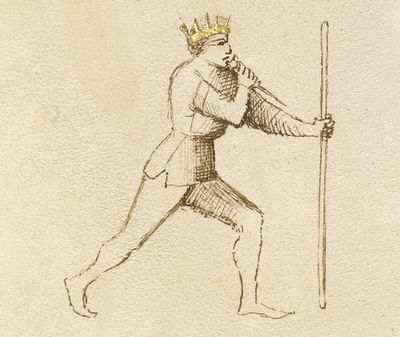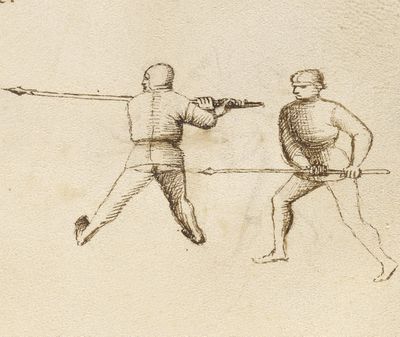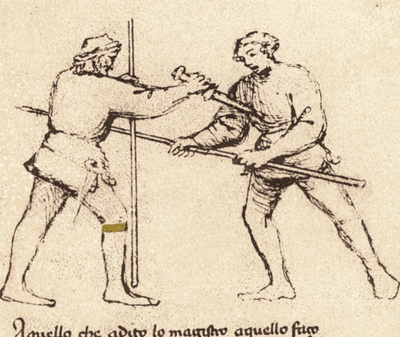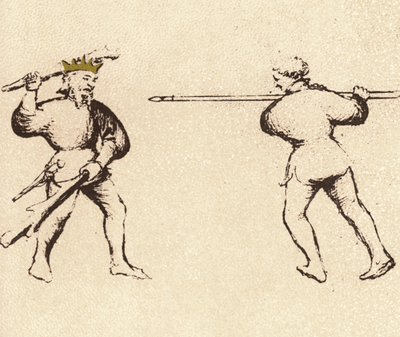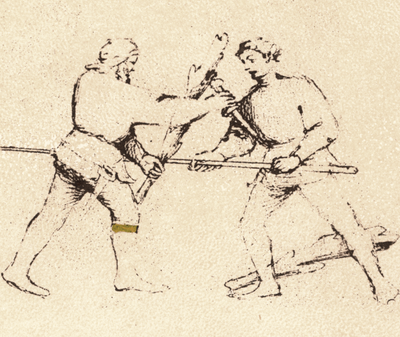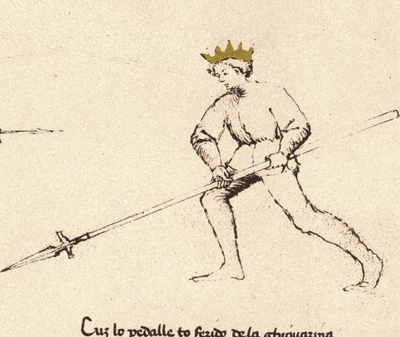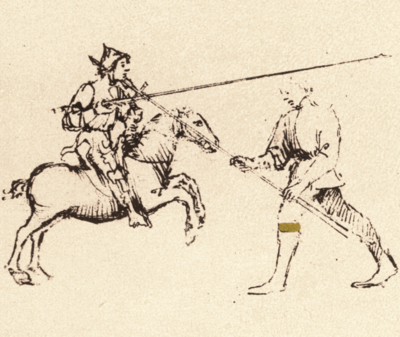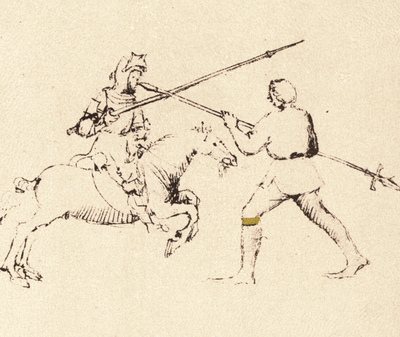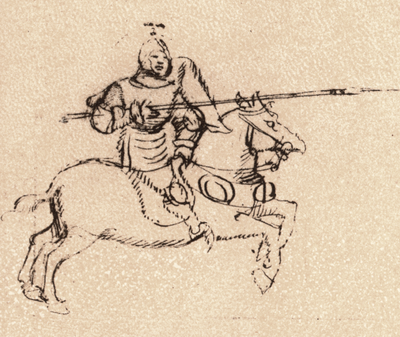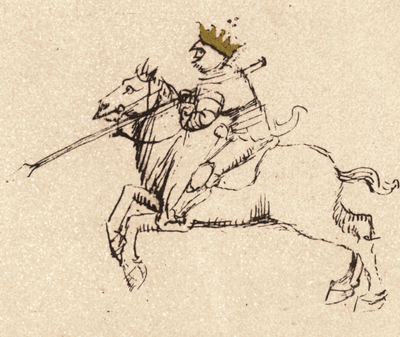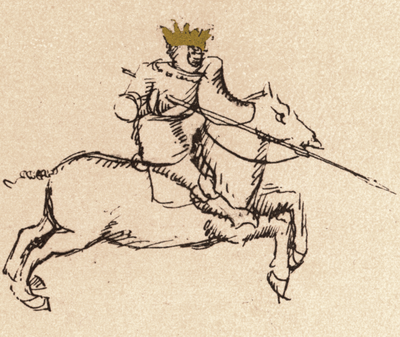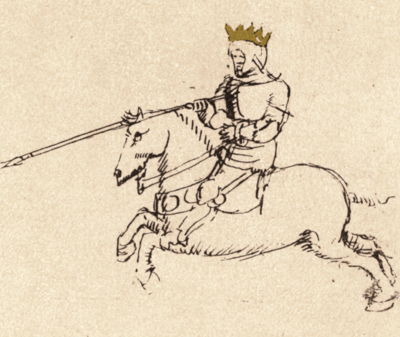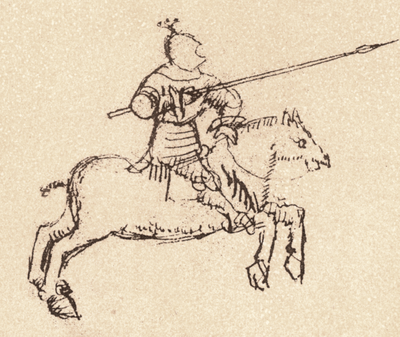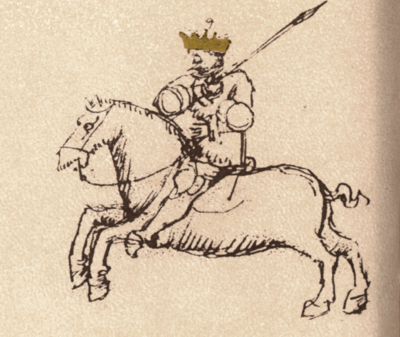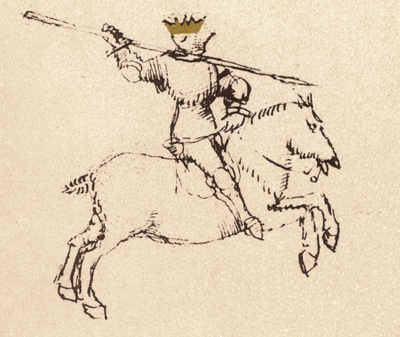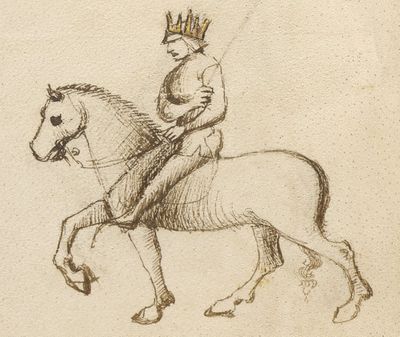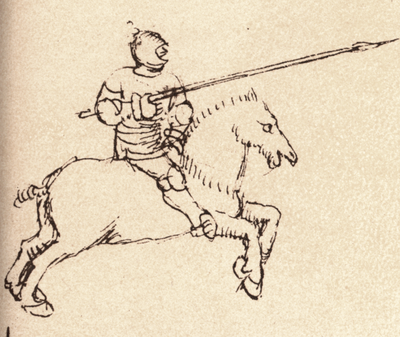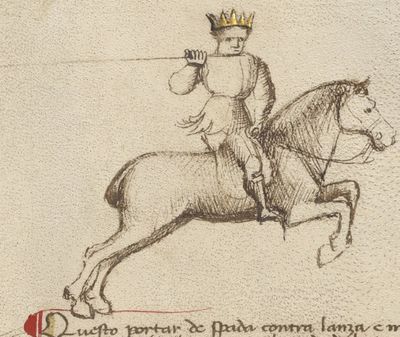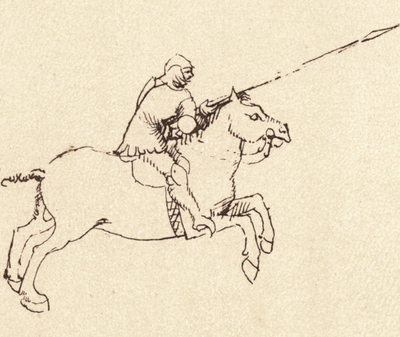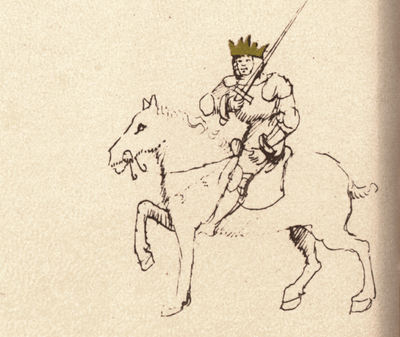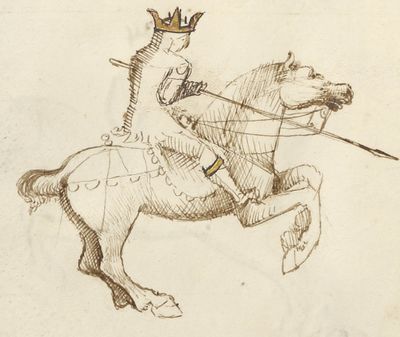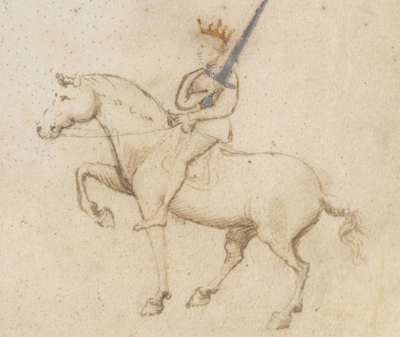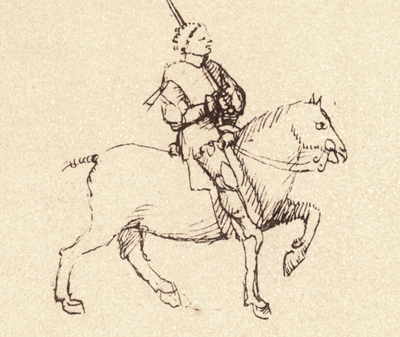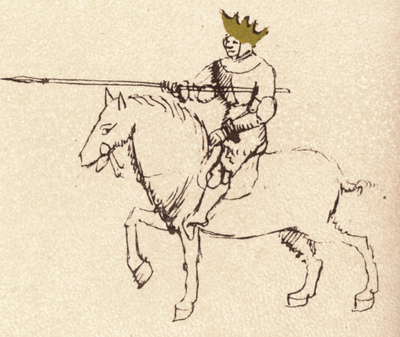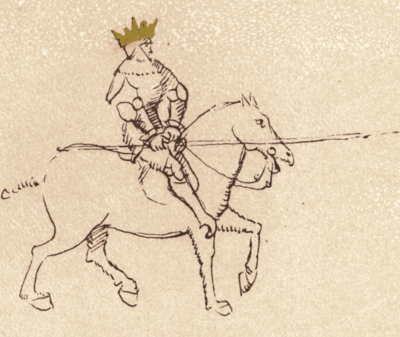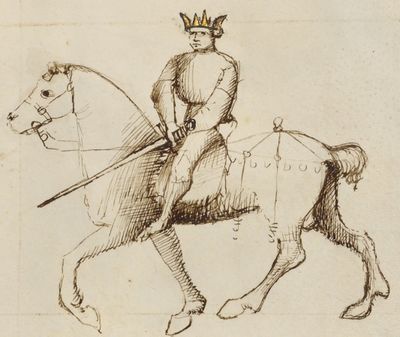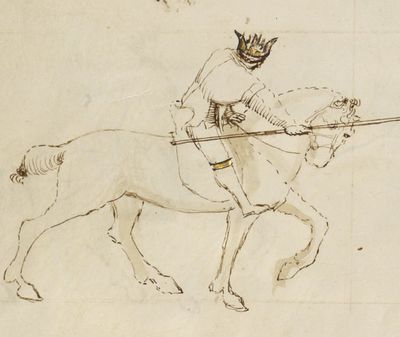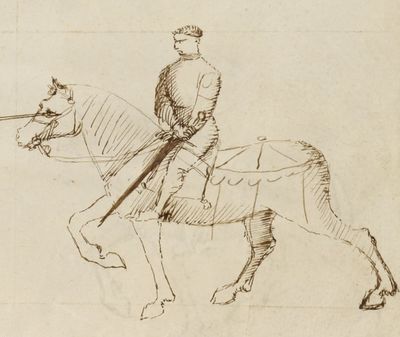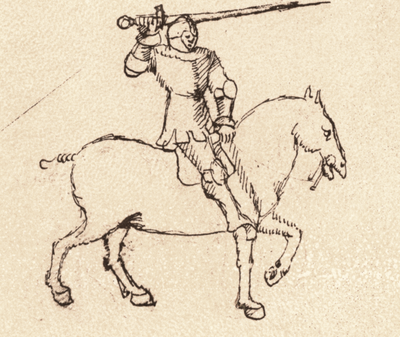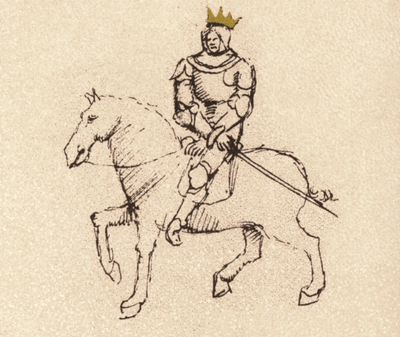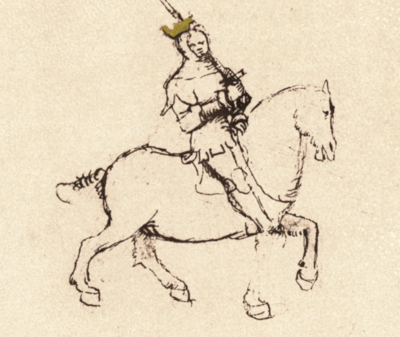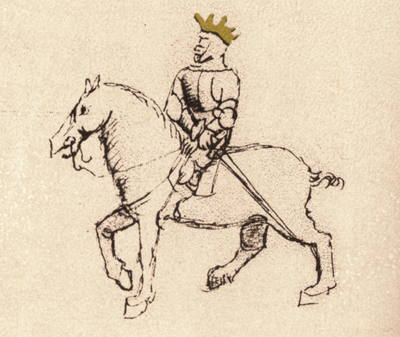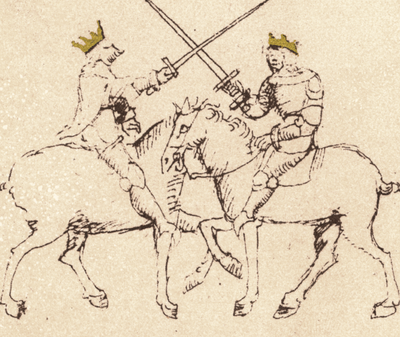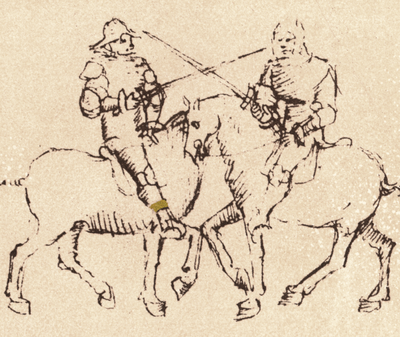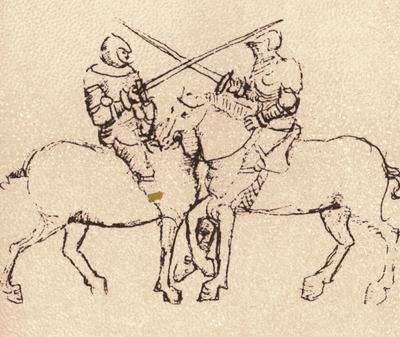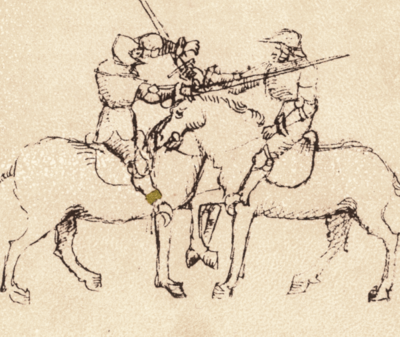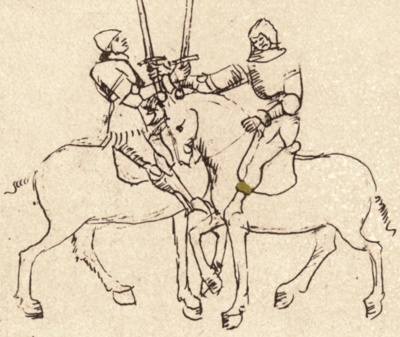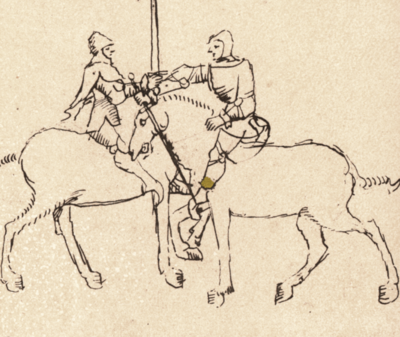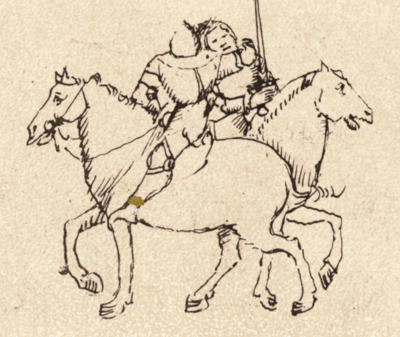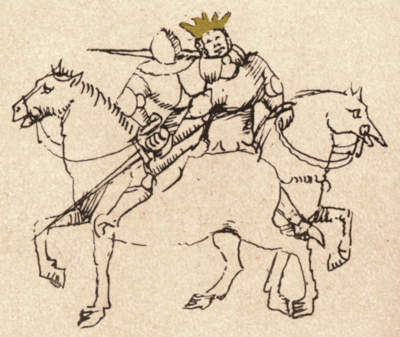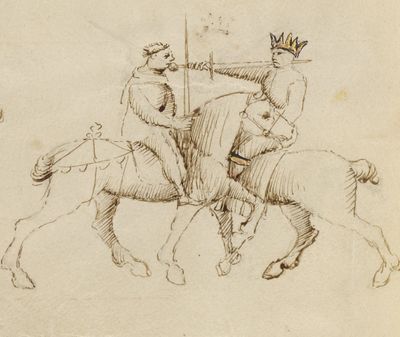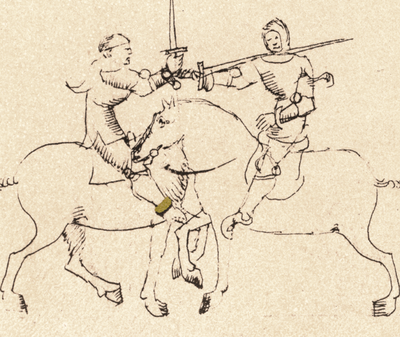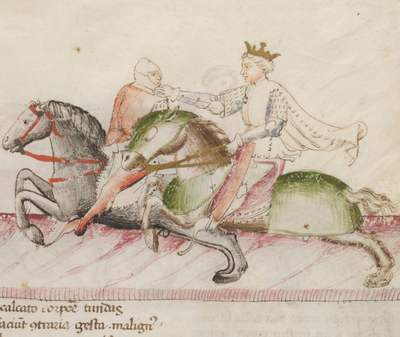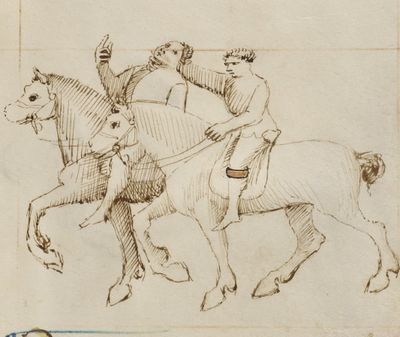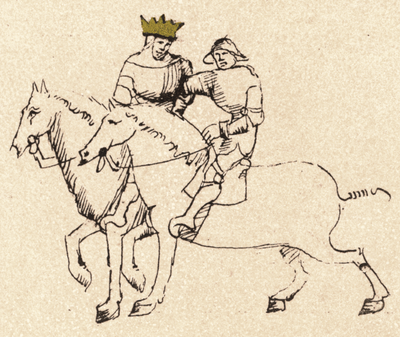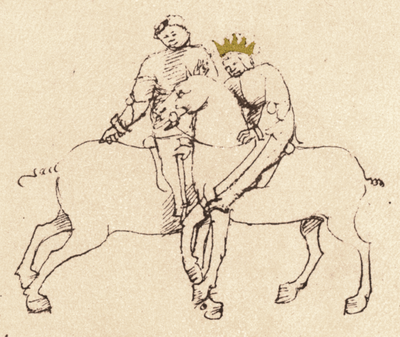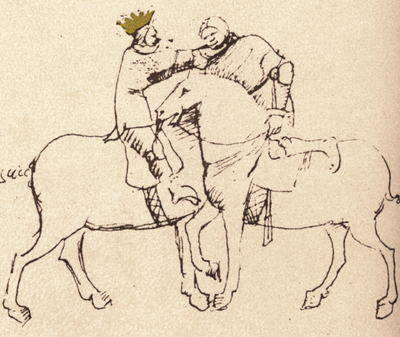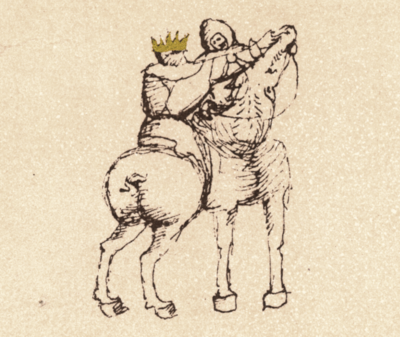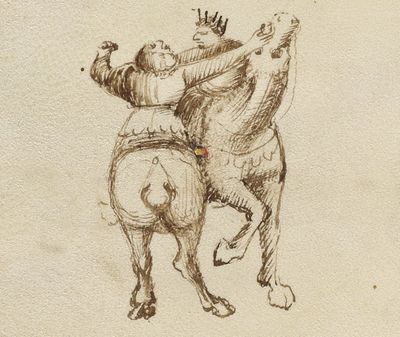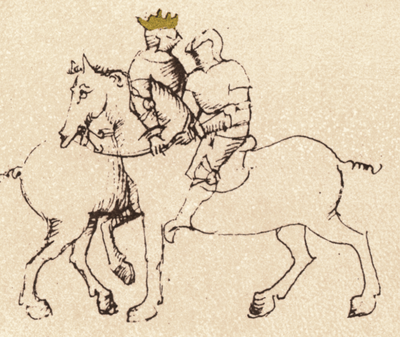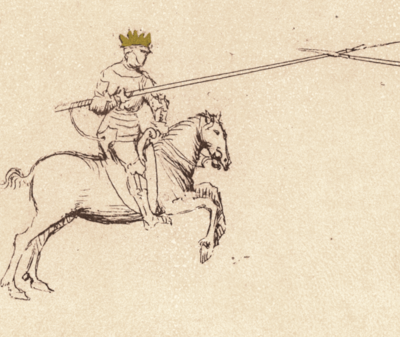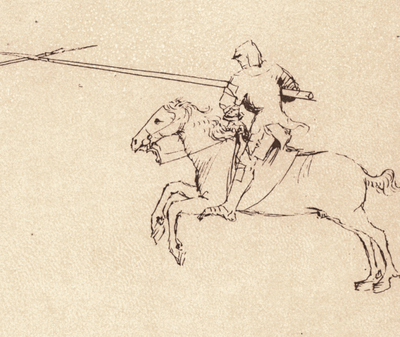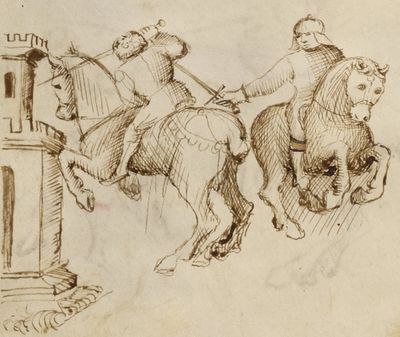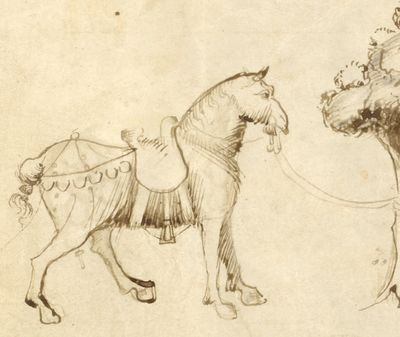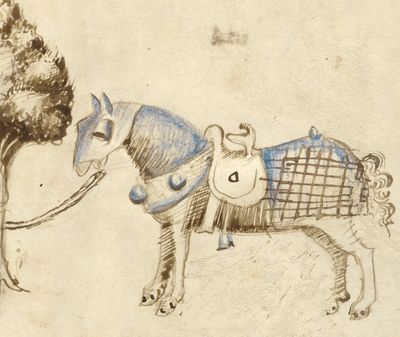|
|
You are not currently logged in. Are you accessing the unsecure (http) portal? Click here to switch to the secure portal. |
Difference between revisions of "Fiore de'i Liberi"
| Line 6,110: | Line 6,110: | ||
| | | | ||
| [[File:Pisani-Dossi MS 26b-b.png|400px|center]] | | [[File:Pisani-Dossi MS 26b-b.png|400px|center]] | ||
| − | | <p>[23] <em>I | + | | <p>[23] <em>I send you to the ground with my hilt,<br/>And then I waste you with my point.</em></p> |
| <p>''Learned in my art, I will turn your body face-up onto the ground.<br/>Henceforth, I will penetrate your gloomy self with my point.''</p> | | <p>''Learned in my art, I will turn your body face-up onto the ground.<br/>Henceforth, I will penetrate your gloomy self with my point.''</p> | ||
Revision as of 20:01, 27 June 2023
| Fiore Furlano de’i Liberi | |
|---|---|
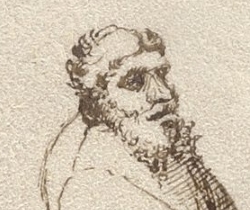 This man appears sporadically throughout both the Getty and Pisani Dossi MSS, and may be a representation of Fiore himself. | |
| Born | Cividale del Friuli |
| Relative(s) | Benedetto de’i Liberi (father) |
| Occupation |
|
| Nationality | Friulian |
| Patron |
|
| Influences | |
| Influenced | Philippo di Vadi |
| Genres | |
| Language | |
| Notable work(s) | The Flower of Battle |
| Manuscript(s) |
Pisani Dossi MS (1409)
|
| Concordance by | Michael Chidester |
| Translations | |
Fiore Furlano de’i Liberi de Cividale d’Austria (Fiore delli Liberi, Fiore Furlano, Fiore de Cividale d’Austria; fl. 1381 - 1409) was a late 14th century knight, diplomat, and fencing master. He was born in Cividale del Friuli, a town in the Patriarchal State of Aquileia (in the Friuli region of modern-day Italy), the son of Benedetto and scion of a Liberi house of Premariacco.[1][2][3] The term Liberi, while potentially merely a surname, more probably indicates that his family had Imperial immediacy (Reichsunmittelbarkeit), either as part of the nobili liberi (Edelfrei, "free nobles"), the Germanic unindentured knightly class which formed the lower tier of nobility in the Middle Ages, or possibly of the rising class of Imperial Free Knights.[4][5][6] It has been suggested by various historians that Fiore and Benedetto were descended from Cristallo dei Liberi of Premariacco, who was granted immediacy in 1110 by Holy Roman Emperor Heinrich V,[7][8][9] but this has yet to be proven.[10]
Fiore wrote that he had a natural inclination to the martial arts and began training at a young age, ultimately studying with “countless” masters from both Italic and Germanic lands.[1][2][3] He had ample opportunity to interact with both, traveling widely in the Italian states that formed the border of the Holy Roman Empire. Unfortunately, not all of these encounters were friendly: Fiore wrote of meeting many “false” or unworthy masters in his travels, most of whom lacked even the limited skill he'd expect in a good student.[3] He further mentions that on five separate occasions he was forced to fight duels for his honor against certain of these masters who he described as envious because he refused to teach them his art; the duels were all fought with sharp swords, unarmored except for gambesons and chamois gloves, and he won each without injury.[1][2][11]
Writing very little on his own career as condottiero, Fiore laid out his credentials for his readers in other ways. He stated that foremost among the masters who trained him was one Johane dicto Suueno, who he notes was a disciple of Nicholai de Toblem;[3] unfortunately, both names are given in Latin so there is little we can conclude about them other than that they were probably among the Italians and Germans he alludes to, and that one or both were well known in Fiore's time. He further offered an extensive list of the famous condottieri that he trained, including Piero Paolo del Verde (Peter von Grünen),[12] Niccolo Unricilino (Nikolo von Urslingen),[13] Galeazzo Cattaneo dei Grumelli (Galeazzo Gonzaga da Mantova),[14] Lancillotto Beccaria di Pavia,[15] Giovannino da Baggio di Milano,[16] and Azzone di Castelbarco,[17] and also highlights some of their martial exploits.[1][2]
The only known historical mentions of Fiore appear in connection with the Aquileian War of Succession, which erupted in 1381 as a coalition of secular nobles from Udine and surrounding cities sought to remove the newly appointed Patriarch (prince-bishop of Aquileia), Philippe Ⅱ Cardinal d'Alençon. Fiore seems to have supported the secular nobility against the Cardinal; he traveled to Udine in 1383 and was granted residency in the city on 3 August.[18] On 30 September, the high council tasked him with inspection and maintenance of city's weapons, including the artillery pieces defending Udine (large crossbows and catapults).[5][19][20] In February of 1384, he was assigned the task of recruiting a mercenary company to augment Udine's forces and leading them back to the city.[21] This task seems to have been accomplished in three months or less, as on 23 May he appeared before the high council again and was sworn in as a sort of magistrate charged with keeping the peace in one of the city's districts. After May 1384, the historical record is silent on Fiore's activities; the war continued until a new Patriarch was appointed in 1389 and a peace settlement was reached, but it's unclear if Fiore remained involved for the duration. Given that he appears in council records four times in 1383-4, it would be quite odd for him to be completely unmentioned over the subsequent five years if he remained,[5][22] and since his absence from records coincides with a proclamation in July of that year demanding that Udine cease hostilities or face harsh repercussions, it seems more likely that he moved on.
Based on his autobiographical account, Fiore traveled a good deal in northern Italy, teaching fencing and training men for duels. He seems to have been in Perugia in 1381 in this capacity, when his student Peter von Grünen likely fought a duel with Peter Kornwald.[23]
In 1395, he can be placed in Padua training the mercenary captain Galeazzo Gonzaga of Mantua for a duel with the French marshal Jean Ⅱ le Maingre (who went by the war name “Boucicaut”). Galeazzo made the challenge when Boucicaut called into question the valor of Italians at the royal court of France, and the duel was ultimately set for Padua on 15 August. It was jointly hosted by Francesco Novello da Carrara, Lord of Padua, and Francesco Gonzaga, Lord of Mantua. The duel was to begin with spears on horseback, but Boucicaut became impatient and dismounted, attacking Galeazzo before he could mount his own horse. Galeazzo landed a solid blow on the Frenchman’s helmet, but was subsequently disarmed. At this point, Boucicaut called for his poleaxe but the lords intervened to end the duel.[24][20][14]
Fiore surfaces again in Pavia in 1399, this time training Giovannino da Baggio for a duel with a German squire named Sirano. It was fought on 24 June and hosted by Gian Galeazzo Visconti, Duke of Milan. The duel was to consist of three bouts of mounted lance followed by three bouts each of dismounted poleaxe, estoc, and dagger. They ultimately rode two additional passes and on the fifth, Baggio impaled Sirano’s horse through the chest, slaying the horse but losing his lance in the process. They fought the other nine bouts as scheduled, and due to the strength of their armor (and the fact that all of the weapons were blunted), both combatants reportedly emerged from these exchanges unharmed.[16][25]
Fiore was likely involved in at least one other duel that year, that of his final student Azzone di Castelbarco against Giovanni degli Ordelaffi, as the latter is known to have died in 1399.[26] After Castelbarco’s duel, Fiore’s activities are unclear. Based on the allegiances of the nobles that he trained in the 1390s, he seems to have been associated with the ducal court of Milan in the latter part of his career.[20] Some time in the first years of the 1400s, Fiore composed a fencing treatise in Italian and Latin called "The Flower of Battle" (rendered variously as Fior di Battaglia, Florius de Arte Luctandi, and Flos Duellatorum). The briefest version of the text is dated to 1409 and indicates that it was a labor of six months and great personal effort;[3] since evidence suggests that at least two longer versions were composed some time before this,[27] we may assume that he devoted a considerable amount of time to writing during this decade.
Beyond this, nothing certain is known of Fiore's activities in the 15th century. Francesco Novati and Luigi Zanutto both assume that some time before 1409 he accepted an appointment as court fencing master to Niccolò Ⅲ d’Este, Marquis of Ferrara, Modena, and Parma; presumably he would have made this change when Milan fell into disarray in 1402, though Zanutto went so far as to speculate that he trained Niccolò for his 1399 passage at arms.[28] However, while the records of the d’Este library indicate the presence of two versions of "the Flower of Battle", it seems more likely that the manuscripts were written as a diplomatic gift to Ferrara from Milan when they made peace in 1404.[25][20] C. A. Blengini di Torricella stated that late in life he made his way to Paris, France, where he could be placed teaching fencing in 1418 and creating a copy of a fencing manual located there in 1420. Though he attributes these facts to Novati, no publication verifying them has yet been located and this anecdote may be entirely spurious.[29]
The time and place of Fiore's death remain unknown.
Despite the extent and complexity of his writings, Fiore de’i Liberi does not seem to have been a very significant master in the evolution of fencing in Central Europe. That field was instead dominated by the traditions of two masters of the subsequent generation: Johannes Liechtenauer in Bavaria and Filippo di Bartolomeo Dardi in Bologna. Even so, there are a few later treatises which bear strong resemblance to his work, including the writings of Philippo di Vadi and Ludwig VI von Eyb. This may be due to the direct influence of Fiore or his writings, or it may instead indicate that the older tradition of Johane and Nicholai survived and spread outside of Fiore's direct line.
Contents
- 1 Treatise
- 2 Additional Resources
- 3 References
Treatise
The d’Este family owned at least three manuscripts by Fiore during the 15th century,[30] and a total of four copies survive to the present. Of these, the MS Ludwig ⅩⅤ 13 (Getty) and the Pisani Dossi MS (Novati) are both dedicated to Niccolò Ⅲ d’Este and state that they were written at his request and according to his design. The MS M.383 (Morgan), on the other hand, lacks a dedication and claims to have been laid out according to his own intelligence, while the MS Latin 11269 (Paris) lost any dedication it might have had along with its prologue. Each of the extant copies of the Flower of Battle follows a unique specific sequence of plays, though the Getty and Novati contain strong similarities to each other in order of presentation, as do the Morgan and Paris.
In addition, Philippo di Vadi’s manuscript from the 1480s, whose second half is essentially a redaction of the Flower of Battle, provides a valuable fifth point of reference when considering Fiore’s teachings. (These is also a 17th century copy of the Morgan’s preface, transcribed by Apostolo Zeno, but it contributes little to our understanding of the text.)
The major sections of the work include: abrazare or grappling; daga, including both unarmed defenses against the dagger and plays of dagger against dagger; spada a un mano, the use of the sword in one hand (also called "the sword without the buckler"); spada a dui mani, the use of the sword in two hands; spada en arme, the use of the sword in armor (primarily techniques from the shortened sword); azza, plays of the poleaxe in armor; lancia, spear and staff plays; and mounted combat (including the spear, the sword, and mounted grappling). Brief bridging sections serve to connect each of these, covering such topics as bastoncello, or plays of a small stick or baton against unarmed and dagger-wielding opponents; plays of sword vs. dagger; plays of staff and dagger and of two clubs and a dagger; and the use of the chiavarina against a man on horseback.
The format of instruction is largely consistent across all copies of the treatise. Each section begins with a group of Masters (or Teachers), figures in golden crowns who each demonstrate a particular guard for use with their weapon. These are followed by a master called Remedio ("Remedy") who demonstrates a defensive technique against some basic attack (usually how to use one of the listed guards to defend), and then by his various Scholars (or Students), figures wearing golden garters on their legs who demonstrate iterations and variations of this remedy. After the scholars there is typically a master called Contrario ("Counter" or "Contrary"), wearing both crown and garter, who demonstrates how to counter the master’s remedy (and those of his scholars), who is likewise sometimes followed by his own scholars in garters. In rare cases, a fourth type of master appears called Contra-Contrario ("Counter-counter"), who likewise wears the crown and garter and demonstrates how to defeat the master’s counter. Some sections feature multiple master remedies or master counters, while some have only one. While the crowns and garters are used across all extant versions of the treatise, the specific implementation of the system varies; all versions include at least a few apparently errors in assignation of crowns and garters, and there are many cases in which an illustration in one manuscript will only feature a scholar’s garter where the corresponding illustration in another also includes a master’s crown (depending on the instance, this may either be intentional or merely an error in the art). Alone of the four versions, the Morgan seeks to further expand the system by coloring the metallic portions of the master or scholar’s weapon silver, while that of the player is left uncolored; this is also imperfectly-executed, but seems to have been intended as a visual indicator of which weapon belongs to which figure.
The concordance below includes Zeno’s transcription of the Morgan preface for reference, and then drops the (thereafter empty) column in favor of a second illustration column for the main body of the treatise. (The Zeno transcript is in the first transcription column even though it’s the youngest source so that the others can remain in the same position throughout.) Generally only the right-side column will contain illustrations—the left-side column will only contain additional content when when the text describes an illustration that spans the width of the page in the manuscripts, or when there are significant discrepancies between the available illustrations (in such cases, they sometimes display two stages of the same technique and will be placed in "chronological" order if possible). The illustrations from the Getty, Morgan, and Paris are taken from high-resolution scans supplied by those institutions, whereas the illustrations of the Pisani Dossi are taken from Novati’s 1902 facsimile (scanned by Wiktenauer). There are likewise two translation columns, with the the two manuscripts dedicated to Niccolò on the left and the two undedicated manuscripts on the right; in both columns, the short text of the PD and Paris will come first, followed by the longer paragraphs of the Getty and Morgan.
Illustrations |
Illustrations |
Novati Translation |
Paris Translation |
Morgan Version (1400s) |
Getty Version (1400s) |
Pisani Dossi Version (1409) |
Paris Version (1420s) |
|---|---|---|---|---|---|---|---|
| [No illustration] | [1] In the name of God and Saint George, we begin our system with Grappling on foot, seeking to gain superior holds. Holds are not superior unless they give you an advantage. Thus we four Masters seek to achieve advantageous holds through the techniques you see depicted here. |
[4a-t] Principiamo prima in nome de dio e de meser sant zorzo delo abraçare a pe aguadagnare le prese. Le prese non son guadagnade se le non son cum avantaço, Pero noii ·ⅲⅰ· magistri cerchamo prese avantaçade chomo positi vedere dipento. |
|||||
[2] [The Long Guard] I am ready to show you how I win with my holds, |
Even if you capture me, I would win; I am truly prepared. |
[4a-a] Per guadagnar le prese e son aparichiato, |
[38v-a] ¶ Vt mihi prensuras lucrer, sum nempe paratus. | ||||
I am Posta Longa and I seek you like this. And in response to the first grapple that you attempt on me I will bring my right arm up under your left arm. And I will then execute the first play of Grappling. And with that lock I will force you to the ground. And if that lock looks like it will fail me, then I will switch to one of the other locks that follow. |
[6r-a] ¶ Io son posta longa e achosi te aspetto. E in la presa che tu mi voray fare. Lo mio brazo dritto che sta in erto. Sotto lo tuo stancho lo mettero per certo. E intrero in lo primo zogho de Abrazare. E cum tal presa in terra ti faro andare. E si aquella presa mi venisse a manchare. In le altre prese che seguen vigniro intrare. |
||||||
[3] [The Boar's Tooth] I seek to reverse the fight, |
I seek to shift, <for> which reason I would be able to deceive you well. |
[4a-b] De pugna mutacion cercho de'fare |
|||||
I counter you with Dente di Zenghiaro. And with this move I am sure to break your grip. And from this guard I can transition to Porta di Ferro, which will force you to the ground. And if my plan fails me because of your defense, I will seek other ways to hurt you, for example with breaks, binds and dislocations, as you see depicted in these drawings. |
[6r-b] ¶ In dente di zenghiar contra ti io vegno. Da romper la tua presa certo mi tegno. E di questa isiro, e in porta di ferro intrero. E per metterte in terra saro aparechiado. E si aquello ch'i'o ditto mi falla per tua defesa. per altro modo cerchero di farte offesa. Çoe cum roture ligadure e dislogadure. In quello modo che sono depente le figure. |
||||||
[4] [The Iron Gate] If you fail to beat me with your skill, I believe |
If you do not conquer with a trick, I can, of course, believe [that] |
[4a-c] Se per inçegno non me vinceraii zo creço |
|||||
I wait for you without moving in Porta di Ferro, ready to grapple with all of my skill. And this guard can be applied not only in the art of grappling, but also in the art of the Spear, the Poleaxe, the Sword, and the Dagger. For I am Porta di Ferro, full of danger. Those who oppose me will always end up in pain and suffering. And as for those of you who come against me trying to get your hands on me, I will force you to the ground. |
[6r-c] ¶ In Porta di ferro io ti aspetto senza mossa. Per guadagnar le prese a tutta mia possa. Lo zogho de Abrazare aquella e mia arte. E di lanza, Azza, Spada, e daga o grande parte. Porta di ferro son di malicie piena. Chi contra mi fa, sempre gli do briga e pena. E a ti che contra mi voii le prese guadagnare. Cum le forte prese io ti faro in terra andare. |
||||||
[5] [The Guard of the Forehead] I advance upon you with my arms well forward |
Behold! I am coming, eager to overcome by means of the stretched shoulder, |
[4a-d] Cum li braci vegno acusi ben destese |
|||||
I am Posta Frontale, used to get my hands on you. Now if I come against you in this guard, you may lay hands on me. But I will then move from this guard, and with skill I will take you down to Porta di Ferro. Then I will make you suffer as if you had fallen into the depths of hell. And I will serve you so effectively with locks and dislocations, that you will quickly acknowledge my superiority. And as long as I don’t forget my skills, I will gain my superior holds. |
[6r-d] ¶ Posta frontale son per guadagnar le prese. Si in questa posta vegno, tu me faraii offese. Ma io mi movero di questa guardia. E cum inzegno ti movero di porta di ferro. Peço ti faro stare che staresti in inferno. De ligadure e rotture ti faro bon merchato. E tosto si vedera chi avera guadagnato. E le prese guadagnero, se non saro smemorato. |
||||||
[6] With this move I will either force you to the ground |
In this way, I, using a capturing, would make you touch the earth. |
[4b-a] Cum questa presa in terra andare ti faro |
[39r-b] ¶ Hac ego prensura, faciam te tangere terram. | ||||
This is the first play of Abrazare and from every grappling guard you can arrive at this play, and from this position, proceed as follows: jam his right inside elbow with your left hand, and bring your right hand up behind and against his left elbow as shown. Now quickly make the second play, that is to say, having gripped him like this, turn your body to the left, and as a result he either goes to the ground or his arm will be dislocated. |
[6v-a] ¶ Questo si'e lo primo zogho de abrazare, & ogni guardia d'abrazare si po 'rivare in questo zogho, e in questa presa zoe. Pigli cum la man stancha lo suo brazo dritto in la piegadura del suo brazo dritto, e la sua dritta mano metta chosi dritta apresso lo suo cubito, e poii subito faza la presa del segondo zogho, zoe piglilu[!] in quello modo e daga la volta ala persona. E per quello modo, o ello andara in terra, overo lo brazo gli sera dislogado. |
||||||
[7] Either I will make you kiss the ground with your mouth, |
I would compel you, ugly, to lick the ground with your mouth; |
[4b-b] Cum la bocha la terra ti faro basare |
[39r-d] ¶ Ore tuo terram te cogam lambere turpem. | ||||
As the Scholar of the First Abrazare Remedy Master says, I am certain to put this man to the ground, either by breaking or dislocating his left arm. And if the Zugadore who fights with the First Abrazare Remedy Master takes his left hand off the shoulder of the Remedy Master in order to make a defense, then I will quickly let go of his right arm with my left hand and instead seize his left leg with my left hand, and grip his throat with my right hand in order to throw him to the ground, as you see depicted in the third play. |
[6v-b] ¶ Io Scolaro del primo Magistro si digo che son certo de zitar questo in terra, o rompere suo brazo sinistro, overo dislogare. E si lo zughadore che zogha cum lo Magistro primo levasse la man stancha dela spalla del Magistro per far altra defesa, subito io che son in suo scambio lasso lo suo brazo dritto cum la mia man stancha, piglo la sua stancha gamba, e la mia man dritta gli metto sotto la gola per mandarlo in terra in questo che vedeti depento lo terzo zogho. |
||||||
[In the Paris, the Scholar wears a crown.] |
|||||||
[8] And I will put you on the ground on your back, |
I would throw you, without pause, into the farthest earth up to the kidneys. |
[4b-c] E te faro cadere in terra cum la schena |
[39v-b] ¶ Renibus in terram iaciam te protinus imam. | ||||
The scholar that came before me speaks truly that from his hold he will force his opponent to the ground or dislocate his left arm. As he told you, if the Zugadore takes away his left hand from the shoulder of the Remedy Master, then the Remedy Master transitions to the Third Play, as you see depicted here. Thus, the First play and the Second play are really one single play, where the Remedy Master forces the Zugadore to the ground with a turn of his body, while in this Third play the Zugadore is thrown to the ground onto his back. |
[6v-c] ¶ Questo scolaro ch'e denançi de mi dise ben lo vero che dela sua presa convene che vegna in questa per metterlo in terra overo dislogargli'l brazo stancho. Anchora digo che si lo zugadore levasse la man stancha dela spalla del magistro che lo Magistro, che lo magistro[118] 'rivaria al terço zogho simile mente chomo vedeti depento. Sì che per lo primo zogho e per lo segondo che uno proprio zogho, e'llo magistro lo manda in terra cum lo volto, e lo terzo lo manda cum le Spalle in terra. |
||||||
[9] Even if you were a master of grappling, |
In this way, I would make you sink down to the earth using a capturing, |
[4b-d] Se tu fussi magistro delo abraçare |
[39v-d] ¶ Hac te prensura facerem procumbere terrae, | ||||
This is the Fourth Play of Abrazare, by which the Scholaro [Student] can easily force the Zugadore to the ground. And if he cannot force him to ground like this, he will seek other plays and techniques and use other methods, as you will see depicted below. You should know that the plays and the techniques will not always work in every situation, so if you do not have a good hold, you should quickly seek one, so as not to let your opponent gain any advantage over you. |
[6v-d] ¶ Questo e lo quarto zogho de Abrazare ch'e liziero se lo scolaro po metter lo zugadore in terra. E se non lo po mettere per tal modo in terra, ello zerchera altri zogi e prese como si po fare per diversi modi chomo vedereti al dredo noii depento, che posseti ben savere che gli zoghi non sono eguali ne le prese rare volte, e pero chi non a bona presa, se la guadagni piu presto che'l po, per non lassare avantazo al nimigho suo. |
||||||
[In the Paris, the Scholar wears a crown.] |
|||||||
[10] With the grips that I have on you above and below, |
Because of capturing, <by> wrestling above and below |
[4b-e] Per la presa che io ho desovra e ti desota |
[40r-b] ¶ Propter prensuram, superb quaa, luctor et infra, | ||||
This grip that I make with my right hand at your throat will bring you pain and suffering, and with it I will force you to the ground. Also let me tell you that if I seize you under your left knee with my right hand, I will be even more certain of driving you into the ground. |
[7r-a] Questa presa che o cum la mia mano dritta in la tua gola, io te fazo portare doglia e pena, e per quello tu andaraii in terra. Anchora digo che se ti piglio cum la mia mano mancha sotto lo tuo stancho zinochio che saro piu certo de mandarte in terra. |
||||||
[In the Paris, the Scholar wears a crown.] |
|||||||
[11] Your hand in my face is well placed, |
I served up the palms to the face.[119] But still I cheerfully moved |
[4b-f] Le man al volto si to ben poste |
|||||
I am the counter of the Fifth Play [10] that is shown earlier. And let me explain that if with my right hand I push up the elbow of his hand that seeks to harm me, I will turn him in such a way that either I will force him to the ground, as you see here depicted, or I will gain a hold or a lock, and so I will have little concern for his grappling skills. |
[7r-b] ¶ Io son contrario del ·Ⅴ·to zogo denanci apresso. E si digo che se cum la mia mano dritta levo lo suo brazo dela sua mane che al volto mi fa impazo, faro gli dar volta per modo ch'io lo metero in terra, per modo che vedeti qui depento, overo che guadagnaro presa o ligadura, e de tuo abrazar faro pocha cura. |
||||||
[In the Pisani Dossi, the Master is missing his crown.] |
|||||||
[12] By putting my head under your arm, |
You, confused one, will be spread on the ground (like a tarp) in sadness and disorder; |
[5a-a] Per la testa che io o posta soto el tuo braço |
|||||
From this hold that I have gained, and by the way I hold you, I will lift you off the ground with my strength and throw you down under my feet head first with your body following. And as far as I am concerned, you will not be able to counter me. |
[7r-c] ¶ Per la presa ch'i'o guadagnada al modo che io te tegno, de terra te levaro per mia forza, e sotto gli mei piedi te metero prima cum la testa che cum lo busto, e contrario non mi farai che sia justo. |
||||||
[13] Because of my thumb pressing under your left ear, |
I but hold this finger to the left ear during wrestling, |
[5a-b] Per lo dedo che io te tegno soto la rechia stancha. |
[40v-d] ¶ Aure sub hac digitum teneo luctando sinistra | ||||
When I press my thumb under your ear you will feel so much pain that you will go to the ground for sure, or I will make other hold or lock that will be worse than torture for you. The counter that can be made is the Sixth play [11] made against the Fifth Play [10] when he puts his hand underneath his opponent’s elbow. This counter can certainly be done to me here. |
[7r-d] ¶ Lo dedo poles te tegno sotta la tua orechia che tanta doglia senti per quello che tu andarai in terra sença dubito, overo altra presa ti farò o ligadura che sara piu fiera che tortura. Lo contrario che fa lo Sesto zogho contra lo quinto quello che gli metti la mano sotto lo chubito. Aquello si po far a me tal contrario sença nessuno dubito. |
||||||
[In the Paris, the Scholar wears a crown.] |
|||||||
[14] With great cunning you grabbed me from behind, |
<If you>, Traitor, by your art have seized me from behind, |
[5a-c] Dedredo me prendisti a grande tradimento |
|||||
You seized me from behind in order to throw me to the ground, and I turned like this. And if I fail to throw you to the ground you will have a lucky escape. This play is a good finishing move, but unless this is done quickly, this remedy will fail. |
[7v-a] ¶ Tu mi piglasti di dredo per butarme in terra e per questo modo io son voltado. Se io non te butto in terra tu naii[!] bon merchado. Questo zogho si'e un partido, chosi tosto sara fatto che'l contrario sara fallito. |
||||||
[15] This is a grappling move that involves the Gambarola, |
Here, meanwhile, the play of turning of legs is discussed. |
[5a-d] Questo e un abraçare de gambarola |
[41r-c] ¶ Ludusb hica interdum celebratur crurad rotandic. | ||||
This is a play that involves a throw over the leg [Gambarola] which is a risky move in grappling. So if you want to make this leg throw successfully, you will need to do it with power and speed. |
[7v-b] ¶ Questo si'e un zogho da Gambarola che non e ben sigura chosa nel abrazare. E se alguno pur vol fare la gambarola, faza la cum forza e presta mente. |
||||||
[16] This is a good hold to practice, |
By the joint, thought and mind, the capturing is called Outsider. |
[5a-e] Questa si e de'concordia strania presa |
[41v-a] ¶ Concordi concepta animo, prensura vocatur | ||||
This is a finishing move and it is a good way to hold someone, because they cannot defend themselves. For the counter, the one who is being held should move as quickly as he can over to a wall or a post and drive himself backwards against it so that the man holding him breaks his head or his back against the aforementioned wall or post. |
[7v-c] ¶ Questo si'e un partido, e si'e una strania presa a tegner uno a tal modo che non se po defendere. Lo contrario si'e che quello che tegnudo, vada al piu tosto che'l po apresso'l muro, o altro ligname e volti se per modo ch'ello faza a choluii che'lo tene romper la testa e la schena in lo ditto muro overo ligname. |
||||||
[17] I will strike you so hard in the groin |
In this way, <I> myself would destroy your testicles with a hard |
[5a-f] In li chogiuni ti faro tal percossa |
|||||
This student strikes his opponent with a knee to the groin to gain advantage in order to throw him to the ground. To make the counter, when your opponent comes in quickly to strike you in the groin with his knee, seize his right leg under the knee with your right hand, and throw him to the ground. |
[7v-d] ¶ Questo fere lo compagno cum lo zinochio in gli chogloni per avere piu avantazo di sbaterlo in terra. Lo contrario si'e che subito che lo compagno tra cum lo zinochio per ferirlo in gli cogloni, ch'elle debia cum la man dritta piglare la ditta gamba sotto lo zinochio e sbaterlo in terra. |
||||||
[18] I'll give you so much pain and suffering to your nose |
I will redouble so many[126] pains which your nose is suffering |
[5b-a] In tuo naso faço tanta pena e doia |
[42r-a] ¶ Tot tibi congemino naso patiente dolores | ||||
If you seize me with both your arms underneath mine, I will strike with both my hands into your face. And even if you were well armored this would still make you let go. The counter of this play is to place your right hand under the left elbow of your opponent and push hard upwards, and you will be able to free yourself. |
[8r-a] ¶ Per ço che tu me ha piglado cum li toi brazi de sotto gli miei, trambe le mie man te fiermo in lo volto. E si tu fossi ben armado, cum questo zogho io saria lassado. Lo contrario di questo zogho si'e che si lo scolaro che ven inzuriado del çugadore in lo volto, metta se la sua man dritta sotto, lo cubito del zugadore çoe del brazo sinistro e pença lu forte, e'lu scolar rimara in sua liberta. |
||||||
[19] No doubt about it, with this move I will free myself |
I set up your limbs using a similar capturing (and so we demonstrate). |
[5b-b] El'e vero che de tal presa t'o lassato |
|||||
This shows how I make the counter to the thirteenth play [18]. As you can see his hands have been removed from my face. And from this hold, if I fail to throw him to the ground I will be worthy of your disdain. |
[8r-b] ¶ Lo contrario del ·ⅩⅢ· io fazo. Le soy mani del mio volto sono partide. E per lo modo ch'io lo preso e si lo tegno, Si ello non va in terra prendero grande disdegno. |
||||||
[In the Getty, the master grabs the scholar's right elbow rather than his left wrist.] |
[In the Paris, the Master is missing his crown.] |
||||||
[20] I will hurt you under your chin so badly |
And I drag many pains to you below your chin, |
[5b-c] Soto el'mento ti faço doia e greveza |
|||||
If you come to grips with both your arms underneath your opponent's, then you can attack his face as you see depicted, especially if his face is not protected. You can also transition from here into the third play of grappling. |
[8r-c] ¶ Se tu pigli uno cum trambi li toii braci de sotto va cum le toii mane al suo volto segondo vedi che io fazo, e mazor mente s'ello e discoverto lo volto. Anchora puo tu vegnire in lo terzo zogho de Abraçare. |
||||||
[21] With your hands in my face you can cause me trouble, |
Here, by this twin play, you press the face with the hand. |
[5b-d] Cum le man al volto tu me fa impaço |
|||||
This is the counter to the fourteenth play [20], and to any other play where my opponent has his hands in my face while grappling with me. If his face is unprotected, I push my thumbs into his eyes. If his face is protected, I push up under his elbow and quickly move to a presa or a ligadura. |
[8r-d] ¶ Io son lo contrario dello ⅩⅢⅠ· zogho e de zaschuno che le mane me mette al volto in fatto d'abrazare. Li dedi polisi io metto in l'ochi soii s'il volto suo i'truovo discoperto. E si ello e coperto'l volto, io gli do volta al cubito o presa o ligadura io fazo subito. |
||||||
[In the Pisani Dossi, the Master is missing his crown.] |
[In the Paris, the Master is missing his crown.] |
Illustrations |
Illustrations |
Novati Translation |
Paris Translation |
Morgan Version (1400s) |
Getty Version (1400s) |
Pisani Dossi Version (1409) |
Paris Version (1420s) |
|---|---|---|---|---|---|---|---|
[1] With a short staff I bind your neck, |
[5b-e] Cum un bastoncello lo collo t'o ligato |
||||||
See how with a short staff I hold you bound by your neck. And from here if I wish to throw you to the ground I will have little trouble doing so. And if I choose to do worse to you I can keep this strong bind applied. And you will not be able to counter this play. |
[8v-a] ¶ Guarda che cum uno bastonçello io te tegno per lo collo ligado. E in terra ti voglio butare, pocha briga per questo ho a fare ¶ che se io te volesse peço trattare in la forte ligadura te faria entrare. E llo contrario non mi porissi fare. |
||||||
[2] If this short staff play does not put you on the ground,
|
[5b-f] Se tu non va cum questo bastoncello in terra |
||||||
If you were well armored then I would prefer to make this play against you than the previous one. Now that I have caught you between your legs with the short staff, you are stuck riding it like a horse, but you won't be trapped like this long before I turn you upside down onto your back. |
[8v-b] ¶ S'tu fossi ben armado in questo zogo piu tosto te faria. Considerando che t'o preso cum uno bastonzello tra le gambe. Tu sta a cavallo e'pocho ti po durare che cum la schena ti faro versare. |
||||||
[In the Getty, the Scholar steps between his opponent's legs.] |
|||||||
[3] I am the Student of the Sixth Remedy Master of the Daga, who counters in this way with his dagger. And it is in his honor that I make this cover with my short staff. And from here I will rise quickly to my feet and I will make the plays of my Master. And this cover that I have made with a short staff can also be done with a hood. And the counter to this move is the same counter shown by my Master [in the dagger section]. |
[8v-c] ¶ Del Sexto Re ch'e rimedio di daga e contra per questo modo cum sua daga di quello son Scolaro. E per suo honore fazo tal coverta cum questo bastonçello. E subito mi levo in pe, e fazo gli zoghi del mio magistro. Questo che fazo cum lo bastonçello io'l'faria cum un p capuzo. El contrario del mio magistro si e mio contrario. |
||||||
[Based on the description, the placement of this illustration is probably an error and it more likely belongs to the following play.] |
|||||||
[4] I have taken this remedy from the Eighth Remedy Master of the Dagger, and I can defend myself armed only with this short staff. And having made this cover I rise to my feet, and I can then make all of the plays of my Master. And I could defend myself in this way equally well with a hood or a piece of rope. And the counter to this move is the same counter shown by my Master. |
[8v-d] ¶ Del octavo Re ch'e rimedio io fazo questo zogho E pur cum questo bastonzello fazo mia deffesa. E fatta la coverta io in pe mi drizzo. E li zoghi del mio magistro posso fare. E cum uno capuzo overo una corda te faria altretale. El contrario ch'e del mio magistro, si'e mio. |
||||||
[Based on the description, the placement of this illustration is probably an error and it more likely belongs to the previous play.] |
Illustrations |
Illustrations |
Novati Translation |
Paris Translation |
Morgan Version (1400s) |
Getty Version (1400s) |
Pisani Dossi Version (1409) |
Paris Version (1420s) |
|---|---|---|---|---|---|---|---|
[1] I know how to cover cuts and thrusts with my dagger. Here begin sword against dagger plays, and you will have a significant advantage if you know how to do these.[175] The Master waits in a guard named Boar’s Tusk, a guard that will protect me from both cuts and thrusts. As I beat back[176] my opponent’s sword, I pass backwards with my right foot, for I know the Narrow Play so well it cannot fail me. Attack me one by one as you wish. None of you will escape as I destroy each of you with this turn of my dagger.[177] |
Here the sword and the dagger begin to play. The advantage is great to he who knows how to do it. The Master awaits in this guard with the dagger, and the guard is called Boar's Tusk. Come cuts or thrusts, I know how to guard myself from these: I will withdraw my right foot as I deflect. I understand the narrow play so well that I cannot possibly fail. Come one by one whoever wants to work against me, and if you don't flee from me, I will waste you in one turning. [In the Morgan, the Master is missing his crown.] |
[18r-d] Aqui comenza spada e daga a zugare, lo avantazo si e grande a chi lo sa fare. Lo magistro spetta in questa guardia cum la daga. E lla guardia se chiama dente de zenghiaro vegna tagli e punte che di quelle me so guardiar lo pe dretto cum lo rebatere indredo lo faro tornar. lo zogo stretto so a mente e non lo posso falar. A uno a uno vegna chi contra mi vole fare, che se ello non me fuzi. Io lo guastaro in uno voltare. |
[19r-a] ¶ Qui cominza Spada e daga a zugare. La vantazo e grande a chi lo sa fare. Lo Magistro spetta in questa guardia. E la guardia se chiama dente di zenghiaro. Vegna tagli e punte che di quelle mi so guardare. Lo pe dritto cum rebatter in dredo lu faro tornare. Lo zogo stretto so a mente e non lo posso fallare. A uno a uno vegna chi contra me vol fare. Che se ello non me fuzi io lo guastaro in un voltare. |
[35a-a] Cum mia daga so de taglio e punta covrir |
|||
[2] The proof is found depicted here: I have made the cover against the thrust that my Master showed you, and now I quickly strike my opponent in the face or the chest. With dagger versus sword you should always aim to close with your opponent.[178] Here, since I am at close range I can strike you effectively, and like it or not, you will have to endure it. [In the Getty, the Scholar's left foot is outside of (behind) his opponent's.] |
This is made plain in the picture, constructed with great care, having been pointed out by a witness. My Master makes this cover against the thrust and immediately strikes to the face or to the chest. And with dagger against sword, I always seek the narrow play. Here I am in the narrow and I can strike you well. Like it or not, you must suffer. [In the Paris, this Scholar is the Master and his left foot is outside of (behind) his opponent's.] |
[18v-a] Lo mio magistro contra la punta fa tal coverta e subito fieri in lo volto overo in lo petto. E cum daga, contra spada, sempre vole zogo stretto. Aqui son stretto e ti posso ben ferire. O voi o non tu lo convene sofrire. |
[19r-b] ¶ Lo mio magistro cotra[!] la punta fa tal coverta e subito fieri in lo volto overo in lo petto. E cum daga contra Spada sempre vole zogo stretto. Qui son stretto e ti posso ben ferire, o vogli o no tu lo conven sofrire. |
[35a-b] La prova aqui se trova dipenta |
[20r-a] ¶ Hoc patet in textu pictura teste docente. | ||
[3] The sword has won against the dagger here, If the attacker[179] in the previous picture had known how to defend himself, he would have reached across with his left hand and seized the opponent behind his left elbow, turning him in the manner shown here. Then he would have no need of a counter to the remedy of the dagger Master.[180] |
Your dagger is not strong; I set your back in motion so that I have compelled [you] to turn If the Player that came before me had known to do this defense, he would have put his left hand to the Scholar behind his elbow in this way, turning him in the way that is demonstrated here. Then I should have had no need to make the counter to the Master who is in guard with the dagger. [In the Morgan, the Master is missing his crown.] |
[18v-b] Se lo zugadore che m'e denanci avesse sapindo fare tal defesa. S'ello avesse la mane stancha al scolaro posta aquesto modo dredo lo suo cubito voltandolo per tal modo che aqui se monstra. A me non bisognava far contrario dello magistro che sta cum la daga in posta. |
[19r-c] ¶ Si lo zugadore che m'e denanci avesse sapuda fare tal deffesa, Se ello avesse la mano stancha al scolaro posta a questo modo dredo lo suo cubito voltandole per tal manera che qui si mostra, a me non bisognava far contrario del magistro che sta cum la daga in posta. |
[35a-c] La spada qui cum la daga a'vinto |
[20r-d] ¶ Nil valuit tibi daga / cito tam terga coegi | ||
[4] If someone would attack me with a sword to my head, If the dagger Master is attacked with a downward strike to the head, he passes forward immediately making the cover shown, turns his opponent by pushing his elbow, and then strikes him immediately. He can also bind the opponent’s sword with his arm, as shown in the fourth play of the sword in one hand.[181] You will also find this Middle Bind shown in the third play of the dagger,[182] which is made a hands-breadth from the face.[183] |
And whoever would have struck the sword into me and under the crown of the head, If, to the Master that stands in guard with the dagger against the sword, someone comes attacking with a downward blow to his head, he steps forward and he makes this cover quickly, and from the turn [the Master] pushes his elbow and then he can immediately strike him. Also, he can bind the sword with his arm in the way that the fourth play of the sword in one hand is done, and you can also find the Middle Bind in the third play of the dagger (where the hold is a hand's width from the face). |
[18v-c] Se allo magistro che sta in posta cum la daga contra la spada gli vene trato de fendente per la testa. Ello passa innanzi, e questa coverta ello fa presta e dagli volta penzando lo cubito. E aquello po ferir ben subitto. Anchora la spada cum lo brazo gli po ligare,[184] per quello modo che lo quarto zogo de spada d'una mano sa fare, e anchora in la daga allo terzo zogo troverai, aquella ligadura mezana. Che apresso lo volto sta serada a una spanna. |
[19r-d] ¶ Si a lo magistro che sta in posta cum la daga cum spada gli vene tratto de fendente per la testa, Ello passa inançi e questa coverta ello fa presta e dagli volta penzando lu cubito. E quello po ferir ben subito. Anchora la spada cum lo so brazo gli po ligare per quello modo che lo quarto zogo di spada d'una mane sa fare. E anchora in la daga allo terço zogo troverai quella ligadura mezana. che apresso lo volto sta serada ad una spana. |
[35a-d] Si uno me trasese cum la spada per la'testa |
|||
[5] Because you have not struck me in the back, |
[35b-a] Perche tu non m'abii a'ferir in la schena |
||||||
[6] This match is one of dagger to sword: This is one way to defeat[186] dagger against sword. The man with the dagger grabs the man with the sword by the collar[187] and warns: “I will strike you with my dagger before you can draw your sword from its scabbard.” The man with the sword says “Try and strike me then, for I am ready.” And as the man with the dagger attacks, the man with the sword responds in the manner shown in the next picture. |
This is a match which is of the dagger against the sword. He who has a dagger and holds the swordsman by the chest says "I will strike with my dagger before you draw your sword from the scabbard." He of the sword says "Attack, for I am ready." And with that, the swordsman does that which is depicted hereafter. [In the Morgan, the Master is missing his crown.] |
[18v-d] Questo e uno partito ch'e de daga contra la spada Aquello che ha daga e tene aquello dela spada per lo cavezo dise io te feriro cum mia daga innanzi che tu cavi la spada dela guagina. Quello della spada dise pur tra che sono aparechiado. E cum quello dela spada fa segondo ch'e dipento aqui de dredo. |
[19v-a] ¶ Questo e un partido de daga contra spada Quello che a daga e tene quello della Spada per lo cavezo, dise io te feriro cum mia daga inançi che tu cavi la Spada dela guagina. E quella dela spada dise tra puro che son aparechiado. E come quello dela daga vol trare, quello dela spada fa segondo ch'e depento qui driedo. |
[35b-b] De daga a'spada si'e el'partito |
|||
[7] In this fashion the sword defends against the dagger: When the man with the dagger raises his arm to strike me, I immediately press the sheath of my sword against his dagger arm in such a way that his arm is jammed. I then quickly draw my sword, and I can strike him before he has a chance to even touch me with his dagger. I could also take the dagger from his hand using the method of the First Dagger Remedy Master,[188] or I could put him into the middle bind, using the third play of the First Dagger Remedy Master.[189] |
When he lifts his arm to give it to me with the dagger, instantly I put my scabbard on his dagger arm in such a way that he cannot give me grief. And quickly I draw my sword, and I can strike before he can touch me with his dagger. Also, I can take the dagger from his hand in the same way as does the First Master of dagger. And again, I can bind him in the Middle Bind, which is the third play of the dagger (of the First Master who is Remedy). |
[17r-a] Quando costui leva lo brazo per darme della daga. Subito io gli o posta lada[!] guagina apozada allo brazo suo della daga per modo che non mi po far impazo. E subito io sguaino la mia spada, e si lo posso fer inanzi ch'ello me possa tochar cum sua daga. Anchora poria torgle la daga dela mano per lo modo che fa lo primo magistro de daga. Anchora poria ligarlo in la ligadura mezana, ch'e lo tezo[!] zogo della daga, dello primo magistro ch'e remedio. |
[19v-b] ¶ Quando costuii leva lo brazo per darme dela daga subito gl'o posta la guagina apozada al suo brazo dela daga per modo che non mi po far impazo. E subito sguagino la mia spada, e si lo posso ferire inançi ch'ello mi possa tochare cum sua daga. Anchora poria torgli La daga dela mano per lo modo che fa lo primo magistro de daga. ¶ Anchora porave ligarlo in ligadura mezana che lo terço zogo dela daga del primo magistro ch'e rimedio. |
[35b-c] Per questo modo la spada da la daga se defende |
|||
[8] Here is another way for the sword to defeat the dagger. In this one I hold my sword with its point on the ground, as you see drawn here, and I say to the man with the dagger, who has grabbed me by the collar: “Go ahead and attack me with your dagger from this position. And when you try I will strike against your arm with my sword still in the scabbard, then I will draw my sword as I pass backwards with my right foot, and in this way I will be able to strike you with my sword before you are able to strike me with your dagger.[190] |
That best moving of what will have been played, and [is] careful in the art. |
[19v-c] ¶ Questo si e un altro partito de spada e daga Quello chi tene la spada cum la punta in terra per modo che vedete, dise aquello dela daga che lo tene per lo cavezo, Tra pur cum la daga a tua posta che in quello che tu vora trare cum la daga, io sbatero la mia spada sopra lo tuo brazzo, e in quello sguaginero la mia spada tornando cum lo pe dritto in dredo, E per tal modo ti poro ferire inançi cum mia spada che tu mi fieri cum tua daga. |
[20v-d] ¶ Optimus iste modus ludendi et cautus in arte. | ||||
[9] This is another odd match: This is a similar defense to the one shown before, although it is done slightly differently. As the man with dagger raises his arm to strike, I quickly raise my sheathed sword up under his dagger, aiming the point of my sheathed sword into his face, while at the same time passing back with my lead foot.[191] From here I can strike him as you see drawn in the next picture. [In the Getty, the Scholar wears a crown.] |
[19v-d] ¶ Questo e simile partito a questo qui dinanzi, Ben che non si faça per tal modo ch'e ditto e qui dinanzi. Questo zogo se fa per tal modo ch'e ditto qui dinanzi, che quando questo cum la daga levera lo brazo per ferirme, Io subito levero la mia spada in erto sotto la tua daga metendote la punta dela mia guagina dela spada in lo volto, tornando lo pe ch'e dinanzi indredo. E chossi te posso ferire segondo ch'e depinto dredo a me. |
[35b-d] Questo e un altro stranio partito |
|||||
[10] I will strike the eye in your face with my scabbard This is the continuation of the play of the Master who made the preceding defense. And I am performing it exactly as he said to do it. And as you can plainly see, you will give me no trouble with your dagger. |
[20r-a] ¶ Questo zogo si'e del Magistro che fa lo partito qui dinançi. Che segondo ch'ello ha ditto per tal modo io faço. Che tu vedi bene che tua daga tu no mi poii fare nissuno impazo. |
[36a-a] Cum la guaghina te feriro l'ochio dela testa |
Illustrations |
Illustrations |
Novati Translation |
Paris Translation |
Morgan Version (1400s) |
Getty Version (1400s) |
Pisani Dossi Version (1409) |
Paris Version (1420s) |
|---|---|---|---|---|---|---|---|
[1] Here are three opponents who all want to kill this Master. The first aims to kill him with a thrust. The second intends a cut. The third will throw his sword at the master like a spear. If the Master can perform a mighty deed[192] and avoid being killed, then God will have indeed blessed him with great skill.[193] |
We are three players that wish to strike this Master. One would strike with the point, another the edge, and another wants to throw his sword against the aforesaid Master, so that it will be a great feat indeed if this Master is not killed. May God make him suffer. |
[17v-a] Noii semo tri zugadori che volemo ferir questo magistro. Uno gle di trare de punta l'altro de taglo, l'altro vole lanzare la sua spada contra lo ditto magistro. Si che bene sera grande fatto ch'ello non sia morto questo magistro. Che dio lo faza ben tristo. |
[20r-c] ¶ Noii semo tre Zugadori che volemo alcider questo Magistro. Uno gli de trare di punta, l'altro di taglo l'altro vole latt lançare la sua spada contra lo ditto Magistro. Si che ben sara grande fatto ch'ello non sia morto. che dio lo faza ben tristo. |
||||
[2] Whether throwing the sword or striking cuts or thrusts, You are cowards[194] and know little of this art. You are all words without any deeds. I challenge you to come at me one after another, if you dare, and even if there are a hundred of you, I will destroy all of you from this powerful guard. … |
If a wild one throws a sword, or if You are wicked and of this art you know little; you do things that words cannot describe. Come one by one whoever knows what to do and is able, and even if you are a hundred I will waste all of you with this guard (which is so good and strong). … |
[17v-b] Voi sete cativi e di questa arte save pocho. Fate gli fatti che parole non ha logo, vegna a uno a uno chi sa fare e po. Che se voi fosse cento tuti ve guastaro per questa guardia ch'e cosi bona e forte. Io acresco lo pe ch'e denanci uno pocho fora de strada. E cum lo stancho io passo alla traversa. E cum quelo passar io me covro rebatendo le spade, ve trovo discoverti, e de ferire ve faro certi. E si lanza o spada che me ven lanzada, tute le rebatto come i'o ditto passando fora de strada, segondo che vui vederite gli mie zoghi de dredo, de guardagli ch'io ven prego, e pur cum spada a una man faro mia arte |
[20r-d] ¶ Voii seti cativi e di quest'arte savete pocho. Fate gli fatti che parole non ano loco. Vegna a uno a uno chi sa fare e po. Che se voi fossi cento tutti vi guastero, Per questa guardia ch'e chossi bona e forte, Io acresco lo pe ch'e denançi un pocho fora de strada e cum lo stancho io passo ala traversa. E in quello passare mi crovo[!] rebattendo le spade[195] ve trovo discoverti[196] E de ferirre[197] vi faro certi. E si lanza o spada me ven alanzada, tutte le rebatto chome t'o ditto passando fuora di strada, Segondo che vedereti li miei zochi qui dreto. De guardagli che v'in prego. E pur cum spada a una mano faro mia arte, como vederete in queste carte. |
[13a-c] Per lançare de spada e trare taiio e punta |
|||
[3] With a step, I have made a cover with my sword …I will advance my front foot a little off the line, and with my left foot I will step crosswise,[200] and as I do so I will cross your swords, beating them aside and leaving you unprotected. I will then strike you without fail. And even if you throw your spear or sword at me, I will beat them all aside in the same manner I described above, stepping[201] off the line as you will see me demonstrate in the plays that follow, and which you would do well to study. And even though I am only holding the sword in one hand, I can still perform all of my art, as you will see demonstrated in this book. |
Taking a step, I cover my limb using my raging sword; …I advance my forward foot slightly out of the way, and with my left I step to the side. I cover myself during that step, beating your swords and finding you uncovered, and I will be certain to strike you. And whether lance or sword is thrown at me, I will beat them all just as I have said, stepping out of the way according to that which you see in my plays hereafter. Watch what I show to you, and with the sword in one hand I will make my art. |
[13a-d] Cum passo o fata coverta cum mia spada |
|||||
[4] In order to wound you again with this, my point, This is a play where if you wish to make this kind of thrust, you should be armoured. If your opponent strikes at you with a thrust or a cut, you first make your cover, and then quickly counter attack as shown. [The Getty resembles the Pisani Dossi, including the lack of armor.] |
In order to do it again, I will strike a bargain with you using my gloomy point; This is a play in which he who wants to thrust the point wants to be armored. When someone strikes at you with the point, or with the edge, make the cover and immediately thrust this in the way that is depicted. [The Paris resembles the Pisani Dossi, including the lack of armor.] |
[19r-a] Questo e uno zogo che vole essere armato chi vole metere tal punta. Quando uno te d tra de punta, o de taio, tu fai la coverta, e subito metegli questa per lo modo ch'e dipento. |
[21v-c] ¶ Questo e un zogo che vol esser armado chi vol metter tal punta. Quando uno ti tra di punta e de taglio, tu faii la coverta, e subito metti gli questa per lo modo ch'e depinto. |
[13b-a] Per ferirte anchora cum questa mia punta |
|||
[5] Here I have struck you in your head |
Here I struck the forehead, causing a bloody wound, |
[13b-b] Aqui io t'o ferido in la tua testa |
[11r-a] ¶ Hic ego sanguineo percussi vulnere frontem. | ||||
[6] Again I have struck your head without stepping I have rendered you completely unprotected, and now I will easily strike you in the head. And if I choose to pass forward with my rear foot, I can perform close range techniques against you, such as locks, dislocations and grapples. |
I have found you completely uncovered and I have struck you in the head for certain. And if I want to step forward with my rear foot, I can make many narrow plays against you (that is, the binds and breaks of grappling). |
[17v-d] In tuto t'o trovado discoverto, e in la testa t'o ferido per certo. E s'io cum lo mio pe de dredo voio innanzi passar asai zoghi stretti poria contra ti fare, zoe in ligadure roture, e in abrazare. |
[20v-b] ¶ In tutto t'o trovado discoverto, e in la testa t'o ferido per certo. E se io cum lo mio pe di dredo voglio inanci passare Assay zoghi stretti poria contra te fare, zoe in ligadure, rotture, & Abbrazare. |
[14a-a] Anchora la testa t'o ferida sença passare |
|||
[7] I uncover you in this way to strike you with my point I have done what my teacher[206] told me to do. That is to say I stepped off the line making a strong cover. And having rendered my opponent unprotected I now easily place a thrust into his face. And with my left hand I will demonstrate that I can take his sword, and send it to the ground. |
I uncover you in order to strike a bargain with the point extended. I will avenge after this; I have done that which the Master has said—that is, I stepped out of the way making a good cover. And I found the player uncovered such that I certainly want to thrust my point in his face. And I want to try this with my left hand, to see if I can make your sword hit the ground. [In the Paris, the Scholar wears a crown.] |
[17v-c] Quello che ha ditto lo magistro io l'o ben fatto, zoe ch'io passai fora de strada fazando bona coverta. E lo zugadore trovo discoverto. Si che una punta gle voio metere in lo volto per certo. E cum la man stancha voio provare. Se la tua spada posso in terra fare andare. |
[20v-a] ¶ Quello che a ditto lo magistro io l'o ben fatto, zoe ch'io passai fora de strada façendo bona coverta, E lo zugadore trovo discoverto, si che una punta gli voglo metter in lo volto per certo, E cum la man stancha voglo provare, Se la tua spada posso in terra far andare. |
[13b-d] Per tal modo te discrovo[!] per ferirte de punta |
|||
[8] Because of the hand that I have put beneath your hilt, From this position I can easily strike or stab you. And if I advance my front foot forward, I can lock you in the middle bind, as shown in the third play of the first Remedy Master of the dagger.[209] Alternately I can do the play shown next, and strike and lock you as shown there. [In the Getty, the Scholar's opponent has his right foot forward.] |
You would mock me with your voice, and I shall call you blind; |
[20v-c] ¶ De taglio e de punta ben te posso ferire. Anchora se acresco lo pe ch'e denanzi, io ti posso ligare in ligadura mezana ch'e denanzi dipenta al terzo zogo del primo magistro rimedio di daga. Anchora questo zogo che m'e dredo io ti posso fare. E per tal modo ti posso ferire, e anchora ligare. |
[13b-c] Per la mane ch'i'o posta sotto tuo elzo |
[11r-d] ¶ Derideas me voce tua / cecumque vocato / | |||
[9] With my left arm, I have bound your right Here both your sword and your arm are effectively trapped, and you will not be able to escape before I strike you as described, because you have shown you know nothing of this play. |
[20v-d] ¶ La tua spada e'l tuo Brazo e ben inpresonado e no te'n poii fuzire che non ti fiera a mio modo, per che tu mostra saver pocho di questo zocho. |
[14a-c] Cum lo mio braço stancho lo drito t'o ligado |
|||||
[10] Because of the way in which I have caught your sword, Here I can easily strike you while taking your sword, and by rotating it in your hand I will make you drop it as the only way to prevent yourself being thrown to the ground. |
I decide to pluck the sword out of your slow hands; |
[21r-a] ¶ Qui te posso ben ferire, e la tua spada tore senza fallire. Voltandola in torno la mane, ti faro riversare, per modo che la spada te convien lassare. |
[14a-b] Per lo modo ch'i'o presa la tua spada |
[11v-d] ¶ Arbitror a manibus ensem tibi carpere lentis / | |||
[11] I will make you turn with the left hand Here I can strike you from the front, but this is not enough. By gripping your elbow I make you turn away, then I wrap[211] my sword around your neck from behind, and you will have no defense to this. |
At any time, with the hand, I would have turned the elbow, turning my sword around. |
[21r-b] ¶ Qui ti posso ferire denançi. e questo non mi basta per lo cubito che io ti penço, io ti faro voltare per ferirte di dredo, e la spada al collo ti poro butare, si che di questo non ti poraii guardare. |
[14a-d] Cum la man mancha io te faro voltare |
[12r-d] ¶ Cumque manu voluam cubitum voluendo cruentum | |||
[12] Because of the turn that I have given you by your elbow In the previous drawing I told you I would turn you and then quickly wrap my sword around your neck, as shown here. And if now I fail to cut your throat, then I am a pathetic fool. [The Getty resembles the Pisani Dossi.] |
Now I consider cutting the middle of your neck using the sword; |
[21r-c] ¶ Per quello zogo che m'e denanzi per quello modo ti fe io voltare. e subito la spada mia ti butai al collo. Se io non te taglo la gola di pur che io sia tristo e follo. |
[14b-a] Per la volta che per tuo cubito t'o data |
[12r-b] ¶ Nunc ego perpendo medium scidisse mucrone | |||
[13] This is a good break of the point on the ground You aimed[212] a thrust at me and I beat it to the ground. Do you see how you are now unprotected and can be struck? And I can also turn you and do you even more harm, by striking you from behind. |
[21r-d] ¶ Tu mi zitassi una punta, e io la rebatei a terra. Vede che tu sei discoverto, e che ti posso ferire. Anchora ti voglo voltare per farte pezo. E di dredo te feriro in quello mezo. |
[14b-b] Aquesto e un bon rompere de punta a terra |
|||||
[14] I have sending you to the ground in my thoughts: Because I turned you by pushing your elbow, I have quickly come to this position and from here I can throw you to the ground, where you will no longer be able to fight me or anyone else. |
[21v-a] ¶ Per la volta che ti fiei[!] fare penzando ti per lo cubito. A questo partido so vegnudo ben di subito. Per cason de butar te in terra, per che tu non fazi, ne a me ne altruii guerra. |
[14b-c] De mandarte in terra ii'o mio pensir |
|||||
[15] Either your sword is bent or it is broken This opponent struck at my head, and I beat his sword to the ground, coming to the position you see depicted here. Now after forcing you to turn away I will aggressively[213] wrap my sword around your neck. |
[21v-b] ¶ Questo mi trassi per la testa, & io rebatei la sua spada. Io so vegnudo a questo partido. Anchora ti faro volare voltare per non aver fallito. E la spada te mettero al collo, tanto son io ardito. |
[14b-d] O la tua spada e piegada overo ch'e rota |
Illustrations |
Illustrations |
Novati Translation |
Paris Translation |
Morgan Version (1400s) |
Getty Version (1400s) |
Pisani Dossi Version (1409) |
Paris Version (1420s) |
|---|---|---|---|---|---|---|---|
[1] Here are three friends who seek to kill this Master, who is waiting for them with his two handed sword. The first intends to throw his sword at the Master like a spear. The second aims to strike him with a cut or a thrust. The third intends to throw two spears he has made ready, as you see drawn here. |
[31r-a] ¶ Questi sono tre compagni che voleno alcider questo magistro che a spetta cum la spada a doii mane. Lo primo di questi tre vole lanzare la sua spada contra lo magistro. Lo segondo vole ferire lo detto magistro de taglio o de punta. Lo terzo vole lanzare doii lanze ch'ello a parechiade, come qui depento. |
||||||
[2] I wait in this guard—the Boar’s Tusk—for these three to attack, but I could also wait in other guards, for example, left side Guard of the Lady or left side Window Guard, and with any of these I would be able to defend just as well as I can with the Boar’s Tusk. Each of these guards uses the same method of defense. I wait unperturbed for them to come at me one after the other, and my defense will not fail against cuts, thrusts, nor any handheld weapon they throw at me. I advance my right front foot off the line and with my left I step obliquely, beating the incoming weapon aside towards my opponent’s left side. And in this way I make my defense, first by making cover and then quickly counter attacking. |
[31r-b] ¶ Io spetto questi tre in tal posta, zoe in dente di zengiarom e in altre guardie poria spettare, zoe in posta de donna la senestra, Anchora in posta di finestra sinestra, cum quello modoe e deffesa che faro in dente di zenghiaro. Tal modo e tal deffesa le ditte guardie debian fare. Senza paura io spetto uno a uno, e non posso fallire, ne taglio ne punta ne arma manuale che mi sia lanzada. lo pe dritto ch'i'o denançi acresco fora de strada, E cum lo pe stancho passo ala traversa del arma che me incontra rebatendola in parte riversa. E per questo modo fazo mia deffesa. Fatta la coverta subito faro l'offesa. |
||||||
[3] We are two Masters that await the throw |
I wait here in the Boar's Tusk for I know all cuts and thrusts, and I know how to turn away thrown lances, and swords, and darts, and I know how to recover from everything. And that which I do, the Stance of the Long Tail (Posta de Coda Longa) could also do: I step out of the way to the side, beating aside that which comes thrown toward me. When I have deflected the point I am doubtful of the advance of the weapon; so that the person doesn't strike me through another turn, it is best that I beat [his weapon] quickly. |
[18r-b] Io aspetto aqui in dente de zenghiar, tuti tagli e punte io so riversar, lanzi lance, e spade, e dardi chi lo sa fare, che de tuti me savero reparare. E zo che io faro, la posta de coda longa lo po fare altre tal. Io passo fora de strada alla traversa rebatendo, zo che me vene alanzado, e quando io hoe rebatuda la punta delo avanzo del'arma io dubito. Che non me fiera la persona per un'altra volta me lla conviene rebater subito. |
[16b-b] Noii semo duii magistri che spetamo lo lançare |
Illustrations |
Illustrations |
Novati Translation |
Paris Translation |
Morgan Version (1400s) |
Getty Version (1400s) |
Pisani Dossi Version (1409) |
Paris Version (1420s) |
|---|---|---|---|---|---|---|---|
| [No Image] | [1] We are six guards for armored fencing, We are 6 masters who are very knowledgeable in the art of armed fighting, and each one of us is an expert in this art. Hand-held weapons do not worry us, because we know how to defend against any cuts and thrusts that may come our way. |
We are in deeds of arms six greatly skillful acts. Here begins the sword in armor, and great will be the Master who can make these plays. These Masters are six and each one is in guard; they will not delay in covering and striking. And whoever knows most in this, their art, will have a part in all of the following plays. |
[10r] Aqui comenza la spada de armizare. Ben sera magistro chi tali zoghi sara fare. Gli magistri sono sie e zaschuno in guarda. De covrir e ferir non farano niente tarda. E chi piu savera in questa lor arte, de tuti lor zoghi che segueno avera parte. |
[32v-a] ¶ Noii semo ·ⅵ· Magistri che savemo ben armezare. E zaschuno de noii quell'arte sa ben fare. E de arme manuale curamo ben pocho de tagli e de punte se defendemo s'el zi fa loco. |
[25a] Noii semo sei guardie in fato de armiçar. |
[19v] ¶ Sex sumus in factis armorum valde periti | |
[2] The Shortened Stance, the Serpent I am the Shortened Stance, the Serpent, I am the Short Serpent Guard, and I consider myself superior to the other guards. And when I thrust those I strike will be well-marked. |
I am the Short Position itself. I am called by the proper name Serpentinus; In the Shortened Stance, the Serpent, do I want to come. If you are not well-armored, I will make you feel it! I hold myself better than any other guard for striking with the point. Because of my edges, I sign myself with the cross, and nothing can you do to me. In armor and without I want to prove it. |
[10r-a] In posta breve la serpentina io voio venire. Se tu non e bene armato ben te lo faro sentire per ferir de punta meior delle altre guardie mi tegno. Perche delli tagli cum la crose mi segno e niente mi pon fare. In arme e senza arme lo voio provare. |
· Posta Breve la serpentina · Io son posta breve la serpentina meglor dele altre mi tegno, A chi daro una punta ben gli parara lo segno. |
[25a-a] Io son posta breve la serpentina |
[19v-a] ¶ Sum situs ipse brevis. vocor et sub nomine recto | ||
[3] The Stance of the True Cross I am the stance called the True Cross I choose to use the True Cross Guard against you. And your thrust will fail to strike me. I will make cover to your attack as I make my step, and my thrust will strike you without fail. Neither you or the other guards concern me, because I am so well versed in the art of armed fighting that my crossing cannot fail me. Step, cross and strike, and this art will never fail you. |
In this Position of the Leopard,[333] I truly observe the Serene One, I am the Stance of the True Cross which I want to make to counter you. Your thrusts will not enter into me. I cover myself from you in the step that I make and my thrust will injure you without fail, so that you and the other guards can do little to me. I know armored fencing so well that I can never fail in the crossing (for stepping, crossing, and striking, the art wants these things without fail), and I break all your thrusts and I certainly will not fail: I come over and through, I go under the point and upward. |
[10r-b] Io son posta de vera crose che contra ti voio fare. In mi la tue punte non pon entrar. De ti me covriro in lo passare che faro. E de punta te feriro senza falo. Che ti e lle altre guardie pocho me pono fare. Tanto so bene lo armizare. Che non posso falire lo incrosare. Che in lo passare e in lo incrosar, e in lo ferire, l'arte vole a questo non falir. E rompo tute tue punte, e non faliro per certo vene oltre, e tra voii basso, la punta voi erto. |
· Posta de vera crose · [32v-b] ¶ Posta di vera crose ch'e contra ti voglio fare, In mi le toi punte no pon entrare. De ti me covriro in lo passare che faro, e de punta te feriro, senza fallo, Che ti e'le altre guardie pocho mi pon fare, tanto so bene lo armizare che non posso fallire lo incrosare, che in lo passar e in lo incrosar, e in lo ferire, l'arte vole questo a non fallire. |
[25a-b] Io son posta chiamata vera crose |
[18r-b] ¶ Inque situ aspecto leopardi nempe serenum | ||
[4] The Raised Serpent I am the Raised Serpent, I am the High Serpent and I am well positioned to give great underhand thrusts, since I begin high but end low. I will throw a great thrust into you as I step. That is my skill and I do it well. Your cuts do not concern me in the slightest, because when it is time to hand out great thrusts, you’ll get a large portion from me. |
I am called Serpentinus, and Raised. And, point high, I am the Serpent and I am High and well-armored. I quickly make great underhand thrusts because I am high and return down low. I'll drive a strong thrust to you with a step: this is my art and I know how to do it well. I have not a care for your edges, for I know the art and I will give you the better part of my point. |
[10r-c] Sompuo[!] serpentino son lo soprano, e ben armado grande punte butto subito sotto mane, che son in erto e torno al piano. Una forte punta te butiro cum la passare. Ella e mia arte che lo so ben fare, delli tuoi tagli non me curo niente tanto so in l'arte. Che de grande punte io te daro grande parte. |
·· Sonno serpentino lo soprano · [32v-c] ¶ Sompno[!] serpentino son lo soprano, e ben armado grande punte zetto sotto mano, che son in erto, e torno al piano. Una forte punta ti butiro cum lo passare. Ella e mia arte che la so ben fare. Di toi tagli non me curo niente tanto so in l'arte, che de grande punte io ti daro gran parte. |
[25a-c] E son sonno serpentino Lo sovrano |
[18r-a] ¶ Serpentinus ego vocor / et sopranus, et alta | ||
[5] The Middle Iron Gate I am the Iron Gate in the Middle: My name is Middle iron Gate, and whether you are armoured or unarmored I make strong thrusts. I step offline with my left foot and I put a thrust into your face. I can also place my point and blade between your arms in such a way that I will put you into the middle bind, as depicted and identified earlier. |
I am the guard in the formerly established Middle Iron Gate. Of Iron, I am called the Middle Gate, because in armor or out I give strong thrusts. And I will step out of the way with my left foot and thrust my point in your face, or I will enter [with] my point and with the edge between your arms and force you into the Middle Bind (which was previously depicted and named). |
[10r-d] De ferro son chiamada mezana porta perche in arme e senza e fazo le punte forte. E passaro fuora de strada cum lo pe stancho, e ti mezo una punta in lo volto. Overo che la punta e cum lo taglo enfra gli toii braçi intrero per modo che io te metiro in la ligadura mezana. In quella ch'e denanci dipenta e nominada. |
· Porta de ferro La mezana · [32v-d] ¶ Porta di ferro la mezana son chiamata, per che in arme e senza e fazo le punte forte. E passaro fora de strada cum lo pe stancho e'te metero una punta in lo volto, overo che cum la punta e'cum lo taglio enfra li toi brazzi intrara per modo che io te mettero in ligadura mezana, in quella ch'e denanzi penta e nomenada. |
[25a-d] In porta de fero io son la meçana |
|||
[6] The Archer's Stance I am the Archer's Stance, the sentinel, I am known as the Archer’s Guard, and I throw great thrusts as I step offline. And if strikes or thrusts come against me, I make a strong cover, and then immediately I strike with my counter. This is my skill, and I never vary from it. [The Getty resembles the Pisani Dossi image.] |
Here the sword will shift into a Malignant Position by penetrating; The Archer's Stance, by this name I am called. Great thrusts I give while stepping out of the way. And if you come against me with a blow of the edge, I make a good cover and quickly I strike my counter. This is my art and it does not change. |
[10v-a] Posta sagittaria son per nome chiamata, grande punte io zeto passando fora de strada, e si me ven contra colpo o taglio io fazo bona coverta, e subito io fiero lo mio contrario. Aquesta e mia arte che non svario. |
Posta Sagittaria [33r-a] ¶ Porta[!] sagittaria son per nome chiamada, grande punte e zetto passando fora de strada. E si me ven contra'colpo o taglio, io fazzo bona coverta e subito io fiero lo mio contrario. Questa si'e mia arte in la'qual non svario. |
[25b-a] Io son posta sagitaria la çentille |
|||
[7] The Stance of the Bastard Cross Of the Stance of the Cross, I am the Bastard, I am the Hybrid Cross Guard, and I am related to the True Cross Guard, in that anything it can do, I can do also. I make strong covers, thrusts or cuts, usually avoiding your strike by stepping offline, and my strikes are my greatest asset. |
I am the Position consecrated[336] as the True Cross by many masters. Of the True Cross I am the Bastard Stance (Posta di Crose Bastarda); that which she can do, I also choose to do. For my strategy, I make good covers, thrusts, and cuts, always while voiding blows out of the way, and with my blows I make my greatest bargain. |
[10v-b] Di vera crose son bastarda posta. Zo che ella po far voluntiera lo fazo. Bone coverte e punte e tagli fazo per usanza. Sempre schivando gli colpi fora de strada. E deli mie colpi io fazo grandissima derada. |
· Posta de crose bastarda · [33r-b] ¶ Posta di crose bastarda son di vera crose, Zo che la po fare volontiera lo fazzo. Bone coverte, e punte, e tagli fazo per usança sempre schivando gli colpi fora di'strada. E di miei colpi fazzo grandissima derada. |
[25b-b] De posta de crose io son bastarda |
[19v-b] ¶ Sum situs, et dicor crux multis vera magistris. | ||
[8] With this cover I believe that I can waste anyone, This cover is made from the True Cross Guard, when I step diagonally offline. And so that you can see what can be done from this cover, my students will show the plays that follow it, and since they are experienced in mortal combat, they will show these skills without hesitation. [In the Pisani Dossi, the Master is missing his crown.] |
By using this covering, you would now be sure to repel whomsoever, I come with this cover from the Stance of the True Cross, stepping out of the way to the side. And you will see what I can do from this cover; through my Scholars I can show it, because they make my complimentary plays (those that are for combat to the death). The art they will show without a doubt. |
[10v-c] De posta de vera crose io son ensudo cum questa coverta passando fora de strada ala traversa. E di questa coverta si vedera quello aquello ch'io posso fare. Per gli mie scolari lo posso mostrare. Che li fazano li miei zoghi in complimento. Aqui gli che son da combater ha oltranza, l'arte[337] monstrarano senza dubitanza. |
[33r-c] ¶ De posta di vera crose io son ensudo cum questa coverta passando fora de strada ala traversa. E di questa coverta si vedera quello ch'io posso fare, per gli miei scolari lo posso mostrare, Ch'elli farano gli miei zoghi in complimento, quegli che sono de combatter a oltranza, L'arte mostrarano senza dubitanza. |
[25b-c] Per questa coverta crederia çaschun guastar |
[18r-c] ¶ Hac nunc tectura quemcumque refellere credas / | ||
[9] This thrust exits from the Master's cover, I am the first student of the Master who came before me, and I make this thrust from his cover. You should also know that you can make this thrust from the True Cross Guard and from the Hybrid Cross Guard. As the opponent makes his thrust, the Master or his student who is waiting in one of these guards (or posts) keeps his body low and steps offline crossing the opponent's sword, with his point high into the opponent's face or chest, and with the hilt of his sword kept low, as shown here. [In the Getty, the Scholar's opponent's right foot is forward.] |
I would do other plays if ever it will be pleasing; I am the first Scholar of the Master that came before me, and I make this thrust because it is from his cover. Also, I say that this thrust could quickly be made from the Stance of the True Cross and from the Stance of the Bastard Cross, and I say that immediately as the player throws a thrust to the Master (or Scholar) who was in the aforesaid guards (or stances), the Master (or Scholar) should move lower with his body and step out of the way, crossing the way and thrusting upwards to his face or chest (the cross of the sword held low) as is depicted here. |
[10v-d] E son lo primo scolar delo magistro che m'e denanci, e aquesta punta fazo che la ese della sua coverta. Anchora digo che della posta de vera crose, a de posta de crose bastarda po se fare aquesta punta e digo de subito zoe come lo zugadore tra una punta alo magistro o scolar che fosse in le dite guardie, overo poste, lo magistro overo scolar de andare basso cum la persona e pasar fora de strada atraversando la strada, E cum la punta erta al volto overo al petto cum lo mantenir della spada a basso come dipento aqui. |
[33r-d] ¶ E son lo primo scolaro del magistro che m'e denanzi. Questa punta fazo per che ella esse di sua coverta. Anchora digo che dela posta di vera crose, e de posta de crose bastarda se po fare questa punta, e digo de subito zoe comme lo zugadore tra una punta alo magistro o scolar che fosse in le ditte guardie overo poste lo magistro lo magistro[338] overo scolar de andar basso cum la persona e passar fora de strada traversando la spada del scolaro, e cum la punta erta al volto overo al petto, E cum lo mantenir dela spada basso, come qui depento. |
[25b-d] Dela coverta delo magistro ese questa punta |
[18v-a] ¶ A tectura exit cuspis haec ima magistri. | ||
[10] If I see my thrust cannot penetrate his chest, or his face due to his visor, I can lift his visor in order to thrust into his face. And if this does not satisfy me, I can apply other stronger plays. |
[33v-a] ¶ Quando io vezo che la mia punta no po intrare in lo petto ne in lo volto per la visera, io levo la visera e si gli metto la punta in lo volto. E se questo no me basta io mi metto alli altri zoghi piu forti. |
||||||
[11] When I closed with this opponent, his armor prevented me from striking him as shown in the previous play. So instead I push strongly against his elbow and make him turn away. Let’s see now if his armor is strong enough when he is attacked from behind. |
[33v-b] ¶ Quando io veni a le strette cum questo zugadore a sai lo ferido di denançi e per le arme, niente me zova. Ma per lo cubito lo penzero forte che lo faro voltare Se le suoii arme sarano di dredo forte, voro lo provare. |
||||||
[12] When I saw that my sword was ineffective against you, I quickly applied this grappling technique. I believe, see and feel that your armor will be useless to you when I put you in this strong lower bind, which is shown further in the next[339] picture. |
Indeed, by means of this lower bind you will depart on your face. |
[33v-c] ¶ Quando io vidi che cum la spada, niente ti posseva fare. Subito io presi questa presa d'abrazare, che io creço, e vezo, e sento che le arme non te valerano niente, che ti metero in la forte ligadura de sotto in questa che m'e dredo posta, Io ti faro fare subito la mostra. |
[17v-c] ¶ Inferiore quidem nexura stratus abibis, | ||||
[13] I have you locked in the lower bind or “strong key”, and from this position you cannot escape regardless of how strong you are. I could hurt you or even kill you. I could stop to write a letter and you would not even be able to see what I was doing. You have lost your sword and your helmet, you have been humiliated[340] and you’ll soon be hurting.[341] |
[33v-d] ¶ In la ligadura de sotto e chiave forte t'o serado per si fatto modo che tu no poii ensire, e forza non ti val niente. Stentar ti posso, e'la morte ti posso dare una lettera scriveria che no me'llo porissi vedare. Tu non ai spada ne armadura di testa. tu ai pocho honore e farai breve festa. |
||||||
[14] You go to the ground because of the point of the sword, This play flows from the first Master who showed the True Cross Guard or the Hybrid Cross Guard, as follows: when the opponent makes a thrust at the Student who is waiting in guard, the student quickly steps off line to make cover, and counters with a thrust to the opponent’s face. Then the student advances his left foot behind[342] his opponent’s lead foot as shown, in order to throw him to the ground, using the point of his sword to hook around the opponent’s neck. |
You will depart on your face, with the point of the sword in the ground, When the Scholar that came before me [9] cannot finish the player with a thrust, he advances his left foot behind [the player's] right. And the point of his sword he thrusts under [the player's] throat to throw him to the ground as is depicted here. |
[11r-a] Quando lo scolar che m'e denanci non po fare lo zugadore cum la punta, e llo acrese lo suo pe stancho dredo lo suo dritto. E lla punta de sua spada gle mette sotto, la gola per butarlo in terra como aqui dipento. |
[34r-a] ¶ Questo zogo esse del primo nostro magistro de posta di vera crose e dela bastarda, zoe, Quando uno gli tra una punta e'llo scolaro l'aspetta in la guardia sua, e subito passa ala coverta fora de strada e tra gli una punta in lo volto, e cum lo pe stancho acresse de fora del suo pe ch'e denanzi per questo modo ch'e depento per butarlo in terra che la punta dela spada gl'avança oltra lo'collo. |
[26a-a] Tu va in terra per la punta dela spada |
[18v-c] ¶ Cuspide mucronis in terram stratus abibis. | ||
[15] You feel the sword that I have set at your neck Also let me point out that if the Student has moved to close range, and finds himself unable to destroy his opponent with his sword, then he should use his sword to grapple as shown, that is, he should cast his sword to his opponent’s neck, then step with his right foot behind the opponent’s left foot, and throw him to the ground to the right. |
I hold the point above the neck, and you feel that. This Scholar that came before me [14], if he cannot throw the player to the ground with the point of his sword and with his left foot outside of [the player's] right, he steps with his right foot in front of [the player's] left and throws his sword to his neck. And this play I make on his behalf. |
[11r-b] Aquesto scolar ch'e denanci de mi s'ello non po butar lo zugadore in terra cum la punta de sua spada, e cum lo suo pe stancho dredo lo suo dritto, ello passa cum lo pe dritto dredo lo suo stancho, e la spada gle butta al collo. E aquesto zogo io lo fazo icon in suo scambio. |
[34v-b] ¶ Anchora digo che quando un scolaro e venudo ale strette, che vezando ch'ello non po guastare lo compagno cum sua spada, ch'ello si de metter all'abrazare cum sua spada in questo modo zoe, che lo scolaro debia buttar la spada sua al collo del zugadore, e'lo suo pe dritto debia metter dredo lo pe stancho del zugadore, e butarlo in terra a man dritta. |
[16r-b] ¶ Colla super teneo mucronem. sentis et istud. | |||
[16] When I move from my guard to a close range cover and am unable to strike you with a cut, I strike you with a thrust. If I cannot strike you with either, I strike you with the cross guard or with the pommel, depending on my preference. And when I choose to play at close range, and my opponent believes I intend to use my sword, I switch to grappling when this gives me an advantage, or, if not, I can strike him in the face with my cross guard as I told you before, whichever I like. |
[34r-b] ¶ Quando io vegno dela guardia in la coverta stretta, se non posso ferir de taglio, io fiero de punta E se de questi doi non posso ferire, io fiero del elzo, o del pomo. E questo si fa segondo che gl'intelletti sono E quando io son chossi ale strette, e'llo zugador crede pur dela spada voglio zugare. io mi metto all'abrazare, se io vezo che mi sia avantazo, E se non, io lo fiero del elzo in lo volto come denançi detto segondo che a'mi pare che meglio sta. |
||||||
[17] As you saw, the student who preceded me struck his opponent in the face with the crossguard of his sword. Thereafter he can quickly strike him in the face with his pommel, as you see depicted below. |
[34r-c] ¶ Come voii vedeti che lo scolaro che m'e denançi fieri lo zugadore in lo volto cum lo elzo di sua spada, pr presta mente apresso lo po ferire cum lo pomo in lo volto come veder poteti qui di sotto. |
||||||
[18] Also let me tell you that the student immediately before me who struck his opponent in the face with the pommel of his sword, could also have done what I do, that is, step with his right foot behind his opponent’s left leg, and then hook his opponent’s neck with his sword handle, in order to throw him to the ground as I do. |
[34r-d] ¶ Anchora dico che questo scolaro che m'e denanzi che fieri lo zugadore cum lo pomo dela spada in lo volto, che ello avarave possudo fare come io fazo, zoe acresser lo pe dritto dredo lo suo stancho. E lo mantenir de sua spada meter lo al suo collo per butar lo in terra come io fazo. |
||||||
[19] If I turn myself close on your left side, This student is unable to strike his opponent effectively,[344] so he transitions to grappling as follows: he places his sword point to the inside of his opponent’s right arm. Then the student slides his sword and his left arm under the opponent’s right arm, so as to throw him to the ground, or lock him in the lower bind, known as the “strong key”. |
The sword will fall on your right side. Again I, who am the fourth Scholar, say that our Master can make this play from the cover which he has made—that is, that he should step with his right foot forward, and he should thrust the point of his sword under [the player's] right arm, and then follow the sword with his left arm. And when he has passed the [player's] right arm with his left arm behind the [player's] elbow, he will twist him into the Under Bind without a doubt. That which he has not done, I do for him—he will have the honor, and I the trouble. |
[11r-c] Anchora digo io che son lo quarto scolaro che lo nostro magistro po fare aquesto zogo per la coverta che ello ha fatta zoe che ello de passar cum lo pe dritto innanci. E lla punta della sua spada debia meter sotto lo suo dritto brazo. E cum lo brazo stancho seguisca la spada. E quando ello e passato cum lo suo brazo br stancho, lo suo dritto per sotto lo cubito. Ello revolta in la ligadura sottana senza dubito. Quelo che non a fatto per lui lo fazo. Ello porta lo honore e mi lo impazo. |
[34v-c] ¶ Questo scolaro no possando ferire lo zugadore cum danno, si vole metter al'abrazare per questo modo zoe, che lo scolar mette la sua spada dentro parte della man dritta dello zugadore. E que[ll] fa lo scolaro per intrar cum sua spada e cum lo suo brazzo stancho, sotto lo brazzo dritto del zugadore per sbaterlo in terra, overo per metterlo in ligadura de sotto zoe in la chiave forte. |
[26a-c] Si io me volto streto dela parte riverssa |
[16r-d] ¶ Dexteriore tui cadet ensis parte / sinistra | ||
[20] This play also flows from the True Cross Guard, as follows when a student is in that guard, and an opponent comes against him and suddenly attacks him, then the student should step off the line and thrust his sword point into his face as you see me do here. |
[34v-a] ¶ Anchora questo zogho esse de posta di vera crose per tal modo, zoe. che quando uno scolaro e in quella posta, e uno gli ven incontra, che subito in lo suo trar del zugadore, che lo scolar debia fora de strada passare, e'la punta gli metta in lo volto chome vedeti aqui fare. |
||||||
[21] I have wasted your hand, you can feel it well, [In the Pisani Dossi, the player is wearing the garter.] |
You can perceive that I have beaten[345] your hand[346] with great wounds. My Master has shown me that when I am armored and someone wants to thrust his point in my face in this way, I should thrust the edge of my sword under his left hand and I should step with my right foot behind his left, and in this fashion I can strike his face with my pommel or with my elbow, as can do this Scholar who is after me. If I can perform such a play, it would not fail me. [In the Morgan, both figures wear garters. It's unclear if this Scholar should also wear a Master's crown.] |
[11r-d] Lo mio magistro m'a mostrado che quando io son armado. E uno mi vole metere per tale modo la punta in lo volto. Che io debia meter lo taio della mia spada sotto la sua man stancha. E debia passar cum lo pe dritto dredo lo suo stancho, e per tal modo gle poro ferire cum lo pomo overo cum l'elzo in lo volto. Come po questo scolar che m'e dredo far. S'io lo passo fazo tale zogo non me po falire. |
[26a-d] La man t'o guasta, tu lo poii ben sentir |
[16v-b] ¶ Tu sentire potes. quam magno vulnere palmam[347]
| |||
[22] Here I waste your hand by coming to a bind |
Here I strike you truly in the hand; the thing Again, as the Scholar who came before [21] said, I will not fail in that I could make these two plays that are after me—that is, the first play strikes with the pommel to the face and slams you to the ground; the other (which is the second) follows, that if I can advance my right foot and the cross of my sword, then with that I strike you in the ear and in the cheek, and in that way you will go to the ground without fail. |
[11v-a] Aquello che dise lo scolaro ch'e denanci non falla che io ti posso fare aquesti dui zoghi che dredo me stano, zoe lo primo ferire cum lo pomo in lo volto, e sbaterti in terra. L'altro che segue ch'e lo segondo, quello se po fare acresere lo pe dritto e lo mantenir dela spada, e cum quello lo fiera in la orechia, e in la guanza, per tal modo andera in terra senza dubitanza. |
[26b-a] Aqui te guasto le man per vegner a'ligadura |
[16v-d] ¶ Hic ferio te nempe in manu / ut nexura sit inde | |||
[23] I send you to the ground with my hilt, |
Learned in my art, I will turn your body face-up onto the ground. The previous Scholar of the Master [22] is well-informed. With my pommel, I strike you in the face and then I throw you to the ground, in such a way that neither your breastplate nor your helmet will save you. [In the Morgan, the Scholar's sword is behind his opponent's.] |
[11v-b] Lo scolaro ch'e denanzi dello magistro, e bene informado che delo pomo te fiero in lo volto e ti sbatero riverso in terra, per tale modo che non ti zovara pancirone ne cervilera. |
[26b-b] Cum lo mantiner in terra io te mando |
[17r-b] ¶ Doctus in arte mea resupino pectore vertam | |||
[24] Either you will lose the sword from your left hand, |
Either you will leave your very own sword from the left part, This play has not failed, as said the second scholar that came before [22], because I could come to this play and strike you in the ear and in the cheek, and I hold myself certain of sending you to the ground. You will go to the ground and I will remain upright. [In the Morgan, the player faces away from the scholar as in the previous play.] |
[11v-c] Aquesto zogo non ho falato, come ha ditto lo segondo scolaro ch'e denanci che io posseva venire ad aquesto zogo che te fiero in la orechia e in la guanza, de mandarte in terra io mi tegno certo. Tu andarai al piano e mi staro in erto. |
[26b-c] O dela man mancha tu lassara la spada |
[17r-d] ¶ Vel linques ensem proprium de parte sinistra. | |||
[25] This catch makes me safe from your sword: [In the Pisani Dossi, the Master is missing his crown.] |
This taking makes <me> safe from your sword. Therefore it happens that I have little concern for the Master nor for his Scholars. I do this counter against him with good measure: that is, when he comes with the cover, I beat the elbow of his left arm with my left arm, and because of this he cannot make a defensive grapple and he can be harmed. Again another counter I could make: I could turn his elbow with my left hand. Such a play is done well both armored and unarmored. |
[11v-d] Dello magistro ne de suoii scolari pocho fazo cura. Questo contrario fazo contra lu cum bona misura, zoe quando ello vene cum la coverta, e io cum lo mio stancho brazo rebato lo suo stancho brazo cubito. E per tal mo cosi preso defesa non po fare e po essere offeso. Anchora altro contrario poseva fare. Cum la mia mane stancha per lo suo cubito lo posseva voltar. Che tal zogo in arme e senza arme ben se po fare. |
[26b-d] Questa presa me fa seguro de tua spada |
||||
[26] This is a good strong grapple: as he makes his grip on the opponent’s right arm, the student steps with his left foot behind opponent’s left foot, and thrusts the point of his sword into his face. He can also throw him to the ground to the student’s right. |
[34v-d] ¶ Questa si'e una presa forte e bona, che fatta la presa lo scolar mette allo zugadore lo suo pe stancho dredo lu pe stancho del zugadore. E lla punta dela sua spada gli mette in lo volto. Anchora lo po buttar in terra inverso man dritta. |
||||||
[27] This is the counter to the Remedy Master and all of his students. It is the case that every counter you use against a Remedy Master will also break the plays of all of that Remedy Master’s students. And this is true for the spear, poleaxe, sword, dagger, and grappling, that is, for the entire art. Let me return to address the Remedy Master: when he is making his cover, the Counter-Remedy Master places his left hand behind his opponent’s right elbow and gives it a powerful push, turning him in order to strike him from behind as you see drawn next. |
[35r-a] ¶ Questo si'e lo contrario dello magistro ch'e remedio e di tutti gli soi scolari, Che vera cosa si'e che zaschun contrario che ven fatto allo magistro rimedio, quello contrario rompe lo zogo dello magistro rimedio e di tutti soii scolari. E questo dico di lanza Azza spada daga e abrazzare e di tutta l'arte. Tornemo a dire dello magistro rimedio. Questo magistro contrario si mette la sua mane mancha dredo lo cubito dritto dello zugadore che fa la coverta delo magistro remedio, E si gli da volta per forza per ferirlo de dredo como vedreti qui dredo. |
||||||
[28] I am the student of the Counter-Remedy Master who came before me and I complete his play as follows: when I have turned my opponent, I immediately strike him from behind, either under his right arm, or under his coif into the back of his head, or into his buttocks (excuse my language), or into the back of his knee, or in any other place where he is unprotected. |
[35r-b] ¶ Io son scolaro dello magistro contrario che m'e denanzi e complisco lo suo zogho. Quando lo zugadore e voltado subito io lo fiero di dredo sotto lo brazzo suo dritto. E per sotto lo camaglio in la coppa dela testa, overo in le nadeghe del culo cum riverencia, overo sotto gli zinochi, overo in altro logo che trovo discoverto. |
||||||
[29] This sword can be used as a sword or a poleaxe, and should not be sharpened from the guard down to one hand’s-width from the point. The point should be sharp and the sharp edge should be about a hand’s-width in length. The roundel below the hilt should be able to slide down the blade to a hand’s-width from the point and no further. The hilt needs to be strongly made with a heavy pommel with well-tempered spikes. The spikes should be well-tempered and sharp. The front of the sword should be as heavy as the back, and the weight should be from three and a half to five and a half pounds,[354] depending on how big and strong the man is and how he chooses to be armed. |
[35r-c] ¶ Questa spada scusa per spada e per Azza, e non de tagliare del elço in fin uno somesso apresso la punta e delli inanze vol tagliare, e aver fina punta, e'lo taglio vol esser di lungeza un somesso. E lla rodeletta ch'e sotto lo elzo vol posser corere in fin uno somesso apresso la punta e non piu. E llo elzo vol esser ben temperado, e aver bona punta, e'llo pomo vol esser grave. E quelle punte volen esser ben temperade e ben agude. E la spada vole esser grave di dredo, e lizera denanzi. E vole esser di peso de ·ⅴ· a ⅶ· libre. E segondo che l'omo e grande e forte, segondo quello vole armare. |
||||||
[30] This other sword is fully sharpened from the hilt all the way to the point, except there is an unsharpened section in the middle[355] about a hand’s width, big enough for a gloved hand to be able to hold it there. Just like the previous sword, this sword should be sharp with a fine point. And the hilt should be strong with a heavy pommel and a sharp well-tempered spike. |
[35r-d] ¶ Questa altra spada si vole tagliar per tutto. Salvo che dello elzo in fin ala punta, ale doe parte, in mezo la terza dela punta non de taglier niente, a tanto spacio che una mane cum uno guanto larga mente gli possa intrare. E simile mente vole esser fina di taglio e de punta. E llo elzo vole esser forte, e'aguzzo e ben temperado e'llo pomo vole essere cum bona punta, e vole esser grave. |
Illustrations |
Novati Translation |
Paris Translation |
Morgan Version (1400s) |
Getty Version (1400s) |
Pisani Dossi Version (1409) |
Paris Version (1420s) | |
|---|---|---|---|---|---|---|---|
[1] The Stance of the Shortened Serpent I am the Shortened Stance, the Serpent, with axe in hand; I am the Short Serpent Guard and I consider myself better than the other guards. And whoever receives one of my thrusts will bear the scars.[356] This guard delivers a powerful thrust that can penetrate cuirasses and breastplates. Fight with me[357] if you want to see the proof. |
Behold, with grasping hands I am called the Short Spear Position |
· Posta breve serpentina ·
[35v-a] ¶ Io son posta breve la serpentina che megliore dele altre me tegno. A chi daro mia punta ben gli parera lo segno. Questa punta si'e forte per passare coraze e panceroni, deffende ti che voglio far la prova. |
[27a-a] Posta breve son la serpentina cum la aça in mano |
[8v-c] ¶ Manibus astringens Jaculum / brevis: en vocor inter | |||
[2] The Stance of the True Cross I am the strong stance called the Cross: I am named the Guard of the True Cross, since I defend myself by crossing weapons, and the entire art of fencing and armed combat is based on defending yourself with the covers of crossed weapons. Strike as you wish, I’ll be waiting for you. And just as the student of the First Remedy Master of the sword in armor does, so I can do with a step and a thrust with my poleaxe. |
Behold, I am a Position of strength, and I am called the Cross. No blow is |
· Posta de vera crose ·
[35v-b] ¶ Io son posta di vera crose, pero che cum crose me defendo. E tutta l'arte di scarmir[!] e de armizare se defende cum coverte dello armizare incrosare. Tra pur, che ben t'aspetto, che zo che fa lo scolar primo dello magistro remedio della spada in arme cum lu modo e cum lo passar tale punta cum la azza mia ti posso far. |
[27a-b] Io son posta forte chiamada la crose |
| |||
[3] [The Stance of the Queen] I am the Stance of the Queen, of pure loyalty: I am the Guard of the Lady, and I go against the Boar’s Tusk guard. If he waits for me, I will make a powerful strike at him, in which I move my left foot off the line, and then I pass forwards, striking downwards at his head. And if he blocks strongly under my poleaxe with his, then even if I can’t strike him in his head I will not fail to strike his arms or hands. |
Behold, I am pure of faith standing in the Position of the Woman. |
[35v-c] ¶ Posta de donna son contra dente zengiaro, Si ello mi aspetta uno grande colpo gli voglio fare, zoe che passaro lo pe stancho acressando fora de strada, e intraro in lo fendente per la testa. E si ello vene cum forza sotto la mia azza cum la sua, se non gli posso ferire la testa, ello no me mancha a ferirlo o in li[360] brazzi o en le man. |
[27a-c] Posta de dona son de lielta pura |
| |||
[4] [The Wild Boar's Tusk/Middle Iron Gate] I am the Boar's Tusk, full of daring: If my Middle Iron Gate is opposed by the Guard of the Lady, we both know each other’s game, for we have faced each other many, many times in battle with swords and with poleaxes. And let me tell you, what she claims she can do to me, I can do better against her. Also let me tell you that if I had a sword instead of a poleaxe, then I would thrust it into my opponent’s face as follows: when I am waiting in the Middle Iron Gate with my two-handed sword, if he attacked me with his poleaxe with a powerful downward strike from the Guard of the Lady, then I quickly advance forward striking him strongly under his poleaxe as I step off the line, and then I quickly grasp my sword in the middle with my left hand and make the thrust into his face. While there is little difference between we two guards, I am the more deceptive. |
I am the strong Boar’s Tooth and, horribly daring, [The Paris image resembles the Pisani Dossi.] |
[35v-d] ¶ Si posta di donna a mi porta di ferro mezana e contraria, io cognosco lo suo zogo e'llo mio. E piu e piu volte semo stade ale batagle e cum spada e cum azza. E si digo che quello ch'ella dise de poder fare, piu lo posso far a lei ch'ella lo po far a mi. Anchora digo che se io avesse spada e non Aza che una punta gli metteria in la fazza, zoe, che in lo trar che posta di donna fa cum lo fendente, e io son in porta de ferro mezana cum la spada a doii mane,[362] che subito in lo suo venire, io acresco e passo fora de strada, sotto la sua azza per forza io entro, E subito cum la mia man stancha piglio mia spada al mezo e'la punta gli metto in volto. Si che tra noii altro che de malicia e pocha conparacione. |
[27a-d] Dent de zenchiar son pieno de ardiment |
| |||
[5] [The Stance of the Long Tail] I am the Long Tail, used against the Window Guard, and I can strike at any time. With my downward strikes I can beat every poleaxe or sword to the ground, setting me up nicely for close play. As you see the plays that follow, please consider each one in sequence. |
[36r-a] ¶ Coda longa Io son, contra posta de Fenestra voglio fare de tutto tempo posso ferire. E cum mio colpo di fendente ogni Azza e spada in terra sbateria, E al zogo stretto, forte me faria. Come voii troverete qui gli zoghi di dredo, de guardagli a uno a uno che ven prego. |
||||||
[6] [The Stance of the Casement Window on the Left] I am named Window Guard on the left, and I am made with the right arm pulled back.[364] This is not a good guard to wait in.[365] Everything I do is deceptive. You think that I am going to strike a downward strike, but I pass backwards and switch guards. So while I began on the left, I actually enter on the right. And I can quickly transition to the plays that follow. |
[36r-b] ¶ Posta de Fenestra son chiamata la sinestra, uno picolo brazo se fa de mi ala destra. Noii non avemo stabilita. Una e l'altra cerca la falsita. tu credera che io vegna cum lo fendente, e io tornero un pe indredo e mi mudero di posta. Li che era in la sinestra, io entrero in la destra. E crezo entrare in gli zoghi che vegneno dredo ben presta. |
||||||
[7] I have beaten your axe to the ground; These are the plays that these guards put to the test. Each guard can do them, and each guard believes it will prevail. As is drawn here, whoever beats his opponent’s poleaxe to the ground can do these plays, and will succeed as long as the opponent fails to counter him. [In the Getty and Pisani Dossi, the Master is missing his crown.] |
I will certainly throw your poleaxe down to the earth, |
[36v-a] ¶ Questi sono gli zoghi delli quali le guardie fano questione. Zaschuna le vol pigliare, e crede aver rasone. Quello che po sbatter la azza dello compagno a terra come e qui depento, questi zoghi quello fazza, Tutti gli fara se lo contrario non lo impaza. |
[27b-a] La'tua aça in terra o rebatuda |
[9r-c] ¶ In terram projecta fuit tua nempe tricuspis. | |||
[8] This student puts his axe between his opponent’s legs, and covers his eyes with his left hand. When the opponent, who cannot see, tries to turn, he will surely fall to the ground. |
[36v-b] ¶ Lo scolaro ch'a'zza alo zugadore la sua azza enfra le gambe. e cum la man stancha ello gli covra la vista. E quando lo zugador non vede, e se vole voltare, tosto va in terra senza fallare. |
||||||
[9] I am risen from the Boar's Tusk with my axe, The previous student can also do this play when he is at close range, as you can see here. He steps with his left foot on top of his opponent’s poleaxe head, and draws back his own poleaxe, then thrusts it into his opponent’s face. [In the Getty, the Scholar's right foot is on his opponent's poleax.] |
Now from the Boar’s Tooth and the particular poleaxe, ready I immediately sprang forth. [In the Paris, the Scholar wears a crown.] |
[36v-c] ¶ Anche lo scolaro che m'e denanzi po fare questo zogho quando ello e ale strette come veder possete Lo pe stancho pogna sopra la sua azza, e tra la sua in dredo. e la punta metta allo zugadore in la fazza. |
[27b-b] De dent de zenchiar son ensudo cum mia aza |
||||
[10] I have lifted your visor—you feel it— The previous student saw that it was not possible to strike his opponent in the face with his poleaxe, because his opponent’s visor is too strong. So he advances his left foot forward and lifts the opponent’s visor, and drives his point into his face with as much force as he can give to his poleaxe. You can add on this play to any of the previous plays, as well as to any of the plays which follow. |
Lo, I press your very own face with the strong hand, and you feel that. [In the Paris, the Scholar wears a crown.] |
[36v-d] ¶ Lo scolaro ch'e denançi vede che cum la punta dela Azza non a possudo far niente a lo zugadore in lo volto per la visera ch'e forte. Ello acresse lo pe stancho, e levagli la visera e la punta gli mette in la fazza, cum tanta forza ch'ello po dare a la sua azza. Questo zogho che fazo seguisse quelli ch'e denançi, e poii quelli de dredo tutti quanti.[367] |
[27b-c] La tua visera t'o levada tu lo senti |
||||
[11] Because of my hand which I have under your arm With this hold[369] I can strike you in the head with my poleaxe, and with my left arm I will put you in the Strong Lower Bind, which is more deadly than any other lock. [These two images seem to show the beginning and end of the technique.] |
[37r-a] ¶ Per questa presa che io chosi te tegno cum mia Azza te feriro in la testa. e cum mio brazzo mancho ti mettero in ligadura de sotto la forte, che piu che le altre e pericolosa di morte. |
[27b-d] Per mia mane che o soto el tuo braço |
|||||
[12] I will make a quick rotation through this catch: With a half-turn of this poleaxe I will take it from your hands. And once I have taken it from you with this particular turn, I will strike you in the head with it, as the next student shows. And I do not believe you will survive this. |
By means of this taking, I will possibly have made a whirling around. [In the Paris, the Scholar's right foot is forward and he wears a crown.] |
[37r-b] ¶ Cum meza volta ti cavaro questa Azza dele mane. E tolta che io te'lla avero, in quello proprio voltare, io ti feriro in la tua testa come fa questo scolar che m'e dredo, tu cazera morto comme io credo. |
[28a-a] Per questa presa io faro una volta presta |
||||
[13] This play follows on from the student before me. As he clearly told you, you will likely drop to the ground dead after being struck in the head like this. And if this blow is not enough then I can give you another. If I choose I can also drag you to the ground by your visor, which is drawn next. |
[37r-c] ¶ Questo zogho e dello scolaro che m'e denançi che fazo, Quello ch'ello a ditto ben lo crezo che in terra cazerai morto per lo colpo che in la testa io t'o fatto. E se questo colpo non ti basta, uno altro ten posso dare, e poii per la visera in terra te voro tirare. Chome qui dredo depento, e quello ti faro se non mi pento. |
||||||
[14] I am demonstrating what the student before me said he would do to you, that is dragging you to the ground by your visor. This is a grappling technique that is one of the better ones you can do.[371] |
[37r-d] ¶ Quello che dise lo scolaro ch'e denanzi quello io ti fazzo, che per la visera in terra ti voglio zitare. E se volesse quello ti faria cum lo abrazare, che meglio che li altri, e quello so ben fare. |
||||||
[15] This play is easy to understand, and you can clearly see how I can drag him to the ground. And when I have him on the ground, I can drag him behind me. And when the long tail of my poleaxe can no longer hold him, then he’ll feel my strikes. |
[37v-a] ¶ Questo zogho e liçero de intender che ben se vede ch'ello posso in terra zitare. E quando lo sara in terra dredo me'llo voro strassinare. E quando la corda piu non lo tegnera, delle mie feride asai ello avera. |
[36a-cd] [No text] |
|||||
[16] This poleaxe of mine is filled with a powder and is hollow and perforated.[372] And this powder is so strongly corrosive that the moment it touches your eye, you will no longer be able to open it, and you may be permanently blinded. I am the poleaxe, heavy, vicious and deadly. I deliver blows more powerful than any other hand-held weapon. If my first strike misses, then my poleaxe becomes risky to hold on to and is no more of any use to me. But if my first blow is powerfully made on target, then I can stop any other hand-held weapon. And if I am accompanied with good protective armor, then I can defend myself with any of the powerful striking guards of the sword. My most noble lord, my Marquis, there are some vicious things shown in this book that you would never do. I show you them purely to aid your knowledge.[373] |
[37v-b] ¶ Questa mia Azza era piena de polvere, e si'e la ditta Azza busada intorno intorno.[374] & e questa polvere si forte corrosiva che subito come ella tocha l'ochio, l'omo per nissun modo no'l po avrire, e fuorsi maii non vedera piu. ¶ Azza son ponderosa crudele e mortale. mazori colpi fazo che altra arma manuale. E se io falisso lo primo colpo che vegno a fare, la Azza m'e di danno e niente piu non vale. E se io fiero lo primo colpo ch'io fazzo, Tutte le altre Arme manuale io cavo d'impazo. E se son cum bone arme ben acompagnada, per mia deffesa piglio le guardie, pulsative de spada. Signore nobilissimo Signor mio Marchese, assaii chose sono in questo libro che voii tale malicie non le fareste. Ma per piu savere, piazavi di vederle. |
[36a-b] [No text] |
|||||
[17] This is the powder that you use in the poleaxe drawn above. Take the sap of the spurge,[375] and dry it in a warm oven to make a powder. Now take two ounces of this powder and one ounce of powder of fior d'preda,[376] and mix them together. Now load this powder into the poleaxe shown above. You can do this with any good caustic powder, but you won’t find a better recipe than the one in this book. |
[37v-d] ¶ Questa e la polvere che va in la Azza penta qui sopra. Pigla la latte delo titimallo, e seccalo al sole overo in forno caldo e fane polvere, e piglia di questa polvere unce ·ⅱ· e una unza de polvere de Fior de preda, e mescola in sembre. e questa polvere si de metter in la Azza qui de sopra, ben che se po fare cum ogni rutorio che sia fino, che ben ne trovereti di fini in questo libro. |
[36a-b] [No text] |
Illustrations |
Illustrations |
Novati Translation |
Paris Translation |
Morgan Version (1400s) |
Getty Version (1400s) |
Pisani Dossi Version (1409) |
Paris Version (1420s) |
|---|---|---|---|---|---|---|---|
| [No Image] | [1] The extended lance which is used in hand; |
[15b] La lança longa che se usa in mano |
|||||
[2] I wait in this guard with my lance shortened: We are three masters using spear guards that are closely related to the sword guards. I am the first, which is the Full Iron Gate. I am positioned to quickly beat aside my opponent’s spear, and to do that I step crosswise off the line with my right foot, crossing his spear and beating it to the left. When you step and beat aside together, that combination is hard to beat. |
This is commonly employed: changing, and withdrawing We are three Masters in guard with our lances, and we conform to the grips of the sword. And I am the first, and I am set in the Full Iron Gate to beat the lance of the player quickly—that is, that I will step with my right foot out of the way to the side, and crossing his lance I will beat it to the left side such that the step and the beat are made in a single pass with the strike. This is a thing that cannot fail. |
[9r-a] Nuii semo tri magistri in guardia cum nostre lanze e convegnemo piglare aquelle della spada. E io non son lo primo che in tuta porta di ferro son posto per rebatter la lanza dello zugadore tosto zoe. Che passaro cum lo pe drito ala traversa fora de strada. E atraversando la sua lanza rebatero in parte stancha. Si che llo passar e llo rebater se fa in uno passo cum lo ferire. Aquesta cosa che non se po falir. |
[39r-a] ¶ Noi semo tre Magistri in guardia cum nostre Lanze, e convegnemo piglare quelle dela spada. E io son lo primo che in tutta porta di ferro son posto per rebatter La lanza del zugador tosto, zoe che passaro cum lo pe dritto ala traversa fora de strada, E traversando la sua lança rebattero in parte stancha. Si che'llo passar e'llo rebatter se fa in un passo cum lo ferire. Questa e chosa che non se po fallire. |
[15b-a] In questa guardia io speto cum curta lança |
[6v-c] ¶ Consuetus mutare tamen, contraque referre | ||
[3] Your lance is extended and mine is shortened: I am positioned in the Middle Iron Gate. My method is to beat aside then counter-strike. Come against me as you will with short spear or staff, when I beat your weapon aside as I step I will never fail to strike you. When you are using a short spear or sword, all guards that are made with the point offline are sufficient for you to wait in when facing any long hand-held weapon. Guards that cover from the right are followed with a step and a thrust. Guards from the left side can also cover and beat aside, but these will wound with a strike, because they cannot effectively place a thrust. |
Although my very own spear is shortened, nevertheless you will I have set myself in the Middle Iron Gate with shortened lance, and to beat and to strike is always my method. Come whoever wishes with extended lance or staff and I will beat with a step and I won't botch the strike. And all the guards that stay off to the side with shortened lance or shortened sword are sufficient to await any extended hand-held weapon; those of the right side cover, and with the cover step and thrust the point, while the guards of the left side cover or beat and then strike with blows, but cannot thrust very well with the point. |
[9r-b] In meza porta di ferro io me ho posto cum curta lanza lo rebater e llo ferire, e sempre mia usanza. E vegna chi vole cum longa lanza, o stanga, che rebater cum passo lo ferire non mi mancha. Che tute le guardie che stano fora de strada, cum curta lanza, e curta spada, Sono soficienti a'spetar, ogni arma manuale longa. E aquelle della parte drita, covrano, e cum coverta passano, e meteno punta. E lle guardie de parte sinistra covrano, o rebateno, e di colpi fierano e non po metere acosi ben punta. |
[39r-c] ¶ In meza porta di Ferro io me o posto cum la lanza Lo rebatter e Lo ferire e sempre mia usanza. E vegna chi vole cum meza lanza o stanga, che rebatter cum passo lo ferir non me mancha. che tutte le guardie che stano fora de strada, cum curta lanza e curta spada sono sufficienti a spettare ogni arma manuale longa. E quelle dela parte dritta covrano e cum coverta passa e metteno punta. E le guardie de parte sinistra covrano e rebatteno e di colpo fierano, e non po metter chossi ben punta. |
[15b-b] La tua lança e longa e curta la mia |
[7r-a] ¶ Sit brevior licet hasta michi, traiectus abibis | ||
[4] I will beat your [lance] with my lance as I step I am the noble Right Side Window, always ready to beat aside and counter-strike, and a long spear hardly bothers me. Also if I was using a sword I would wait for the long spear in this same guard, which beats aside and obstructs all thrusts. I can also exchange thrusts, or beat them to the ground without difficulty. I would finish this play with the play shown next. |
Now penetrating, my spear refutes your javelin, I am the noble Stance of the Casement Window on the right; I am always quick to beat and to strike, and of extended lances I care little. I would also await an extended lance with a sword by standing in this guard, which beats and retards every thrust. I could also make the exchange of thrusts, or beat them to the ground (which cannot fail). In the play hereafter I want to finish. [In the Paris, the Master's spear leaves his face uncovered, appearing to go behind his head.] |
[9r-c] Io son in la nobele posta de fenestra dextra che in rebater, e ferir sempre io son presta. E de lanza longa me curo pocho. Ancora cum la spada e aspetaria la longa lanza siando in questa guarda che ogni punta rebate e si la intarda. E llo scambiar de punta io posso fare. E llo rebater a terra non se po falar. In lo zogo che n'e dredo volemo finire. |
[39v-a] ¶ Io son la nobele posta di Finestra destra, che in rebatter e ferir sempre io son presta. e de lanza lunga me curo pocho. Anchora cum la spada io spetteria la longa lanza stando in questa guardia che ogni punta rebatte, e si la intarda. E llo scambiar de punta io posso fare. E llo rebatter a terra non se po fallare, In lo zogho che n'e dredo volemo finire. |
[15b-c] Cum mia lança rebatero la tua in lo mio passar |
[7r-c] ¶ Hasta tuum telum mea nunc penetrando refellet. | ||
[5] This is the strike of these three previous Masters, The three guards shown above (Full iron Gate, Middle Iron Gate and the overhead Right Side Window) should all finish with this strike, which is used to end the play and demonstrate their skill. Here I show the finishing strike for each of them. [In the Getty, the Master is missing his crown.] |
This particular thing lies in ruins by means of the three preceding masters; it concerns striking back, The three guards which came before should finish in this play—that is, the Full Iron Gate and the Middle Iron Gate and the Stance of the Casement Window, high on the right. In this play they finish the plays of their art. And I strike this man in the face on their behalf… [In the Morgan, the Master is missing his crown.] |
[9r-d] In questo zogo finisseno li tre guardie che denanci son zoe, tuta porta di ferro, e porta di ferro la mezana, e posta di fenestra dextra la soprana in questo zogo elle finisseno li zoghi e la lore[!] arte. Como io fiero a costui in lo volto[377] per lor parte. Aquesto e lo contrario deli tri magistri dela lanza che finisseno in questo zogo, e'l modo voglo dire. Quando gli magistrii credeno la mia lanza fora de lor persona cazare io do volta ala mia lanza, e ferischo cum lo pedale. che a E acosi o bon Ferro in lo pedale ch'ala punta, gli zoghi de quisti magistri pocho me monta. |
[39v-c] ¶ In questo zogho finiseno le tre guardie che denanzi sono, zoe, tutta porta di ferro, e porta di ferro La mezana, e porta[!] de fenestra La soprana destra. In questo zogho elle finisseno li zoghi e la'lor arte. Come io fiero chostuii per lor parte. |
[15b-d] De questi tri magistri denançi aquesto e lor ferir |
|||
[6] This is the counter to the three spear masters shown above, who all finish their play with the strike shown above. Let me explain how to do it: When the Master believes he has driven my spear off-line, I rotate my spear and will strike him with the butt end, which is steel-capped, like the point. Thus, the plays of these masters pose little threat to me. |
So that you would not harm me more, I stir up counters in opposition, …This is the counter to the three Masters of the lance that would finish in this play and in the way that was said. When the Masters believe my lance to be away from harming their persons, I give a turn to my lance and strike with its butt, since it has as good iron in the butt as in the point. The plays of these Masters bother me little. |
[39v-d] ¶ Questo e lo contrario delli tre Magistri dela lanza che finisseno in lo zogho che m'e denanzi, El modo voglo dire. Quando gli magistri credeno la mia lanza fora de lor persona caçare, io do volta ala mia lanza o ferisco cum lo pedale, e chossi o ben ferro in lo pedale che ala punta, Gli zoghi di questi magistri pocho mi monta. |
|||||
[7] We are three Masters who play on the left side: We are three left side guards, and I am the first, in the Boar’s Tusk. The left side guards do the same as the right side guards. We step offline advancing our lead foot, and then we strike with our thrusts on the left side. Both right side and left side guards beat aside then thrust, because other attacks with the spear are not as effective. |
We are three guards of the left side and I am the first, in the Boar's Tusk. Those guards that are on the right side do the same as we do on the left side: we step out of the way, first advancing the foot which is behind (as was said, out of the way), and with our thrusts on the right side we strike a bargain. And to finish the beat, both the right side and the left converge in a thrust so that other offenses with the lance cannot follow. |
[9v-a] Nuii semo tre guardie di parte riversa, e io son la prima in dente de zenghiar. Aquelle guardie che sone de parte drita fanno, aquello che fazemo della riversa. Nuii passamo fora de strada innanci acresendo lo pe ch'e denanci como ditto, Fora de strada. E de nostre punte de parte riversa fazemo derada. E tute de parte dritta, e riversa convegnemo in punta rebatendo finir, Che altra offesa cum la lanza non ne po seguir. |
[40r-a] ¶ Noii semo tre guardie di parte riversa, e io son la prima in dente di zengiaro. Quelle che sono da parte dritta fano quello che fazemo dela riversa. Noii passamo fora de strada inanzi acressando lo pe ch'e denançi come ditto fora de strada. E de nostre punte de parte riversa fazemo derada. E tutte de parte dritta e riversa convegnemo in punta rebatendo finire, che altra offesa cum la lanza non de po seguire. |
[16a-a] Noii semo tri magistri che de parte riverssa çugaremo |
|||
[8] I know how to ward any lance with this guard: I am waiting for you in the Guard of the True Cross. You have clearly approached too close to me. I will pass backwards with my leading right foot, beating your spear offline to my right. My thrust will not fail me. Yours however will fail you. |
I wait in the Stance of the True Cross, for you are too close for my play. I return backward the right foot which is in front, and I will beat your lance out of the way toward the right-hand side. My thrust will not fail: yours will be the failure. |
[9v-b] Io in posta de vera croxe, io aspeto, tu m'e tropo apresso zoga netto. Lo pe deritto che m'e denanci in dredo lo tornero. E la tua lanza rebatero fora de strada, in verso man dritta. La mia punta non falira la tua sera falita |
[40r-b] ¶ In posta di vera crose io aspetto. tu m'e troppo apresso, zoga netto. Lo pe dritto che m'e denanzi in dredo Lo tornero, E lla tua lanza rebattero fora de strada, Inverso la man dritta, La mia punta non fallita, La tua sara fallita. |
[16a-b] Cum questa guardia d'ogni lança mi so reparare |
|||
[9] I will finish you without fail in my turn, I am positioned in the Left Side Window Guard. If I do not strike you with a thrust you will be lucky. I will step offline to the left with my left foot, with my point held high and my arms low. Then I will thrust into your face and you will have no defense. The play that follows is the finish used by all three Masters. If you try it once, you won’t wish to try it again. |
I appear in the Stance of the Casement Window on the Left; if I don't strike you with the point, you will have a good deal. I will hold the point high and I will carry my arms low, and I will step out of the way to the left-hand side with the foot that is behind. Then I will thrust the point in your face without any possible defense. We three Masters can all make the play which is after me; once you try it, you will not want to taste any more. |
[9v-c] In posta fenestra sinistra io son aparechiado se non ti fiero cum punta tu naii[!] I bon mercato. La punta tegnero erta, e lli brazi bassi portero cum lo pe ch'e dredo cum quello io passaro fora de strada a man riversa. La punta ti metero in lo volto senza nesuna defesa. El zogo che m'e dredo noii tre magistri aquello possemo noi fare una volta lo provi non lo voraii piu provare. |
[40r-c] ¶ In posta de fenestra sinistra io son aparechiado, Se non ti fiero cum punta tu naii[!] bon merchado. La punta tegniro erta e li brazzi bassi portero cum lo pe ch'e dredo cum quello io passaro fora de strada a'man riversa, La punta ti mettero in lo volto senza nissuna deffesa. El zogho che m'e dredo, noii tre Magistri quello possemo fare. Se una volta lo provi, non lo voraii piu provare. |
[16a-c] Io ti firiro sença fallo in lo mio voltar |
|||
[10] The art of the lance makes its end here. Here we end the plays of the spear that are made from the left side against threats and attacks. These three guards shown above are carefully chosen to easily defeat the long or the short spear, since they are effective in offense or defense.
[In the Getty, the Master is missing his crown.] |
The play of the lance finishes here and I make it from the left side; I am besotted with their plays. These three guards which were previously make me think that they will not fail against lance extended or shortened, for they are guards of great protection (in that in one jaunt they make both defense and offense). And the counter to this thrust can be done well. When the thrust is broken with that strike, the butt should be turned [forward]. This may be enough of the play of the lance.
|
[9v-d] Lo zogo dela lanza aqui finisse che io lo fazo della parte riversa de lor zoghi me impazo. Aqueste tre guardie che sono denanci fano pensir, de lanza longa, o curta, de non la falir, che le sono guardie de si grande difesa, che in uno vargo le fanno defesa e ofesa. E llo contrario de questa punta, aquello bene si po fare. Quando cum quello ferir la punta se rompe lo pedale se de voltar. Dello zogo dela lanza bene po aquesto bastare. |
[40r-d] ¶ Lo zogho dela lanza qui finisse che io lo fazo dela parte riversa de'lor zoghi mi impazo. Queste tre guardie che sono denanzi fano pensier de lanza longa, o curta de non la fallir, che elle sono guardia de grande deffesa che in uno vargo elle fano offesa e deffesa. E llo contrario di questa punta ben si po fare, quando la punta se rompe lo pedal se de voltare, e cum quello ferir dello zogo dela lanza ben po questo bastare. |
[16a-d] L'arte dela lança aqui fa sua finisone |
Illustrations |
Illustrations |
Novati Translation |
Paris Translation |
Morgan Version (1400s) |
Getty Version (1400s) |
Pisani Dossi Version (1409) |
Paris Version (1420s) |
|---|---|---|---|---|---|---|---|
[11] In this way I wait with the dagger and with the staff: This Master awaits these two men with spears. The Master, who's waiting with a staff and a dagger, sees that the first intends to attack with an overhand strike, while the second intends to strike underhand. In each case, before either opponent attacks with his spear, the Master tilts his staff to the right, like the guard Low Iron Gate, turning himself without moving his feet or lifting the staff off the ground. And so the Master waits in this guard. As either opponent attacks, the Master pushes the spear aside with his staff to the left, using his dagger too if needed. Following that cover, the Master steps and strikes. Both attackers with their spears will discover that he has a good defense. |
In the same way, holding fast to dagger and staff, For this play, which is of staff and dagger against a lance, the Scholar awaits him of the lance in the Full Iron Gate, turning his body but not moving his feet from the ground nor his staff toward the right side. And as he of the lance attacks the Scholar with his lance, the Scholar advances his left foot out of the way, beating and voiding the lance. And he steps close to him without delay and with the dagger he can strike him. This play he wants to make without fail. |
[18r-c] Ad aquesto partito si e de bastone, e daga contra lanza lo scolar aspeta quello da la lanza in tuta porta di ferro voltandose la persona, e non movendo gli pie di terra nel bastone inverso parte dritta. E come quello dal lanza tra al scolaro cum sua lanza. Lo scolaro acresce lo pe stancho fora de strada rebatendo, e schivando la lanza. E passa adosso de lui senza tarda, e cum la daga lo po ferire, questo zogo se vole fare a non falire. |
[31r-c] ¶ Questo magistro spetta questi[382] doi cum le lor lanze lo primo vol trar cum la punta sopra man, E l'altro vol trare sotto man. questo si vede. Lu magistro che aspetta cum lo bastone e cum la daga, quando uno di questi gli vol trare cum sua lanza, lo magistro piega lo baston in verso parte dritta zoe quasi in tutta porta di ferro voltando la persona, non amovendo gli pie ne lo baston di terra. E rimane lo magistro in guardia. E come uno di questi tra, ello rebatte la sua lanza cum lo bastone, e cum la daga s'ello bisogna a man stancha, e cum quello rebatter ello passa e fieri. E questa e la sua deffesa come troverete dredo questi doi de lanze. |
[15a-a] In tale forma cum la daga e cum el baston aspeto |
|||
[12] We were both planning on striking this master, but as you heard we can no longer do that, unless we deceive him [when he blocks our strike] by rotating our spear so that the steel blade is at the rear and then striking him with the spear-butt. Then, if he blocks the butt-strike, we'll rotate our spear again and strike him on his other side with the steel blade. That's how we will counter him. |
[31r-d] ¶ Eramo ambi doi disposti de ferire questo magistro ma segondo lo so ditto non poremo far niente. Salvo se noii no l'inganamo per questo modo zoe noi volteremo gli ferri dele lanze di dredo, e traremo cum lo pedale dela lanza. E quando ello rebattera lo pedale dela lanza, noii volteremo nostre lanze, E feriremo lo del'altra parte cum gli ferri dele lanze. E questo fara[!] lo suo contrario. |
||||||
[13] In that way that the previous Master has said, This is the play of the Master who waits for those two with spears. The Master has in his right hand a dagger, and he keeps a stave straight in front of him in his left hand. He can do the play in this way. And I do it for him in his place. But if this player knew how to do well, he could have avoided the dagger’s point. If he had lifted his hands with the spear, and with the rest of the spear which remains at the rear-end, he had covered under my dagger, which means crossing, it would not have happened to him. And he could have damaged me with his spear, if he knew how to do this counter to me. |
[31v-a] ¶ Questo si'e lo zogo del magistro che aspetta quelli doe cum doe lanze. Lo magistro a in la'mane drita una daga, e in la'mancha tene lo'bastone in pe dritto. denanzi defi[!].[384] Ello po fare in questo modo zogo. & io lo fazo per luii in so scambio. Ma se questo zugadore avesse sapiudo ben fare di questa punta de daga se posseva ben schivare, Se ello avesse largado le mane dela lanza, e cum lo avanzo dela lanza che avanza di dredo avesse coverto sotto la mia daga zoe incrosado, questo non gli saria incontrado. E cum sua lanza mi posseva guastare, si tal contrario m'avesse sapudo fare. |
[15a-b] Per quello modo che lo magistro denançi a'deto |
|||||
[14] I wait here with two sticks and a dagger: This Master defends with two cudgels against a spear, as follows: when the spear man approaches to attack, the Master with strikes at his opponent’s head with the cudgel in his right hand. Then he quickly strikes with the cudgel in his left hand so as to make cover against the spear, and then he strikes his opponent in the chest with his dagger, as is shown next. |
Here, I delay you with two clubs at the same time and also a dagger. |
[31v-b] ¶ Questo magistro fara deffesa cum questi[385] doi bastoni contra la lanza in questo modo, che quando quello dela lanza gli sara apresso per trare, lo magistro cum la mane dritta tra lo bastone per la testa di quello dela lanza. E subito cum quello trare, va cum l'altro bastone ala coverta dela lanza, e cum sua daga gli fieri in lo petto segondo ch'e depento a qui dredo. |
[15a-c] Cum duii bastoni e una daga aqui t'aspeto |
||||
[15] That which the Master has said, so do I do, I show the play of the Master before me. If he had known the counter, he would have obstructed me as follows: he would have lifted my hands with his spear by rotating it under my dagger, and in that way he would have been able to obstruct me and destroy me. So take this, since you know nothing. |
This deed having been done, [that] which the master now says will be told, |
[31v-c] ¶ Io fazo lo detto del magistro qui denanzi. Si lu contrario avesse sapudo, averissi mi fatto impazo per tal modo. Avere levado le mane cum la tua lanza sotto la mia daga. e per tal modo m'aresti possudo guastare. Habi questo che non sapesti niente fare. |
[15a-d] Aquello che a'dito lo magistro aquello faço |
[8v-a] ¶ Hoc operor factis, quod nunc narrando magister | |||
[16] Here are three opponents who wish to kill this Master. The first intends to strike underhand, and he carries his spear at the mid-point. The second carries his lance couched and fully extended. The third intends to throw his spear. They have agreed that no one will make more than one strike each. Also they will take it in turns. |
Here are three companions who want to strike this Master: the first wants to strike underhand and carries his weapon at the middle of the lance; the other carries his weapon in rest at the full of the lance; the third wants to throw his lance. And they are agreed that none should strike more than one blow per man, and that they should do it one by one. |
[8r-c] Aqui sono tri compagni che volemo ferire aquesto magistro lo primo vole ferire sotto man che porta sua lanza a meza lanza l'altro porta sua lanza a restada a tuta lanza, lo terzo lo vole alanza cum sua lanza E si a de patto che nesuno non debia fare piu de uno colpo per homo, anchora debano fare a uno a uno. |
[46r-a] ¶ Qui sono tre compagni che voleno alçider questo magistro. Lo primo lo vole ferir sotto man che porta sua lanza a meza lanza, L'altro porta sua lança restada a tutta lança, Lo terzo lo vole alanzare cum sua lanza. E si'e de patto che nissuno non debia fare piu d'un colpo per homo, Anchora debano fare a uno a uno. |
||||
[17] Even if Rolando and Pulicano were to make me an invitation with lances, Attack me one after another if you choose. For I am not going anywhere. I am ready and waiting for you in the Boar’s Tusk guard. When the spear is launched against me, whether fixed grip or thrown from the hand, I quickly step off line by advancing my right foot and stepping crosswise with my left foot, beating aside the spear that comes to strike me. Even if I were attacked a thousand times, my defense would not fail me even once. What I can do with my ghiavarina I could also do with a staff or a sword. The defense I make against the spear I could also make against a sword or a staff. My plays are shown next. |
If Roland, and likewise Pulicanus and the rude one, would attack me, the foot-soldier Come one by one whoever wants to come, and I will run from no one. Again, I am positioned in the Boar's Tusk to wait, and when the lance will come against me (carried or thrown by hand) I immediately avoid its path—that is, I advance my right foot out of the way and with my left I step on the traverse, beating the lance that comes to strike me such that of a thousand, I couldn't fail to beat even one. This I do with the spear, and with the staff or with the sword I would also do it, and the defense that I make which is against the spear, I could also make against the sword or the staff. I ask that you view the plays that are hereafter. |
[8r-d] Vegna a uno a uno chi vole venire, che per nesun di qui non per partir. Anche in dente de zenghiar sono posto per aspetare, quando la lanza contra me vignira portada overo de man zitada, subito io schivo la strada zoe che io acresco lo pe dritto fuora de strada, e cum lo stancho passo ala traversa rebatendo la lanza che mi vene per ferir. Si che de mille una non poria falir. Aquesto io fazo cum la chiavarina cum bastone cum spada lo faria. E la defesa ch'io Fazo le contra le lanze contra spada contra bastone aquello faria li mie zoghi sono di dredo, guardagli ch'io ven prego. |
[46r-b] ¶ Vegna a uno a uno chi vol venire, che per nessuno di qui non mi son per partire, Anche in dente di cenghiaro son presto per aspettare. Quando la lanza contra me vignira portada overo de mane zitada, subito io schivo la strada zoe che io acresco lo pe dritto fora de strada e cum lo stancho passo ala traversa rebattendo la lanza che mi vene per ferire. Si che de mille[387] una non poria fallire. Questo ch'io façço cum la ghiavarina, cum bastone e cum spada lo faria. E'lla deffesa ch'io fazo contra le lanze, contra spada e contra bastone, quello faria li mie zoghi che sono dredo. |
[34a-b] Si rolando e pulicano cum lanca me fesse invito |
|||
[18] I cut you in the head with my spear This is the play of the Master who waits with his ghiavarina in the Boar’s Tusk for an attack from the three on horseback. To enter into this play he steps off line and beats aside his opponent’s spear. And although he knows this play, I will demonstrate for him that my ghiavarina is so fast that I can strike my opponent with both thrusts or cuts against his head. |
Now that lance cuts your gloomy head with a great wound. This play belongs to the Master who came before, who awaits him of the horse with his spear in Boar's Tusk. In stepping out of the way and beating as he does, he enters into this play and so that it is understood, I do according to his word and with the edge and the point I could strike him in the head, since I carry my spear with such readiness. |
[8v-a] Aquesto zogo si e delo magistro ch'e denançi che aspetta cum la chiavarina quisti da cavallo in dente de zenghiar. In pasar fora de strada e rebater ch'ello fa ello intra in questo zogo, e perch'ello sia inteso, io lo fazo in suo logo. Che cum taglio e punta lo posso ferir[395] in la testa. Tanto porto la mia chiavarina ben presta. |
[46r-c] ¶ Questo si'e zogho del magistro ch'e denanzi che aspetta cum la ghiavarina quegli da cavallo in dente di çenghiaro in passar fora de strada e rebatter ch'elo fa ello intra in questo zogho. E per che ello sia inteso, io lo fazo in suo logo, che cum taglio e punta lo posso ferire in la testa, Tanto porto La mia ghiavarina ben presta. |
[34a-c] Cum mia ghiavarina te tagio la testa |
|||
[19] With the butt I have struck you with my spear, This is also a play made by the Master above, who waits in the Boar’s Tusk. In his place I can make this play instead of the other: if he beats aside my spear with his spear, I rotate my spear and strike him with the butt, which is capped with well-tempered steel. |
I, the clever one, strike your lips with this hard thrust, Again is this the play of the aforesaid Master who was previously in the Stance of the Boar. In his stead I do this, which he also could have done: when the lance is beaten, I turn my spear and I strike him with the butt (since it is well-tempered iron). |
[8v-c] Anchora e aquesto zogo dello ditto magistro che denanci in posta de zenghiar in suo scambio io fazo aquesto ch'ello po fare, quando la lanza e rebatuda Io volto mia lanza e si lo fiero cum lo pedale. Che aquesto ferro si e temperado e de tuto azale. |
[46r-d] ¶ Anchora e questo zogho del ditto magistro ch'e denanzi in posta de dente de zenghiaro, in suo scambio io fazo questo ch'ello lo po fare. Quando La lanza e rebattuda, io volto mia lanza, e si lo fiero cum lo pedale, che questo ferro si'e temperado e di tutto azale. |
[34a-d] Cum lo pedalle t'o ferido dela ghiavarina |
Illustrations |
Illustrations |
Novati Translation |
Paris Translation |
Morgan Version (1400s) |
Getty Version (1400s) |
Pisani Dossi Version (1409) |
Paris Version (1420s) |
|---|---|---|---|---|---|---|---|
| [No Image] | [1] I am a noble weapon, Lance by name: |
Here begins the art of the noble weapon called Lance; in the beginning of battle, on horse and on foot, is its use. And whoever watches it with its dashing pennant should be frightened with great dread. And it makes great thrusts which are dangerously strong, and with a single one it can give death. And if in the first blow it makes its due, then axe, sword, and dagger will all be upset.[398] |
[9r] Aqui comenza l'arte de nobele arma chiamada lanza principio de bataglia a cavallo, e a pe e sua usanza. E chi la guarda cum so bello penone e polito de grande paura doventa smarido. E la fa grande punte, e pericolose forte. E cum una sola po dar la morte. E si lo primo colpo el suo debito ella fara, Azza spada e daga de impazo tute le cavara. |
[29a-a] Io son la nobelle arma per nome lança |
|||
[2] I carry my lance in the Boar's Tusk: I carry my lance in the guard Boar’s Tooth, because I am well-armoured and have a shorter lance than my opponent. My intention is to beat his lance offline as I raise mine diagonally. And this will result in our lances crossing each other at about an arm’s length from the point. My lance however will then run into his body, while his will pass offline far from me. And that is how this is done. (This text applies to the drawing on the right.)[399] |
[Now] I bear [my] spear, but brandishing with the Boar’s Tooth I carry my lance in the Stance of the Wild Boar's Tusk because I am well-armored and have a shorter lance than my companion. And so I make my strategy to beat his lance out of the way (so that it is off to one side and not high), and thus will I strike with my lance to his and enter with an arm on my haft, and my lance will run into his person. And his lance will go out of the way far from me, and in such fashion will I do it as is written and depicted here. |
[41r-a] ¶ Io porto mia lanza in posta di dente di cenghiaro per che io son ben armado, e si, o curta lanza piu che lo compagno, e si fazo rasone de rebatter sua lanza fora de strada zoe ala traversa overo in erto. E si firiro cum la mia lanza in la sua, uno brazo in entro cum uno brazo dela mia hasta, E la mia lanza discorrera in la sua persona.[400] E lla sua lanza andara fora di strada lonze de mi e per tal modo faro. |
|||||
|
[3r-b] Io porto mia lanza in posta di dente di zenghiar perche io son bene armado, e si o curta lanza piu che lo compagno. ¶ E si fazo rasone de rebatere la sua lanza fora de strada, zoe ala taiversa[!] e non in erto. E si firiro Cum la mia lanza in la sua uno brazo in entro cum uno brazo dela mia asta. ¶ E la mia lanza discorrera in la sua persona. E lla sua lanza andera fora de strada lonze de mi e per tal modo faro como e dipento e scripto aqui. |
[41r-b] ¶ Questa glosa va al Re di qua. |
[29a-b] Io porto mia lança a'dent de çenchiar |
|||||
[3] In the Boar's Tusk I carry my lance; This is the counter to the previous play when one rides against another with sharp steel, but one has a shorter lance than the other. When he who has the shorter lance carries it low in the Boar’s Tusk, then he with the longer lance should similarly carry his lance low, as drawn here, so that the short lance cannot beat aside the long lance. |
[41r-c] ¶ Questo si'e lo contrario dello zogho de lanza ch'e denançi che quando uno corre contra l'altro a ferri moladi, e uno a corta lança piu che l'altro. Quando quello che a curta lanza porta la sua lanza bassa in dente di cenghiaro quello che a la lanza longa debia simile mente portarla bassa la sua, per che la curta non possa rebattere la longa per lo modo che qui e depento. |
[29a-c] A dent de cenchiar io porto la mia lança |
|||||
So that you won't have advantage over me with your lance, [In the Getty, the Master on the right is missing his crown.] |
This is the counter to the play of the lance which came before, that here one runs against the other with sharp iron and he has a shorter lance than the other. When he that has a short lance carries his low in the Boar's Tusk, he that has the long lance should similarly carry it low in the way which is depicted here, so that the short cannot beat the long. |
[3r-d] Aquesto si e lo contrario dello zogo de lanza ch'e denanzi. Che qui uno corre contra l'altro a ferri amoladi, e uno a curta lanza piu che l'altro. ¶ Quando aquello che a curta lanza la porta la sua bassa in dente de zenghiar, Aquello che ala lanza longa debia similmente portarla bassa la sua, ¶ perche la curta non possa rebater la longa per lo modo ch'e aqui dipento. |
[29a-d] Pero che cum tua lança de mi non habii avantaço |
||||
[4] Because of the short lance that I hold, I come in the Stance of the Queen: This is another way to carry your lance when fighting another lance. This Master has a short lance, so he carries it in Guard of the Lady on the left as you can see, so he can beat aside his opponent’s weapon and strike him. |
Behold! I come, holding the lance in the Woman’s [Position] at the chest. This is another way to carry the lance. This Master has a short lance and carries it in the Stance of the Queen on the Left as you can see, to beat and then to strike his companion. |
[3v-b] Aquesto e uno altro portar de lanza. Aquesto magistro a curta lanza, e si la porta in posta de dona la sinistra como voii vedite, per rebater, e ferire lo compagno. |
[41v-b] ¶ Questo e un altro portar de lanza contra lanza. Questo magistro a curta Lanza e si la porta in posta de donna la sinistra como voii vedete, per rebatter a ferir lo compagno. |
[29b-b] Per curta lança che io ho in posta de dona vegno |
[2r-d] ¶ En venio retinens muliebrj pectore telum. | ||
[5] To waste you or your horse, I make this throw: [In the Getty, the Master on the left is missing his crown.] |
If I throw my lance into the chest of your horse, your beat will fail. And as soon as I’ve thrown my lance, I will take up the sword for my defense and with your lance you will not do me offense. |
[3v-c] S’io lanzo mia lanza in lo petto dello tuo cavallo, lo tuo rebatere fallo. E subito lanzada mia lanza la spada pigliro per mia defesa. E cum tua lanza non mi faraii offesa. |
[29b-c] Per guastar ti o tuo cavallo faço questo lançar |
||||
This Master also carries his lance in Guard of the Lady on the left, in order to knock aside the spear his opponent is about to throw at him. Just as he can beat it aside using his lance, so too he could beat it aside using a staff or a short sword. [In the Pisani Dossi, the Master on the right is missing his crown.] |
Again, this Master carries his lance in the Stance of the Queen on the Left to beat the lance that the companion wants to throw. And that beat which he wants to strike with the lance he could also do with a staff or with a sword—except that if he throws his lance into the chest of my horse, my beat will be turned to failure. [In the Morgan, the Master on the right is missing his crown.] |
[3v-d] Anchora a questo magistro porta la sua lanza in posta di donna sinistra per rebater la lanza che lo[404] compagno gli vole lanzare. E aquello rebatere che lo vol cum la lanza fare, Aquello cum uno bastone o curta spada far lo poria. Salvo che s'ello buta sua lanza in lo peto delo mio cavallo lo mio rebater tornera fallo. |
[41v-d] ¶ Anchora questo magistro porta la sua lanza in posta de donna la sinistra per rebatter la lanza che lo compagno gli vole lanzare. E quello rebatter ch'ello vole cum la lanza fare, quello cum uno bastone o curta spada far lo poria. |
||||
[6] Fleeing, I cannot make any other defense This master who is fleeing is not wearing armor and rides a horse built for speed, and as he flees he constantly throws his lance point behind him so as to strike at his opponent. And if were to turn his horse to the right he could quickly enter into the Boar’s Tusk guard with his lance, or he could take the left side Guard of the Lady, to beat aside his opponent’s weapon and finish him in similar fashion to the first and the third plays of the lance. [In the Pisani Dossi, the Master is missing his crown.] |
Correct in opposition, I would make you strong pains. This Master who flees is not armored and is on a running horse, and he is always throwing thrusts with his lance backward to strike his companion. And if he were to turn to the right side he could easily enter into the Boar's Tusk with his lance or into the Stance of the Queen on the Left, and beat and strike as he could do in the first and third plays of the lance [on foot]. |
[4r-b] Aquesto magistro che fuge non e armado, e si e bene a cavallo corrente, e sempre va butando le punte cum la sua lanza deriedo da si, per ferire lo compagno. E s'ello si voltasse della parte dritta ben poria intrar in dente de zenghiar cum sua lanza, overo in posta di donna la sinistra, e rebater, e ferire como si po fare, in lo primo & in lo terzo zogo de lanza. |
[42r-b] ¶ Questo magistro che fuzi non e armado, e si a bon[405] cavallo corente, e sempre va buttando le punte cum la sua lanza dredo de si per ferire lo compagno. E si ello se voltasse dela parte dritta ben poria intrar in dente di zenghiaro cum sua lanza, overo in posta di donna la sinistra, e rebatter e finire come si po far in lo primo e in lo terzo çogho de lanza. |
[30a-b] Fuçando non posso far altra deffesa |
|||
[7] With my sword, I will beat your lance, This method of carrying the sword against the lance is well suited for beating aside your opponent’s lance when you are passing him on his right side. And this guard is effective against all hand held weapons, namely pole axe, staff, sword etc. |
The regal Form of the Woman is suitable, and piercing you This carry of the sword against the lance is very good for beating the lance while riding to the right side of your companion. And this guard is good against all other handheld weapons—that is, against the ax, the staff, the sword, and so forth. [Morgan text accompanies subsequent pairing.] |
[4r-d] Aquesto portar de spada contra lanza e molto fino per rebatere la lanza, cavalcando dela parte dritta delo compagno. E aquesta guardia si e bona contra tute altre arme manuale, zoe contra azza, bastone spada, &c. |
[42r-d] ¶ Questo portar de spada contra lanza e molto fino per rebatter la lança cavalcando dela parte dritta dello compagno. E questa guardia si'e bona contra tutte altre arme manuale, zoe contra Aza, Bastone, spada, & cetera. |
[30b-b] Cum la spada tua lança io rebatero |
|||
[8] I make the counter to your guard, This is the counter to the previous play. This Master attacks with his lance held low in order to strike his opponent’s horse either in the head or the chest, and the opponent will be unable to beat aside such a low attack with his sword. [In the Getty, the Master on the right is missing his crown. In the Pisani Dossi, both Masters are missing their crowns.] |
This is the counter to the play that came before. And this Master with the lance carries it low to strike the horse in the head and in the chest, because his companion cannot reach so low with his sword. |
[4r-c] Aquesto si e lo contrario dello zogho ch'e denanci. Che questo magistro cum la lanza la porta bassa per ferire lo cavalo in la testa, o in lo petto, che lo compagno non po rebater cum la spada tanto basso. |
[42v-a] ¶ Questo si'e contrario del zogho ch'e denanzi che questo magistro cum la lanza la porta bassa per ferir lo cavallo, o in la testa, o in lo petto che lo compagno non po rebatter cum la spada tanto basso. |
[30a-c] Lo contrario dela tua guardia io faço |
|||
This carry of the sword is very fine, and it is called by a name that was said before: I carry my sword in the left Queen's Stance. And if this one comes to me with the lance in rest (to strike me and not my horse), I will beat his lance and I will strike him with my sword without fail. Note that the sword cannot defend below the neck of a horse. [Morgan text accompanies previous pairing.] |
[4v-b] E aquesto portare di spada e molto fino ch'e ditto denanci che se porta contra lanza come e ditto denanci. Che porto la mia spada in posta donna sinistra. E da questo mi vene cum la lanza in resta per ferirmi, e non el cavallo, rebatero la sua lanza, e cum mia spada lo feriro senza fallo che la spada non po defendere basso per lo collo del cavallo. |
||||||
[9] So that you do not beat my lance out of the way, This is another counter of lance versus sword. In this one, the man with the lance couches his lance under his left arm, so that his lance cannot be beaten aside. And in this way he will be able to strike the man with the sword with his lance. |
Again this is another counter of lance against sword. He of the lance sets his lance in rest under his left arm so that his lance cannot be beaten aside. And in this fashion he can strike him of the sword with his lance. [In the Morgan, the Master's opponent is wearing a crown.] |
[4v-d] Anchora e aquesto uno altro contrario de lanza contra spada. Che aquello dela lanza, meti e resta sua lanza sotto lo suo brazo stancho perche non sia rebatuda sua lanza. E per tal modo pora ferir cum sua lanza aquello della spada. |
[42v-d] ¶ Questo e un altro contrario de lanza contra spada, che quello dela lanza metti e resta sua lanza sotto lo suo brazo stancho per che non gli sia rebattuda sua lanza. E per tal modo pora ferir cum sua lança quello della spada. |
[30b-d] Perche tu non rebati mia lança fora destrada |
|||
[10] At mid-lance thus I come, well-enclosed [In the Pisani Dossi, the Master on the right is missing his crown.] |
Drawing the members close at the same time, I, the harsh one, seize the javelin <I delay the javelin> [In the Paris, the Master on the right is missing his crown.] |
[5r-a] [No text] |
[43r-a] [No text] |
[31a-a] A meça lança io vegno acossi ben asserato |
|||
Here the man with the sword awaits the man with the lance, and he is waiting in the Boar’s Tusk guard. As the man with the lance approaches him, the Master with the sword beats aside the lance to the right side, covering and striking with one turn of the sword. [In the Getty, the Master on the left is missing his crown.] |
This one with the sword awaits him with the lance. He waits in the Boar's Tusk as he with the lance comes, and then the Master with the sword beats his lance away toward the right side. And thus can the Master do with the sword—that is, he can cover in one rotation of the sword. [In the Morgan, the Master on the left is missing his crown.] |
[5r-b] Aquesto cum la spada aspeta aquesto cum la lanza, e si lo aspeta in dente de zenghiare, como aquello cum la lanza gli vene apresso, lo magistro cum la spada rebati sua lanza in fora verso parte dritta. E acosi po far lo magistro cum la spada. ch'ello po covirre[!] in uno voltar de spada. |
[43r-b] ¶ Questo cum la spada spetta questo cum la lanza e si lo spetta cum dente di cenghiaro, Come quello cum la Lanza gli vene apresso, lo magistro cum la spada rebatti sua lanza in fora in verso parte dritta. E chossi po far lo magistro cum la spada, ch'ello po covrir e ferir in un voltar di spada. |
[31a-b] [No text] |
[2v-d] [No text] | ||
[11] So that you cannot cross your sword with my [weapon], This is the counter to the preceding play of lance versus sword. Here the man with the lance strikes his opponent’s (the man with the sword) horse in the head, because he cannot beat aside the lance with his sword since it is too low. [In the Pisani Dossi, the Master is missing his crown.] |
This is the counter of the play of the lance and the sword that came before: that is, that he with the lance strikes to the head of the horse of his enemy (that is, of him with the sword), because he cannot beat a lance or sword which is so low. [In the Morgan, the Master's opponent wears a crown.] |
[5r-c] Aquesto e lo contrario dello zogo de lanza, e spada ch'e denanzi zoe che aquello cum la lanza fieri in la testa lo cavallo del suo inimigo zoe aquello dela spada perché non po rebater la lanza cum la spada si a basso. |
[43r-c] ¶ Questo e lo contrario dello zogho di lanza e de spada ch'e denanzi, çoe che quello cum la lanza fieri in la testa lo cavallo dello suo inimigho, zoe quello della spada, per che non po rebatter la lanza cum la spada si basso. |
[31a-c] Perche cum tua spada cum mi non possi incrosar |
|||
[12] Such a carry of the sword gives me four plays to make: This way of carrying the sword is named “the Long Tail Guard”. When you are riding to your opponent’s right side, this is a very good guard to use against the lance and all other hand held weapons. Keep firmly in your mind that thrusts and strikes from the left side should be beaten aside to your outside line, beating them diagonally upwards, not vertically. And the downward strikes should similarly be beaten aside to the outside, lifting your opponent’s sword a little as you do so. You can make these plays as these drawings show. |
Truly there are four ways of carrying a sword; This carry of the sword is called the Stance of the Long Tail, and it is very good against lance and sword and against all other handheld weapons, while riding to the right side of the enemy. Bear in mind well that the thrusts and the backhand blows should be beaten out to the side and not upward, and the downward blows should also be beaten to the side (lifting the sword of the enemy slightly); [this guard] can make all the plays corresponding to the figures that are depicted. |
[5v-b] Aquesto portar di spada si chiama posta de coda longa e si e molto bona, contra lanza e sp[ada], e contra ogni arma manuale. Cavalcando della parte dritta delo suo iminigo. E tente bene a mente che le punte e li colpi riversi si dibano rebater in fora zoe ala traversa e non in erto. E lli colpi di fendent si dibano rebater anche in fora levando un pocho la spada dello suo inimigo, e po fare gli zoghi segondo le figure depente |
[43v-b] ¶ Questo portar di spada se chiama posta de coda longa, e si e, molto bona contra lanza, e contra ogni arma manuale, cavalcando dela parte dritta dello suo inimigho. E tente ben a mente che le punte e li colpi riversi si debano rebatter in fora, zoe, ala traversa e non in erto. E li colpi de fendenti, si debano rebatter per lo simile in fora, levando un pocho la spada dello suo inimigo, E po fare gli zoghi segondo le figure depente. |
[31b-a] |
|||
[13] Of these two guards I make no comparison; This version of the Long Tail Guard is a good guard when your opponent attacks you from his sword on his left shoulder, as this opponent is shown doing here. And be advised that this guard will work against all attacks from both the right and the left sides, and against anyone, whether right handed or left handed. Hereafter begin the plays from the Long Tail that always begin with beating aside the opponent’s weapon, as you saw drawn in the first guard of the Long Tail. [In the Getty, the Master on the left is missing his crown.] |
Again this same Stance of the Long Tail is good when one comes against you with the sword on the left-hand side, as this enemy of mine does, and know that this guard counters all blows from the right side and from the left side, and counters anyone, be they right- or left-handed. And hereafter commence the plays of the Long Tail, which always beats in the fashion that was said earlier in the first Guard of the Long Tail. |
[5v-d] Anchora aquesta propria guardia de coda longa si e bona quando uno gli vene in contra cum la spada a man riversa, come vene questo mio inimigo, e sapia che questa guardia e contra tuti colpi de parte dritta e di parte riversa, e contra zaschuno che sia drito o manzino. E aqui de driedo comenzano gli zoghi de coda longa che sempre rebati per lo modo ch'e ditto denanci in prima guardia de coda longa. |
[43v-d] ¶ Anchora questa propia guardia de choda longa si'e bona quando uno gli vene incontra cum la spada, a man riversa come vene questo mio inimigo. E sapia che questa guardia e contra tutti colpi de parte dritta e di parte riversa, e contra zaschun che sia, o dritto o manzino. E qui dredo cominzano gli zoghi di coda longa che sempre rebatte per lo modo ch'e ditto denanzi in prima guardia de coda longa. |
[31b-c] De queste due guardie io non faço conperacion |
|||
[14] This is an equal crossing, without advantage; |
These two Masters are here crossed at the full of the sword. And that which one can do, the other can do also—that is, he can do all the plays of the sword with this crossing. But crossing is of three categories (that is, from the full of the sword to the tip of the sword), and whoever is crossed at the full of the sword can withstand a little, and whoever is crossed at middle of the sword can withstand less, and whoever at the tip of the sword can withstand nothing at all. So the sword, as such, has three matters—that is, a little, less, and nothing. |
[6r-b] Quisti doi magistri sono aqui incrosadi a tuta spada. E zo che po far uno po far l'altro, zoe che po fare tuti zoghi de spada cum lo incrosar. Ma lo incrosar si e de tre rasone, zoe a tuta spada, e punta de spada. E chi e incrosado a tuta spada pocho gle po stare. E chi e incrosado a meza spada meno gle po stare. E chi a punta de spada niente gle po stare. Si che la spada si ha in si tre cose, zoe pocho, meno, e niente. |
[32a-b] Questo e uno ingualivo e sença avantaço incrosar |
||||
[15] This point I gladly have set in your throat This is the first play that comes from the Long Tail Guard shown above. Here the Master beats aside his opponent’s sword, and then places a thrust into his chest or his face, as you see drawn here. |
I pierced through the exposed neck with the point of my sword. This is the first play which belongs to the Guard of the Long Tail which appeared here before: that is, that the Master beats the sword of his enemy and thrusts the point into his chest, or into his face as depicted here. [In the Paris, the Scholar wears a crown.] |
|
[44r-a] ¶ Questo e lo primo zogho che esse dela guardia de coda longa ch'e qui denanzi, zoe ch'ello magistro rebatte la spada dello suo inimigo, e mettigli la punta in lo petto, o vole in lo volto come qui depento. |
[32a-a] Questa punta in la golla volentera t'o posta |
[3v-a] ¶ Cuspide mucronis transfigo guttur apertum | ||
[16] Per the first Master that is in guard with the sword This is the second play that you can do after beating aside your opponent’s weapon. Here I strike this man over the head, because I see his head is unarmored. |
Using a wound, I, the fighting one, terrify the neck with a wound. This is the second play which can give a beat. I strike this man over the head, for I see well that he is not armored on his head. [In the Paris, the Scholar wears a crown.] |
[6r-c] Aquesto si e lo segondo zogo che puo de quello rebater Io fiero a costui sopra la testa che vezo bene che ello non e armado in la testa. |
[44r-b] ¶ Questo si'e lo segondo zogho ch'e pur di quello rebatter, Io fiero costuii sopra la testa che vezo ben ch'ello non e armado la testa. |
[32a-c] Per lo primo magistro che sta in guardia cum spada |
|||
[17] By crossing ahead of your sword I have deviated it This is the another play, the third, where, after beating aside your opponent’s sword, you grab it with your left hand and strike him in the head. You could also strike him with a thrust. |
Here is another play, which is the third that beats the sword of his enemy; he grasps with his left hand and strikes the [enemy's] head, and he could also strike thusly with the point. |
[6r-d] Aquesto e uno altro zogo ch'e llo terzo che rebatuda la spada dello suo Inimigo ello la pigla cum la mane stancha e si gle feri la testa e acosi gle poria ferire de punta. |
[44r-c] ¶ Questo e un altro zogho lo terzo, che rebattu da la spada dello suo inimigho, ello la piglia cum la mane stancha, E si gli fieri la testa. e cossi gli poria ferir de punta. |
[32a-d] Per lo incrosar denançi tua spada io o'suariada |
|||
[18] You will lose your sword because of this catch This is the fourth play, in which the student strikes his opponent in the head and then takes his sword in the manner shown here. |
You, shamefaced, on account of this will either perhaps abandon your sword, This is the fourth play that the scholar wants to make—that is, take the sword in this way that you can see depicted here. [In the Paris, the Scholar wears a crown.] |
[6v-a] Aquesto si e lo quarto zogo che lo scolar gle vole fare zoe tore la spada per questo modo che vuii possite vedere aqui depento. |
[44r-d] ¶ Questo si'e lo quarto zogho che lo scolaro gli vol ferir la testa e tor gli la spada per questo modo che vedete qui depento. |
[32b-a] La tua spada perderaii per questa presa |
[4r-b] ¶ Tu pudibundus obhoc ensem vel forte relinques | ||
[19] So that my sword would not be taken from me This is the sixth [fifth] play, where you take away your opponent’s sword. You use the hilt of your sword to lift his hilt upwards, which will make his sword fall from his hands. [This Master is missing his crown.] |
This is the fifth play, in which he wants to take the sword of his companion with the hilt of his sword; the other hilt he will have above, and the sword will fall from [his companion's] hand for certain. |
[6v-b] Aquesto si e lo quinto che vol tore la spada al compagno. Cum lo mantenir dela spada, l'altro mantenir lavera in erto. Dela mane gli cadera la spada per certo. |
[44v-b] ¶ Questo si'e lo Sexto che vol tore la spada al compagno. cum lo mantenir dela spada, l'altro mantenir Levera in erto, della mane gli cadera sa[!] spada per certo. |
[32b-b] Perche la mia spada non me sia tolta |
|||
[20] From horse to ground it will behoove you to go; This is the fifth [sixth] play that flows from the cover where you beat aside his sword. Here I throw my arm around his neck and turn quickly, and with the base of my sword I drive him to the ground. My counter is the second play that follows me, but this counter will not work if your opponent is armored.[417] |
He disengages lest I trample the beating heart on the ground. This is the sixth play that makes a cover with the beating of the sword. I throw my arm to his neck and quickly turn, and I will throw you to the ground, sword and all, without a doubt. My counter is here after and is the seventh play. Well that he has not achieved being armored. [In the Paris, the Scholar wears a crown.] |
|
[44v-a] ¶ Questo si'e lo quinto zogho che fa la coverta cum lo rebatter de spada. Io gli butto lo brazzo al collo allo voltar subito, cum tutta la spada in terra lu buttiro senza dubito. E lo mio contrario de dredo si'e lo segondo zogho. Ben che siando armado, di farlo, non a logo. |
[32b-c] Da cavallo in terra te conven andar |
[4r-c] ¶ Expedit ut terram calcato pectore pulses. | ||
[21] If it would behoove me to go to the ground, [sword] and all, This is the seventh play, which is the counter to the fifth [sixth] play above. It employs a strike to your opponent’s leg. But if your opponent is armored, you can’t trust this counter to work. |
This is the seventh play which is the counter—that is, the strike that he makes to the leg of the other one. If your companion were armored, you could not rely on this. [In the Morgan, the Master is missing his crown.] |
|
[44v-c] ¶ Questo si'e lo Settimo zogho ch'e contrario del quinto. Lo ferir ch'ello gli fa in la gamba a quello e desso. Se lo compagno fossi armado non te infidar in esso. |
[32b-d] Si del tuto in terra me conven andar |
|||
[22] I want to make my defense against the point and the edge, This is the eighth play, which is the counter to all of the preceding plays, but especially the plays of the mounted sword when the masters are in the Long Tail guard. When the Masters or their students are in this guard, and when I strike or thrust at them, and when they quickly beat my attack aside, then I quickly turn my sword and strike them in the face with my pommel. Then I move quickly from my position[420] and strike them in the back of the head with a horizontal backhand strike. |
I now protect myself from the cutting, and also the strong point. This is the eighth play and it is the counter to all the plays that came before, and especially of the plays of the sword on horseback and of the Masters that are in the Guard of the Long Tail. And when the Masters or Scholars stand in the aforesaid guard and I strike with a thrust or another blow, and they quickly beat my sword, I immediately give a turn to my sword and with my pommel I strike them in the face. And I can pass with my cover quickly and strike them behind the head with a backhand middle cut. |
[7r-a] Aquesto si e lo ottavo zogo ch'e contrario de tuti li zoghi che mi sono denanci. E maximamente deli zoghi de spada a cavallo, e deli lor magistri che sono in guardia de coda longa. Che quan li magistri, o scolari stano in la ditta guardia e io tra una punta, o altro colpo. E subito elli me rebateno, o taio, o punta che faza. Quando elli me rebateno subito io do volta ala mia spada e cum lo pomo mio io fero in lo volto. E poii passo cum la mia coverta presta. E cum lo riverso tondo gli fero dredo la testa. |
[44v-d] ¶ Questo si'e lo ottavo zogho ch'e contrario di tutti gli zoghi che mi sono denançi. e maxima mente delli zoghi de spada a cavallo, e delli lor magistri che sono in guardia de coda longa. Che quando li magistri, o scolari stano in la ditta guardia, e io gli tro[!] una punta o altro colpo, e subito elli me rebatteno o taglo o punta che faza, Quando elli me rebateno, subito e io do volta ala mia spada, e cum lo pomo mio, io gli fiero in lo volto. E poii passo cum la mia coverta presta e cum lo riverso tondo gli fiero dredo la testa. |
[33a-a] Per punta e taglio voio far mia deffesa |
|||
[23] So that you could not hit me in the face with your pommel, I am the ninth play, which is the counter to the counter that preceded me. When he turns his sword, I quickly place my hilt as you see drawn here, so that he cannot strike me in the face with his pommel. And if I raise my sword up, and turn it to the left, you[423] could well have your sword taken away. And if I am unable to do that, I could instead strike you with a backhand strike to the face, or with a quick turn of my sword strike you in the head with my pommel. Here ends the plays of sword against sword on horseback. If you know more of this, please share it. Here ends the plays of sword against sword on horseback. If you know more of this, please share it. [This Master is missing his crown.] |
The ninth I am, who makes the counter to that which came before me, so that when he gives a turn to his sword I quickly thrust my hilt (as you see depicted) so that he cannot strike me in the face with his pommel. And if I raise my sword high and give a turn to the left, it could very well be that his sword will be taken from him. And if that fails me and I cannot do it, so quickly will I make the turn that I will give to his face with the false edge of my sword (or I will strike him in the head with my pommel). This finishes the mounted play of sword against sword, and whoever keeps it in mind will give a good deal. |
[7r-b] Lo nono sone che fazo lo contra lo contrario che m'e denanci. Che quando ello da volta ala sua spada, subito lo mio mantenere meto como vuii vedeto depento, che cum lo pomo in lo volto non me po ferire, e s'io levo la spada in erto e dello riverso io piglo volta. Ben poria essere che la spada ti sara tolta. E si aquello mi falla che io non lo faza, dello riverso dela spada ti daro in la faza overo dello pomo ti firiro in la testa tanto faro una volta presta. Aqui finisse lo zogo a cavalo de spada a spada chi piu ne sa men dia una bona derada. |
[45r-a] ¶ Lo nono son che façço contra lo contrario che m'e denançi. Che quando ello da volta ala sua spada subito lo mio mantenir metto, comme voii vedete depento che cum lo pomo in lo volto non me po ferir. E s'io levo la spada in erto, e dello riverso io piglio volta, ben poria esser che la spada ti saria tolta. E si quello mi falla che io non lo faza, dello riverso dela spada ti daro in la faza. Overo delo pomo te feriro in la testa, tanto faro mia volta presta. ¶ Qui finisse lo zogho a cavallo de spada a spada. Chi piu ne sa men dia una bona derada. |
[33a-b] Perche tu non me daghi del pomo in lo volto |
|||
[24] In such a way have I grabbed you, running up behind, This is a grappling play, that is a play of the arms,[424] and this is how you do it: if your opponent is fleeing from you, you come up behind him to his left side. Now with your right hand grab the cheek piece of his bascinet, or if he is unarmored, grab him by the hair or by the right arm from behind his shoulder. In this way you will make him fall backwards to the ground. [In the Getty and Pisani Dossi, the Master is missing his crown.] |
I hold you captured by the helmet, whereby you turn your back backward. This is a play of grappling, and inasmuch as it is a play of grappling it is a play of the arms, and it is done in this way: when one flees from you and you come up behind him from the left side, grab him on the cheek of his helmet with your right hand (or, if he is unhelmed, grab him by the hair or the right arm from behind his shoulder), and in this way you will make him fall backward such that you will make him go to the ground. [In the Morgan, the Master is missing his crown.] |
[7v-a] Aquesto e zogo de abrazar e tanto, e a dire zogo de abrazar che zogo di braci, e si fa per tal modo. Quando uno te fugi e dela parte stancha tu gli ven apresso Cum la man dritta tu lo pigli in lo sguança dello bacinetto, e s'ello e desarmado per gli cavili, Overo per lo brazo dritto, per dredo le sue spalle, per tal modo lo faraii arivesare, Che in terra lo faraii andare. |
[45r-b] ¶ Questo e zogho de Abrazare zoe zogho de brazi, e si fa per tal modo. Quando uno ti fuzi e dela parte stancha tu gli ven apresso, Cum la man dritta tu lo pigli in le sguanze dello bacinetto, e se ello e disarmado, per gli cavigli, overo per lo brazo dritto per dredo le soy spalle, per tal modo faralo riversare, che in terra lo farai andare. |
[33a-c] Acossi come io t'o preso corandoti dredo |
|||
[25] You wanted to throw me from my horse This is the counter to the previous play, and that play will not work when this counter is quickly applied as follows: when he grabs you from behind you quickly switch hands on the reins, and with your left hand you lock him up as shown here. |
It is useful that you merely beat the ground This is the counter to the play that came before; this counter goes in this way with the catch that was made: that is, that quickly when he grabs him from behind, [the Master] should immediately exchange the hand on the reins, and with his left arm he should grab him in this fashion. |
[7v-b] Aquesto e contrario dello zogo che dinanci me va per tal modo aquesto contrario cum tal presa se fa zoe che subito quando ello per dredo lo piglia la man della brigla debia subito scambiare. E cum lo brazo stancho, per tal modo lo de piglare. |
[45r-c] ¶ Questo e contrario del zogho ch'e denanzi ne val per tal modo, questo contrario cum tal presa se fa zoe subito quando ello per dredo lo piglia, La man dela briglia debia subito scambiare, e cum lo brazo stancho per tal modo lo de pigliare. |
[33a-d] Da cavallo me vulisti pur butare |
|||
[26] I want to lift your leg with the stirrup, This student is about to throw his opponent off his horse, by grabbing the stirrup and pulling it upwards. If his opponent does not fall to the ground, he’ll be helpless in the air, and unless his opponent is tied to his horse, this play will not fail him. If he does not have his foot in the stirrup, the student can grab him by the ankle and raise him up into the air in the same way, as I described above. [In the Getty, the Master is missing his crown.] |
Lifting the leg simultaneously by the stirrup, this, my Powerful right [hand], turns you to the furthest. Nor will your leg be made better. This Scholar wants to throw this one from his horse—that is, he grabs him by the stirrup and lifts him up. If he doesn't go to the ground, he would clearly be floating in the air! Assuming he isn't lashed to his horse, this play cannot fail. If he does not have his foot in a stirrup, grab him by the ankle and it will be even easier to lift him up than I said before so do as was written here earlier. [In the Morgan, the Master is missing his crown.] |
[7v-c] Aquesto scolar vole butar questo da cavallo zoe che lo pigla per la staffa e levalo in erto. S'ello non va in terra in aere stara per certo. Salvo che se non e a cavallo ligado. Aquesto zogo non po essere falado. S'elo non ha lo pe in la staffa per lo collo del pe lo pigla che piu vale levando in erto come denanci e ditto, fate aquello ch'e denanzi aqui scrito. |
[45r-d] ¶ Questo scolaro vole buttar questo da cavallo çoe ch'ello lo piglia per la staffa e levalo in erto. Se ello non va in terra in aere stara per certo, Salvo s'ello non e[427] al cavallo ligado, questo zogho non po esser fallado. E se ello non a, lo pe in la staffa per lo collo del pe lo piglia che piu vale levandolo in erto come denanzi ditto. Fate quello ch'e denanzi qui scritto. |
[33b-a] La staffa cum la gamba te voio levar |
|||
[27] You wanted to throw me well from my horse; Here is the counter to the previous play: when your opponent grabs your stirrup or your foot, throw your arm quickly around his neck, and in this way you will be able to unhorse him. Follow this advice and he’ll end up on the ground for sure. |
Look how strongly I hold your neck by the shoulder, <in front of you> This here is the counter of the play that appeared before it, so if one grabs you by the stirrup or by the foot, throw your arm to his neck. You should do this quickly, for in this fashion you could dismount him from his horse; if you do this, he will hit the ground without fail. |
[7v-d] Lo contrario aqui del zogo ch'e denanci aparechiado et se uno te pigla per la staffa overo per lo pe, Butagle lo brazo allo collo, aquesto subito far se de. E per tal modo lo porai descavalcare da cavallo. S'tu fai aquesto ello andera per terra senza fallo. |
[45v-a] ¶ Lo contrario del zogho denançi qui e parechiado, che se uno ti piglia per la staffa, overo per lo pe, buttagli lo brazo al collo, e questo subito far si de. E per tal modo lo poraii discavalcare da cavallo. S'tu fa questo ello andera in terra senza fallo. |
[33b-b] De cavallo tu me volisti ben butare |
|||
[28] I want to throw you and your horse to the ground; This is a method of throwing your opponent to the ground by throwing his horse. It’s done like this:[435] when you and your mounted opponent close, ride to his right side. Then throw your right arm over the neck of his horse, and grab the bridle close to where the bit enters its mouth, and forcefully wrench it upwards and over. At the same time make sure your horse’s shoulders[436] drive into his horse’s haunches[437] In this way you will bring down both him and his horse at the same time. [In the Getty, the Master is missing his crown.] |
I will throw you and your horse, prevented by none, This is a play of throwing one to the ground, horse and all: that is, the Master rides to the right side of his enemy and throws his right arm over the neck of his [enemy's] horse. And he grabs the bridle of his [enemy's] horse behind the bit, rotates the head of the horse up, and he should spur his horse with his foot striking the rump or flanks. And in this way he will fall, horse and all… |
[8r-a] Aquesto e uno zogo de butare uno in terra cum tuto lo cavallo zoe che lo magistro cavalcha dela parte dritta dello suo Inimigo, e buta lo suo brazo dritto per sopra lo collo dello suo cavallo. E pigla la brena delo so cacavallo[!] apresso lo morso, revoltando la testa dello cavallo in erto e llo suo debia speronare che lo suo cavallo cum lo suo petto fiera in gropa overo in gli fianchi del suo cavallo. E per tal modo cadera cum tuto[438] lo cavallo. Lo contrario de questo magistro che vole butare in terra lo suo inimigo cum tuto lo cavallo. Si e aquesto che subito quando lo magistro pigla la sua brena. Che ello debia butare lo brazo al collo per modo che fa lo quarto zugadore che m'e denanci per tal modo andera in terra. |
[45v-b] ¶ Questo si'e un Atto de butar uno in terra cum lo cavallo. Lo rimedio di buttar uno in terra cum tutto lo cavallo per tal modo si fa. Quando tu scontre uno a cavallo. Cavalca dela sua parte dritta. E llo tuo brazo dritto buttalo per sopra lo collo del suo cavallo, e pigla la sua brena a presso lo morso che gli sta in bocha, e rivoltalo in erto per forza. E llo petto del tuo cavallo fa che vada per mezo la groppa del suo cavallo. E per tal modo convene andar in terra cum tutto lo cavallo. |
[33b-c] Ti e'l tuo cavallo per terra voio butar |
|||
[29] This is the counter to the play before, where you throw your opponent to the ground together with his horse. This is an easy counter: when the student throws his arm over the neck of your horse to grab the bridle, you should quickly throw your arm around the student’s neck, and you will effectively make him let go. Just do as the drawing shows. |
…This is the counter of the play that came before in which he wants to throw his companion to the ground along with his horse. This is an easy thing to remember, that when the Scholar throws his arm over the neck of his horse to grab the bridle, the player should quickly throw an arm to the neck of the Scholar, and thus he is forced to release it. Following that which you see depicted here, so should you do. |
[45v-c] ¶ Questo si'e lo contrario di questo zogho qui denanzi che vole buttar in terra lo compagno cum tutto lo cavallo. Questa e lizera chosa da cognossere che quando lo scolaro butta lo brazo per sopra lo collo del cavallo per piglar la brena, de subito ello gli de buttar el brazo lo zugador al collo dello scolaro, e per forza ello convien lassar. Segondo vedeti qui depento si debia fare. |
|||||
[30] I seek to take the bridle from your hands In this play you take the reins of your opponent’s horse out of his hands, as you see drawn here. When you and your mounted opponent close, ride to his right side, and throw your right arm over his horse’s neck and grab the reins near his left hand with your right hand turned down. Now pull the reins over his horse’s head. This play is safer to do in armor than unarmored. [In the Getty, the Master is missing his crown.] |
This is a play of taking the bridle of a horse from the hand of your companion in the way that you see depicted here. The Scholar, when he goes against another on horseback, should ride to the right side and throw his right arm over the neck of the horse, grabbing its bridle near his hand on the left-hand side, and so take the bridle off the horse's head. And this play is more secure in armor than unarmored. |
[8r-b] Aquesto e uno zogho de tore la brena dello cavallo dela maane[441] delo compagno per modo che voii vedite aqui dipento, lo scolar quando ello se scontra cum uno altro da cavallo, ello gle cavalcha dela parte dritta, e butagli lo suo brazo dritto per sopra lo collo del cavallo, e pigla la sua brena[442] apresso la sua man sinistra cum la sua man riversa. E tra la brena delo cavallo dela testa. E aquesto zogo e piu seguro armado che disarmado. |
[45v-d] ¶ Questo si'e un zogo di tore la brena delo cavallo de mane del compagno per modo che vedeti qui depento. Lo scolaro quando ello se scontra cum uno altro da cavallo, ello gli cavalca dela parte dritta, e butta gli lo suo brazo dritto per sopra lo collo dello cavallo, e pigla la sua brena apresso la sua man sinestra, cum la sua mane riversa. E tra la brena dela testa del cavallo. E questo zogo e piu siguro armado che disarmado. |
[33b-d] Per tor la brena de mano aquello cercho de far
E dela testa del tuo cavallo la voio tirar E quando la brena sera dela testa tirada A mia posta io te menaro in altra contrada |
|||
[31] This Master has lashed a cord to his saddle This Master has bound one end of a strong rope to his horse’s saddle, and the other end to the butt of his lance. First he strikes his opponent, then he will cast the lance to the left side of his opponent, over his opponent’s left shoulder, and in this way he can drag his opponent from his horse. |
This Master has lashed a strong cord (that is, one end) to the saddle of his horse, and the other end is lashed to the foot of his lance. First he wants to strike, and then to put the tied part of the lance to the left of his enemy, throwing it over his shoulder, and thereby to be able to pull him off his horse and onto the ground. |
[2v-a] ¶ Aquesto magistro ha ligada una forte corda alla sella dello suo cavallo, zoe uno cavo, e l'altro cavo si a ligado alo pe della sua lanza primo lo vol ferir e poii la lanza a cosi ligada della parte stancha delo suo inimigo sopra la spalla la vole butar, per poterlo zo dello cavallo strasinare. |
[46v-a] ¶ Questo magistro a ligada una forte corda ala Sella del suo cavallo zoe uno cavo, L'altro cavo sia ligado allo pe dela sua lanza. Primo lo vol ferire, e poii la Lanza chossi ligada della parte stancha dello so inimigo sopra la spalla la vola buttare, per posserlo lo zo del cavallo strassinare. |
[34b-a] Questo magistro si'a ligada una corda ala sella |
|||
[32] This scoundrel was fleeing from me towards a castle. I rode so hard and fast at full rein that I caught up with him closed to his castle. And I struck him with my sword in his armpit, which is a difficult area to protect with armor. Now I withdraw to avoid retaliation from his friends. |
[46v-c] ¶ Questo Ribaldo mi fuziva a una forteza. tanto corsi che io lo zunsi apresso la fortezza sempre corando a tutta brena. E de mia spada lo feri sotto la lasena, Li che male si po l'omo armare. E per paura de soii amisi voglio retornare. |
||||||
Here ends the Flower of the Art of Combat, Here ends this book that was written by Fiore the scholar, who has published here everything he knows about this art, that is to say, everything he knows about armed fighting is contained within this book. This same Fiore has named his book “The Flower of the Battle”. Let he for whom this book was made be forever praised, for his nobility and virtue have no equal, Fiore the Friulian, a simple elderly man, entrusts this book to you. |
Florius, the most skilled authority, previously[443] brought forth |
[46v-d] ¶ Qui finisse lo libro che a fatto lo scolaro Fiore che zo ch'ello sa in quest'arte, qui l'a posto, zoe in tutto la armizare, in questo libro e lo fiore Fior di Bataglia per nome ello e chiamato. Quello per chi ello e fatto sempre sia apresiato che de Nobilita e virtu non se trova Lo parechio, Fior Furlan a voii si recomanda povero vechio. |
[36b-a] Aqui finisse el fior de'l'arte delo armiçar |
[44r-c] ¶ Florius hunc librum quondam pritissimus auctor |
For further information, including transcription and translation notes, see the discussion page.
| Work | Author(s) | Source | License |
|---|---|---|---|
| Illustrations (Getty) | J. Paul Getty Museum | Digital images courtesy of the Getty's Open Content Program | |
| Illustrations (Morgan) | Morgan Library & Museum | Princeton Institute of Christian Art | |
| Illustrations (Novati) | Francesco Novati | Flos Dvellatorvm in Armis, sine Armis, Eqvester, Pedester | |
| Illustrations (Paris) | Bibliothèque Nationale de France | Gallica | |
| Translation | Colin Hatcher | Private communication | |
| Translation | Michael Chidester | Wiktenauer | |
| Translation | Kendra Brown and Rebecca Garber | Cambridge HEMA Society | |
| Morgan Version | Michael Chidester | Index:Trattato della scherma (MS M.383) | |
| Getty Version | Michael Chidester | Index:Fior di Battaglia (MS Ludwig XV 13) | |
| Pisani Dossi Version | Michael Chidester | Index:Flos Duellatorum (Pisani Dossi MS) | |
| Paris Version | Kendra Brown and Rebecca Garber | Index:Florius de Arte Luctandi (MS Latin 11269) | |
| San Daniele del Friuli Version | Luigi Zanutto | Index:Fior di Battaglia (MS XXIV) |
Additional Resources
The following is a list of publications containing scans, transcriptions, and translations relevant to this article, as well as published peer-reviewed research.
- Baudet, Émeline (2013). Édition du Florius, de arte luctandi, BNF lat. 11269 [Unpublished thesis]. Paris: Université Paris Sorbonne.
- Chidester, Michael (2021). The Flower of Battle: MS M 383. Somerville: HEMA Bookshelf. ISBN 978-1-953683-07-6.
- Deacon, Jacob Henry (2016). "Prologues, Poetry, Prose and Portrayals: The Purposes of Fifteenth Century Fight Books According to the Diplomatic Evidence." Acta Periodica Duellatorum 4(2): 69-90. doi:10.36950/apd-2016-014.
- Hagedorn, Dierk (2022). "Joining the Dots: Additional Comments on the Connection Between Bauman's Fight Book, the Gladiatoria Group, and Fiore de'i Liberi." Bauman's Fight Book: Augsburg University Library Ⅰ.6.4º 2: 195-210. Ed. by Michael Chidester. Medford: HEMA Bookshelf. ISBN 978-1-953683-27-4.
- Hayes, Sean (2014). "Memory and Performance: Visual and Rhetorical Strategies of Il Fior di Battaglia." Can These Bones Come to Life? Insights from Reconstruction, Reenactment, and Re-creation 1: 62-29. Wheaton: Freelance Academy Press. ISBN 978-1-937439-13-2.
- Leoni, Tom; Gregory Mele (2017). Flowers of Battle, Volume 1: Historical Overview and the Getty Manuscript. Wheaton: Freelance Academy Press. ISBN 978-1-937439-18-7.
- Liberi, Fiore de'i (2009). Fiore de' Liberi's Fior di Battaglia. Trans. by Tom Leoni. Self-published.
- Liberi, Fiore de'i (2012). Fiore de' Liberi's Fior di Battaglia. Trans. by Tom Leoni. Wheaton: Freelance Academy Press.
- Liberi, Fiore de'i (2017). The Flower of Battle: MS Ludwig ⅩⅤ 13. Trans. by Colin Hatcher. Ed. by Tracy Mellow. Tyrant Industries. ISBN 978-0-9847716-8-4.
- Liberi, Fiore dei (2002). Flos Duellatorum. Manuale di Arte del Combattimento del XV secolo. Ed. by Marco Rubboli; Luca Cesari. Rome: Il Cerchio Iniziative Editoriali. ISBN 88-8474-023-1.
- Lodà, Francesco (2014). Florius. De arte luctandi. Traduzione e cura del testo di Francesco Lodà. Rome: Bonanno Editore. ISBN 978-88-96950-86-9.
- Lodà, Francesco (2023). Florius. Reloaded. Rome: Eterea Edizioni. ISBN 978-88-32069-28-0.
- Malipiero, Massimo (2006). Il Fior di battaglia di Fiore dei Liberi da Cividale: Il Codice Ludwing ⅩⅤ 13 del J. Paul Getty Museum. Udine: Ribis. ISBN 978-887-44503-5-0.
- Marsden, Richard (2019). The Flower of Battle: MS Latin 11269. Trans. by Benjamin Winnick. Tyrant Industries. ISBN 978-0-9847716-3-9.
- Mondschein, Ken (2011). The Knightly Art of Battle. Los Angeles: J. Paul Getty Museum. ISBN 978-160-60607-6-6.
- Mondschein, Ken (2011). "Notes on Bibliothèque Nationale MS Lat. 11269, Florius de Arte Luctandi." Arms & Armour 8(2): 117-122. doi:10.1179/174962611X13097916223163.
- Mondschein, Ken (2018). "On the Art of Fighting: A Humanist Translation of Fiore dei Liberi's Flower of Battle Owned by Leonello D'Este." Acta Periodica Duellatorum 6(1): 99-135. doi:10.2478/apd-2018-0004.
- Mondschein, Ken; Gregory Mele (2018). Flowers of Battle, Volume 3: Florius de Arte Luctandi. Wheaton: Freelance Academy Press. ISBN 978-1-937439-19-4.
- Muhlberger, Steven (2005). Deeds of Arms. Highland Village: Chivalry Bookshelf. ISBN 978-1-891448-44-7.
- Muhlberger, Steven; Will McLean (2019). Murder, Rape, and Treason: Judicial Combats in the Late Middle Ages. Wheaton: Freelance Academy Press. ISBN 978-1-937439-41-5.
- Muhlberger, Steven (2020). Formal Combats in the Fourteenth Century. Witan Publishing. ISBN 979-8-662749-75-7.
- Novati, Francesco (1902). Flos Duellatorum, Il Fior di Battaglia di Maestro Fiore dei Liberi da Premariacco. Bergamo: Instituto Italiano d'Arte Grafiche.
- Rapisardi, Giovanni (1998). Fiore de' Liberi Flos Duellatorum - in armis, sine armis equester et pedesta. Padova: Gladiatoria Press. ISBN 978-888-94041-6-4.
- Windsor, Guy (2020). From Medieval Manuscript to Modern Practice: The Longsword Techniques of Fiore dei Liberi. Spada Press. ISBN 978-9527157558.
- Windsor, Guy (2024). From Medieval Manuscript to Modern Practice: The Wrestling Techniques of Fiore dei Liberi. Spada Press.
- Zanutto, Luigi (1907). Fiore di Premariacco ed I Ludi e Le Feste Marziali e Civili in Friuli. Udine: D. Del Bianco.
- Палій, Людмила Іванівна (2020). "Витоки художнього стилю ілюстрацій «Квітки Битви» майстра Фіоре Фріулано деі Лібері." Науковий вісник Ужгородського університету 2(43): 84-102. doi:10.24144/2523-4498.2(43).2020.217366.
References
- ↑ 1.0 1.1 1.2 1.3 Fiore de'i Liberi. Fior di Battaglia [manuscript]. MS M.383. New York City: Morgan Library & Museum, ca. 1400. ff 1r-2r.
- ↑ 2.0 2.1 2.2 2.3 Fiore de'i Liberi. Fior di Battaglia [manuscript]. MS Ludwig ⅩⅤ 13 (ACNO 83.MR.183). Los Angeles: J. Paul Getty Museum, ca. 1400. ff 1r-2r.
- ↑ 3.0 3.1 3.2 3.3 3.4 Fiore de'i Liberi. Flos Duellatorum [manuscript]. Pisani Dossi MS. Italy: Private Collection, 1409. f 1rv.
- ↑ He is never given such a surname in any contemporary records of his life, and the term only appears when introducing his family in his own treatises.
- ↑ 5.0 5.1 5.2 Mondschein, p 11.
- ↑ Howe, Russ. “Fiore dei Liberi: Origins and Motivations”. Journal of Western Martial Art. Electronic Journals of Martial Arts and Sciences, 2008. Retrieved 2015-11-23.
- ↑ Giusto Fontanini. Della Eloquenza italiana di monsignor Giusto Fontanini, vol. 3 (in Italian). R. Bernabò, 1736. pp 274-276.
- ↑ Gian Guiseppe Liruti. Notizie delle vite ed opere scritte da' letterati del Friuli, vol. 4 (in Italian). Alvisopoli, 1830. p 27.
- ↑ Novati, pp 15-16.
- ↑ Malipiero, p 80.
- ↑ 15th century jurist Paride del Pozzo, in discussing Italian dueling customs, dismisses unarmored duels as the ignoble domain of the rash and the hot-headed, contrasted with honorable dueling done in armor with the full range of military weapons. This might provide insight into Fiore's disposition as a young man. See Pozzo book 4, chapter 3, and also Leoni 2012, pp ⅹⅹⅳ-ⅹⅹⅴ.
- ↑ “PIERO DEL VERDE (Paolo del Verde) Tedesco. Signore di Colle di Val d’Elsa.”. Note biografiche di Capitani di Guerra e di Condottieri di Ventura operanti in Italia nel 1330 - 1550. Retrieved 2015-11-23.
- ↑ Leoni, p 7.
- ↑ 14.0 14.1 “GALEAZZO DA MANTOVA (Galeazzo Cattaneo dei Grumelli, Galeazzo Gonzaga) Di Mantova. Secondo alcune fonti, di Grumello nel pavese.”. Note biografiche di Capitani di Guerra e di Condottieri di Ventura operanti in Italia nel 1330 - 1550. Retrieved 2015-11-23.
- ↑ “LANCILLOTTO BECCARIA (Lanciarotto Beccaria) Di Pavia. Ghibellino. Signore di Serravalle Scrivia, Casei Gerola, Bassignana, Novi Ligure, Voghera, Broni.”. Note biografiche di Capitani di Guerra e di Condottieri di Ventura operanti in Italia nel 1330 - 1550. Retrieved 2015-11-23.
- ↑ 16.0 16.1 Malipiero, pp 94-96.
- ↑ Fiore his masters and his students. Hans Talhoffer ~ as seen by Jens P. Kleinau. Retrieved 2015-11-23.
- ↑ Malipiero, p 84.
- ↑ Malipiero, p 85.
- ↑ 20.0 20.1 20.2 20.3 Easton, Matt. “Fiore dei Liberi - Fiore di Battaglia - Flos Duellatorum”. London: Schola Gladiatoria, 2009. Retrieved 2015-11-23.
- ↑ Malipiero, p 86.
- ↑ Malipiero, pp 85-88.
- ↑ This is the only point when both men are known to have been in Perugia at the same time; Verde died soon after this in 1385. See Fiore his masters and his students, Hans Talhoffer ~ as seen by Jens P. Kleinau, in English and “PIERO DEL VERDE (Paolo del Verde) Tedesco. Signore di Colle di Val d’Elsa.” and “PIETRO DELLA CORONA (Pietro Cornuald) Tedesco. Signore di Angri.”, Note biografiche di Capitani di Guerra e di Condottieri di Ventura operanti in Italia nel 1330 - 1550, in Italian. Retrieved 2015-11-23.
- ↑ Malipiero, pp 55-58.
- ↑ 25.0 25.1 Mondschein, p 12.
- ↑ Malipiero, p 97.
- ↑ Fiore states in the preface to the Pisani Dossi MS that he had studied combat for fifty years, whereas the comparable statement in the MS M.383 and MS Ludwig ⅩⅤ 13 mention the slightly shorter "forty years and more".
- ↑ Zanutto, pp 211-212.
- ↑ In 1907, fencing master C. A. Blengini di Torricella mentioned that “In 1904, a historical work by Francesco Novati, Director of the Academy in Milano and Gaffuri, Director of the graphical institute in Bergamo was published… These two prominent scholars uncovered documents, found in different archives, …Rules for Fencing were printed by Fiore dei Liberi in 1420… And how could then dei Liberi have taught fencing lessons in Paris in 1418?” (translated from Norwegian by Roger Norling). See Blengini, di Torricella C. A. Haandbog i Fægtning med Floret, Kaarde, Sabel, Forsvar med Sabel mod Bajonet og Sabelhugning tilhest: Med forklarende Tegninger og en Oversigt over Fægtekunstens Historie og Udvikling. 1907. p 28.[Full citation needed]
- ↑ There are two records in the 1436 catalog and two records in the 1467 catalog, but only one of the manuscript descriptions is similar between the catalogs. The 1436 catalog lists one unbound Latin manuscript and one Italian manuscript in red leather; the 1467 catalog lists two Latin manuscripts, one of which was only 15 unbound folia (probably the same as the one from 1436) and one of which was 58 folia bound in white leather. From this, we might speculate that the Getty manuscript was present in 1436, the Paris manuscript in 1467, and the third (very short) manuscript is currently unknown to us. If there were an error in the 1467 catalog, then the unknown manuscript could be the Pisani Dossi, which currently consists of 35 unbound folia.
- ↑ Fiore Furlan means “Fiore the Friulian”, i.e. “Fiore of Friuli”. Friuli is an area in the extreme north-eastern corner of Italy, to the north-east of Venice, with Austria to the north and Slovenia to the east.
- ↑ Fiore the Friulian, of the free knights of Premariacco is usually referred to as Fiore dei Liberi (one translation would be “Fiore of the Free Knights”). We don’t know for sure whether “Fiore” (“Flower”) was his real name or a pen-name. “Fiore” certainly existed as a real name for a man in medieval Italy—it was a common unisex medieval Christian name derived from the Italian word for flower. Alternately “Flower of the Free Knights” also makes sense, meaning “The best of the free knights.” As to the question of whether “Liberi” is a family name or simply refers to the class of free knights, since the word is spelled in Fiore’s manuscripts, in Getty (“liberi”), Pisani-Dossi (“liberorum”) and Morgan (“liberi”), with a small “l” for “liberi”, I am translating this word not as a family name (“Liberi”) but as “free knights” (“milites liberi”).
- ↑ I have translated the entire Prologue into the first person “I”, rather than use the third person “Fiore”, so as to make it more friendly and direct to read.
- ↑ “Armiçare” or “Armizare” means the art of armed fighting or fighting with weapons. Fiore refers to his martial art as both “L’Arte d’Armizare” (Art of Armed Combat) and “La Scientia d’Armizare” (Science of Armed Combat). However, you should note that the words Arte and Scientia do not necessarily have their modern meanings. Arte may mean simply “skill” and the word “Scientia” may mean simply “knowledge”. Thus “the skill and knowledge of armed fighting”.
- ↑ Fiore is comparing the two kinds of fighting: sport/tournament (“combatter a sbarra”—“in the lists”) and mortal combat (“combatter adoltrança”—“to the death”). To fight “in the lists” was not however without serious risks of injury and/or death. Medieval knights took these tournaments very seriously as matters of honor, and renown was won and lost in such events. Fiore also appears to include duels of honor in his term “in sbara”. The fights he describes below include duels of honor.
- ↑ “tempere di ferri” means literally “the tempering of iron”. I have translated this liberally to “the construction of weapons” to more clearly reflect what I believe Fiore means here. See also fn. 37 below.
- ↑ It is important to remember that when Fiore refers to “Germans” and “Italians” he is referring to language/cultures and not referring to nation states. Neither “Germany” nor “Italy” existed at this time.
- ↑ Here is where Fiore names his martial art: “Arte d’Armizare”—“the Art of Armed Combat”.
- ↑ “in Sbarra” means literally “at the barriers”. In many medieval sporting events the combatants would fight with longswords or spears over a fence (barrier). This prevented the combatants from closing to grapple and thus tested their long range fighting skills. Fiore uses this term to refer to sporting events as opposed to fights to the death. Fiore tells us he was asked to teach for both.
- ↑ Piero del Verde (Getty), Piero dal Verde (Morgan), (lit. “Peter of the Green”), also named elsewhere as Paolo del Verde, Pietro del Verde and Pietro von Grünen, was a recorded German condottiero (mercenary) captain who died in 1384. His birth date is not known.
- ↑ Piero della Corona (Getty), Piero dalla Corona (Morgan) (lit “Peter of the Crown”), also named elsewhere as Pietro della Corona, Peter Kornwald, Pietro Cornuald, was another recorded German condottiero (mercenary) captain who died in 1391. His birth date is not known.
- ↑ Perosa/Perusia is now known as Perugia. It is situated about 100 miles north of Rome. The date of this duel is estimated between 1379 and 1381, when both knights are recorded as present in this region.
- ↑ Nicolo Voriçilino (Getty), Nicholo Vnriçilino (Morgan), is named elsewhere variously as Niccolo Voricilino, Niccolo Borialino, Niccolo Waizilino, Nikolaus Weiss , and Nicholas von Urslingen. There is no historical record, however, as to who this person was.
- ↑ Niccolo “Inghileso” (Getty and Morgan) translates as Nicholas “the Englishman”. However, there is no historical record as to who this person was.
- ↑ 45.0 45.1 The city of Imola is about 120 miles south-west of Venice.
- ↑ Galeazzo de Capitani da Grimello da Mantova (Getty), Galeaz delli capitani de Grimello chiamado da Montoa (Morgan), also named Galeazzo de Mantova (eng. Mantua), Galeazzo Cattaneo dei Grumelli, and Galeazzo Gonzaga, was an Italian condottiero captain who died in 1406. We do not know his birth. Significantly Galeazzo fought two duels against Buzichardo de Fraza, also known as Boucicault, one in 1395 that was stopped by the supervising Lord where the parties were evenly matched, and one in 1406, where Galeazzo defeated Boucicault. To be able to say that one of his students defeated the mighty Boucicault in single combat would have looked very impressive on Fiore’s resume.
- ↑ Buçichardo de Fraca (Getty), Briçichardo de Franza (Morgan), named elsewhere as Buzichardo de Fraza, also known as Boucicault, or Jean Ⅱ Le Maingre (1364-1421), was a French military general who was honored by King Charles VI as Marshall of France in 1391, and was a knight of great renown for his military skill, and his strength and athleticism in single combat. Apparently at a dinner at which both Boucicault and Galeazzo were present, Boucicault insulted Italians claiming he could beat any Italian knight in single combat. Galeazzo accepted the challenge, and the two fought with spears on foot in 1395, a duel that was a draw, when it was halted by the supervising lord, Francesco Gonzaga, Lord of Mantova. The enmity was not forgotten however, and the two repeated their duel in 1406, this time on horseback with lances, at which time Boucicault was defeated by Galeazzo.
- ↑ Padova (Padua) is about 20 miles west of Venice.
- ↑ A squire was a nobleman who was trained and skilled in the knightly arts, but who had not yet been knighted. Note the fighting abilities of the squire were not necessarily any different from the knight proper.
- ↑ Lancillotto da Becharia de Pavia (Getty), Lanzilotto de Boecharia da Pavia (Morgan), also called Lancilotto Beccaria was an Italian condottiero captain who died in 1418. We do not know his birthdate.
- ↑ Notice that although these are “sporting events” they were using real spears.
- ↑ Baldassarro (Getty), Baldesar (Morgan) refers to the German knight Balthasar von Braunschweig-Grubenhagen (1336-1385)
- ↑ Gioanino de Bavo (Getty), Zohanni de Baio (Morgan), also named Giovannino da Baio likely refers to the French knight Jean de Bayeux, who is recorded as being in the area at this time.
- ↑ The city of Pavia is 20 miles south of Milan.
- ↑ The identity of the German squire named Sram (Getty and Morgan), Schraam, or Schramm, is not known.
- ↑ Açço da Castell Barcho (Getty), Azo da Castelbarcho (Morgan), refers to Azzone Francesco di Castelbarco, an Italian condottiero captain who died in 1410. We do not know his birthdate.
- ↑ Çuanne di Ordelaffi (Getty), Zohanni di li Ordelaffig (Morgan) refers to Giovanni Ordelaffi, an Italian condottiero captain (1355-1399).
- ↑ Jacomo di Boson (Getty), Jacomo de Besen (Morgan), or Giacomo da Boson, likely refers to the German nobleman Jakob von Bozen.
- ↑ These were duels of honor, and were taken very seriously in these times.
- ↑ Fiore actually says that the swords are “di taglo e di punta” meaning literally “for cutting and thrusting”, or “sharp edged and pointed”.
- ↑ A “çuparello darmare” or “zuparello d’armare” is an arming jacket, that is, a cloth padded jacket worn underneath armour as a foundation garment.
- ↑ We don’t know if this means he won all five duels, or simply acquitted himself well. But he says he was not injured.
- ↑ In addition to “L’Arte d’Armizare” (the art of armed fighting), L’Arte del Combattere (the art of combat) is a second name Fiore gives to his art.
- ↑ If they never lost and always acquitted themselves honorably, then presumably they always either won or drew.
- ↑ Letter scratched out, possibly "n".
- ↑ The word is decretali (Decretals). A Decretal is a Papal Constitution in letter form, i.e., a written decree from a Pope stating the Church’s legal position on a specific legal or moral issue.
- ↑ Scientia d’Armizare is Fiore’s other term for his Arte d’Armizare. Scientia means science or knowledge. Thus Scientia d’Armizare could translate as “Knowledge of Armed Combat” or “Science of Armed Combat.”
- ↑ Fiore writes di ferri e di tempere which literally means “of iron and of tempering”, i.e., hardening of steel. However, since Fiore’s manuscript clearly does not show anything about blacksmithing or how weapons are actually made, this literal translation does not serve me. Thus I changed it to “weapons and their applications”.
- ↑ It is not clear here whether Fiore is saying he actually consulted with Niccolo Ⅲ of Este prior to the creation of the book, that Niccolo indicated how he wants the book laid out, and that Fiore has decided to lay it out exactly as Niccolo has asked for it to be done, or simply that he knows what Niccolo likes.
- ↑ I translate Abrazare or Abracare as “grappling” rather than “wrestling”, since wrestling suggests ground-fighting, and there is no ground fighting in Fiore’s system.
- ↑ The word solaço means “pleasure”. Fiore means grappling for sport. Fiore is distinguishing between fighting for fun and fighting to the death.
- ↑ The expression da ira means “in anger”. Fiore is contrasting this with grappling for fun. Thus I have translated ira as “earnest”.
- ↑ Both ingano and falsita mean “deceit”. It is not clear why Fiore uses both, but any difference in these two words are lost in translation. I therefore translated ingano as “cunning” so that there were still three words as in the original.
- ↑ The word crudelita means “cruelty”. I prefer the word “viciousness” here.
- ↑ The taking of guards would suggest he has some training and thus some skill in grappling.
- ↑ The words are prese (“holds”, “grips” or grapples”) and ligadure (“locks” or “binds”).
- ↑ inle femine sottol mento means literally “in the soft part below the chin”. Fiore means the throat/larynx.
- ↑ The fianchi, the “flanks”, are the unprotected (“soft”) areas of the side of the torso, below the lower ribs but above the hips.
- ↑ ⅷ chose means literally “eight things”.
- ↑ Note: attributes numbers 4 and 8 seem to be the same attribute. This is noted especially because in the earlier Pisani Dossi manuscript Fiore tells us there are seven attributes (not eight as here in the Getty). Roture (“breaking”), Romper (“tearing apart”) and Dislogar (“dislocating”) arms and legs appear here to be duplicative.
- ↑ Frontale means the front of the head, i.e., the forehead. Elsewhere Fiore comments that this guard is often named (by others) as Posta Corona (“The Crown Guard”), the “crown” referring to the top of the head.
- ↑ Dredo means “Behind” but in this context it translates better as “after”, be cause we can see from the way the manuscript is laid out that the remedies are shown first, and the counters later.
- ↑ The “Special” Remedy that comes at the very end, that Fiore is referring to is a Counter to the Counter, which, as you will see below, Fiore calls Contra-contrario or the “Counter-counter”.
- ↑ Written at the end of the line, with a mark indicating the insertion point.
- ↑ Literally “Masters of the Battle” or “Masters of the Fight”.
- ↑ Fiore just calls him the “Second Master”, but Fiore means by this that he is the Second Master of Battle.
- ↑ Fiore here calls them Zugadori (Players) rather than Scolari (Students), but that is confusing, because the way the manuscript is visually structured, the students of the Remedy Master who wear the golden garter are named Scolari (Students), not Zugadori (Players). The Zugadori are drawn without any garter at all. Therefore here I translate zugadori as Students (Scolari), so as to be consistent with what is drawn.
- ↑ Divisa means literally “device” but also refers to a uniform or insignia that marks a person's rank or position. I have chosen to translate the word divisa as “garter”. In the PD, Fiore refers to the golden ribbon worn around one leg by the Students as a lista doro. A lista is a strip of material, like a ribbon, garter or scarf. Doro means D’oro - “of gold.”
- ↑ Fiore actually writes “The Remedy Master and his plays, but since the Counter Master also defects the Remedy Master’s students, who show all the plays, I decided to translate it as above.
- ↑ 90.0 90.1 Should be "et e"?
- ↑ I’ve rearranged the sentences here to make my translation clearer. Thus the red and blue letters in the original don’t match up at all in my translation.
- ↑ Fiore actually says libro (“book”), but I’ve changed it to “system”.
- ↑ The word Rubriche means writing in red ink. I chose to translate this word simply as “text”.
- ↑ "e di maistri" appears twice in a row in the text, but isn't struck out like other duplications.
- ↑ Corrected from "a"(?) to "i".
- ↑ This was translated from an Italian translation of the Latin, and needs to be checked against the original language to be promoted to B-class.
- ↑ The full statement, as given by Philippo di Vadi, is "It is not meet that the Imperial Majesty be honored in arms alone, but it is necessary also that it be armored in sacred laws". (El non bixogna solo la maestà inperiale essere honorata di arme ma ancora è necesario epsa sia armata de le sacre legge.)
- ↑ Only the first and final letters of this word can be read with confidence.
- ↑ This word begins with a symbol that doesn't appear elsewhere; this reading is speculative.
- ↑ Word disrupted by a lynx.
- ↑ “Lovo cerviero” (Lupo Cerviere) translates literally as “sharp-eyed wolf”. Fiore means the Eurasian Lynx that was said to have not only astonishing eyesight and the ability to see in the dark, but also the ability to see around corners and even see into the future. The choice of the Lynx to represent the ability to “read” the fight and proceed carefully is thus meaningful. The lynx has been used to symbolize the search for knowledge, or the search for the truth. In 1603, for example, the Accademia dei Lincei (Academy of the Lynxes) was founded in Italy, dedicated to providing a sharp and penetrating insight into science and nature. For its emblem, the academy chose the lynx, and its symbol, the lynx passant is remarkably similar to Fiore’s lynx. The great Galileo himself was inducted into the Accademia dei Lincei in 1609, and published papers under the Accademia dei Lincei name. In fact, after joining the Accademia dei Lincei, Gailieo thereafter signed his name Galileo Galilei Linceo (“Galileo the Lynx”).
- ↑ “A sesto e misura” - Fiore’s Lynx represents the intelligence and scientific application of knowledge. Hence it proceeds literally holding a “sesta” which is a pair of compasses or dividers. Note “sesta” is the pair of dividers, used for drawing circles and arcs and for measuring distance, not a nautical compass showing north south east west. A “misura” is a measure or rule, also used for measuring and drawing. The symbol of freemasonry is the “compass and square” (the square being a type of rule, namely two rules at right angles to each other). “A misura” means “with measure”, i.e. carefully. See, for example, Compass-and-straightedge construction.
- ↑ The final letters are obliterated; the likeliest candidates are "am" or "or"; we felt the reading with "am" resulted in a better translation overall.
- ↑ This word does not appear in any dictionary. It must be a misspelling of some word related to lightning such as fulmen or a conjugation of fulminare.
- ↑ Fiore’s Tigro is not the black and orange striped tiger (cat family), but is a mythical creature from the medieval Bestiaries that resembles a giant wolfhound (dog family). The tiny mouse-like creature drawn in the Getty does not do justice to this mighty mythical Tiger that was said to be as big as a horse and was attributed incredible speed. There is a most beautiful painting of a medieval Tiger in the Aberdeen Bestiary.
- ↑ “la sagitta del cielo” means literally “the arrow from the sky”. Fiore means of course a bolt of lightning.
- ↑ “Avanzare” means to excel or surpass. I understand Fiore to be saying that the Tiger is faster than lightning.
- ↑ This was previously read as "Nam"
- ↑ This abbreviation can also be read "nec."
- ↑ This punctuation mark is not used elsewhere in the text, and its meaning is not known. It could be a tie-mark indicating a word written in the margin and labeled with this punctuation should be inserted here.
- ↑ These words are not visible in standard photography; this reading is based on ultraviolet imaging.
- ↑ The bottom of the page, including the elephant verse, has been cut off.
- ↑ “Ne perdo vargo” means literally “I do not lose my way”. From the Bestiaries however we understand that what the Elephant never does is fall over. In the Bestiaries we are told the Elephant has no knees and if it once lies down can never get up again. Thus Fiore’s Elephant stands for stability and sure-footedness. The Aberdeen Bestiary reads as follows: “[Of the elephant] ... no larger animal is seen. The Persians and Indians, carried in wooden towers on their backs, fight with javelins as from a wall. ...The elephant has this characteristic: if it falls down, it cannot rise. But it falls when it leans on a tree in order to sleep, for it has no joints in its knees. A hunter cuts part of the way through the tree, so that when the elephant leans against it, elephant and tree will fall together.”
- ↑ Added later: "pro".
- ↑ Added later: "scilicet tu".
- ↑ It looks like the period maybe was changed to a slash/comma.
- ↑ Nec sine is an emphatic, not a negation.
- ↑ Phrase doubled.
- ↑ Apposui is clearly “I served up,” but with the convention that the captions are spoken by the wearer of the crown or garter, this makes little sense (as the palms are in the face of that person). Further, the Pisani Dossi text reverses the speaker.
- ↑ Added later: "+ ut".
- ↑ Added later: "+ posuj".
- ↑ Added later: "scilicet ego".
- ↑ Added later: "situ".
- ↑ Added later: "& mergit".
- ↑ Added later: "scilicet ego".
- ↑ Tot: so many, such a number.
- ↑ Added later: "tu scilicet".
- ↑ The accusatives [direct objects] are unusual in both of these lines
- ↑ There are no personal pronouns indicating whose eyes are getting injured in this couplet. Only the second person verb in the first line indicates whose eyes are getting damaged.
- ↑ "senza" appears twice, but neither is struck out.
- ↑ "de" appears twice, but neither is struck out.
- ↑ cautus (from cavere) is a common term in Roman jurist texts, where it means security in the sense of assurance or collateral
- ↑ Maybe "laevo".
- ↑ This can also be read as "me".
- ↑ Possibly a scribal error—the first sentence seems to be missing a “me” and the second has one it doesn’t need.
- ↑ The illustration clearly shows a thrust to the arm, not the shoulder.
- ↑ Could be “praesto”, Latin adv. “ready, available” or Italian “presto”.
- ↑ Added later: "scilicet occidam"
- ↑ The character ꝑ (a p with a stroke through the descender) would indicate that it should be read as per, but since romperer isn't a word and the stroke is much shorter than usual, I think it was an error and the scribe stopped writing it as soon as he realized. I have thus transcribed it as a normal p.
- ↑ Alternative with accusatives in opposite order: “I would seize the arm(s) in front suddenly / <I> the strong one would bring the dagger around in a violent whirling motion close by the elbow.”
- ↑ Added later: "scilicet ego".
- ↑ Interestingly, this page appears to be dirty and damaged; the recto looks like it’s warped from water damage. The next several pages also show warping; the art quality has also declined substantially.
- ↑ Or "backhand cover"
- ↑ Or "of the backhand cover"
- ↑ Or "reverse cover"
- ↑ Added later: "scilicet ego".
- ↑ This page has lots of dirt smudges, drips, and stains; some—to the left of the combatants in the upper register, and just below the verse in the lower—look like they might be handwritten smudges, but without clear meaning.
- ↑ Denodare appears to be a technical term for breaking or dislocating limbs; appears only in Ducange.
- ↑ Added later: "scilicet revolutum".
- ↑ Or "Master's reverse cover"
- ↑ Or "with the reverse cover"
- ↑ Added later: "ego s."
- ↑ Demittere mentem is recorded (by Bantam dictionary) as an idiom meaning “to lose heart”. Possibly mente sedebit is referencing this, in a pun (e.g., demittere in the sense of depose, and sedeo in the sense of hold court).
- ↑ There is an unreadable marking here.
- ↑ Added later: "ego scilicet".
- ↑ Added later: "scilicet ego".
- ↑ This looks like it may have originally said “veter” but was corrected to “vetes” (e.g. from first person present passive to second active present).
- ↑ See Capelli 285; this can be read as either prope (near) or proprie (specifically).
- ↑ Literally “the two palms”.
- ↑ Should be "defendam".
- ↑ Note: pectora is plural, perhaps meant to indicate both halves of the chest.
- ↑ Or “I put to the test where I would at once bend you back acutely.”
- ↑ Added later: "vel probabo(?)".
- ↑ Or “I will not be deceived while breaking the left shoulder.”
- ↑ Or possibly “weighed”.
- ↑ Added later: "~ ut".
- ↑ Written as segnodo, but with a mark that seems to indicate the letters should be switched.
- ↑ The mo~us abbreviation can also be read motus
- ↑ "lo" appears twice, once at the end of a line and once at the beginning of the next line, but neither is struck out.
- ↑ N.B. “I will enter” begins the fourth line in the Latin. It was moved to fit English sentence structure.
- ↑ Variant of "namque".
- ↑ This is read as a corrected error, in which the scribe began to write aufa, crossed out the 'a', continued the 're' and used the 'er' abbreviation above the incorrect letter.
- ↑ There's a marginal note that's hard to interpret: "n p o" or perhaps "R P O".
- ↑ "vidi" appears twice, but neither is struck out.
- ↑ Meaning “if you know how to use a dagger to fight against a sword”.
- ↑ The word Fiore uses is “rebatter” which means “to beat back”. This suggests a hard block, not a gentle parry.
- ↑ Fiore just writes “with a turn” (“in un voltare”), but I have added language to make it clearer that he is talking about the move with his dagger as well as the footwork.
- ↑ Here Fiore literally says “you need the close game”. Note that “zogo stretto” can mean both “Narrow Play”, or the “Narrow Game”, or simply “close range”. Here I believe the translation “close with your opponent” works best.
- ↑ “Zugadore” means “player”. Here I’ve used “attacker” to make the translation more understandable.
- ↑ Fiore is pointing out that this play is made early, after the opponent has made cover with his dagger but before the opponent has had time to launch a Remedy. Since the Remedy was never launched, no Counter is needed. Note Fiore calls the man with the dagger “the Master who waits in guard with his dagger”. I have shortened this to “dagger Master”.
- ↑ See Getty 20v-c and 20v-d.
- ↑ See Getty 10v-c.
- ↑ I can see no relevance to Fiore’s comment here that the middle bind is made “a hands-breadth from the face”. The middle bind technique in the dagger section is NOT made close to either your own face or your opponent’s face. It remains a mystery, other than to point out that the entire text of the Getty is written in loose rhyme. Here Fiore chooses the word “spana” to rhyme with the earlier word “mezana”. That appears to me to be the sole reason for its use here.
- ↑ Corrected from "u" to "a".
- ↑ Added later: "scilicet si".
- ↑ Meaning here is a play where the attacker with the dagger is defeated.
- ↑ Cavezo means “collar”, that is, the front of the tunic up at the neck. In modern terminology it is a lapel grab.
- ↑ See Getty 10v-a.
- ↑ See Getty 10v-c.
- ↑ The conclusion to this play is not illustrated in Fior di Battaglia, but does appear in Blume des Kampfes; see Cod.5278 202r, MS B.26 32v, and Cod.10799 199r.
- ↑ Fiore literally says “returning my foot that is in front to the back”. This refers to a passing step backwards with the right foot.
- ↑ A “grande fatto” is something of great worth, like a mighty deed.
- ↑ “Tristo” can mean “sad”, but it can also mean “crafty”, “clever”, or “skillful”
- ↑ “Cativi” means “cowardly wretches”. Here Fiore’s Master is talking directly to the three men who seek his death.
- ↑ The "s" replaces an earlier letter that was scraped off, possible "S".
- ↑ Written as "e" and then corrected to "i".
- ↑ Word contains both an abbreviation for "r" and another letter was overwritten to "r"; it could also be read as "ferirere", but that's not a word.
- ↑ The second letter appears to have been corrected.
- ↑ A pun for ridere/riddare?.
- ↑ “ala traversa”—crosswise. Here this means sideways.
- ↑ Remember, “passando” might mean “passing” (passing step) or it might mean simply “stepping”.
- ↑ Tentative reading; badly damaged
- ↑ Tentative reading; badly damaged
- ↑ Tentative reading; badly damaged
- ↑ Badly damaged; also, could be a variant spelling of laeva.
- ↑ “Magistro” means both “Master” and “Teacher”. The translation “teacher” works well here.
- ↑ Lit. “made to the fingernails”, an expression meaning to be a perfect person.
- ↑ This page shows signs of scraping and rewriting.
- ↑ Getty 10v-c
- ↑ Romans used dative to describe body parts
- ↑ “Butare” actually means to “cast” or “throw”. I decided “wrap” would work better here.
- ↑ “Zitassi” means “cast” as in “threw”.
- ↑ “Ardito” means “bold”, “passionate” (“ardent”). But here I went after the meaning as I understand it, which is with intensity, thus “aggressively”.
- ↑ The expression “stando fermo” translates literally as “remaining firm”. In the context of Fiore’s art I interpret this “volta” when referring to step (footwork) to refer to weight transfers between the two feet with the feet turning slightly on the balls of the feet, but without actually stepping. Used in relation to the crossed swords, I translate “stando fermo” as “maintaining pressure”. In my interpretation this refers to crossed swords in front of the opponent’s sword attack, maintaining strong pressure against his blade, crossing his blade at the “front”, i.e. the incoming sword, and then thrusting to the “back”, i.e. at the opponent’s body. The “volta” or “turn” of the sword involved here is a clockwise rotation of the sword around its long axis, i.e. a “screwing” motion as you turn the sword from crossguard more vertical to crossguard more horizontal. This motion is of course the Germanic tradition “winden” or “winding” of the sword. Thus I translate “volta stabile” as a “turn in place”.
- ↑ Fiore’s word is actually “cose”—“things”. In this context it is better translated as “movements”, “steps” or “footwork”.
- ↑ “Tornare” literally means “to return”. Thus it is a “returning” step. Note it does NOT mean “to turn”. In certain instances “tornare” refers simply to a passing step backwards, i.e. the reverse of a passing step forwards. Elsewhere it is used by Fiore to show a second movement that returns along the path the first movement took.
- ↑ “Accressere” means literally “to increase”. The noun form would be “accresso” or “accressimento”. As I interpret it it refers to a shuffle step in any direction where the lead foot moves out away from the body first, resulting in an increase in distance between the feet. Fiore does not include passing steps forward or backward under this term.
- ↑ “Discressere” means literally “to decrease”. The noun form would be “discresso” or “discressimento”. As I interpret it this refers to a shuffle step in any direction where the first foot that moves, moves back towards the body, i.e. the distance between the feet is shortened (decreased). A shuffle step forwards thus is made up of two of Fiore’s “cose”: first an “accresso” as the lead foot moves forward, then a “discresso”, as the rear foot moves forwards too.
- ↑ The word Fiore uses is not “and” (“e”) but is “perche”, which usually translates as “because”. But if we translate the line with “because” then it reads “I am named the guard or post of the Lady, because I am distinct from the other sword grips.” That line then makes no sense at all, and certainly does NOT tell us WHY the high guard over the shoulder is named “Guard of the Lady”. I’ve changed it to make more sense.
- ↑ Fiore actually says “these other guards” (“queste altra prese”), not “the four sword guards shown above” but I have changed this so that the sentence makes more sense. Fiore is comparing the Guard of the Lady, which is number five out of the six guards shown in this section, with the previous four guards. This section is one of Fiore’s most poorly written passages, very hard to understand and a challenge to translate!
- ↑ Fiore uses the expression “prese de spada” which means literally “grips of the sword”. He means the guards.
- ↑ This sentence is confusing. I have therefore made an interpretive translation to make sense of the sentence. Here I believe Fiore means that the Guard of the Lady is different from the prior four guards shown, which are all low guards, in that the Guard of the Lady is a high guard (held above the shoulder).
- ↑ The sixth guard is indeed also the Guard of the Lady but the sword is held reversed so as to use it like a poleaxe. The character in the drawing here is simply pointing out that while you might think the two guards (fifth and sixth) are the same guard (both hold the weapon high on the right shoulder), they are different in that the sixth is wielding the sword reversed like an axe. The text of the sixth guard points out that notwithstanding this, this guard too is named “Guard of the Lady”.
- ↑ Word bisected by sword.
- ↑ For more information about this sword, see Armored Sword 29.
- ↑ Fiore sometimes spells the word “fendente” for the plural, and sometimes “fendenti”.
- ↑ “Cum rasone” literally means “with reason”, which makes no sense. I decided to translate this as “with precision”, since “rasone” suggests mental calculation is involved.
- ↑ Fiore actually says “cum inzegno”—“cleverly”. But there is nothing “clever” about a fendente strike. It is a big downward hit. So I changed this word to “effectively”.
- ↑ Fiore actually uses the word “sangue segno”—“a sign of blood”, but I think the expression “trail of blood” works better.
- ↑ Another use of the “returning” concept—here making it clear that the verb is “return” not “turn” by spelling it “retornamo”—“we return”.
- ↑ “Pulsativa” actually means “good for hitting”. Fiore names only a few of his guards “pulsativa”, namely the ones from which you can strike really hard. Hence my choice of the translation “powerful”.
- ↑ The word is “tutta” Iron Gate. While this is sometimes translated as “Whole Iron Gate”, “Full Iron Gate” or “Complete Iron Gate” (“tutta” also meaning “all”), none of these translations make much sense to me. I note however that in the Morgan manuscript (Morgan 6r-b) Fiore uses “tuta” to refer to the base of the sword (at the crossguard). Thus in that case “Tuta” or “Tutta” carries the meaning of “at the base”, from where I get my translation “Iron Gate at the base”, or simply “low Iron Gate”.
- ↑ Fiore’s words are “longa e curta” (“long and short”). I’ve liberally translated that as “whatever its length.”
- ↑ “Strette” literally means “narrow”. At times Fiore uses it to refer to swordplay made when the defender covers (crosses swords) in front of the opponent’s blade with the right foot forward instead of the left. Fiore terms this configuration (both parties’ right foot leading at the crossed swords position, with the defender’s sword crossed in front of the attack), the “Narrow Game”, or “Zogho Stretto”. Why this “game” is “narrow” is beyond the scope of these footnotes.
- ↑ Fiore is referring here to the “scambiar de punta” (“Exchange of Thrusts”) of Getty 26v-a.
- ↑ Fiore is referring here to the “rompere de punta” (“Breaking of the Thrust”) of Getty 26v-c.
- ↑ The intent of this word seems clear, but the letter forms look almost like anta.
- ↑ Added later: "scilicet nobis".
- ↑ Added later: "+".
- ↑ I have deliberately translated this “Guard of the Lady” and not “Lady’s Guard” so as to leave open the possibility of a link between Donna and the Madonna. “Donna” means a “Lady”, with perhaps a reference to “Our Lady”, the Madonna.
- ↑ The last two words “per certo” (“for sure”) serve no purpose other than to rhyme with “discoperto”, so I have omitted them.
- ↑ “Donna” means noble lady or mistress, and is also the name of the chess piece. I use the latter translation because I believe the name is a reference to the versatility of the guard.
- ↑ “Di malizie” can mean “malicious” but can also mean “skillful”. I’ve chosen “skillful” as it makes more sense here.
- ↑ I.e. quick.
- ↑ Added later: "i.e. velocem". We also considered a volverem reading.
- ↑ This is an additional instance of “dicor,” which on 19v we identified as a pun (also meaning consecrated) when used to describe the True Cross.
- ↑ Note that this verse says “janua” rather than “porta” in the previous Iron stance; we’ve rendered “porta” as gate and “janua” as door.
- ↑ The word Fiore uses is actually “tastando”—“tasting”. I’ve translated this as “probing”.
- ↑ Frontale means “front” or “forehead” (The “frontale” is the name given to the armor a war horse wears around its head, protecting its forehead all the way down its nose). So the guard could translate as simply the Front Guard. I like the name Forehead Guard because Fiore links it to another part of the head when he says it is also named (by others) the Crown Guard.
- ↑ “Magistro” can mean “Master”, or simply “Instructor”.
- ↑ “Making the cross” i.e. crossing the opponent’s incoming sword with yours, is one of the fundamental skills of Fiore’s system.
- ↑ I.e. I show compassion to no one
- ↑ Word bisected by sword.
- ↑ Word bisected by sword.
- ↑ The text contains an error here; the illustration shows the Lady’s Position, not the Boar’s Tooth.
- ↑ Versito: full of stratagems, wily, cunning
- ↑ A revelation: the umlauts placed over the words seem to correspond with two words which form the name of a guard but which are not placed near each other.
- ↑ Added later: "aftraro"?.
- ↑ “Dente” means “tooth”, but Fiore is clearly here using the image of the boar’s tusks. The wild boar, when fighting, hooks diagonally with its tusks (elongated lower teeth).
- ↑ My translation here is fairly liberal. Fiore says literally “because it takes its method of striking from the wild boar.”
- ↑ potentially remeatio, but written as *tior to rhyme with brevior, minor, and revertor
- ↑ Or "saepe" (often), which may be more likely than "sepe" (hedge or defensive barrier)
- ↑ The umlaut theory falls down here: there’s only one. Possibly, the “i” in ipse is meant to have two dots, which would make the pair here “I Myself.”
- ↑ Corrected from "e" to "i".
- ↑ More likely laevus than levus
- ↑ Post is written above this paragraph and then mostly erased.
- ↑ The last word seems faded
- ↑ The superscript says “certainly I”; we believe this note represents an incorrect reading of the line, and have not incorporated it into our translation.
- ↑ Added later: "scilicet ego."
- ↑ The expression “ala traversa” here just means crossing swords diagonally, but based on what comes after this I prefer my translation.
- ↑ The word Fiore uses is “languire” to make someone collapse, without either strength or spirit.
- ↑ “Spada a doy man” means “two handed sword” or “sword in two hands”. I prefer the latter however, because Fiore’s “sword in one hand” (shown elsewhere) is not a single hand or arming sword. It is the Italian “longsword” being wielded in one hand. In both “sword in one hand” and “sword in two hands” the same sword is being used—the two handed sword. So strictly speaking here this section is “the two handed sword being used with two hands”.
- ↑ In translating this text I have left out the repetition of the expression “what the previous Master told you”, as it is redundant. Generally when I translate Fiore I try to make the text make sense to the modern reader. This may sometimes mean leaving words out, altering an expression, or altering the tense of verbs entirely.
- ↑ “discorrere” means to run backwards and forwards. This suggests a sawing motion if applied to the sword, i.e. a push forward and a pull back.
- ↑ Levum previously appeared on 13v; it is likely laevum (“left”, rather than levum, “light” in the weight sense) despite not having the ae ligature used on earlier pages in this text (an e with a narrow loop sticking off the lower left side, pointing down and left). Several of these e-for-ae substitutions have happened; maybe he has stopped using the ae symbol.
- ↑ Added later: "dixit".
- ↑ Added later: "con? ut."
- ↑ “Denanzi” or “denanci” means “in front of” when applied to position, and “previously” or “before” when applied to time.
- ↑ Fiore rarely uses the word “taglio” when talking of the sword striking as opposed to thrusting. For hitting he usually uses the word “colpo”, a “blow”.
- ↑ Fiore actually writes “against the back of his leg or under his knee” which makes no sense. The stomp depicted is effective against the inside of the knee joint from the side or just under the kneecap from the front. This is an example where my personal knowledge of the mechanics of this stomp contradicts the literal text, and where the literal text thus makes no sense.
- ↑ "m'a insegnato che" partially effaced.
- ↑ “Zogho” translates as “play” or “game” but could also translate as “technique”.
- ↑ A “Villano” is a peasant, i.e. a person not of noble birth. Fiore uses the term “Villano” to refer to a man lacking in skill. Fiore’s art, in Fiore’s own words, was not taught to commoners. The “Peasant’s Strike” is an over committed and uncontrolled downward strike, a strike that does not stop on the center line but continues to the ground. Because it is uncontrolled it lies outside Fiore’s Arte e Scientia. Thus it is attributed to a Peasant, who is unskilled in sword-fighting.
- ↑ Another example where the word “passo” does NOT mean “a passing step”. Here it translates best as “a stance” (foot position).
- ↑ Fiore actually writes that you should move your left foot off the line “inverso la parte dritta”, which translates “towards the right side”. However, you are NOT moving your left foot to your right side but to your left side. The translation “towards the right side” only makes sense if you translate it as “towards your opponent’s right side.”
- ↑ I understand "against the right side" to mean "toward the left side", but it's an odd expression.
- ↑ “Scambiar de punta” could translate as either “exchange of points” or “exchange of thrusts”. Both work here, but I favor the translation “exchange of points”.
- ↑ “Passa a la traversa” means “step crosswise”. I've used "step to the side". You will note that only a few words later Fiore uses the word “traversando” which here means “crossing” as in “crossing swords.”
- ↑ Fiore actually says “brazzi” (“arms”) low, but he means your hands.
- ↑ "cum" appears twice, but neither is struck out.
- ↑ Madentem means dripping with either sweat or tears.
- ↑ Word bisected by sword.
- ↑ There is a pun here, since this play could be called both “Exchange of Thrusts” and/or “Exchange of Points” (“punta”).
- ↑ There is a pun here too, since this play could be called both “Breaking the Thrust” and/or “Breaking the Point” (“punta”).
- ↑ “Le strette” (“La stretta”) means “close range” here.
- ↑ Fiore literally writes: “I put with strength my right foot above his sword.” I’ve translated all that simply as “I stomp on it.”
- ↑ Added later: "pro operarj".
- ↑ Fiore says strike to the head, but clearly in this play the sword blade will strike into the opponent’s face. Thus it would not be an effective move if the opponent had a steel visor protecting his face.
- ↑ Other translations translate “Punta Falsa” as “False Thrust”. However, this is not a false thrust. It is a false (pretend) strike. The final killshot is a thrust, as Fiore says “into the throat or chest”, but that thrust is not “false”, i.e. not a feint. Therefore I choose to translate it as “False Point” or “Short Point”.
- ↑ Or “I extend underneath into the oblique part from the straight part.”
- ↑ The compound subject in the Latin necessitates the plural comparison, but would be rendered with a singular in English.
- ↑ I’ve added some language here to make the description understandable.
- ↑ Word bisected by sword.
- ↑ Added later: "ego".
- ↑ Fiore actually writes “per lo mood ch’è depento”, “in the manner shown”, but this move is actually not shown until the next drawing.
- ↑ A presa is a grappling move, a grip (hold) or a grapple.
- ↑ Fiore uses “ferero” which translates as “strike” or “wound”, but this is clearly a bind.
- ↑ While contra is not normally a noun and contrario has been the noun for counter thus far, it seems to work best here to make contra a noun.
- ↑ This might be a typo for efficit, which is supported by the use of 'ipse', and the fact that the next clause has the speaker working against this action
- ↑ Again Fiore actually says “fiero in gli toy brazzi”, “I hurt your arms”. But the move is a bind.
- ↑ “Elsa”, “elso”, “elzo”,”elço” are all variations on the word for “hilt”. But the picture clearly shows the bind is around his sword blade and the grip is made on the opponent’s cross-guard, not his sword handle. Hence I have translated “elzo” as “cross-guard”.
- ↑ "a farlo subito" appears twice, but neither is struck out.
- ↑ These umlaut-like dots appear on a few other pages, where they indicate words that should be read as a pair. Here the marked words are both part of a phrase naming a technique, similar to other times the dots appear. Interestingly, on this page it looks like the dots were written by the original scribe (for example, the dots over the a in spataeque have the same faded look as the a). However, appearing on so few pages, these dots don't seem to be part of the overall orthographic style of the manuscript.
- ↑ Fiore actually writes that you grip him “below the dagger” Fiore means you grip the opponent’s dagger arm around the wrist. This play is taken from the dagger play at Getty 10v-a. I’ve changed the language to make this understandable.
- ↑ I’ve again added some language here to make this play more understandable.
- ↑ Added later: "cum". Potentially could be read as "eum" but we believe "cum" is a useful clarification of this sentence.
- ↑ While lacertos and brachia refer specifically to the upper and lower arms respectively, this is probably an attempt by the translator to avoid repetition, rather than specific parts of the arm that are affected by the actions. We have retained the specificity for linguistic reasons. We used arm instead of shoulder in the following couplet because the technique does not work with the shoulder.
- ↑ The second play of the First Dagger Remedy Master (the middle bind) is found at Getty 10v-c.
- ↑ “Ligadura” translates as “bind”, or “lock”, as in binding or locking a joint so that it cannot move. By “That bind belongs to this student” Fiore means that it is this student from this position who could demonstrate it for us.
- ↑ Meaning he is going to drive you forwards face first into the ground. Note, this counter is also seen in the dagger plays and is taken from Getty 10v-d.
- ↑ This abbreviation can also be read "sed"
- ↑ Meaning another counter against the student in Getty 29v-b.
- ↑ Corrected from "o" to "i".
- ↑ The mo~us abbreviation can also be read motus.
- ↑ "se fa ad... sono inguali" partially effaced.
- ↑ Text says "from below", but appears to be referring to the previous two sword-takings.
- ↑ Added later: "+".
- ↑ Fiore says “a man riversa”, which means “to the left”. The turn however is clockwise, which is to your right. That means HIS left.
- ↑ Word bisected by sword.
- ↑ Word bisected by sword.
- ↑ Word bisected by sword.
- ↑ Word bisected by sword.
- ↑ The position shown is called True Cross in Fiore’s other manuscripts, whereas Vadi calls it the Leopard’s Tail. Vadi also has a Serene Leopard, but it is Fiore’s Bastard Cross (which is called the True Cross in this manuscript).
- ↑ This may also be read as immanis but inanis is closer to the Italian
- ↑ Added later: "pro cum".
- ↑ Dicor could be a present passive indicative first person conjugation of either dicere (say, talk, name/call, et c) or dicare (dedicate, consecrate, deify, devote)—since the stances are usually named using the verb vocor, perhaps this was intentionally chosen as a pun. Also, in other Fiore texts this is the Bastard Cross.
- ↑ Interrupted by a sword.
- ↑ "lo magistro" appears twice, but neither is struck out.
- ↑ Here the word “subito” (immediately, quickly) means the picture following immediately after this one.
- ↑ Literally “lost your honor”.
- ↑ Literally “You’ll have short comfort.” The use of “festa” here is so as to rhyme with “testa” before it.
- ↑ Fiore actually says “outside the lead foot”, but I’ve translated it as a step behind the lead foot to make the meaning clearer.
- ↑ Corrected from "de".
- ↑ Fiore says unable to strike “cum danno”, “with danger”. “Effectively” seems a good choice here.
- ↑ Lit. “pounded to pulp”.
- ↑ Lit. “palm”.
- ↑ Added later: "scilicet manum".
- ↑ Bipennifera (two-edged axe) likely refers to the poleaxe, even though in that section the manuscript refers to it as “three-pointed” instead.
- ↑ Added later: "scilicet me".
- ↑ Likely haec
- ↑ Added later: "scilicet ensis".
- ↑ The period after habetur may be a later addition, since it overlaps the final stroke of the r.
- ↑ There's a light mark above Arte that looks like the abbreviation for haec.
- ↑ A Medieval Italian pound was an approximate measure equal to 300-350 g, or 0.66 to 0.77 standard pounds. Fiore indicates here that the sword should be 5 to 7 [Italian] pounds, so taking the upper and lower values as bounds, this gives a potential range of 3.3 to 5.4 lbs. Values are derived from this link: Measurement in the Middle Ages.
- ↑ The “terza” of the sword is the same as the “mezza spada” or middle of the blade.
- ↑ Fiore literally says “will be marked”.
- ↑ Fiore literally says “defend yourself”.
- ↑ Literally “trident”, perhaps referring to the three striking surfaces of the weapon’s head (axe or hammer, hook, and spear point).
- ↑ Added later: "quisquam".
- ↑ Corrected from "e" to "i".
- ↑ Marginal note: "+ ecce".
- ↑ The text says "a doii mane cum la spada" with symbols next to "a" and "cum" apparently indicating that it should move. Since "cum a doii mane" makes no sense, I've moved the whole phrase "cum la spada".
- ↑ This may be an error for fascis.
- ↑ Literally “I am made with a short right arm”.
- ↑ Literally “We do not have stability.”
- ↑ Added later: "scilicet subito".
- ↑ Word partially effaced.
- ↑ Added later: "+ tibi".
- ↑ “Presa” means a hold, a grip or a grapple.
- ↑ We are translating 'captura' as 'the taking' or 'the takings'. Other possible contexts for this word in Latin are from hunting (captura=prey, the fishing catch, the bag of animals brought in) or from economics, in which 'captura' refers to ill-gotten or immorally gained profits.
- ↑ Fiore actually writes that this grappling move is “better than the others”, but gives us no clue as to what the “others” are.
- ↑ As in full of holes.
- ↑ I believe this is not an apology for the poleaxe itself but an apology for showing the dirty trick of the corrosive powder. As such it should really be placed higher up.
- ↑ "intorno" appears twice, but neither is struck out.
- ↑ “Titimallo” refers to a plant named spurge, genus Euphorbia. Used in medieval medicine as a laxative, spurge has a poisonous milky white latex-like sap. For more information, see "Pollaxe in Armour" by Matt Easton and "Being wrong can lead to wonderful things" by Guy Windsor.
- ↑ Tom Leoni notes that this is a flower also used to create a powder commonly used as makeup. It had a swelling effect on the skin.
- ↑ Word partially effaced.
- ↑ Added later: "…trare".
- ↑ Possibly “pulsating/throbbing teeth”.
- ↑ contraria is the most common term marked with a + in this text.
- ↑ This verse has a bracket shape to its right that encloses the second line and the space below it, similar to an enjambment bracket.
- ↑ Changed from "o" to "i".
- ↑ A tiny note (M, perhaps) may have been removed above “agitando”.
- ↑ Probably meant to be "de si".
- ↑ Corrected from "e" to "i".
- ↑ Added later: "+ hoc ego".
- ↑ Corrected from "e" to "l".
- ↑ Added later: "nomen properum".
- ↑ Added later: "nomen properum".
- ↑ Added later: "de fresne".
- ↑ To the right, a multi-line note has been removed.
- ↑ Added later: "matreque?".
- ↑ There was a multi-word note here.
- ↑ Or “the precaution of the proud master moves me”.
- ↑ "e" changed to "r".
- ↑ Black light reveals there used to be a note here. The thing that looks like : is all that remains.
- ↑ Added later: "reparer renouvelir".
- ↑ Note that in the Morgan, this octave is used to introduce the spear, but a very similar sestet is used in the Pisani Dossi to introduce the mounted fencing. They are included here in the mounted section rather than the spear because the Pisani Dossi has a different introductory octave for the spear.
- ↑ Fiore means that the text of 41r-a actually applies to the drawing at 41r-b (i.e. the drawing to the right, who is the rider winning the engagement, hence the “Re” [King]). I assume this was an error by the scribe. I've expanded the line so that it is comprehensible.
- ↑ The abbreviation ꝑa for "persona" isn't attested in Capelli, but he does list ꝑam for "personam", which is close enough. Morgan has ꝑsona.
- ↑ The second line has been over-written to darken worn-away letters. If there were annotations, they have not survived.
- ↑ This pair of verses has a bracket at the end, which has been posited as indicating enjambment of the lines by Mondschein. As there is clearly a period at the end of the first line, this cannot be the case here.
- ↑ Depending on the interpretation of the final abbreviation, the last line may be read in different ways; the final verb might be perdet (loses), raedet (pillages), or prodet (thrusts forward). We have chosen the last of these as it is least specific to whether the lance in question is winning or losing the fight, which is unclear from the rest of the verse.
- ↑ Up to this point, the text is partially effaced.
- ↑ Corrected from "e" to "o".
- ↑ Added later: "ego".
- ↑ Added later: "de la pointe".
- ↑ Added later: "remoror [!] jaculum".
- ↑ The translator appears to be using 'stringere-refringere' as a pair, as both words are associated with defending and attacking fortified gates, for rhetorical effect; however, English doesn't have a good oppositional pair that also conveys the meanings of the words.
- ↑ Added later: "eqqus". Probably meant to be “equus”, but the two q’s are fairly clear.
- ↑ This word was obliterated somehow (“et” and “cesura” both show uncorrected damage) but has been written over by a later hand in similarly-colored ink. Further, someone has tried to write something above it, perhaps a French equivalent—the superscript is unreadable, but the second word, above cuspide, appears to end in “te” and could be “pointe”. The superscript above “acute” may have been in the D1 or F hand, but not enough is clear. There may have been a superscript above mucronem that was erased, although the remaining strokes look like they may have suffered the same damage as the rest of the page. None of the superscripts are clear enough to certainly identify the hands.
- ↑ A bracket, similar to the enjambment bracket, hangs off the last line.
- ↑ "ue" is mostly effaced.
- ↑ Supposing cuspide means sword and not point, ense could mean something other than sword, such as “sword technique” or “sword position”.
- ↑ There is an erasure above “cervice”, but we were not able to discern any letters.
- ↑ Rebecca notes: small words like et or hoc may be left out in order to shape it into something like meter.
- ↑ I’ve expanded this sentence so that it makes more sense.
- ↑ This paragraph is written with a wedge-shaped gap in the text. This might be a coincidence, or it might indicate that the manuscript being copied had the text flowing around the sword of the player (as is done on the next page), and the scribe assumed that would be the case here as well.
- ↑ This paragraph is partially effaced and hard to read.
- ↑ Fiore actually writes “Then I pass from my quick cover” but the words make no sense, since he is not in a cover but has just hit his opponent in the face with a pommel strike. I’ve altered it to give it more sense.
- ↑ Added later: "te juc g???et".
- ↑ Added later: "de la poignee".
- ↑ Note the switch from “he” to “you”. This is something Fiore does quite a lot.
- ↑ Abrazare comes from “A brazi”—“with the arms”.
- ↑ There is an erased note here with multiple words, but the letters are not very clear. One speculated reading of the second word is "heaume."
- ↑ This abbreviation can also mean "modo"
- ↑ Literally "ē", which would be read as "en", but in context it seems to make more sense as è, a conjugation of essere.
- ↑ To the right of the verse are a bracket, a +, and some erased words. The binding did not open wide enough to reveal these with ultraviolet photography.
- ↑ We have rendered per terram as “to the ground” rather than “through the ground”.
- ↑ Added later: "pro tui".
- ↑ This can also be read "conatus"
- ↑ Added later: "scilicet".
- ↑ This separation between the initial letter and remainder of the first word of the line is inconsistent with the rest of the text.
- ↑ The armor covering the hindquarters of a horse.
- ↑ I’ve removed the redundant repetition.
- ↑ Petto means chest but no part of a horse is named the “chest”, so I changed this to “shoulders” which refers to the area of the horse Fiore is talking about that would ram the opponent’s horse.
- ↑ The “groppa” means the crupper, which refers to the horse’s hind quarters.
- ↑ Corrected from "i"; probably intended to be a "u", but looks like an "a".
- ↑ Added later: "eqquus".
- ↑ Added later: "cert mords de bride".
- ↑ Overwritten and difficult to decipher.
- ↑ Written over a previously-effaced word that can't be deciphered.
- ↑ This word was the source of considerable trouble. We initially assumed, as others have, that it denoted that Fiore was deceased when the manuscript was prepared (quondam Florius, “the late Fiore”). However, further research on the word (which seemed merited since it could indicate a significant biographical fact) indicated that such a reading was simply not possible for most examples of the word in Medieval literature, e.g. “ubi quondam Deus” is probably not seeking to describe a deceased God. In fact, “quondam” is generally an adverb rather than a quasi-adjective, and some dictionaries, such as Lewis & Short, specify that it only has the meaning of “the late” if the person it is applied to is deceased. Rather than becoming trapped in a loop of circular reasoning (assuming Fiore is deceased and translating quondam that way, and then concluding that Fiore is deceased due to the translation of quondam), we interpreted the word in its more normal adverbial sense and applied it to “edidit”. For more definitions of quondam, see the entries in Logeion: http://logeion.uchicago.edu/index.html#quondam

